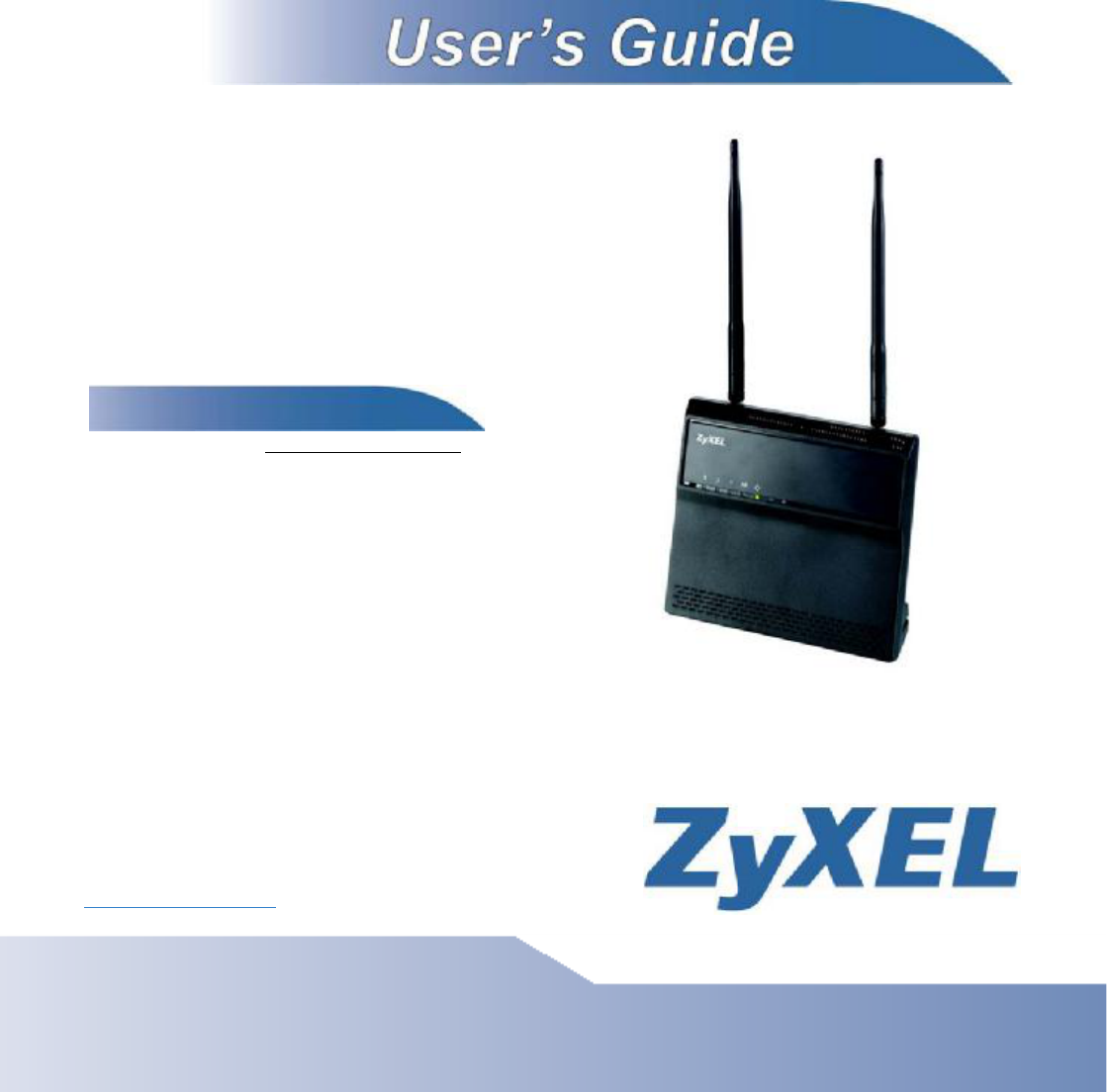ZyXEL Communications MAX208M WiMAX Indoor Gateway User Manual MAX208M Users guide
ZyXEL Communications Corporation WiMAX Indoor Gateway MAX208M Users guide
Contents
- 1. User Manual Part 1
- 2. User Manual Part 2
User Manual Part 1
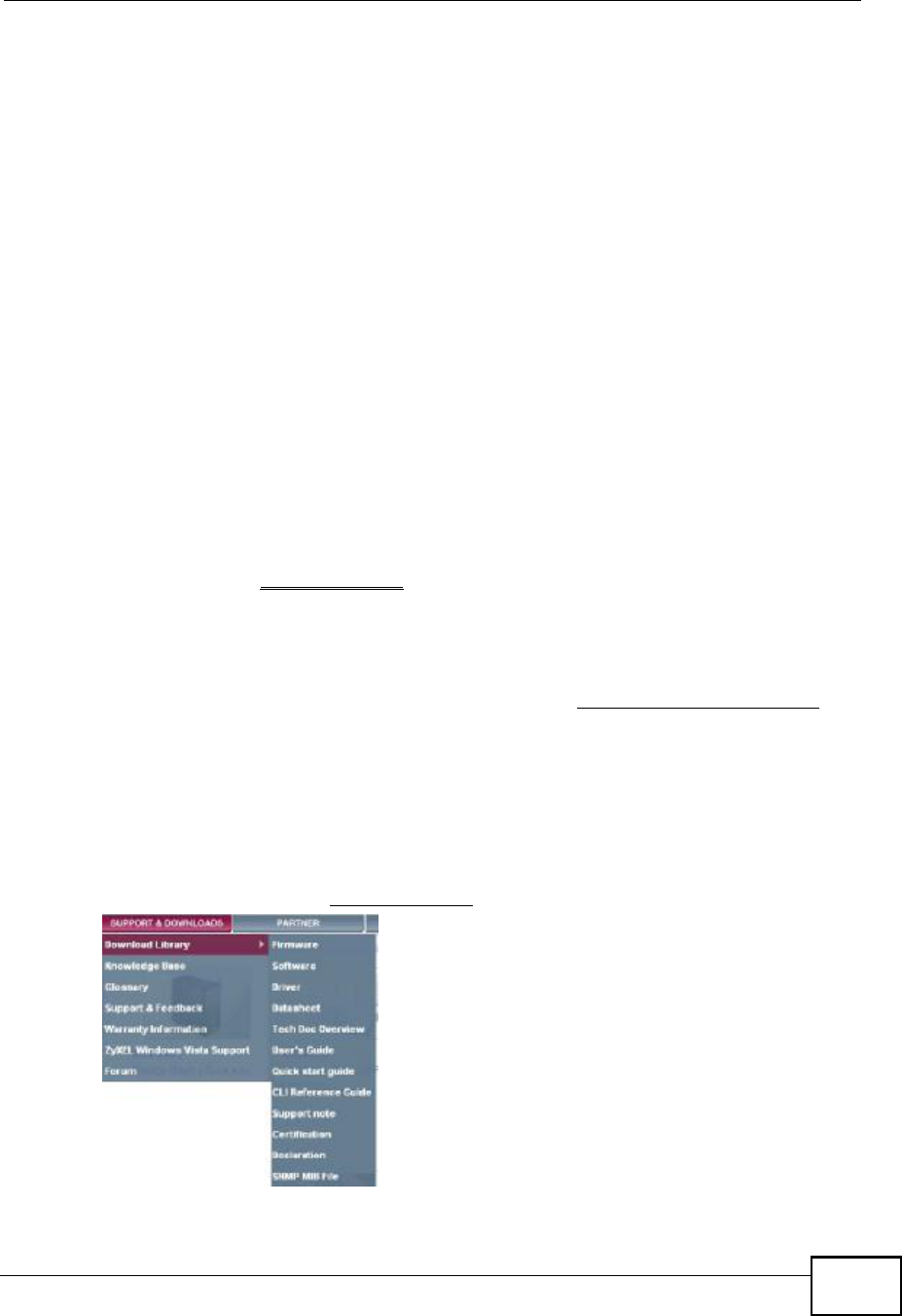
About This User's Guide
MAX208M User s Guide 3
About This User's Guide
Intended Audience
This manual is intended for people who want to configure the ZyXEL WiMAX
Device using the ZyXEL Web Configurator. You should have at least a basic
knowledge of TCP/IP networking concepts and topology.
Related Documentation
!Quick Start Guide
The Quick Start Guide is designed to help you get up and running right away. It
contains information on setting up your network and configuring for Internet
access.
!Support Disc
Refer to the included CD for support documents.
!ZyXEL Web Site
Please refer to www.zyxel.com for additional support documentation and
product certifications.
Documentation Feedback
Send your comments, questions or suggestions to: techwriters@zyxel.com.tw
Thank you!
The Technical Writing Team, ZyXEL Communications Corp.
Need More Help?
More help is available at www.zyxel.com.

About This User's Guide
MAX208M User s Guide
4
!Download Library
Search for the latest product updates and documentation from this link. Read
the Tech Doc Overview to find out how to efficiently use the documentation in
order to better understand how to use your product.
!Knowledge Base
If you have a specific question about your product, the answer may be here.
This is a collection of answers to previously asked questions about ZyXEL
products.
!Forum
This contains discussions on ZyXEL products. Learn from others who use ZyXEL
products and share your experiences as well.
Customer Support
Should problems arise that cannot be solved by the methods listed above, you
should contact your vendor. If you cannot contact your vendor, then contact a
ZyXEL office for the region in which you bought the device.
See http://www.zyxel.com/web/contact_us.php for contact information. Please
have the following information ready when you contact an office.
!Product model and serial number.
!Warranty Information.
!Date that you received your device.
!Brief description of the problem and the steps you took to solve it.

Document Conventions
MAX208M User s Guide 5
Document Conventions
Warnings and Notes
These are how warnings and notes are shown in this User s Guide.
Warnings tell you about things that could harm you or your
WiMAX Device.
Note: Notes tell you other important information (for example, other things you may
need to configure or helpful tips) or recommendations.
Syntax Conventions
!The product(s) described in this book may be referred to as the "WiMAX
Device#, the "device#, the "system# or the "product# in this User s Guide.
!Product labels, screen names, field labels and field choices are all in bold font.
!A key stroke is denoted by square brackets and uppercase text, for example,
[ENTER] means the "enter# or "return# key on your keyboard.
!"Enter# means for you to type one or more characters and then press the
[ENTER] key. "Select# or "choose# means for you to use one of the predefined
choices.
!A right angle bracket ( > ) within a screen name denotes a mouse click. For
example, TOOLS > Logs > Log Settings means you first click Tools in the
navigation panel, then the Logs sub menu and finally the Log Settings tab to
get to that screen.
!Units of measurement may denote the "metric# value or the "scientific# value.
For example, "k# for kilo may denote "1000# or "1024#, "M# for mega may
denote "1000000# or "1048576# and so on.
!"e.g.,# is a shorthand for "for instance#, and "i.e.,# means "that is# or "in other
words#.
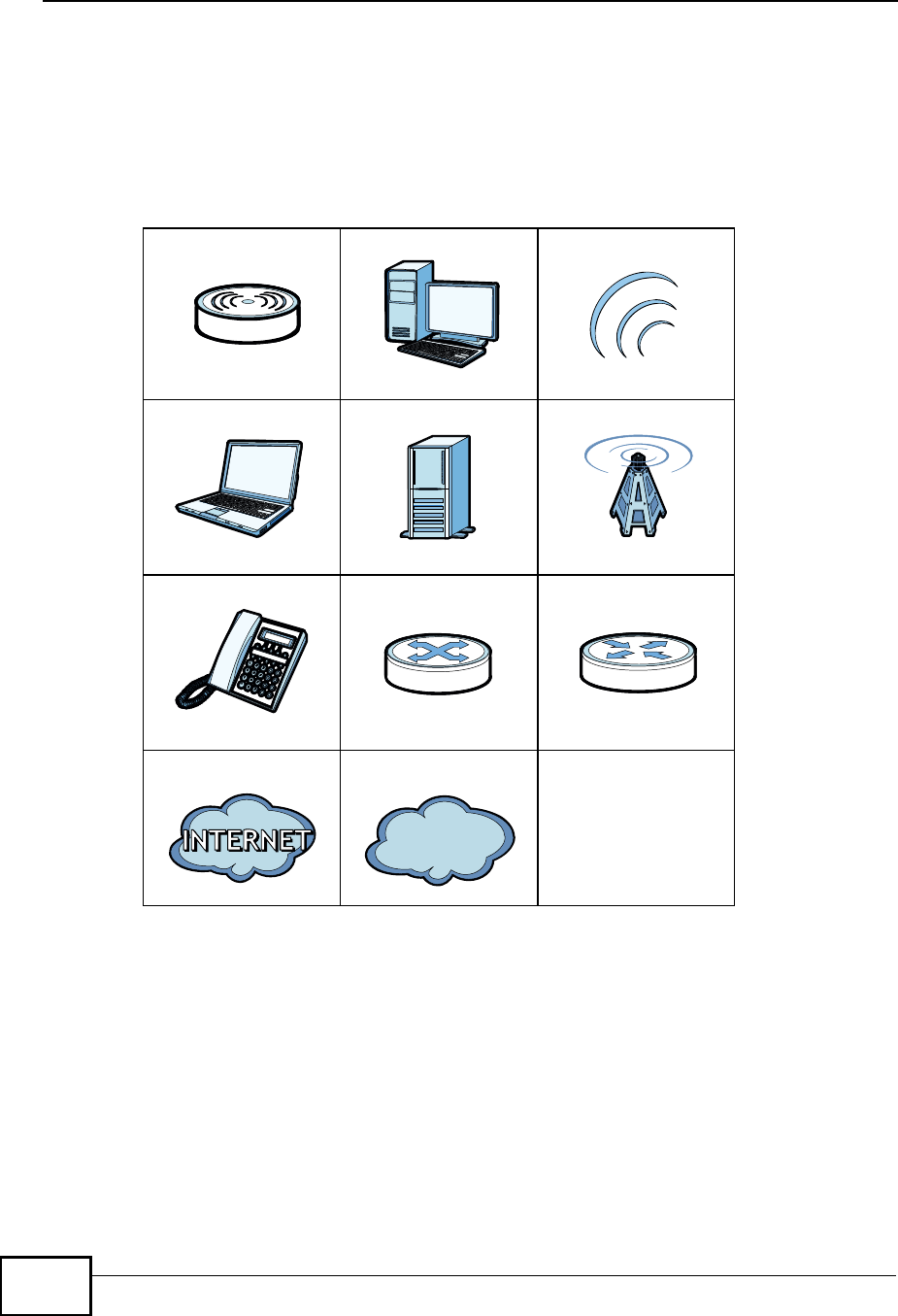
Document Conventions
MAX208M User s Guide
6
Icons Used in Figures
Figures in this User s Guide may use the following generic icons. The WiMAX
Device icon is not an exact representation of your product.
Table 1 Common Icons
WiMAX Device ComputerWireless Signal
NotebookServerBase Station
TelephoneSwitchRouter
Internet CloudNetwork Cloud

Safety Warnings
MAX208M User s Guide 7
Safety Warnings
For your safety, be sure to read and follow all warning notices and
instructions.
!Do NOT use this product near water, for example, in a wet basement or near a
swimming pool.
!Do NOT expose your device to dampness, dust or corrosive liquids.
!Do NOT store things on the device.
!Do NOT install, use, or service this device during a thunderstorm. There is a
remote risk of electric shock from lightning.
!Connect ONLY suitable accessories to the device.
!Do NOT open the device or unit. Opening or removing covers can expose you to
dangerous high voltage points or other risks. ONLY qualified service personnel
should service or disassemble this device. Please contact your vendor for further
information.
!Make sure to connect the cables to the correct ports.
!Place connecting cables carefully so that no one will step on them or stumble
over them.
!Always disconnect all cables from this device before servicing or disassembling.
!Use ONLY an appropriate power adaptor or cord for your device. Connect it to
the right supply voltage (for example, 110V AC in North America or 230V AC in
Europe).
!Do NOT remove the plug and connect it to a power outlet by itself; always
attach the plug to the power adaptor first before connecting it to a power outlet.
!Do NOT allow anything to rest on the power adaptor or cord and do NOT place
the product where anyone can walk on the power adaptor or cord.
!Do NOT use the device if the power adaptor or cord is damaged as it might
cause electrocution.
!If the power adaptor or cord is damaged, remove it from the device and the
power source.
!Do NOT attempt to repair the power adaptor or cord. Contact your local vendor
to order a new one.Do not use the device outside, and make sure all the
connections are indoors. There is a remote risk of electric shock from lightning.
!Do NOT obstruct the device ventilation slots, as insufficient airflow may harm
your device.Use only No. 26 AWG (American Wire Gauge) or larger
telecommunication line cord.
!Antenna Warning! This device meets ETSI and FCC certification requirements
when using the included antenna(s). Only use the included antenna(s).
!If you wall mount your device, make sure that no electrical lines, gas or water
pipes will be damaged.

Safety Warnings
MAX208M User s Guide
8
!Make sure that the cable system is grounded so as to provide some protection
against voltage surges.
Your product is marked with this symbol, which is known as the WEEE mark.
WEEE stands for Waste Electronics and Electrical Equipment. It means that
used electrical and electronic products should not be mixed with general
waste. Used electrical and electronic equipment should be treated
separately.

Contents Overview
MAX208M User s Guide 9
Contents Overview
User!s Guide ...........................................................................................................................15
Getting Started ...........................................................................................................................17
The Web Configurator ...............................................................................................................21
Setup Wizard............................................................................................................................. 27
Tutorials .....................................................................................................................................35
Technical Reference ..............................................................................................................51
System Status ............................................................................................................................53
WiMAX .......................................................................................................................................57
Network Settings .......................................................................................................................77
Security ....................................................................................................................................107
Maintenance .............................................................................................................................113
Troubleshooting .......................................................................................................................139
Product Specifications .............................................................................................................145

Contents Overview
MAX208M User s Guide
10

Table of Contents
MAX208M User s Guide 11
Table of Contents
About This User's Guide..........................................................................................................3
Document Conventions............................................................................................................5
Safety Warnings........................................................................................................................7
Contents Overview...................................................................................................................9
Table of Contents....................................................................................................................11
Part I: User!s Guide................................................................................15
Chapter 1
Getting Started........................................................................................................................17
1.1 About Your WiMAX Device ..................................................................................................17
1.1.1 WiMAX Internet Access .............................................................................................17
1.2 WiMAX Device Hardware ....................................................................................................18
1.2.1 LEDs ..........................................................................................................................18
1.3 Good Habits for Device Management ..................................................................................19
Chapter 2
The Web Configurator............................................................................................................21
2.1 Overview ..............................................................................................................................21
2.1.1 Accessing the Web Configurator ................................................................................21
2.1.2 The Reset Button .......................................................................................................22
2.1.3 Saving and Canceling Changes .................................................................................23
2.1.4 Working with Tables ...................................................................................................24
2.2 The Main Screen .................................................................................................................24
Chapter 3
Setup Wizard...........................................................................................................................27
3.1 Overview ..............................................................................................................................27
3.1.1 Welcome to the Setup Wizard ....................................................................................27
3.1.2 LAN Settings ..............................................................................................................28
3.1.3 WiMAX Frequency Settings .......................................................................................29
3.1.4 WiMAX Authentication Settings .................................................................................31
3.1.5 Setup Complete .........................................................................................................33

Table of Contents
MAX208M User s Guide
12
Chapter 4
Tutorials...................................................................................................................................35
4.1 Overview ..............................................................................................................................35
4.2 WiMAX Connection Settings ...............................................................................................35
4.3 Configuring LAN DHCP .......................................................................................................36
4.4 Changing Certificate ............................................................................................................38
4.5 Blocking Web Access ..........................................................................................................39
4.6 Configuring the MAC Address Filter ....................................................................................40
4.7 Setting Up NAT Port Forwarding .........................................................................................42
4.8 Access the WiMAX Device Using DDNS .............................................................................45
4.8.1 Registering a DDNS Account on www.dyndns.org ....................................................45
4.8.2 Configuring DDNS on Your WiMAX Device ...............................................................46
4.8.3 Testing the DDNS Setting ..........................................................................................46
4.9 Configuring Static Route for Routing to Another Network ...................................................46
4.10 Remotely Managing Your WiMAX Device .........................................................................49
Part II: Technical Reference..................................................................51
Chapter 5
System Status.........................................................................................................................53
5.1 Overview ..............................................................................................................................53
5.2 System Status ......................................................................................................................53
Chapter 6
WiMAX......................................................................................................................................57
6.1 Overview ..............................................................................................................................57
6.1.1 What You Need to Know ............................................................................................57
6.2 Connection Settings ............................................................................................................61
6.3 Frequency Settings ..............................................................................................................63
6.4 Authentication Settings ........................................................................................................65
6.5 Connect ...............................................................................................................................68
6.6 Wide Scan ...........................................................................................................................71
6.7 Link Status ...........................................................................................................................72
6.8 Link Statistics .......................................................................................................................74
6.9 Connection Info ...................................................................................................................75
6.10 Service Flow ......................................................................................................................75
Chapter 7
Network Settings.....................................................................................................................77
7.1 Overview ..............................................................................................................................77
7.1.1 What You Need to Know ............................................................................................77

Table of Contents
MAX208M User s Guide 13
7.2 WAN ....................................................................................................................................82
7.3 PPPoE .................................................................................................................................84
7.4 GRE .....................................................................................................................................85
7.5 EtherIP .................................................................................................................................86
7.6 IP .........................................................................................................................................86
7.7 DHCP ..................................................................................................................................87
7.8 Static Route .........................................................................................................................88
7.9 RIP .......................................................................................................................................89
7.10 Port Forwarding .................................................................................................................90
7.10.1 Port Forwarding Wizard ...........................................................................................92
7.11 Port Trigger ........................................................................................................................93
7.11.1 Port Trigger Wizard ..................................................................................................94
7.11.2 Trigger Port Forwarding Example .............................................................................95
7.12 DMZ ...................................................................................................................................96
7.13 ALG ...................................................................................................................................97
7.14 UPnP .................................................................................................................................98
7.14.1 Installing UPnP in Windows XP ...............................................................................98
7.14.2 Web Configurator Easy Access .............................................................................102
7.15 DDNS ..............................................................................................................................104
7.16 Content Filter ...................................................................................................................105
Chapter 8
Security..................................................................................................................................107
8.1 Overview ............................................................................................................................107
8.1.1 What You Need to Know ..........................................................................................107
8.2 IP Filter ..............................................................................................................................108
8.3 MAC Filter ..........................................................................................................................109
8.4 DDOS .................................................................................................................................110
Chapter 9
Maintenance..........................................................................................................................113
9.1 Overview .............................................................................................................................113
9.1.1 What You Need to Know ...........................................................................................113
9.2 Password ...........................................................................................................................120
9.3 HTTP .................................................................................................................................121
9.4 Telnet .................................................................................................................................122
9.5 SSH ...................................................................................................................................122
9.6 SNMP ................................................................................................................................123
9.7 CWMP ...............................................................................................................................124
9.8 OMA-DM ............................................................................................................................126
9.9 Date ...................................................................................................................................128
9.10 Time Zone ........................................................................................................................129
9.11 Upgrade File ....................................................................................................................129

Table of Contents
MAX208M User s Guide
14
9.11.1 The Firmware Upload Process ...............................................................................130
9.12 Upgrade Link ...................................................................................................................131
9.13 CWMP Upgrade ..............................................................................................................131
9.14 Backup .............................................................................................................................132
9.15 Restore ............................................................................................................................133
9.15.1 The Restore Configuration Process .......................................................................133
9.16 Factory Defaults ..............................................................................................................134
9.17 Log Setting ......................................................................................................................134
9.18 Log Display ......................................................................................................................135
9.19 About ...............................................................................................................................136
9.20 Reboot .............................................................................................................................136
Chapter 10
Troubleshooting....................................................................................................................139
10.1 Power, Hardware Connections, and LEDs ......................................................................139
10.2 WiMAX Device Access and Login ...................................................................................140
10.3 Internet Access ................................................................................................................142
10.4 Reset the WiMAX Device to Its Factory Defaults ............................................................143
10.5 Pop-up Windows, JavaScript and Java Permissions ......................................................144
Chapter 11
Product Specifications.........................................................................................................145
Appendix A WiMAX Security................................................................................................151
Appendix B Setting Up Your Computer s IP Address...........................................................155
Appendix C Pop-up Windows, JavaScript and Java Permissions........................................183
Appendix D IP Addresses and Subnetting...........................................................................193
Appendix E Importing Certificates........................................................................................205
Appendix F Common Services.............................................................................................237
Appendix G Legal Information..............................................................................................241
Index.......................................................................................................................................245

15
PART I
User!s Guide

16
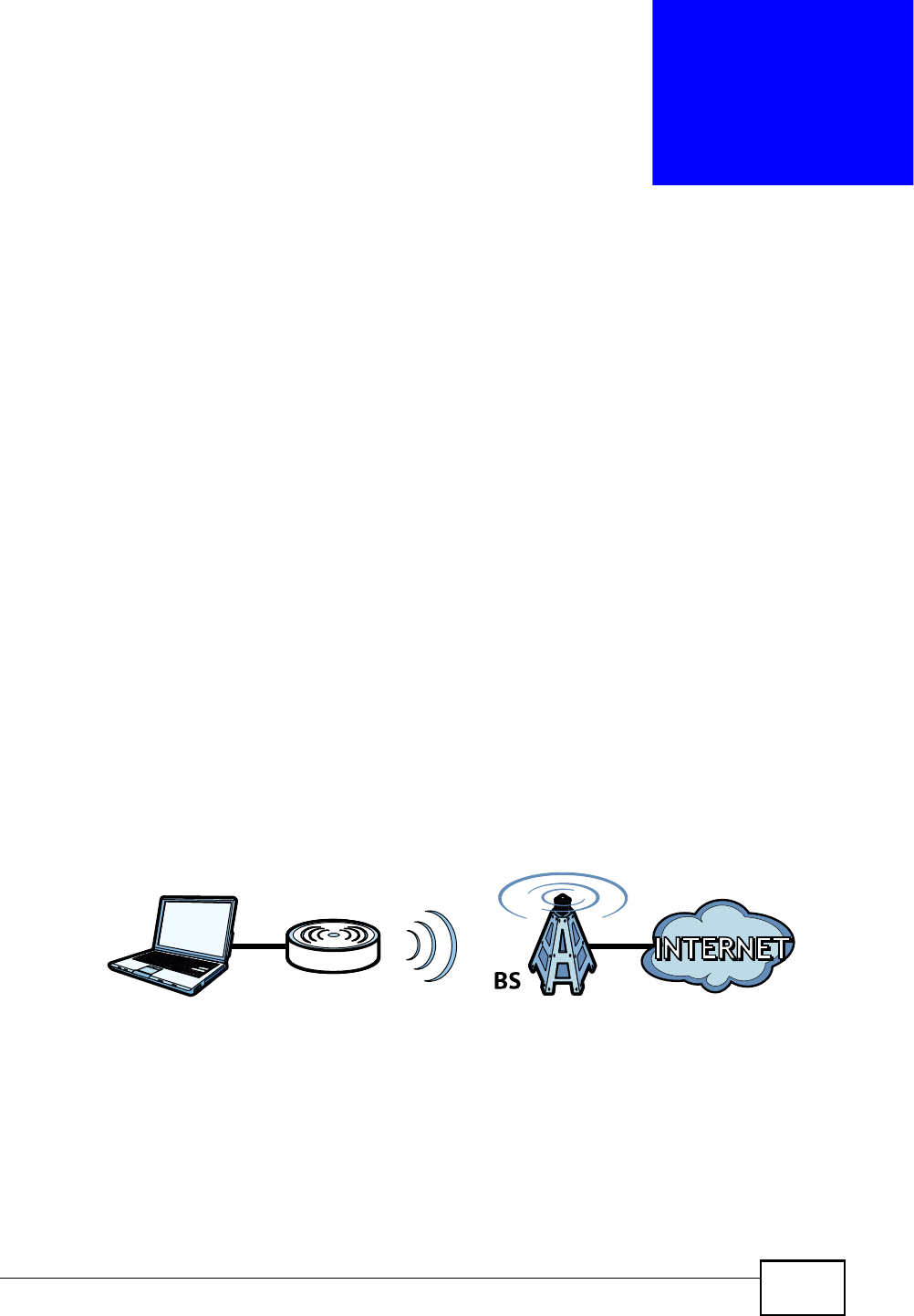
MAX208M User s Guide 17
CHAPTER 1
Getting Started
1.1 About Your WiMAX Device
The WiMAX Device allows you to access the Internet by connecting to a WiMAX
wireless network. You can configure firewall and content filtering as well as a host
of other features. The browser-based user interface -- the Web Configurator --
can be used to easily manage the device.
See Chapter 11 on page 145 for a complete list of features for your model.
1.1.1 WiMAX Internet Access
Connect your computer or network to the WiMAX Device for WiMAX Internet
access. See the Quick Start Guide for instructions on hardware connections.
In a wireless metropolitan area network (MAN), the WiMAX Device connects to a
WiMAX base station (BS) for Internet access.
The following diagram shows a notebook computer equipped with the WiMAX
Device connecting to the Internet through a WiMAX base station (BS).
Figure 1 Mobile Station and Base Station
When the firewall is on, all incoming traffic from the Internet to your network is
blocked unless it is initiated from your network.
Use content filtering to block access to web sites with URLs containing keywords
that you specify. You can define time periods and days during which content
filtering is enabled and include or exclude particular computers on your network
from content filtering. For example, you could block access to certain web sites.
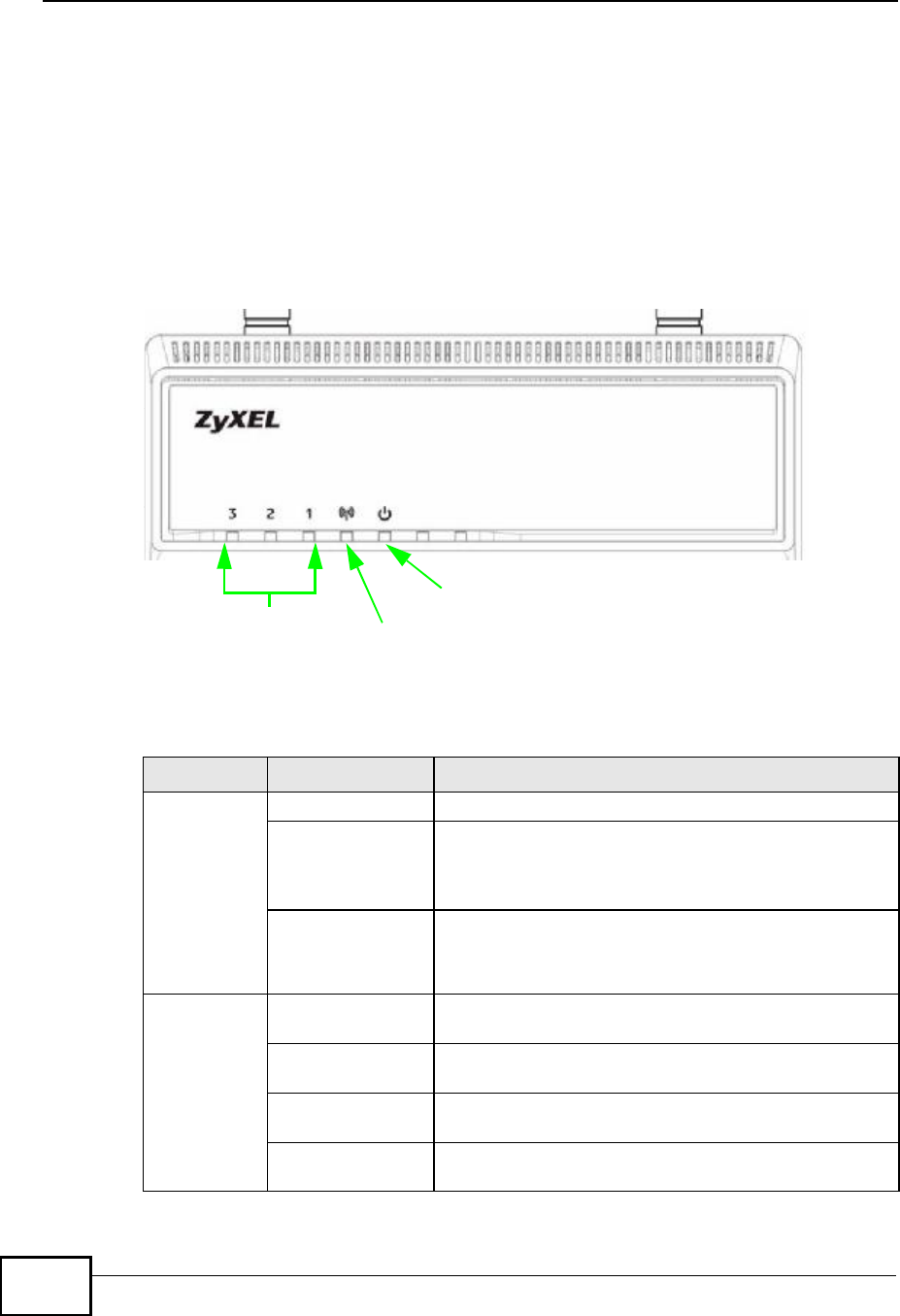
Chapter 1Getting Started
MAX208M User s Guide
18
1.2 WiMAX Device Hardware
Follow the instructions in the Quick Start Guide to make hardware connections.
1.2.1 LEDs
The following figure shows the LEDs (lights) on the WiMAX Device.
Figure 2 The WiMAX Device s LEDs
The following table describes your WiMAX Device s LEDs (from top to bottom).
Table 2 The WiMAX Device LEDs behavior
LED STATE DESCRIPTION
PowerOffThe WiMAX Device is not receiving power.
RedThe WiMAX Device is receiving power but has been
unable to start up correctly or is not receiving enough
power. See the Troubleshooting section for more
information.
Green Solid: The WiMAX Device is receiving power and
functioning correctly.
Flashing: the device is self-testing (startup)
WiMAX LinkOffThe WiMAX Device is not connected to a wireless
(WiMAX) network.
GreenThe WiMAX Device is successfully connected to a
wireless (WiMAX) network.
Green (Blinking
Slowly)
The WiMAX Device is searching for a wireless (WiMAX)
network.
Green (Blinking
Quickly)
The WiMAX Device has found a wireless (WiMAX)
network and is connecting.
STRENGTH
POWER LED
WIMAX
INDICATORS
LINK LED

Chapter 1Getting Started
MAX208M User s Guide 19
1.3 Good Habits for Device Management
Do the following things regularly to make the WiMAX Device more secure and to
manage the WiMAX Device more effectively.
!Change the password. Use a password that s not easy to guess and that consists
of different types of characters, such as numbers and letters.
!Write down the password and put it in a safe place.
!Back up the configuration (and make sure you know how to restore it).
Restoring an earlier working configuration may be useful if the WiMAX Device
becomes unstable or even crashes. If you forget your password, you will have to
reset the WiMAX Device to its factory default settings. If you backed up an
earlier configuration file, you would not have to totally re-configure the WiMAX
Device. You could simply restore your last configuration.
Signal
Strength
Indicator
The Strength Indicator LEDs display the Interference-plus-Noise Ratio
(CINR) of the wireless (WiMAX) connection.
LEDs 1, 2, 3 onRSSI >= -69 dBm
LEDs 1, 2 onRSSI: -70~-79 dBm
LED 1 onRSSI: -80~-89 dBm
Table 2 The WiMAX Device LEDs behavior
LED STATE DESCRIPTION

Chapter 1Getting Started
MAX208M User s Guide
20

MAX208M User s Guide 21
CHAPTER 2
The Web Configurator
2.1 Overview
The Web Configurator is an HTML-based management interface that allows easy
device set up and management via any web browser that supports: HTML 4.0,
CSS 2.0, and JavaScript 1.5, and higher. The recommended screen resolution for
using the web configurator is 1024 by 768 pixels and 16-bit color, or higher.
In order to use the Web Configurator you need to allow:
!Web browser pop-up windows from your device. Web pop-up blocking is enabled
by default in many operating systems and web browsers.
!JavaScript (enabled by default in most web browsers).
!Java permissions (enabled by default in most web browsers).
See the Appendix C on page 183 for more information on configuring your web
browser.
2.1.1 Accessing the Web Configurator
1Make sure your WiMAX Device hardware is properly connected (refer to the Quick
Start Guide for more information).
2Launch your web browser.
3Enter "192.168.1.1" as the URL.
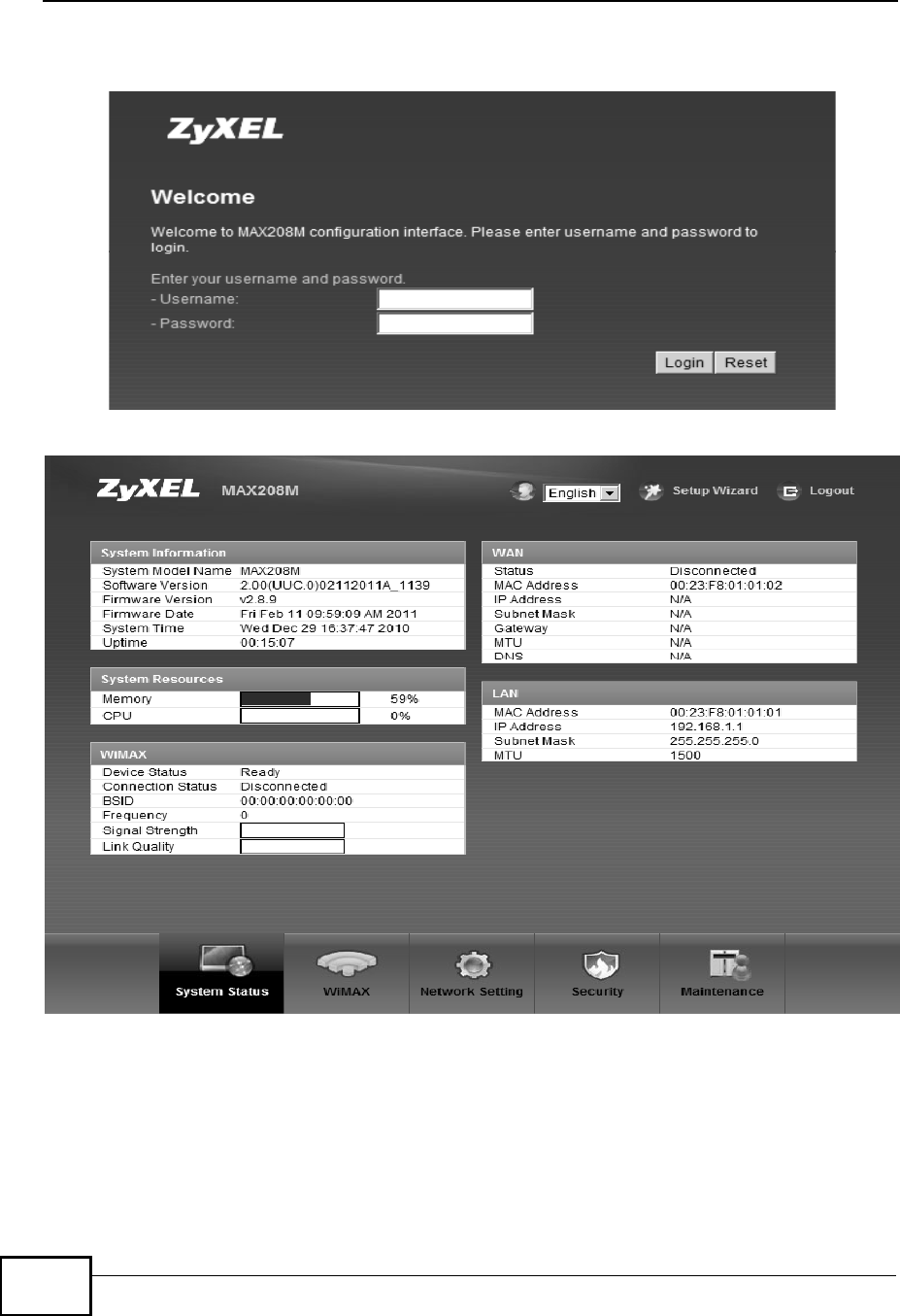
Chapter 2The Web Configurator
MAX208M User s Guide
22
4Enter the default Username and Password (see the cover page), then click
Login.
5The Main screen displays.
Note: For security reasons, the WiMAX Device automatically logs you out if you do
not use the Web Configurator for five minutes. If this happens, log in again.
2.1.2 The Reset Button
If you forget your password or cannot access the Web Configurator, you will need
to use the Reset button to reload the factory-default configuration file. This
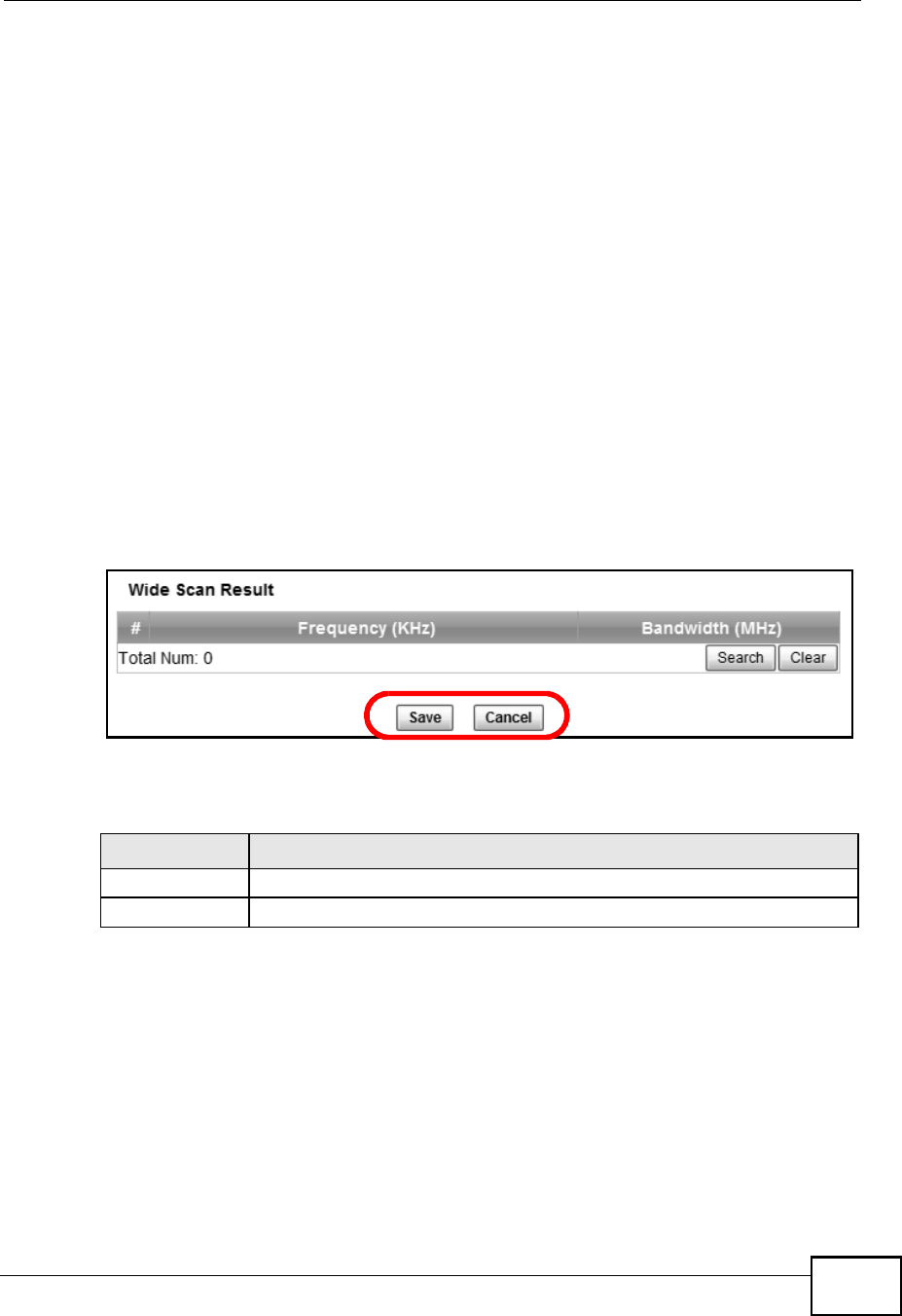
Chapter 2The Web Configurator
MAX208M User s Guide 23
means that you will lose all configurations that you had previously and the
password will be reset to the default (see the cover page).
2.1.2.1 Using The Reset Button
1Make sure the Power light is on (not blinking).
2To set the device back to the factory default settings, press the Reset button for
five seconds or until all LED lights blink one time, then release it. The device
restarts when the defaults have been restored.
3Reconfigure the WiMAX Device following the steps in your Quick Start Guide.
2.1.3 Saving and Canceling Changes
All screens to which you can make configuration changes must be saved before
those changes can go into effect. If you make a mistake while configuring the
WiMAX Device, you can cancel those changes and start over.
Figure 3 Saving and Canceling Changes
This screen contains the following fields:
Note: If you make changes to a page but do not save before switching to another
page or exiting the Web Configurator, those changes are disgarded.
Table 3 Saving and Canceling Changes
LABEL DESCRIPTION
SaveClick this to save your changes.
CancelClick this to restore the settings on this page to their last saved values.
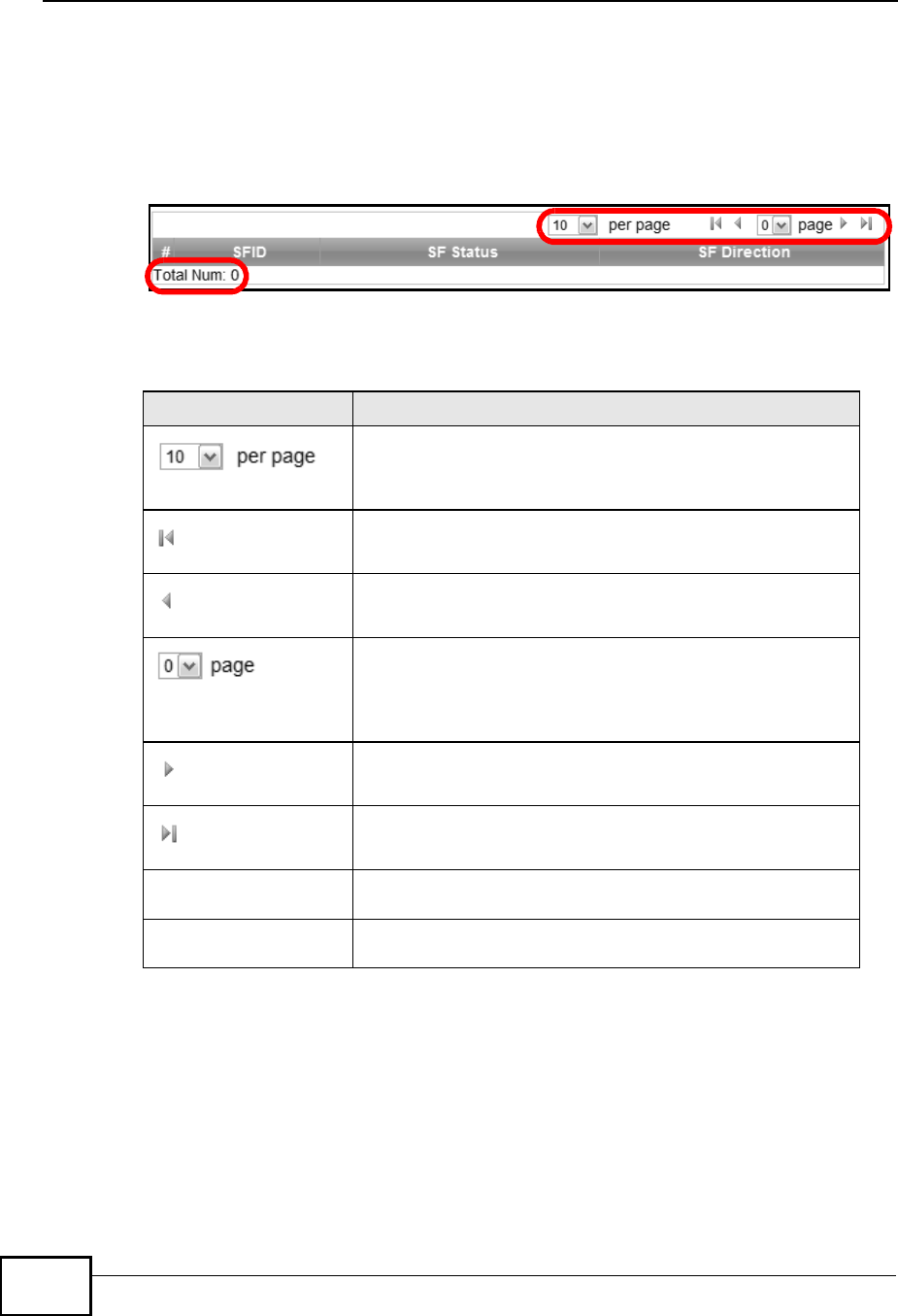
Chapter 2The Web Configurator
MAX208M User s Guide
24
2.1.4 Working with Tables
Many screens in the WiMAX Device contain tables to provide information or
additional configuration options.
Figure 4 Tables Example
This screen contains the following fields:
2.2 The Main Screen
When you first log into the Web Configurator, the Main screen appears. Here you
can view a summary of your WiMAX Device s connection status. This is also the
default "home# page for the Web Configurator and it contains conveniently-placed
shortcuts to all of the other screens.
Table 4 Saving and Canceling Changes
LABEL DESCRIPTION
Items per Page
This displays the number of items displayed per table page.
Use the menu to change this value.
First Page
Click this to go to the first page in the table.
Previous Page
Click this to go to the previous page in the table.
Page Indicator / Jump to Page
This indicates which page is currently displayed in the
table. Use the menu to jump to another page. You can only
jump to other pages if those pages exist.
Next Page
Click this to go to the previous page in the table.
Last Page
Click this to go to the last page in the table.
#This indicates an item s position in the table. It has no
bearing on that item s importance or lack there of.
Total NumThis indicates the total number of items in the table,
including items on pages that are not visible.
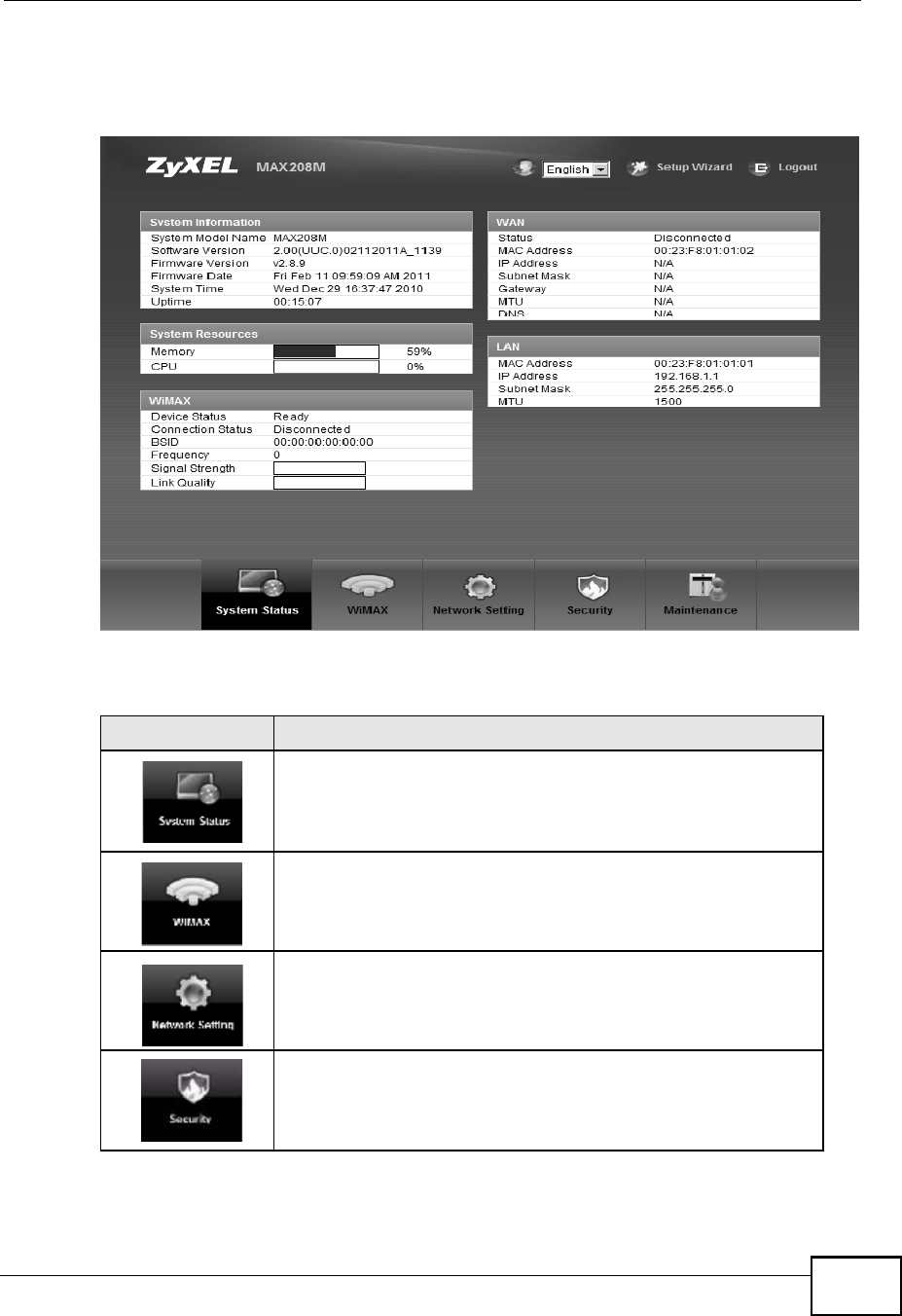
Chapter 2The Web Configurator
MAX208M User s Guide 25
Note: Some features in the Web Configurator may not be available depending on your
firmware version and/or configuration.
Figure 5 Main Screen
The following table describes the icons in this screen.
Table 5 Icons in the Main Screen
ICON DESCRIPTION
System Status
Click this to open the Main screen, which shows your WiMAX
Device status and other information.
WiMAX
Click this to open the WiMAX menu, which gives you options for
configuring your WiMAX settings.
Network Setting
Click this to open the Network menu, which gives you options for
configuring your network settings.
Security
Click this to open the Security menu, which gives you options for
configuring your firewall and security settings.
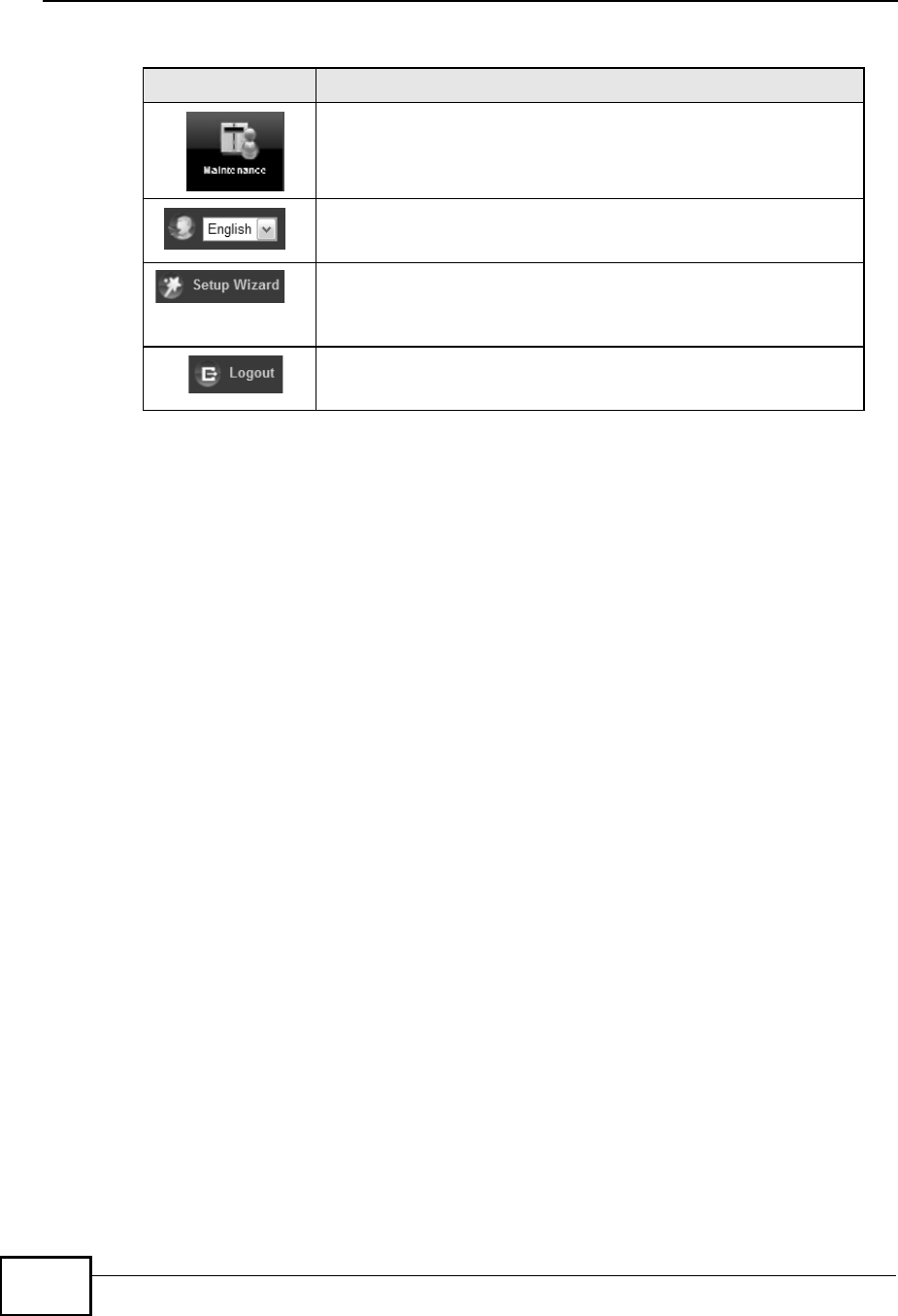
Chapter 2The Web Configurator
MAX208M User s Guide
26
Maintenance
Click this to open the Maintenance menu, which gives you
options for maintaining your WiMAX Device.
Language
Use this menu to select the Web Configurator s language.
Setup Wizard
Click this to open the Setup Wizard, where you can configure the
most essential settings for your WiMAX Device to work.
Logout
Click this to log out of the Web Configurator.
Table 5 Icons in the Main Screen (continued)
ICON DESCRIPTION
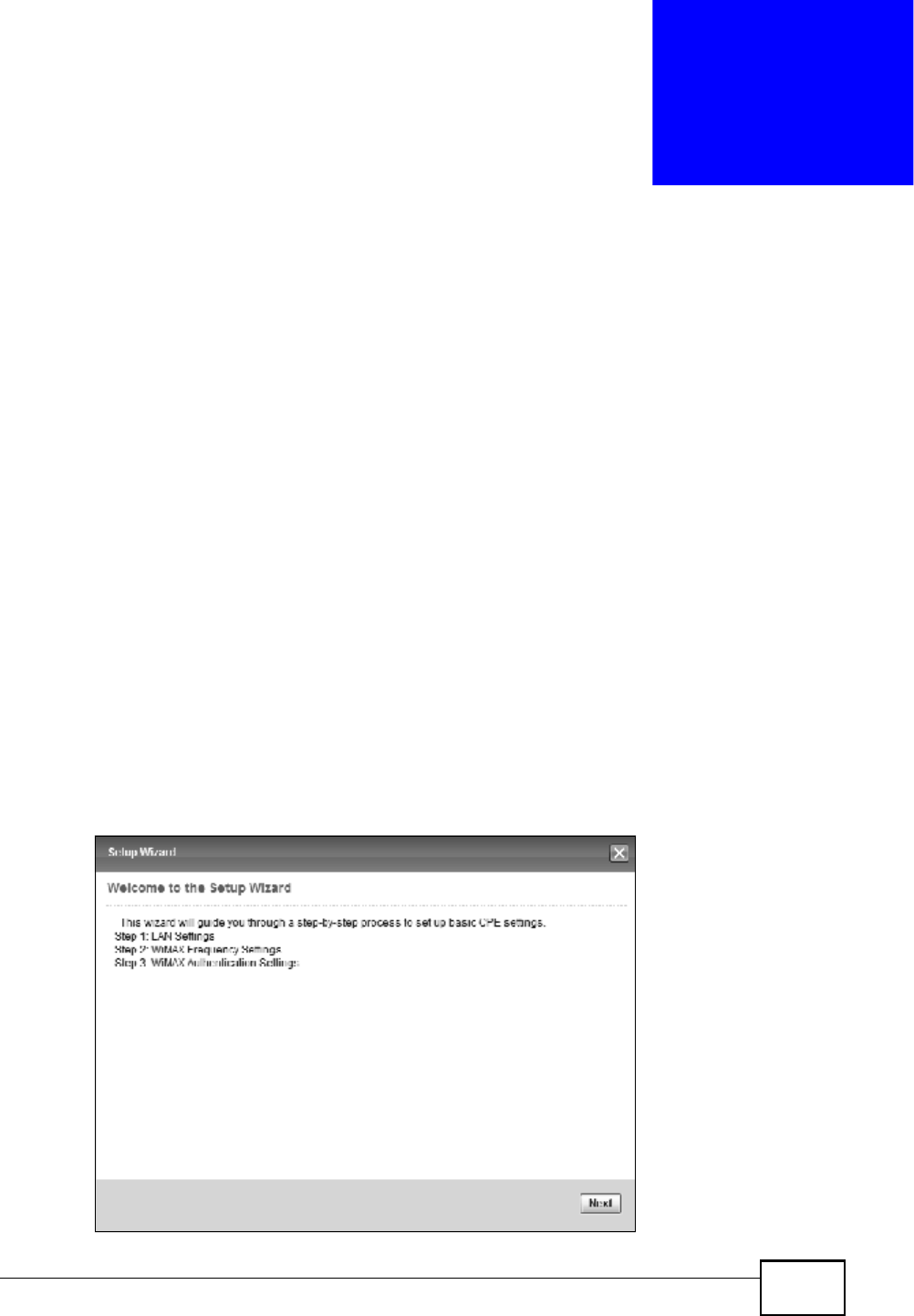
MAX208M User s Guide 27
CHAPTER 3
Setup Wizard
3.1 Overview
This chapter provides information on the ZyXEL Setup Wizard. The wizard guides
you through several steps for onfiguring your network settings.
3.1.1 Welcome to the Setup Wizard
This screen provides a quick summary of the configuration tasks the wizard helps
you to perform. They are:
1Set up your Local Area Network (LAN) options, which determine how the devices
in your home or office connect to the WiMAX Device.
2Set up your WiMAX Device s broadcast frequency, which is the radio channel it
uses to communicate with the ISP s base station.
3Set up your WiMAX Device s login options, which are used to connect your LAN to
the ISP s network and verify your account.
Figure 6 Setup Wizard > Welcome
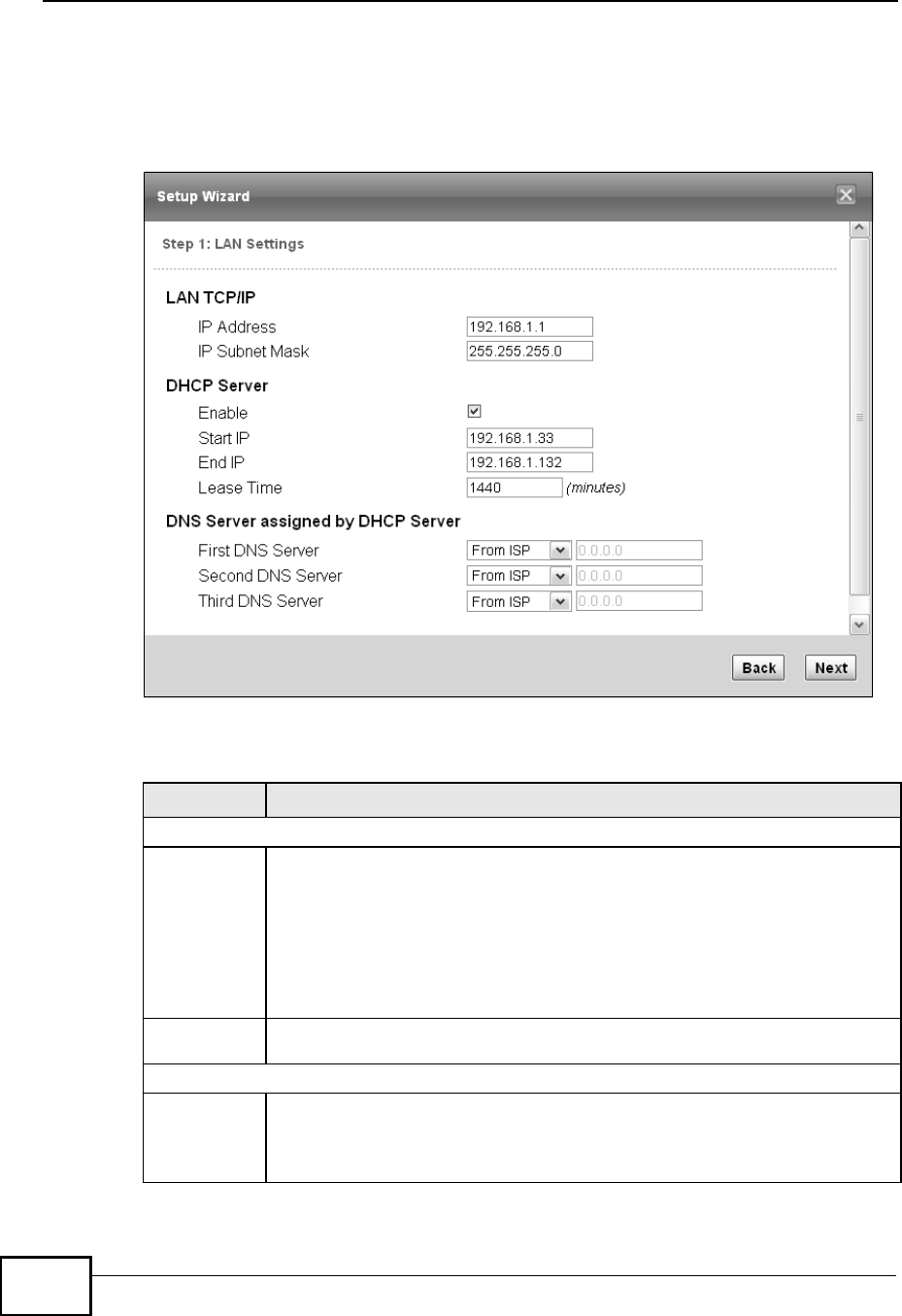
Chapter 3Setup Wizard
MAX208M User s Guide
28
3.1.2 LAN Settings
The LAN Settings screen allows you to configure your local network options.
Figure 7 Setup Wizard > LAN Settings
The following table describes the labels in this screen.
Table 6 Setup Wizard > LAN Settings
LABEL DESCRIPTION
LAN TCP/IP
IP
Address
Enter the IP address of the WiMAX Device on the LAN.
Note: This field is the IP address you use to access the WiMAX Device
on the LAN. If the web configurator is running on a computer on
the LAN, you lose access to it as soon as you change this field.
You can access the web configurator again by typing the new IP
address in the browser.
IP Subnet
Mask
Enter the subnet mask of the LAN.
DHCP Server
Enable Select this if you want the WiMAX Device to be the DHCP server on the
LAN. As a DHCP server, the WiMAX Device assigns IP addresses to DHCP
clients on the LAN and provides the subnet mask and DNS server
information.
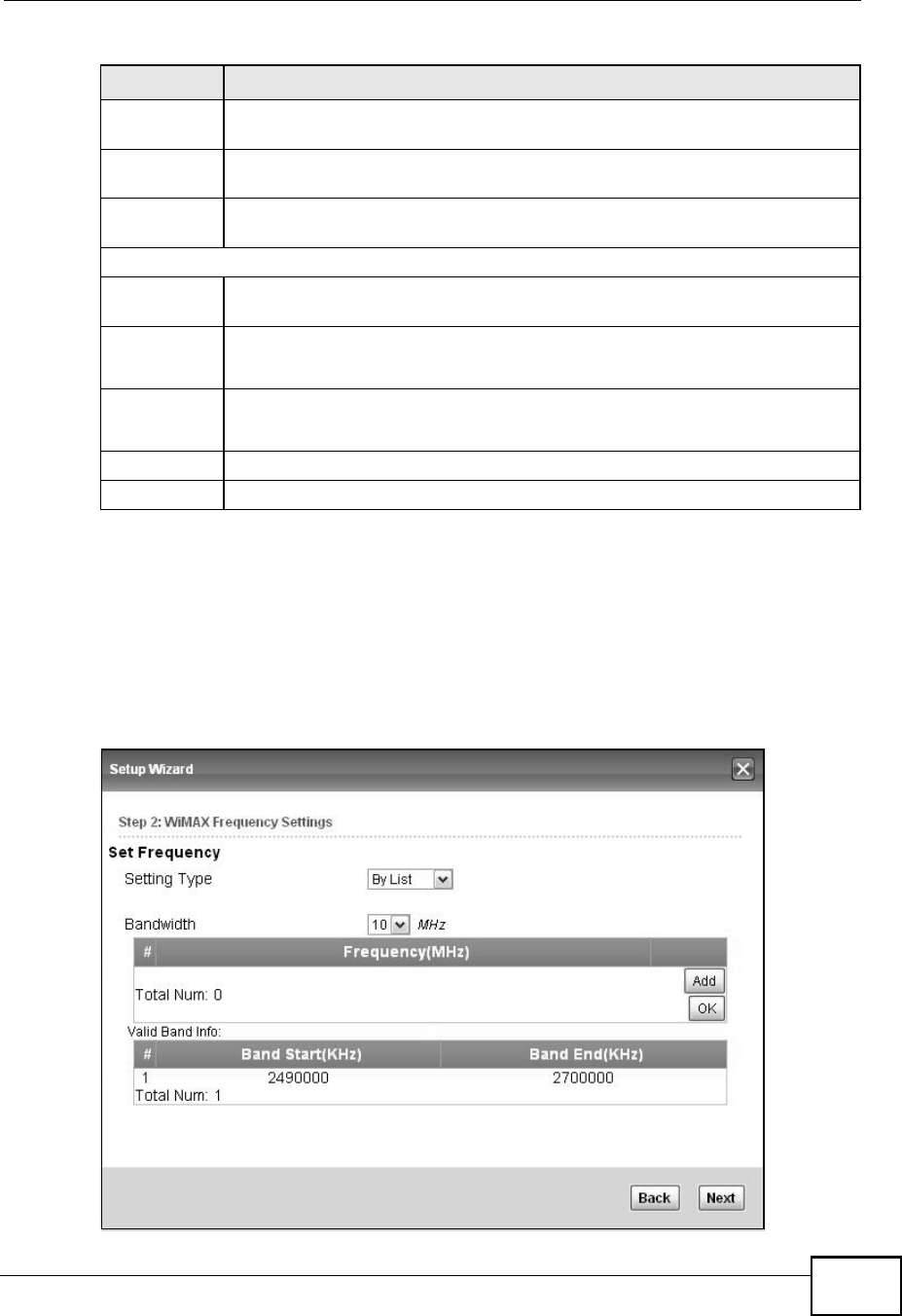
Chapter 3Setup Wizard
MAX208M User s Guide 29
3.1.3 WiMAX Frequency Settings
The WiMAX Frequency Settings screen allows you to configure the broadcast radio
frequency used by the WiMAX Device.
Note: These settings should be provided by your ISP.
Figure 8 Setup Wizard > WiMAX Frequency Settings
Start IP Enter the IP address from which the WiMAX Device begins allocating IP
addresses.
End IP Enter the IP address at which the WiMAX Device stops allocating IP
addresses.
Lease
Time
Enter the duration in minutes before the device requests a new IP address
from the DHCP server.
DNS Server assigned by DHCP Server
First DNS
Server
Specify the first IP address of three DNS servers that the network can use.
The WiMAX Device provides these IP addresses to DHCP clients.
Second
DNS
Server
Specify the second IP address of three DNS servers that the network can
use. The WiMAX Device provides these IP addresses to DHCP clients.
Third
DNS
Server
Specify the third IP address of three DNS servers that the network can use.
The WiMAX Device provides these IP addresses to DHCP clients.
Back Click to display the previous screen.
Next Click to proceed to the next screen.
Table 6 Setup Wizard > LAN Settings (continued)
LABEL DESCRIPTION

Chapter 3Setup Wizard
MAX208M User s Guide
30
The following table describes the labels in this screen.
Table 7 Setup Wizard > WiMAX Frequency Settings
LABEL DESCRIPTION
Setting TypeSelect the WiMAX frequency setting type from the list.
!By Range - Select this to set up the frequency based on
a range of MHz.
!By List - Select this to set up the frequency on an
individual MHz basis. You can add multiple MHz values to
the list.
StepEnter the increments in MHz by which to increase the
frequency range.
Note: This field only appears when you select By Range
under Setting Type.
Start FrequencyEnter the frequency value at the beginning of the frequency
range to use. The frequency is increased in increments equal
to the Step value until the End Frequency is reached, at
which time the cycle starts over with the Start Frequency.
Note: This field only appears when you select By Range
under Setting Type.
End FrequencyEnter the frequency value at the end of the frequency range
to use.
Note: This field only appears when you select By Range
under Setting Type.
BandwidthSet the frequency bandwidth in MHz that this WiMAX Device
uses.
#This is an index number for enumeration purposes only.
Frequency (MHz)Displays the frequency MHz for the item in the list.
Total NumDisplays the total number of items in the list.
DeleteClick this to remove an item from the list.
AddClick this to add an item to the list.
OKClick this to save an newly added item to the list.
#This is an index number for enumeration purposes only.
Band Start (KHz)Indicates the beginning of the frequency band in KHz.
Band End (KHz)Indicates the end of the frequency band in KHz.
Total NumDisplays the total number of items in the list.
Back Click to display the previous screen.
Next Click to proceed to the next screen.
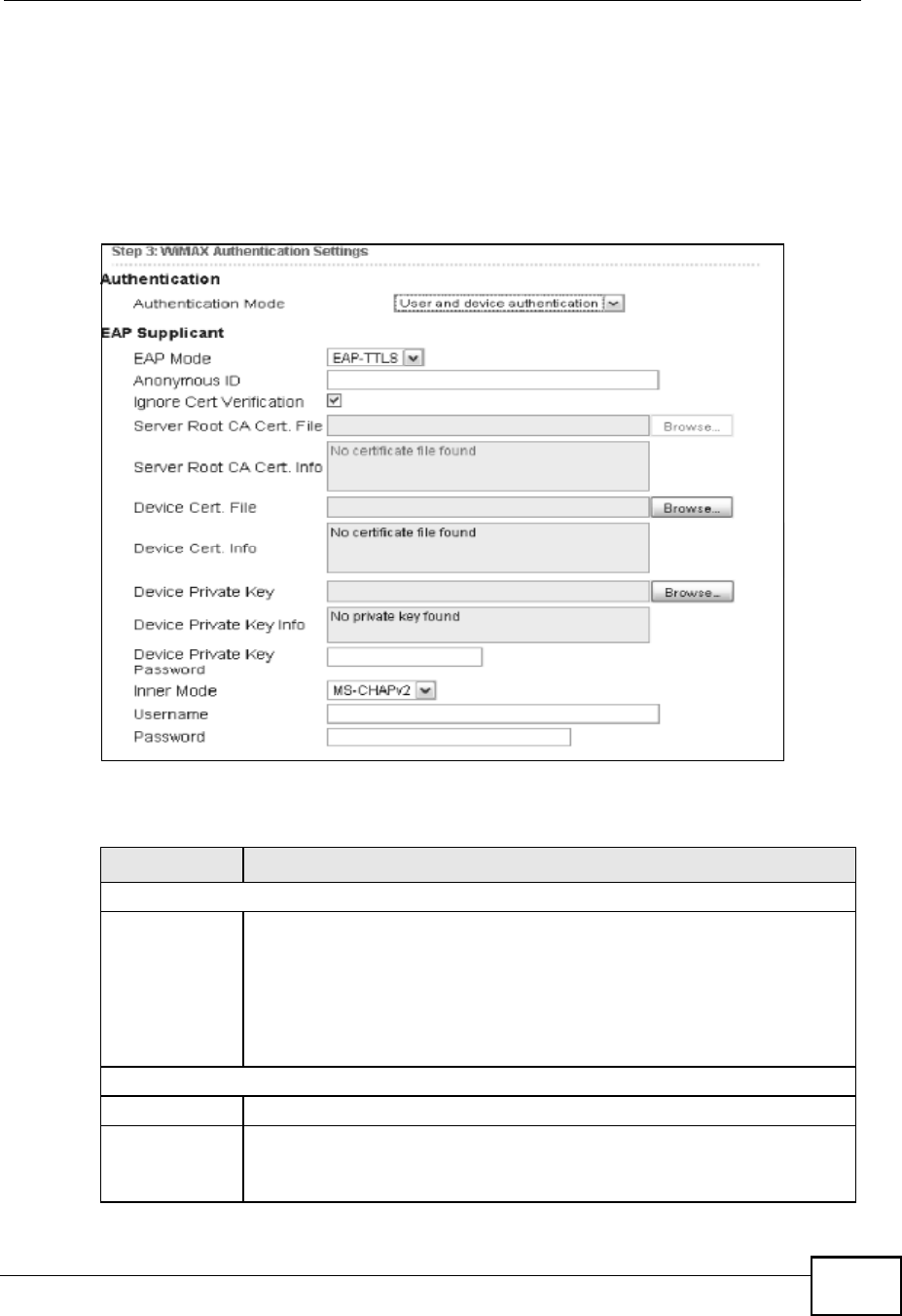
Chapter 3Setup Wizard
MAX208M User s Guide 31
3.1.4 WiMAX Authentication Settings
The WiMAX Authentication Settings screen allows you to configure how your
WiMAX Device logs into the service provider s network.
Note: These settings should be provided by your ISP.
Figure 9 Setup Wizard > WiMAX Authentication Settings
The following table describes the labels in this screen.
Table 8 Setup Wizard > WiMAX Authentication Settings
LABEL DESCRIPTION
Authentication
Authenticati
on Mode
Select a WiMAX authentication mode for authentication network
sessions with the ISP. Options are:
!No authentication
!User authentication
!Device authentication
!User and Device authentication
EAP Supplication
EAP Mode Select an EAP authentication mode.
Anonymous
Id
Enter your anonymous ID.
Note: Some modes may not require this.

Chapter 3Setup Wizard
MAX208M User s Guide
32
Ignore Cert
Verification
Select this to ignore base station certification verification when a
certificate is received during EAP-TLS or EAP-TTLS.
Server Root
CA Cert.
File
Browse for and choose a server root certificate file, if required.
Server Root
CA Cert.
Info
This field displays information about the assigned server root certificate.
Device
Cert. File
Browse for and choose a device certificate file, if required.
Device
Cert. Info.
This field displays information about the assigned device certificate.
Device
Private Key
Browse for and choose a device private key, if required.
Device
Private Key
Info
This field displays information about the assigned device private key.
Device
Private Key
Password
Enter the device private key, if required.
Inner Mode Select an inner authentication mode.
Note: Some modes may not require this.
Username Enter your authentication username.
Note: Some modes may not require this.
Password Enter your authentication password.
Note: Some modes may not require this.
Back Click to display the previous screen.
Next Click to proceed to the next screen.
Table 8 Setup Wizard > WiMAX Authentication Settings (continued)
LABEL DESCRIPTION
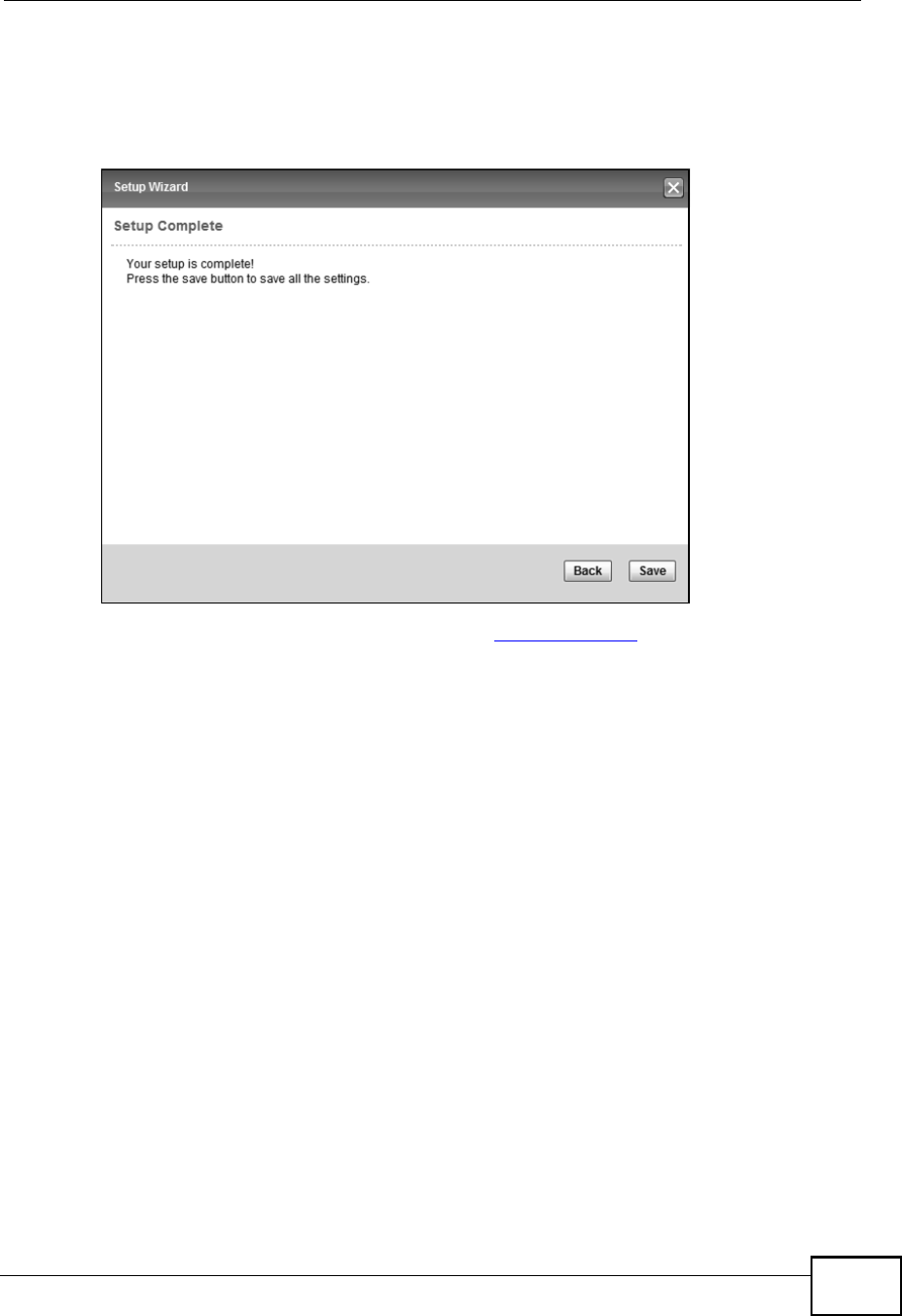
Chapter 3Setup Wizard
MAX208M User s Guide 33
3.1.5 Setup Complete
Click Save to save the Setup Wizard settings and close it.
Figure 10 Setup Wizard > Setup Complete
Launch your web browser and navigate to www.zyxel.com. If everything was
configured properly, the web page should display. You can now surf the Internet!
Refer to the rest of this guide for more detailed information on the complete range
of WiMAX Device features available in the more advanced web configurator.
Note: If you cannot access the Internet, open the web configurator again to confirm
that the Internet settings you configured in the wizard setup are correct.

Chapter 3Setup Wizard
MAX208M User s Guide
34

MAX208M User s Guide 35
CHAPTER 4
Tutorials
4.1 Overview
This chapter shows you how to configure some of the WiMAX Device s features.
Note: Be sure to read The Web Configurator on page 21 before working through the
tutorials presented here. For field descriptions for individual screens, see the
related technical reference in this User's Guide.
This chapter includes the following configuration examples:
!WiMAX Connection Settings on page 35
!Configuring LAN DHCP on page 36
!Changing Certificate on page 38
!Blocking Web Access on page 39
!Configuring the MAC Address Filter, see page40
!Setting Up NAT Port Forwarding, see page 42
!Access the WiMAX Device Using DDNS, see page 45
!Configuring Static Route for Routing to Another Network, see page 46
!Remotely Managing Your WiMAX Device on page 49
4.2 WiMAX Connection Settings
This tutorial provides you with pointers for configuring the WiMAX Device to
connect to an ISP.
1Connect the WiMAX Device to the ISP s nearest base station. See Section 6.2 on
page 61.
2Configure the WiMAX Device s broadcast frequency. Section 6.3 on page 63.
3Configure the WiMAX Device to connect securely to the ISP s authentication
servers. See Section 6.4 on page 65.
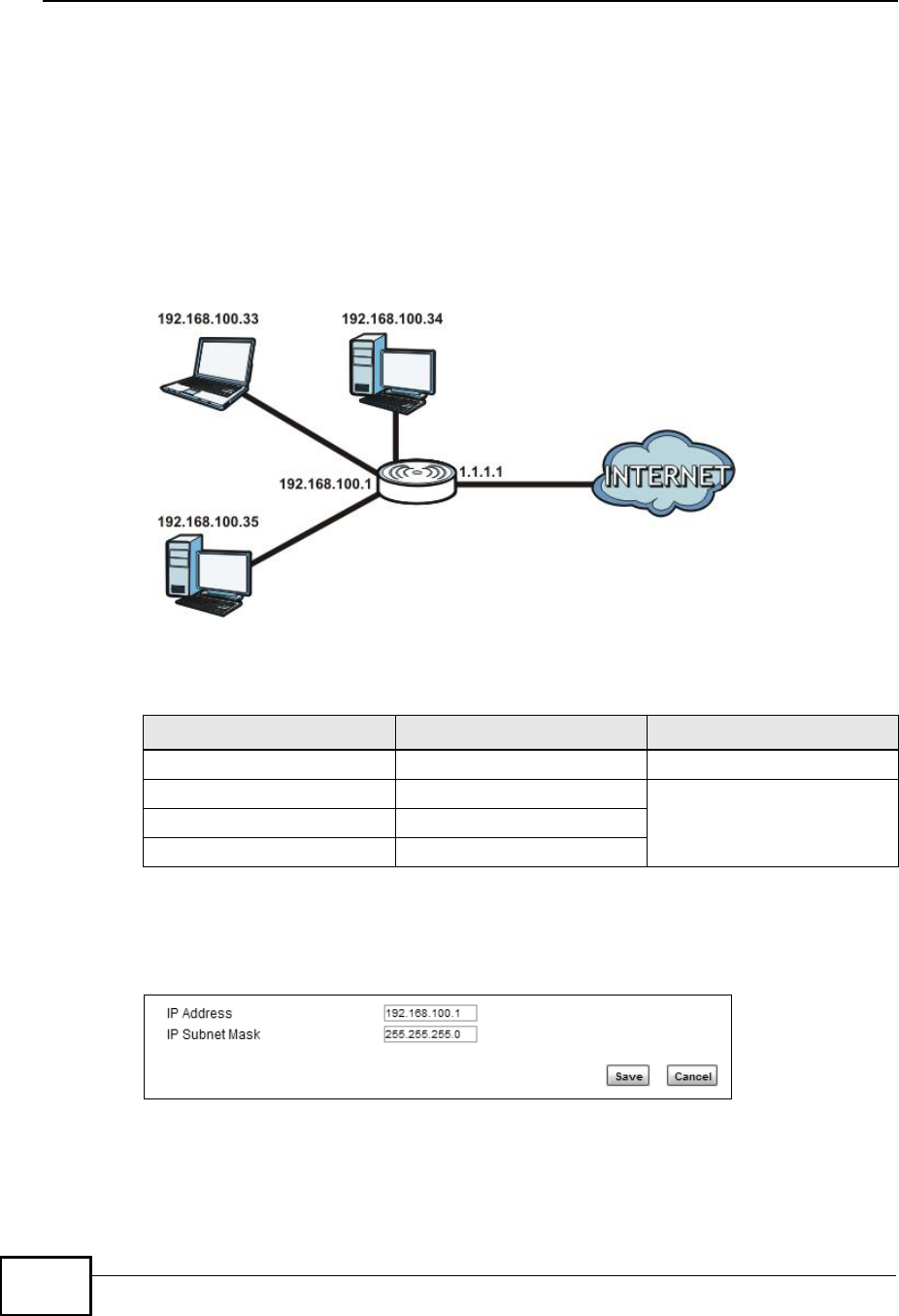
Chapter 4Tutorials
MAX208M User s Guide
36
4Check the WiMAX Device s connection status to ensure everything is working
properly. See Section 6.7 on page 72.
4.3 Configuring LAN DHCP
This tutorial shows you how to set up a small network in your office or home.
Goal: Connect three computers to your WiMAX Device to form a small network.
Required: The following table provides a summary of the information you will
need to complete the tasks in this tutorial.
1In the Web Configurator, open the Network Setting > LAN screen and set the IP
Address to 192.168.100.1. Use the default IP Subnet Mask of 255.255.255.0.
Click Save.
2Manually change the IP address of your computer that your are using to
192.168.100.x (for example, 192.168.100.5) and keep the subnet set to
255.255.255.0.
INFORMATION VALUE SEE ALSO
LAN IP Address192.168.100.1 Chapter 7 on page 86
Starting IP Address192.168.100.10 Chapter 7 on page 87
Ending IP Address192.168.100.30
DNS ServersFrom ISP
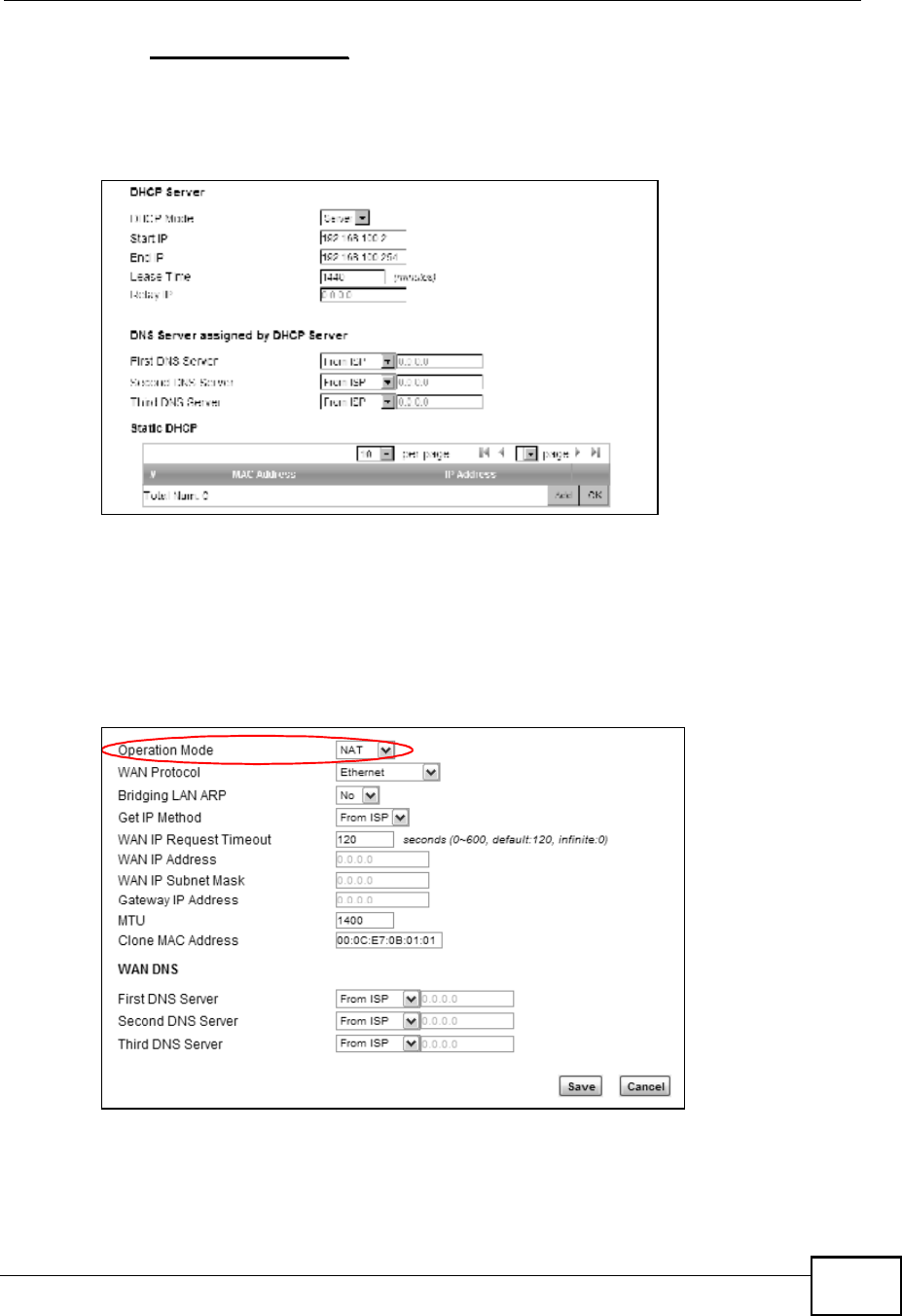
Chapter 4Tutorials
MAX208M User s Guide 37
3Type http://192.168.100.1 in your browser after the WiMAX Device finishes
starting up completely.
4Log into the Web Configurator and open the Network Setting > LAN > DHCP
screen.
5Select Server for the DHCP mode, then enter 192.168.100.10 and
192.168.100.30 as your DHCP starting and ending IP addresses.
6Leave the other settings as their defaults and click Save.
7Next, go to the Network Setting > WAN screen and select NAT in the
Operation Mode field. Click Save.
8Connect your computers to the WiMAX Device s Ethernet ports and you re all set!
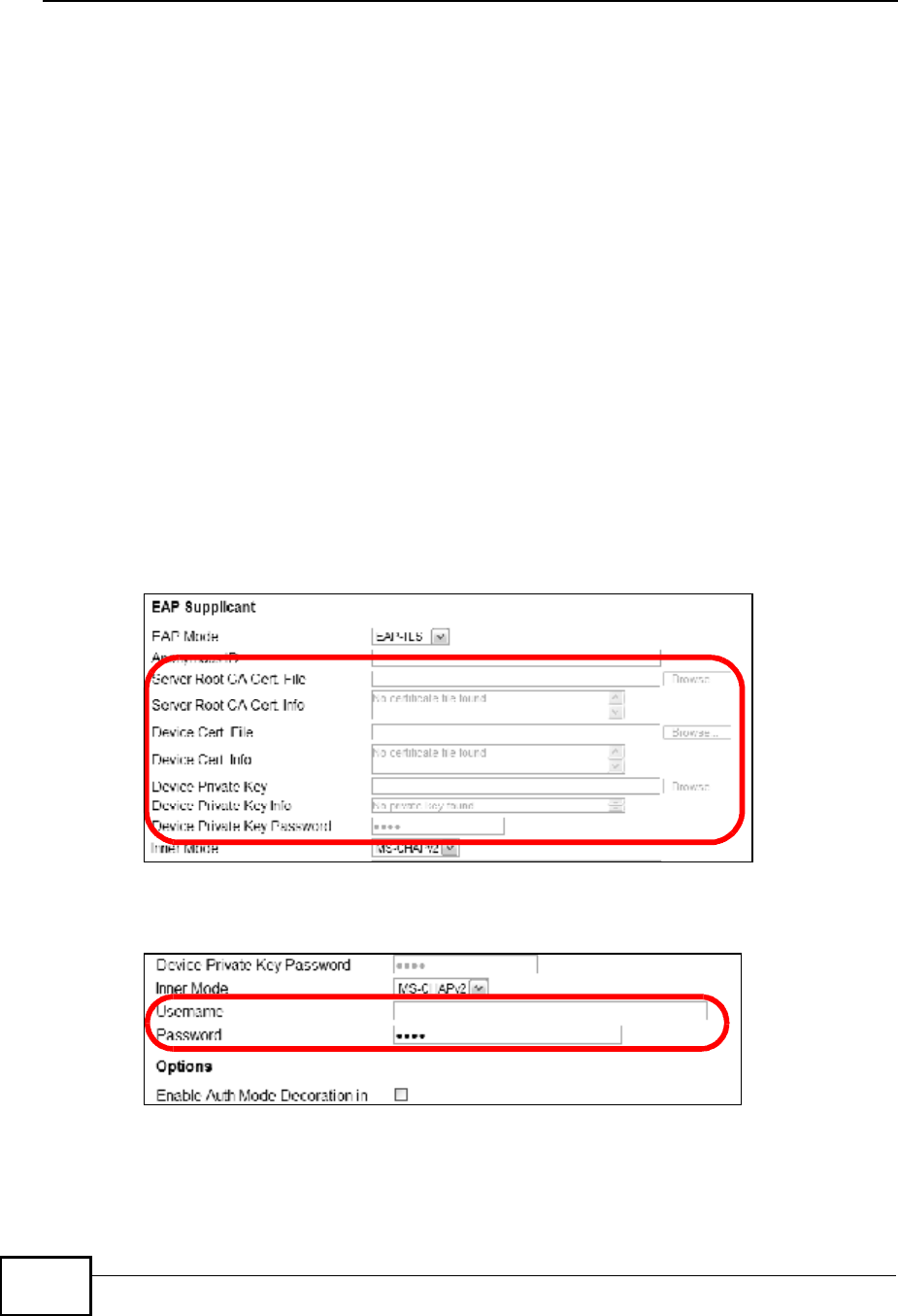
Chapter 4Tutorials
MAX208M User s Guide
38
Note: You may need to configure the computers on your LAN to automatically obtain
IP addresses. For information on how to do this, see Appendix B on page 155.
Once your network is configured and hooked up, you will want to connect it to the
Internet next. To do this, just run the Internet Connection Wizard (Chapter 3
on page 27), which walks you through the process.
4.4 Changing Certificate
This tutorial shows you how to import a new security certificate, which allows your
device to communicate with another network servers.
Goal: Import a new security certificate into the WiMAX Device.
See Also: Appendix E on page 205.
1Go to the WiMAX > Profile > Authentication Settings screen. In the EAP
Supplicant section, click each Browse button and locate the security certificates
that were provided by your new ISP.
s
2Configure your new Internet access settings based on the information provided by
the ISP.
Note: You can also use the Internet Connection Wizard to configure the Internet
access settings.
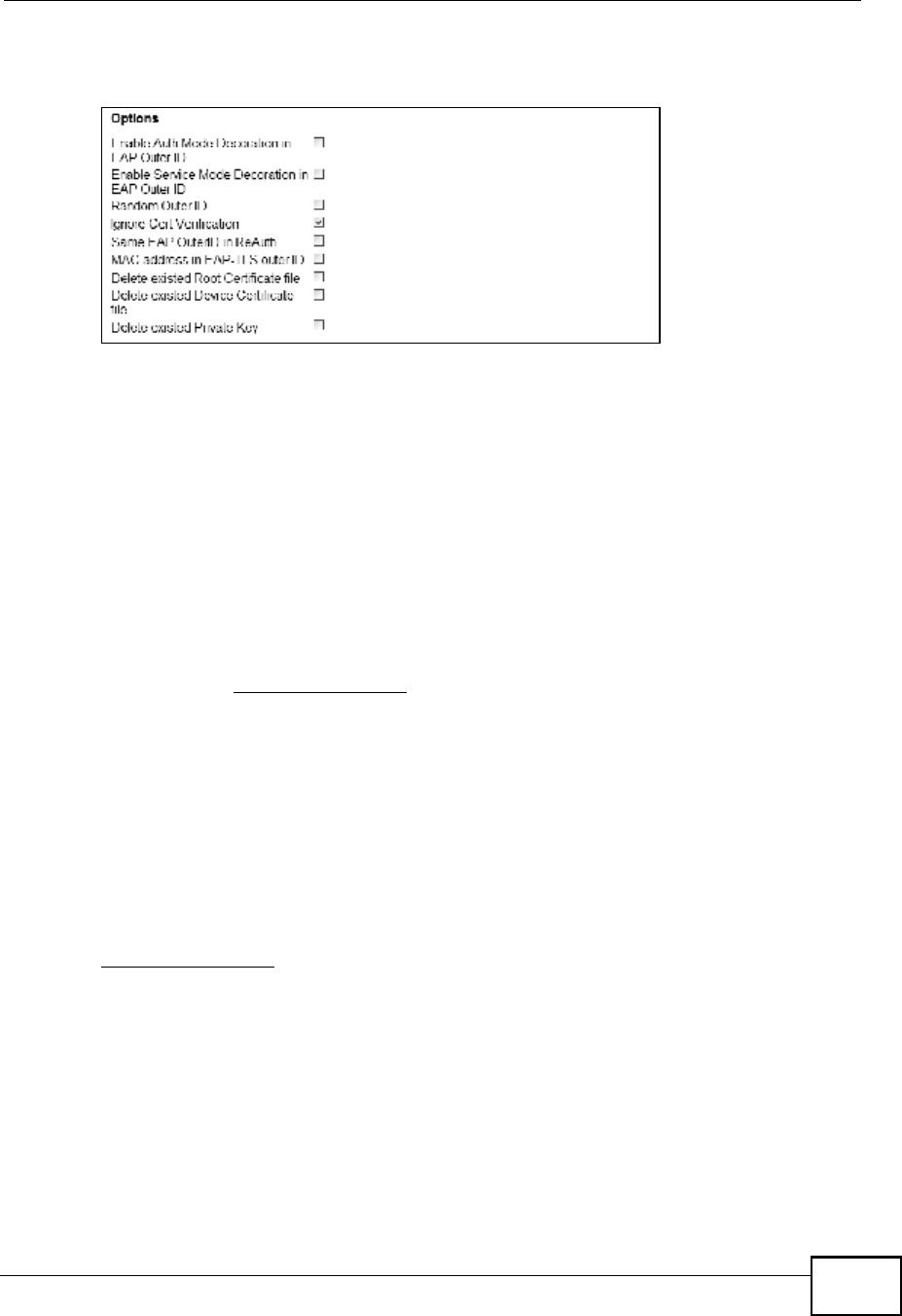
Chapter 4Tutorials
MAX208M User s Guide 39
3You may need to configure the Options section according to the information
provided by the ISP.
4Click Save. You should now be able to connect to the Internet through your new
service provider!
4.5 Blocking Web Access
If your WiMAX Device is in a home or office environment you may decide that you
want to block an Internet website access. You may need to block both the
website s IP address and domain name.
Goal: Configure the WiMAX Device s content filter to block a website with a
domain name www.example.com.
See Also: Section 7.16 on page 105.
1Open the Network Setting > Content Filter.
2Select Enable URL Filter.
3Select Blacklist.
4Click Add and configure a URL filter rule by selecting Active and entering
www.example.com as the URL.
5Click OK.
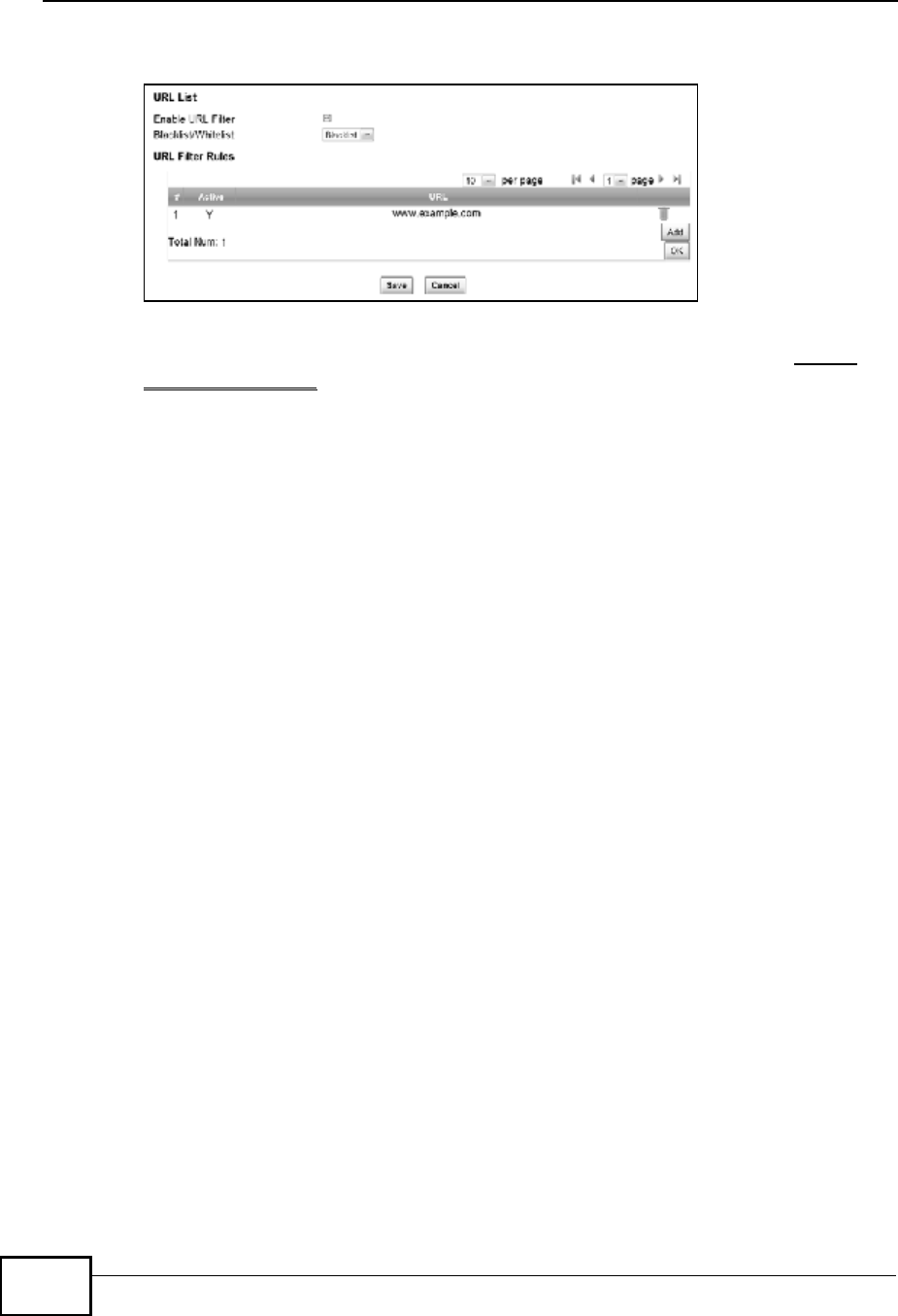
Chapter 4Tutorials
MAX208M User s Guide
40
6Click Save.
Open a browser from your computer in the WiMAX Device s LAN network, you
should get an "Access Violation# message when you try to access to http://
www.example.com. You may also need to block the IP address of the website if
you do not want users to access to the website through its IP address.
4.6 Configuring the MAC Address Filter
This tutorial shows you how to use the MAC filter to block a DHCP client s access to
hosts and to the WiMAX network.
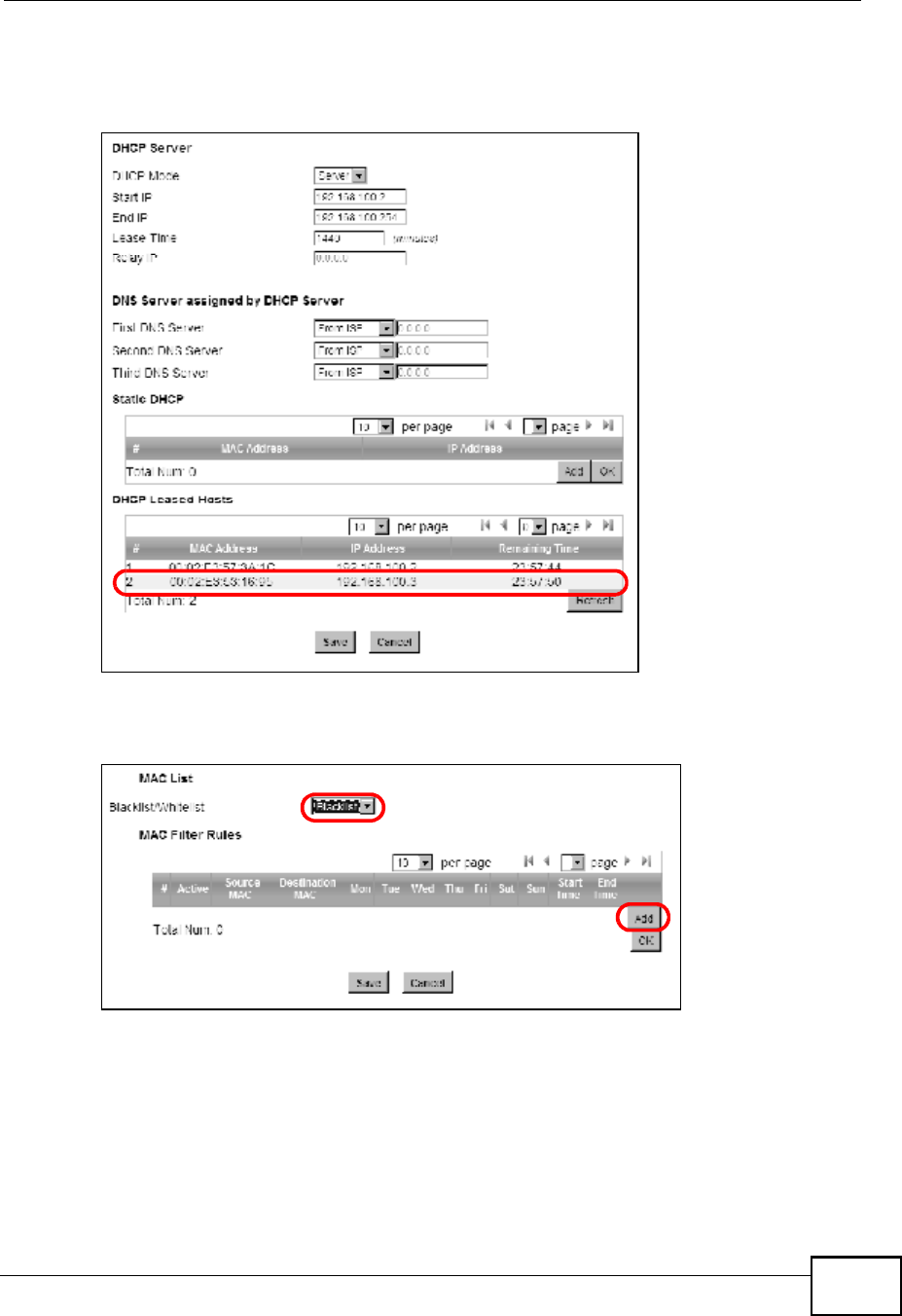
Chapter 4Tutorials
MAX208M User s Guide 41
1First of all, you have to know the MAC address of the computer. If not, you can
look for the MAC address in the Network Setting > LAN > DHCP screen.
(192.168.100.3 mapping to 00:02:E3:53:16:95 in this example).
2Click Security > Firewall > MAC Filter. Select Blacklist and click the Add
button in the MAC Filter Rules table.
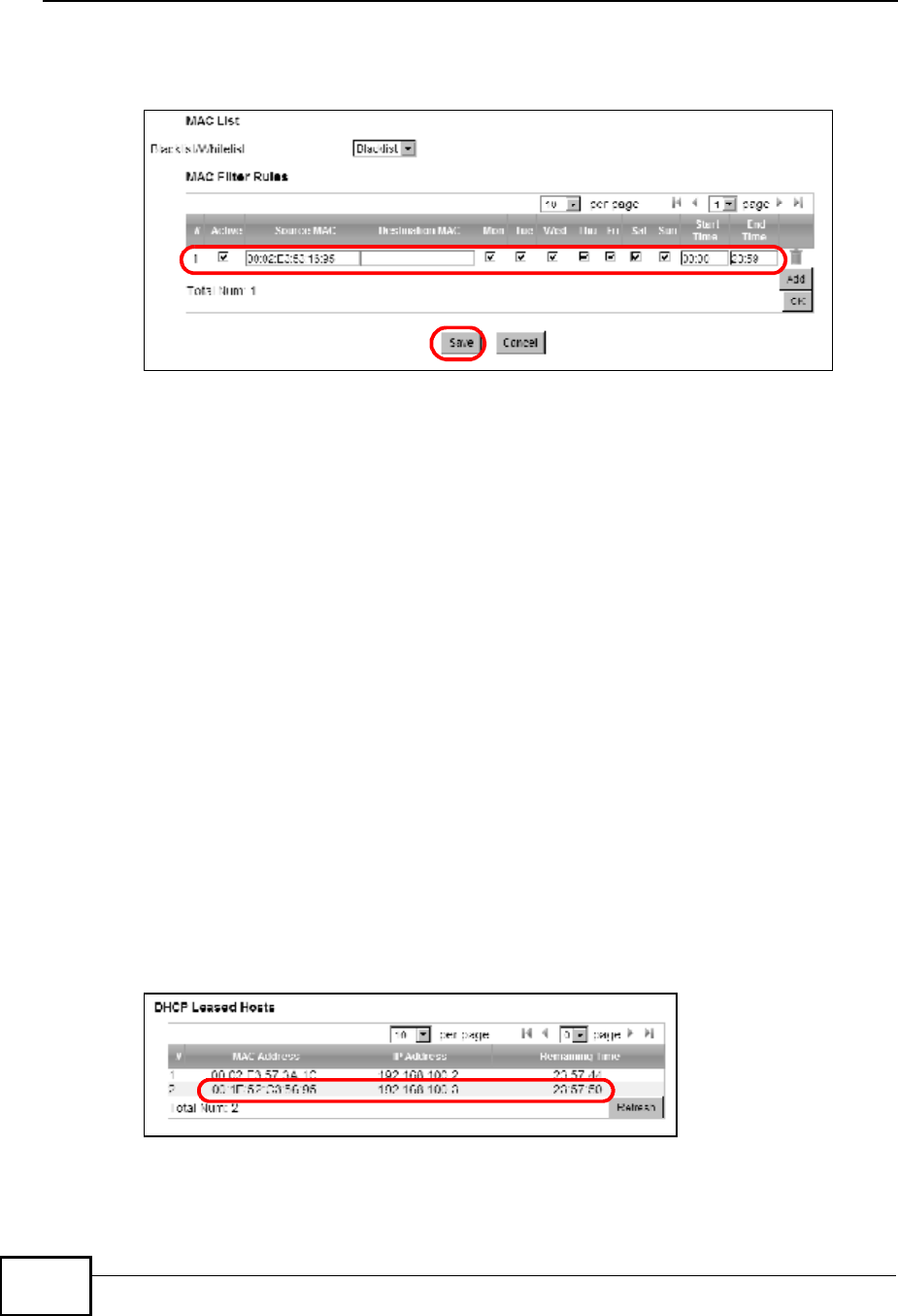
Chapter 4Tutorials
MAX208M User s Guide
42
3An empty entry appears. Enter the computer s MAC address in the Source MAC
field and leave the other fields set to their defaults. Click Save.
The computer will no longer be able to access any host on the WiMAX network
through the WiMAX Device.
4.7 Setting Up NAT Port Forwarding
Thomas recently received an Xbox 360 as his birthday gift. His friends invited him
to play online games with them on Xbox LIVE. In order to communicate and play
with other gamers on Xbox LIVE, Thomas needs to configure the port settings on
his WiMAX Device.
Xbox 360 requires the following ports to be available in order to operate Xbox
LIVE correctly:
TCP: 53, 80, 3074
UDP: 53, 88, 3074
1You have to know the Xbox 360 s IP address first. You can check it through the
Xbox 360 console. You may be able to check the IP address on the WiMAX Device
if the WiMAX Device has assigned a DHCP IP address to the Xbox 360. Check the
DHCP Leased Hosts table in the Network Setting > LAN > DHCP screen. Look
for the IP address for the Xbox 360.
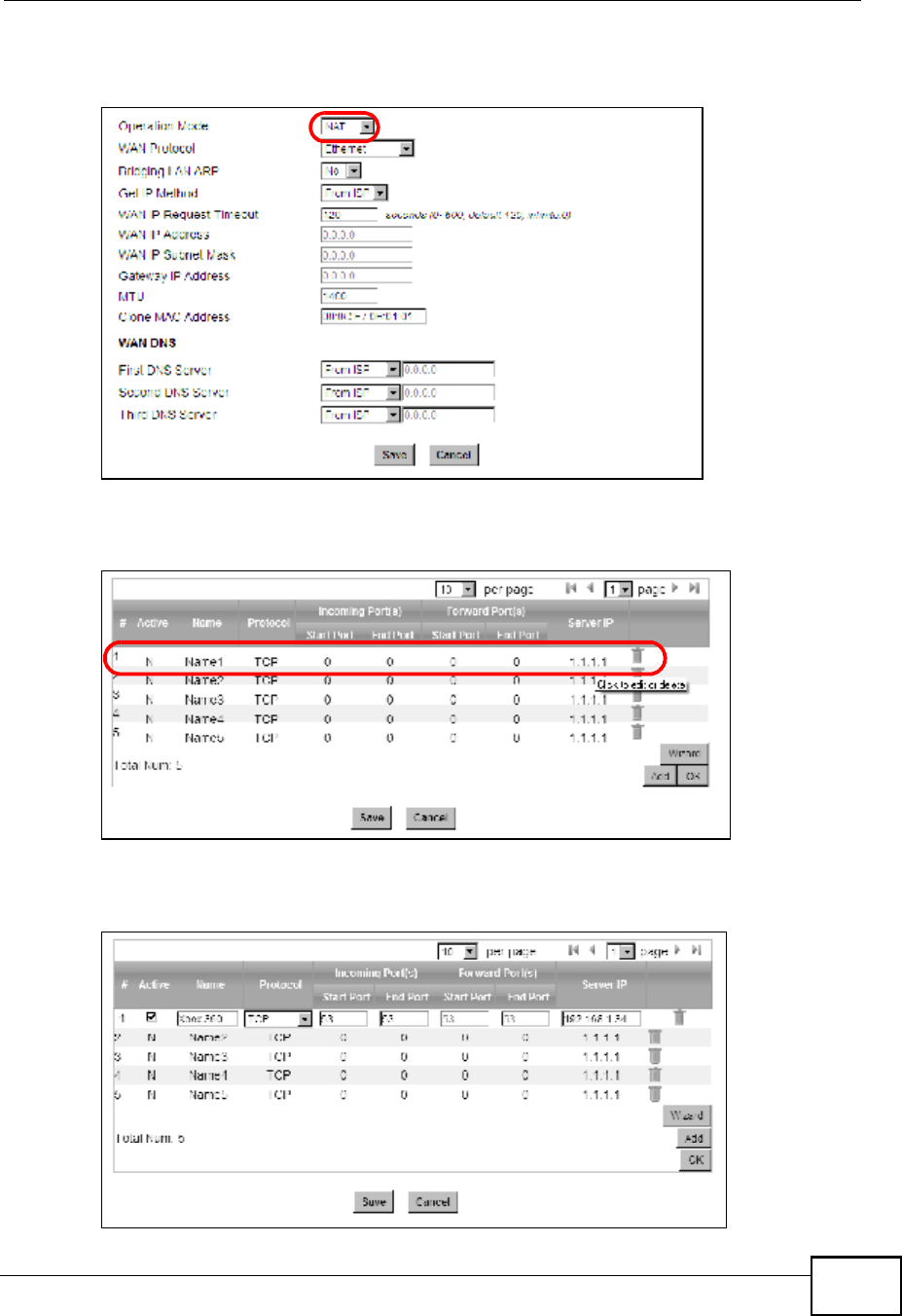
Chapter 4Tutorials
MAX208M User s Guide 43
2NAT mode is required to use port forwarding. Click Network Setting > WAN and
make sure NAT is selected in the Operation Mode field. Click Save.
3Click Network Setting > NAT > Port Forwarding and then click the first entry
to edit the rule.
4Configure the screen as follows to open TCP/UDP port 53 for the Xbox 360. Click
OK.
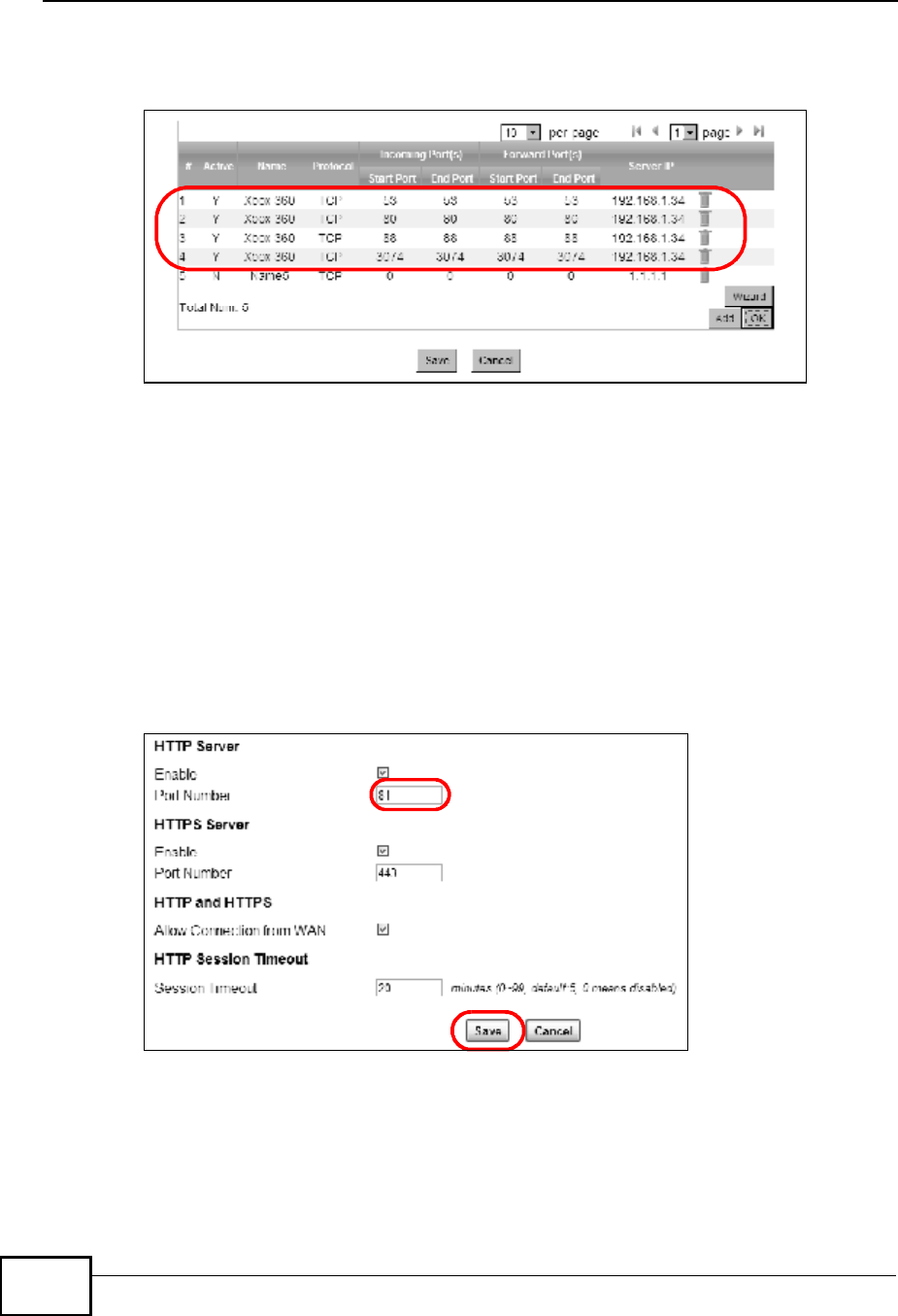
Chapter 4Tutorials
MAX208M User s Guide
44
5Repeat steps 2 and 3 to open the rest of the ports for the Xbox 360. The port
forwarding settings you configured are listed in the Port Forwarding screen.
6Click Save.
Thomas can then connect his Xbox 360 to the Internet and play online games with
his friends.
In this tutorial, all port 80 traffic is forwarded to the Xbox 360, but port 80 is also
the default listening port for remote management via WWW. If Thomas also wants
to manage the WiMAX Device from the Internet, he has to assign an unused port
to WWW remote access.
Click Maintenance > Remote MGMT. Enter an unused port in the Port field (81
in this example). Click Save.
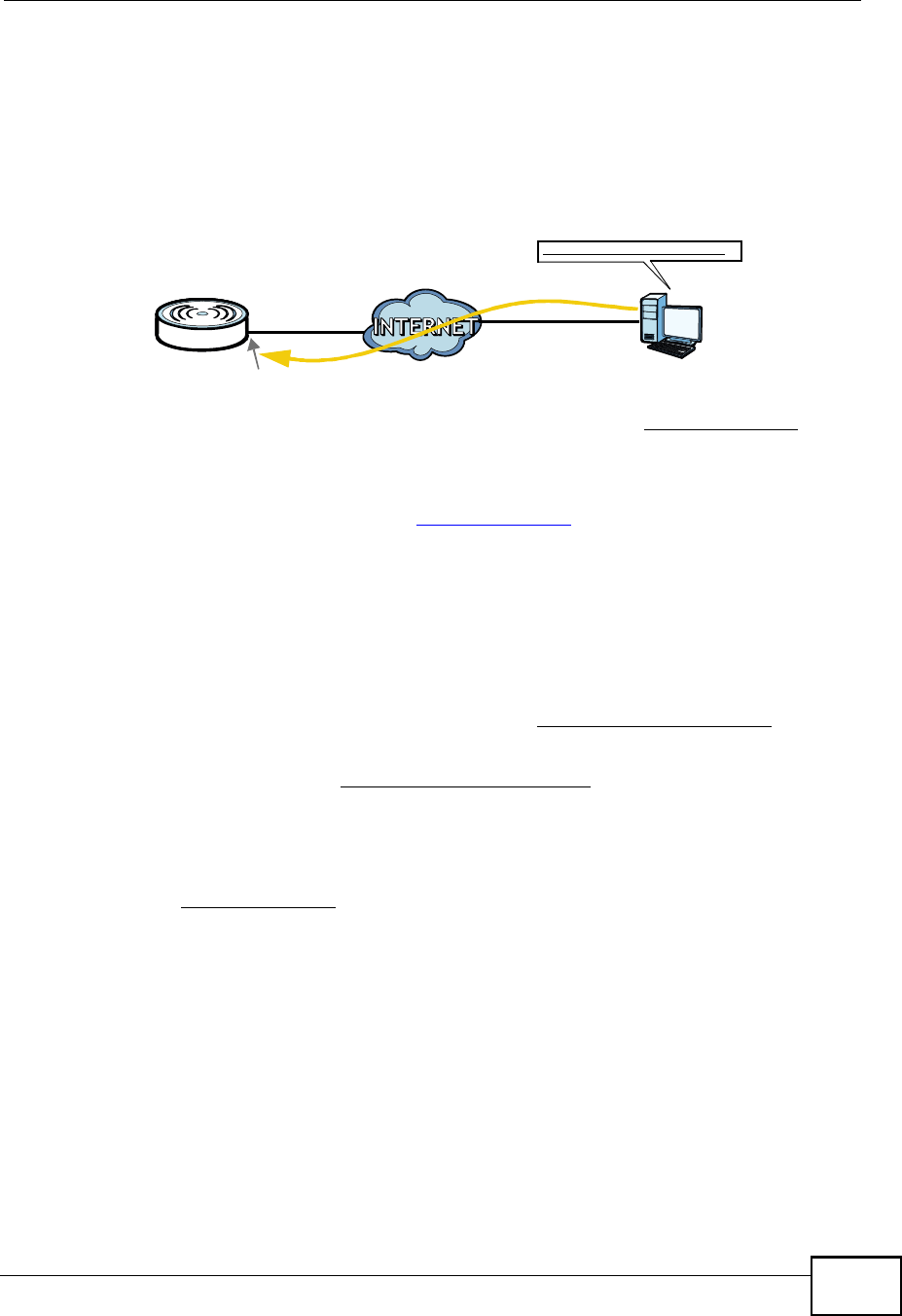
Chapter 4Tutorials
MAX208M User s Guide 45
4.8 Access the WiMAX Device Using DDNS
If you connect your WiMAX Device to the Internet and it uses a dynamic WAN IP
address, it is inconvenient for you to manage the device from the Internet. The
WiMAX Device s WAN IP address changes dynamically. Dynamic DNS (DDNS)
allows you to access the WiMAX Device using a domain name.
To use this feature, you have to apply for DDNS service at www.dyndns.org.
This tutorial covers:
!Registering a DDNS Account on www.dyndns.org
!Configuring DDNS on Your WiMAX Device
!Testing the DDNS Setting
Note: If you have a private WAN IP address (see Private IP Addresses on page 202),
then you cannot use DDNS.
4.8.1 Registering a DDNS Account on www.dyndns.org
1Open a browser and type http://www.dyndns.org.
2Apply for a user account. This tutorial uses UserName1 and 12345 as the
username and password.
3Log into www.dyndns.org using your account.
4Add a new DDNS host name. This tutorial uses the following settings as an
example.
!Hostname: mywimax.dyndns.org
!Service Type: Host with IP address
!IP Address: Enter the WAN IP address that your WiMAX Device is currently
using. You can find the IP address on the WiMAX Device s Web Configurator
Status page.
Then you will need to configure the same account and host name on the WiMAX
Device later.
w.x.y.z a.b.c.d
http://mywimax.dyndns.org
A
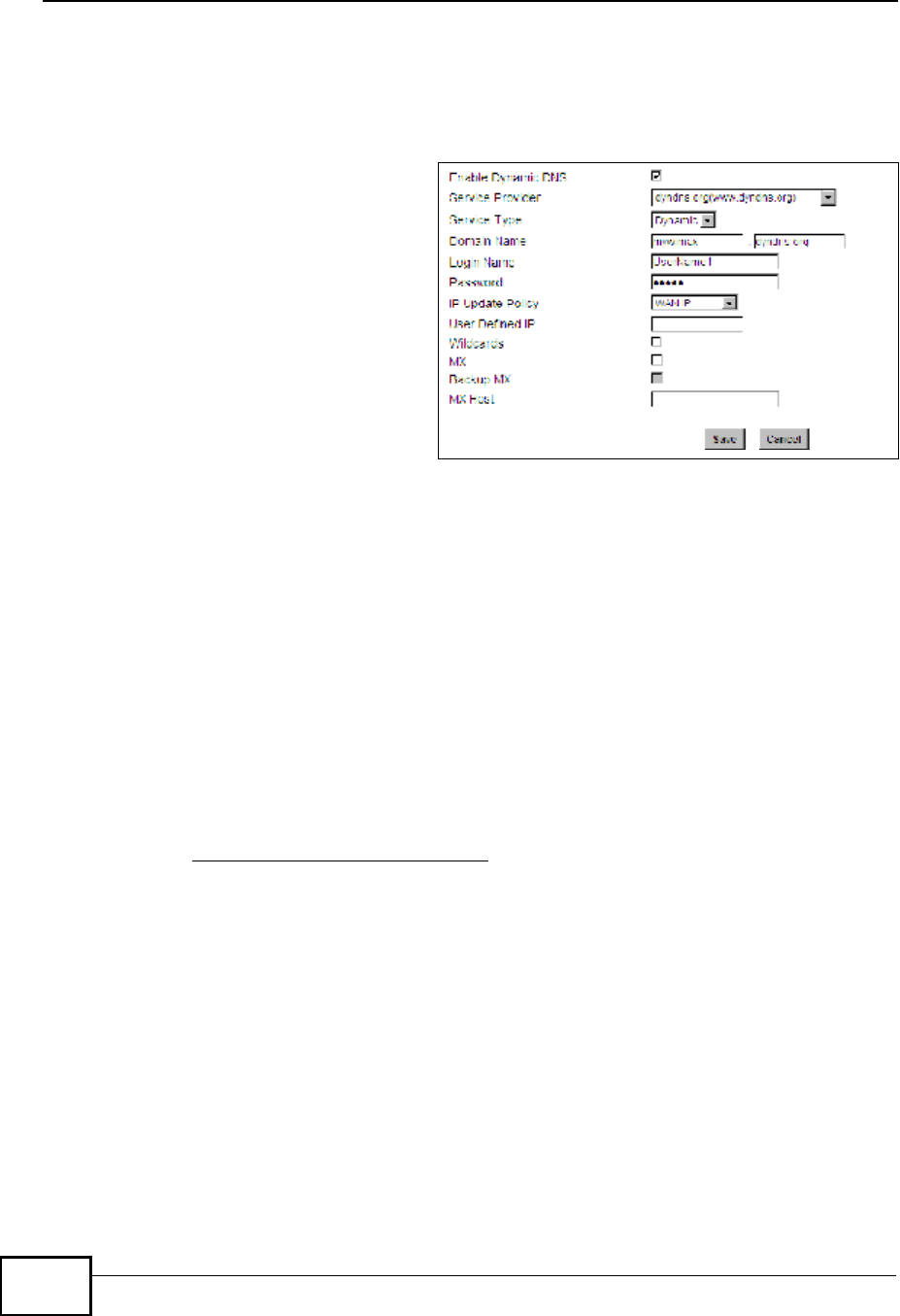
Chapter 4Tutorials
MAX208M User s Guide
46
4.8.2 Configuring DDNS on Your WiMAX Device
Configure the following settings in the Network Setting > DDNS screen.
1Select Enable Dynamic DNS.
2Select dyndns.org for the
service provider.
3Select Dynamic for the
service type.
4Type mywimax.dyndns.org
in the Domain Name field.
5Enter the user name
(UserName1) and password
(12345).
6Select WAN IP for the IP update policy.
7Click Save.
4.8.3 Testing the DDNS Setting
Now you should be able to access the WiMAX Device from the Internet. To test
this:
1Open a web browser on the computer (using the IP address a.b.c.d) that is
connected to the Internet.
2Type http://mywimax.dyndns.org and press [Enter].
3The WiMAX Device s login page should appear. You can then log into the WiMAX
Device and manage it.
4.9 Configuring Static Route for Routing to
Another Network
In order to extend your Intranet and control traffic flowing directions, you may
connect a router to the WiMAX Device s LAN. The router may be used to separate
two department networks. This tutorial shows how to configure a static routing
rule for two network routings.
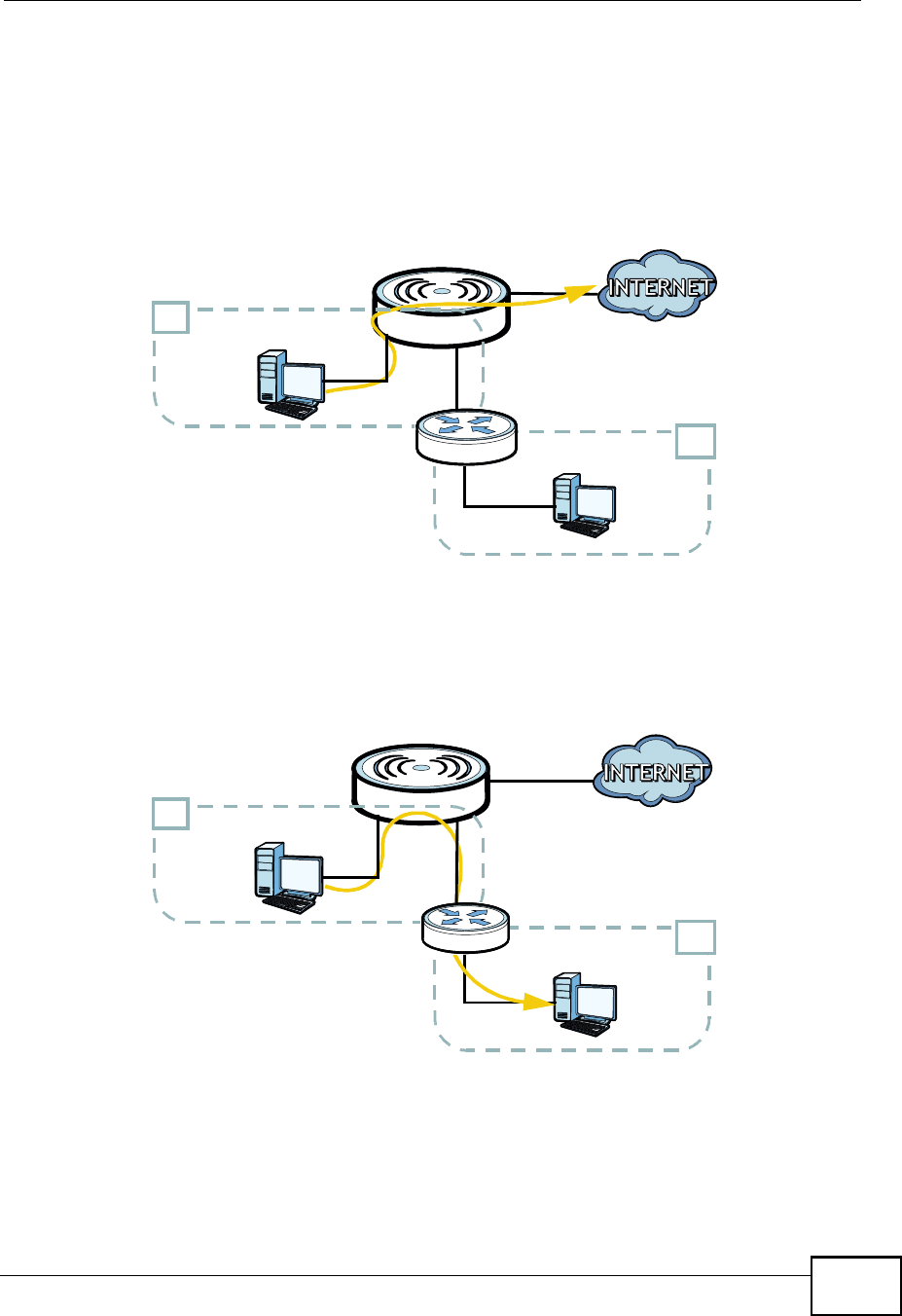
Chapter 4Tutorials
MAX208M User s Guide 47
In the following figure, router R is connected to the WiMAX Device s LAN. R
connects to two networks, N1 (192.168.1.x/24) and N2 (192.168.10.x/24). If
you want to send traffic from computer A (in N1 network) to computer B (in N2
network), the traffic is sent to the WiMAX Device s WAN default gateway by
default. In this case, computer B will never receive the traffic.
You need to specify a static routing rule on the WiMAX Device to specify R as the
router in charge of forwarding traffic to N2. In this case, the WiMAX Device routes
traffic from computer A to R and then R routes the traffic to computer B.
N2
B
A
R
N1
N2
B
N1
A
R
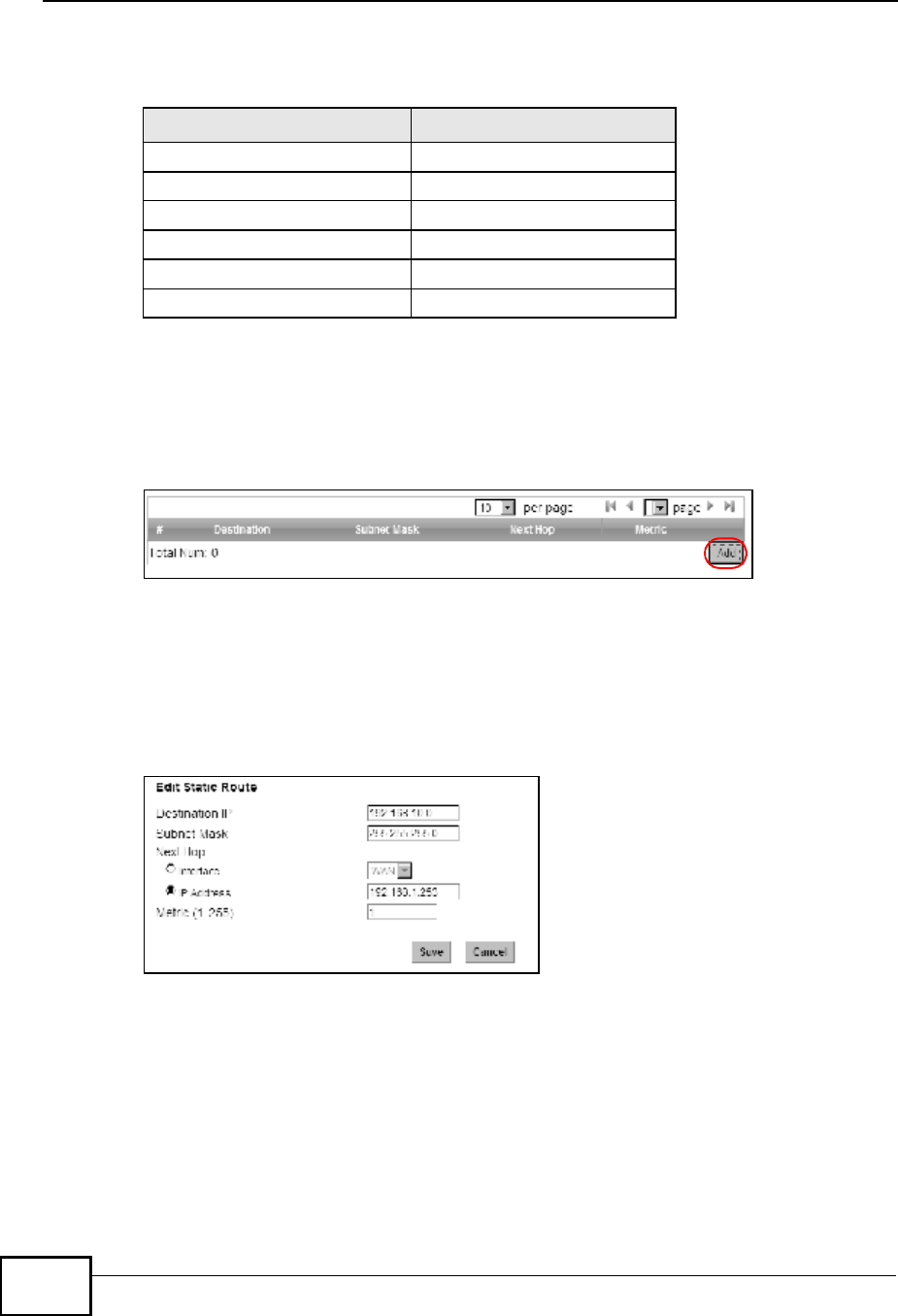
Chapter 4Tutorials
MAX208M User s Guide
48
This tutorial uses the following example IP settings:
To configure a static route to route traffic from N1 to N2:
1Click Network Setting > Route > Static Route.
2Click Add to create a new route.
3Configure the Edit Static Route screen using the following settings:
3a Enter 192.168.10.0 and subnet mask 255.255.255.0 for the destination,
N2.
3b Enter 192.168.1.253 (R s IP address on N1) in the IP Address field under
Next Hop.
3a Click Save.
Now computer B should be able to receive traffic from computer A. You may need
to additionally configure R s firewall settings to accept specific traffic to pass
through.
Table 9 IP Settings in this Tutorial
DEVICE / COMPUTER IP ADDRESS
The WiMAX Device s WAN172.16.1.1
The WiMAX Device s LAN192.168.1.1
A192.168.1.34
R s IP address on N1 192.168.1.253
R s IP address on N2 192.168.10.2
B192.168.10.33
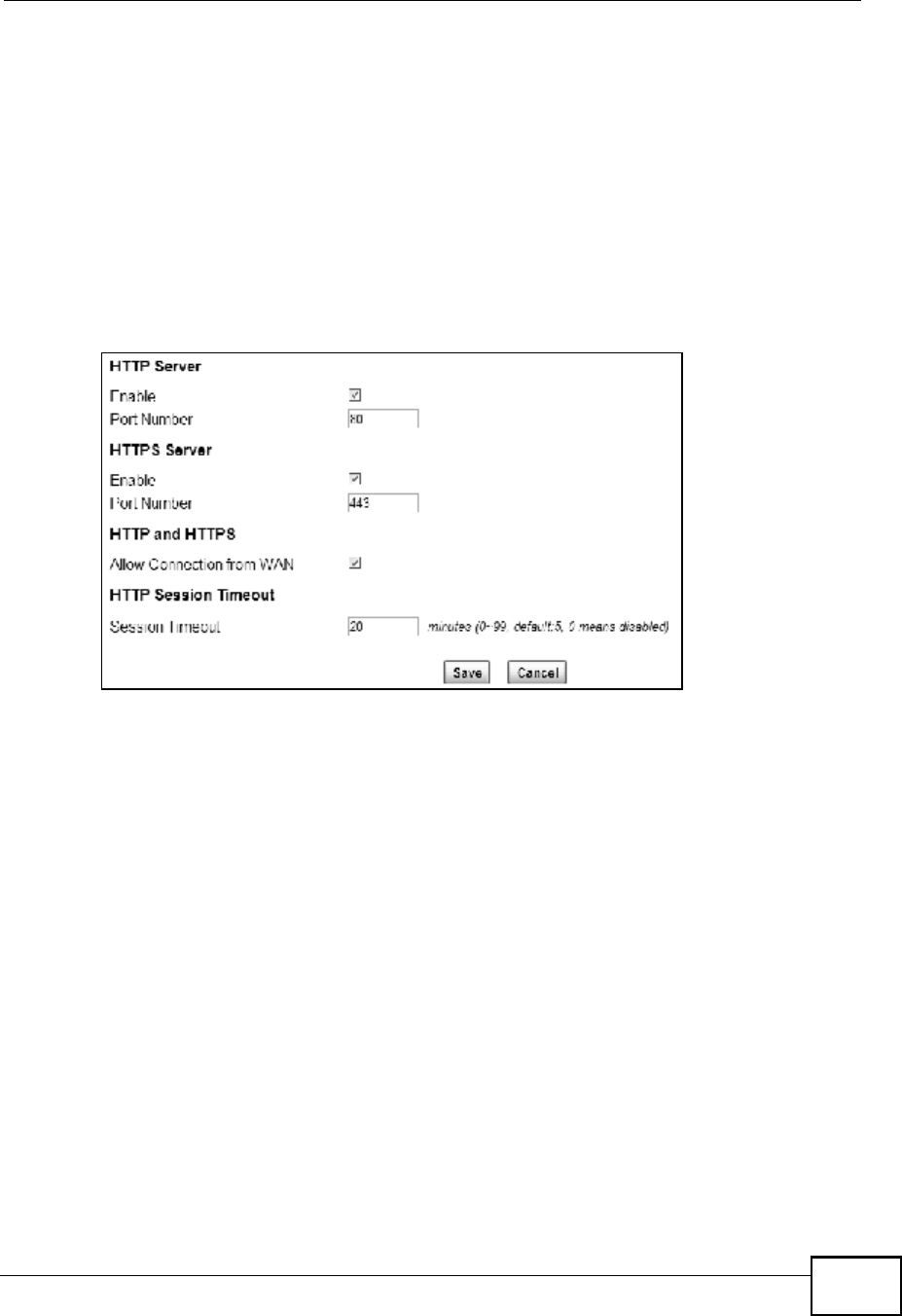
Chapter 4Tutorials
MAX208M User s Guide 49
4.10 Remotely Managing Your WiMAX Device
The remote management feature allows you to log into the device through the
Internet.
Goal: Set up the WiMAX Device to allow management requests from the WAN
(Internet).
See Also: Section 9.3 on page 121.
1Open the Maintenance > Remote MGMT > HTTP screen.
2Select Enable in both HTTP Server and HTTPS Server sections and leave the
Port Number settings as "80# and "443#.
3Select Allow Connection from WAN. This allows remote management
connections not only from the local network but also the WAN network (Internet).
4Click Save.

Chapter 4Tutorials
MAX208M User s Guide
50

51
PART II
Technical Reference

52
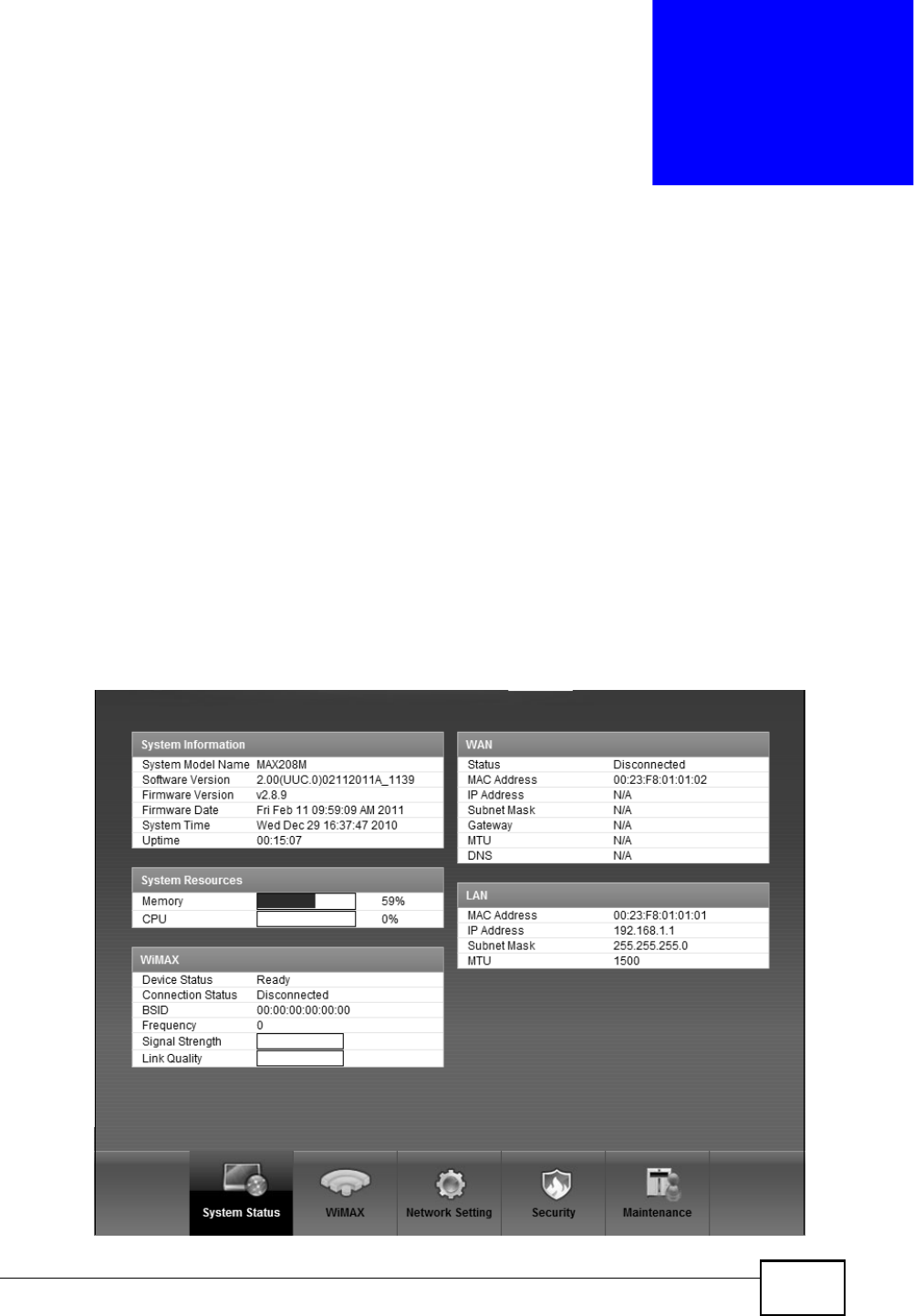
MAX208M User s Guide 53
CHAPTER 5
System Status
5.1 Overview
Use this screen to view a summary of your WiMAX Device connection status.
5.2 System Status
This screen allows you to view the current status of the device, system resources,
and interfaces (LAN and WAN).
Click System Status to open this screen as shown next.
Figure 11 System Status

Chapter 5System Status
MAX208M User s Guide
54
The following tables describe the labels in this screen.
Table 10 Status
LABEL DESCRIPTION
System Information
System
Model Name
This field displays the WiMAX Device system model name. It is used for
identification.
Software
Version
This field displays the Web Configurator version number.
Firmware
Version
This field displays the current version of the firmware inside the device.
Firmware
Date
This field shows the date the firmware version was created.
System
Time
This field displays the current system time.
UptimeThis field displays how long the WiMAX Device has been running since it
last started up.
System Resources
MemoryThis field displays what percentage of the WiMAX Device s memory is
currently used. The higher the memory usage, the more likely the
WiMAX Device is to slow down. Some memory is required just to start
the WiMAX Device and to run the web configurator. You can reduce the
memory usage by disabling some services; by reducing the amount of
memory allocated to NAT and firewall rules (you may have to reduce
the number of NAT rules or firewall rules to do so); or by deleting rules
in functions such as incoming call policies, speed dial entries, and static
routes.
CPUThis field displays what percentage of the WiMAX Device s CPU is
currently used. The higher the CPU usage, the more likely the WiMAX
Device is to slow down.
WiMAX
Device
Status
This field displays the WiMAX Device current status for connecting to
the selected base station.
Scanning - The WiMAX Device is scanning for available base stations.
Ready - The WiMAX Device has finished a scanning and you can
connect to a base station.
Connecting - The WiMAX Device attempts to connect to the selected
base station.
Connected - The WiMAX Device has successfully connected to the
selected base station.
UMAC StateThis field displays the status of the WiMAXconnection between the
WiMAX Device and the base station.
Network Search - The WiMAX Device is scanning for any available
WiMAX connections.
Disconnected - No WiMAX connection is available.
Network Entry - A WiMAX connection is initializing.
Normal - The WiMAX connection has successfully established.

Chapter 5System Status
MAX208M User s Guide 55
BSIDThis field displays the MAC address of the base station to which the
device is connected.
FrequencyThis field indicates the frequency the WiMAX Device is using.
Signal
Strength
This field indicates the strength of the connection that the WiMAX
Device has with the base station.
Link QualityThis field indicates the relative quality of the link the WiMAX Device has
with the base station.
WAN
StatusThis field indicates the status of the WAN connection to the WiMAX
Device.
MAC
Address
This field indicates the MAC address of the port making the WAN
connection on the WiMAX Device.
IP AddressThis field indicates the current IP address of the WiMAX Device in the
WAN.
Subnet MaskThis field indicates the current subnet mask on the WAN.
GatewayThis field indicates the IP address of the gateway to which the WiMAX
Device is connected.
MTUThis field indicates the Maximum Transmission Unit (MTU) between the
WiMAX Device and the ISP servers to which it is connected.
DNSThis field indicates the Domain Name Server (DNS) to which your
WiMAX Device is connected.
LAN
MAC
Address
This field indicates the MAC address of the port making the LAN
connection on the WiMAX Device.
IP AddressThis field displays the current IP address of the WiMAX Device in the
LAN.
Subnet MaskThis field displays the current subnet mask in the LAN.
MTUThis field indicates the Maximum Transmission Unit (MTU) between the
WiMAX Device and the client devices to which it is connected.
Table 10 Status (continued)
LABEL DESCRIPTION

Chapter 5System Status
MAX208M User s Guide
56
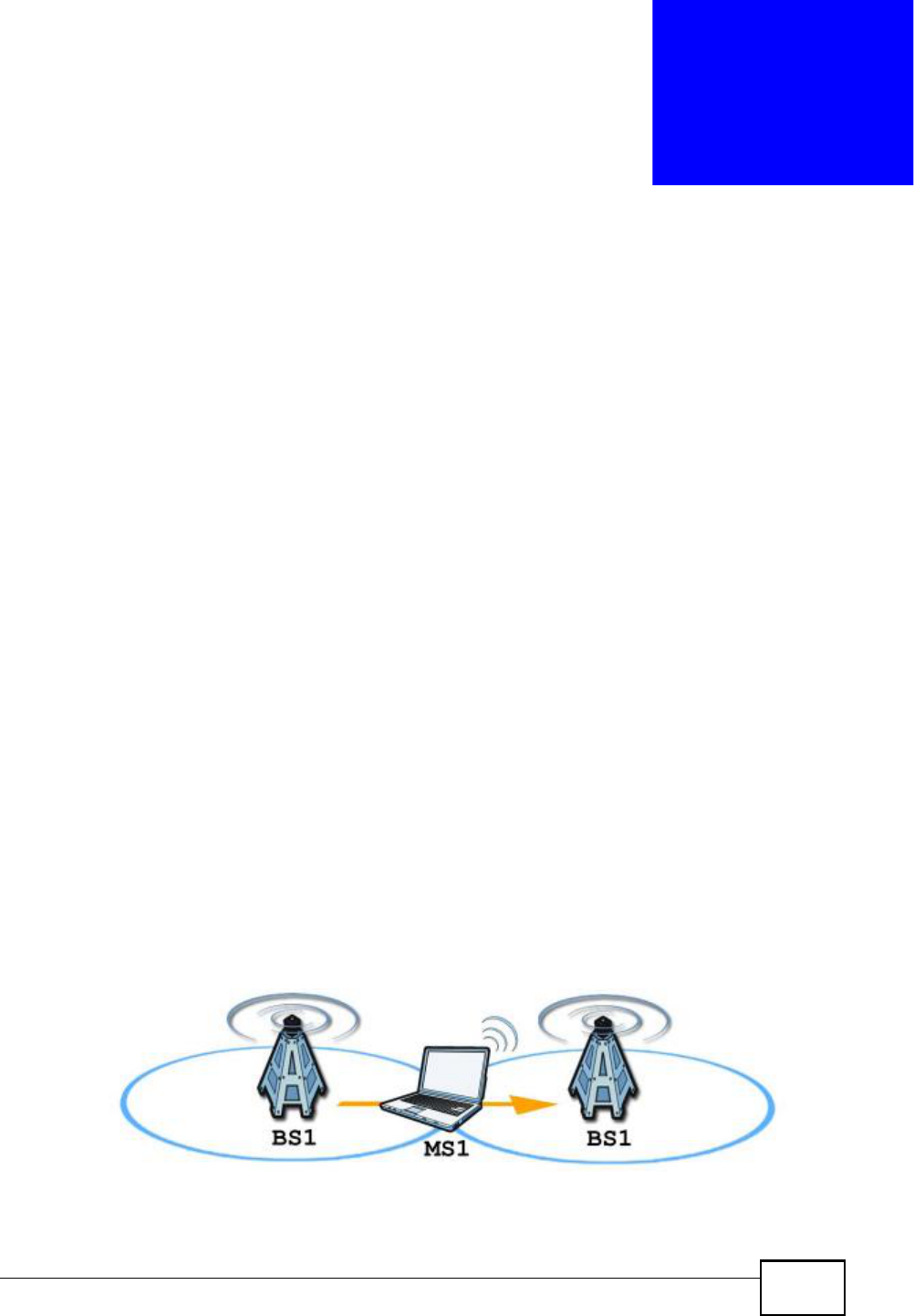
MAX208M User s Guide 57
CHAPTER 6
WiMAX
6.1 Overview
This chapter shows you how to set up and manage the connection between the
WiMAX Device and your ISP s base stations.
6.1.1 What You Need to Know
The following terms and concepts may help as you read through this chapter.
WiMAX
WiMAX (Worldwide Interoperability for Microwave Access) is the IEEE 802.16
wireless networking standard, which provides high-bandwidth, wide-range
wireless service across wireless Metropolitan Area Networks (MANs). ZyXEL is a
member of the WiMAX Forum, the industry group dedicated to promoting and
certifying interoperability of wireless broadband products.
In a wireless MAN, a wireless-equipped computer is known either as a mobile
station (MS) or a subscriber station (SS). Mobile stations use the IEEE 802.16e
standard and are able to maintain connectivity while switching their connection
from one base station to another base station (handover) while subscriber stations
use other standards that do not have this capability (IEEE 802.16-2004, for
example). The following figure shows an MS-equipped notebook computer MS1
moving from base station BS1 s coverage area and connecting to BS2.
Figure 12 WiMax: Mobile Station
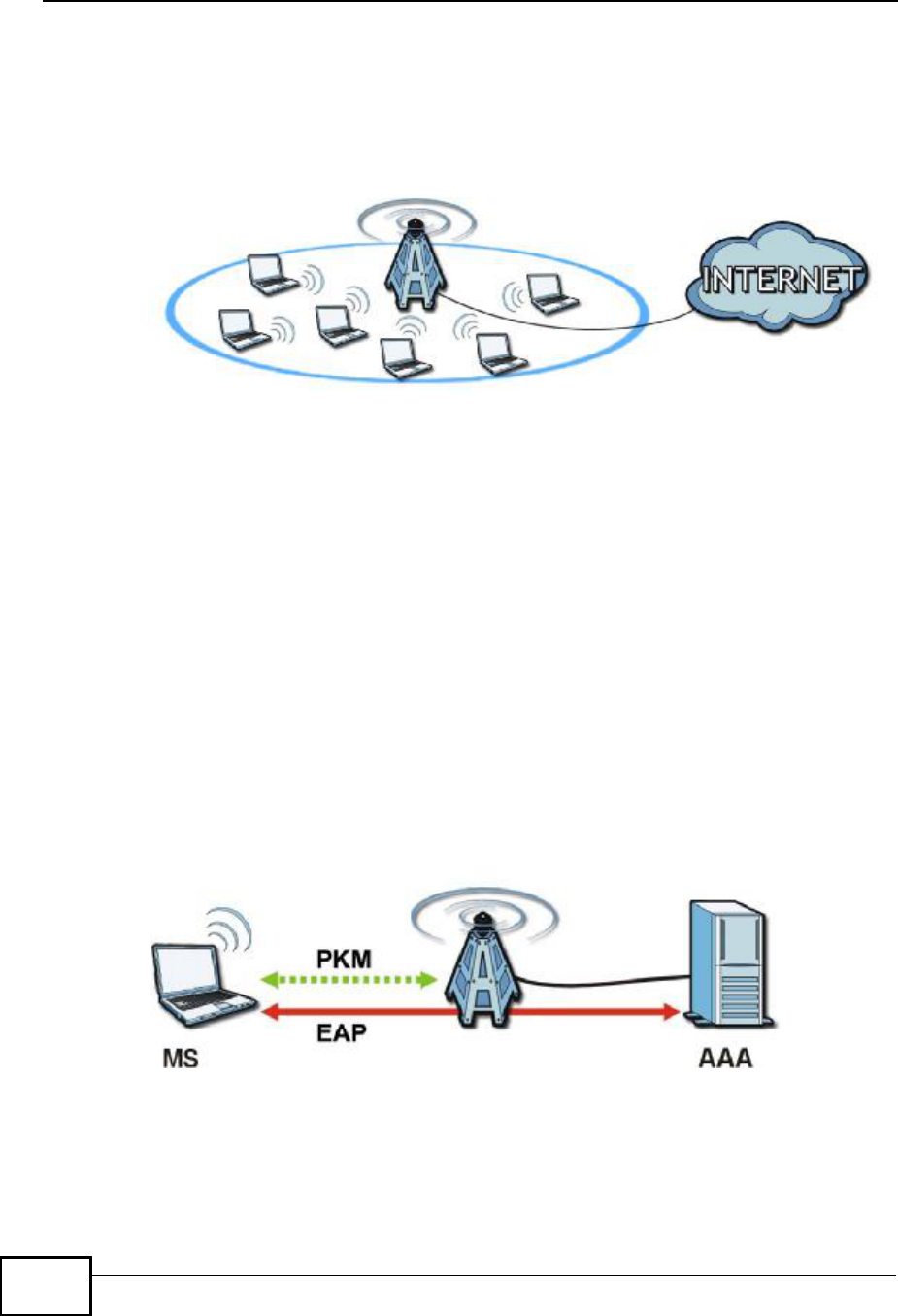
Chapter 6WiMAX
MAX208M User s Guide
58
WiMAX technology uses radio signals (around 2 to 10 GHz) to connect subscriber
stations and mobile stations to local base stations. Numerous subscriber stations
and mobile stations connect to the network through a single base station (BS), as
in the following figure.
Figure 13 WiMAX: Multiple Mobile Stations
A base station s coverage area can extend over many hundreds of meters, even
under poor conditions. A base station provides network access to subscriber
stations and mobile stations, and communicates with other base stations.
The radio frequency and bandwidth of the link between the WiMAX Device and the
base station are controlled by the base station. The WiMAX Device follows the
base station s configuration.
Authentication
When authenticating a user, the base station uses a third-party RADIUS or
Diameter server known as an AAA (Authentication, Authorization and Accounting)
server to authenticate the mobile or subscriber stations.
The following figure shows a base station using an AAA server to authenticate
mobile station MS, allowing it to access the Internet.
Figure 14 Using an AAA Server
In this figure, the dashed arrow shows the PKM (Privacy Key Management)
secured connection between the mobile station and the base station, and the solid
arrow shows the EAP secured connection between the mobile station, the base
station and the AAA server. See the WiMAX security appendix for more details.
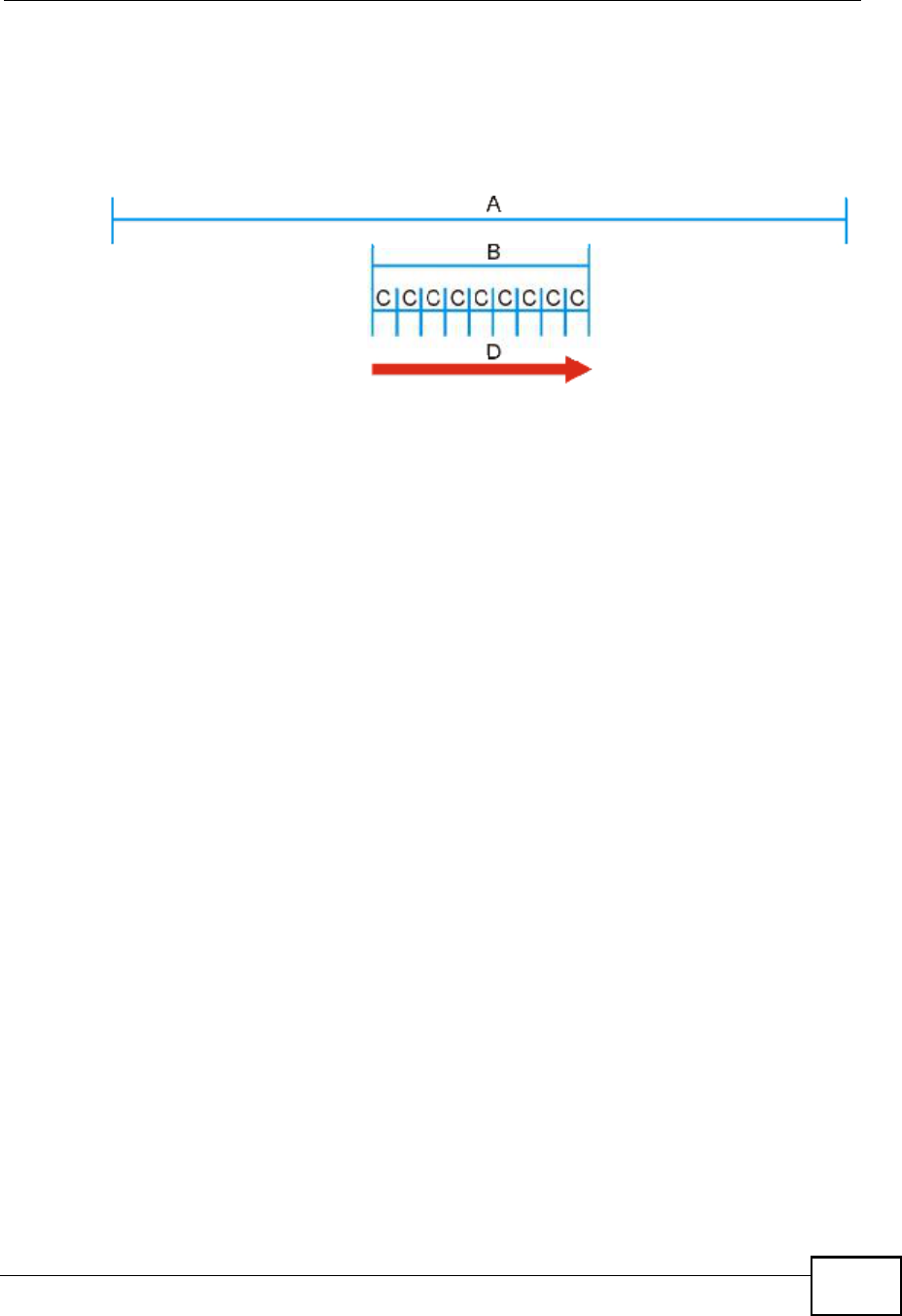
Chapter 6WiMAX
MAX208M User s Guide 59
Frequency Ranges
The following figure shows the WiMAX Device searching a range of frequencies to
find a connection to a base station.
Figure 15 Frequency Ranges
In this figure, A is the WiMAX frequency range. "WiMAX frequency range# refers to
the entire range of frequencies the WiMAX Device is capable of using to transmit
and receive (see the Product Specifications appendix for details).
In the figure, B shows the operator frequency range. This is the range of
frequencies within the WiMAX frequency range supported by your operator
(service provider).
The operator range is subdivided into bandwidth steps. In the figure, each C is a
bandwidth step.
The arrow D shows the WiMAX Device searching for a connection.
Have the WiMAX Device search only certain frequencies by configuring the
downlink frequencies. Your operator can give you information on the supported
frequencies.
The downlink frequencies are points of the frequency range your WiMAX Device
searches for an available connection. Use the Site Survey screen to set these
bands. You can set the downlink frequencies anywhere within the WiMAX
frequency range. In this example, the downlink frequencies have been set to
search all of the operator range for a connection.
Certification Authority
A Certification Authority (CA) issues certificates and guarantees the identity of
each certificate owner. There are commercial certification authorities like
CyberTrust or VeriSign and government certification authorities. You can use the
WiMAX Device to generate certification requests that contain identifying
information and public keys and then send the certification requests to a
certification authority.

Chapter 6WiMAX
MAX208M User s Guide
60
Certificate File Formats
The certification authority certificate that you want to import has to be in one of
these file formats:
!Binary X.509: This is an ITU-T recommendation that defines the formats for
X.509 certificates.
!PEM (Base-64) encoded X.509: This Privacy Enhanced Mail format uses
lowercase letters, uppercase letters and numerals to convert a binary X.509
certificate into a printable form.
!Binary PKCS#7: This is a standard that defines the general syntax for data
(including digital signatures) that may be encrypted. The WiMAX Device
currently allows the importation of a PKS#7 file that contains a single
certificate.
!PEM (Base-64) encoded PKCS#7: This Privacy Enhanced Mail (PEM) format uses
64 ASCII characters to convert a binary PKCS#7 certificate into a printable
form.
CINR
Carrier to Interference-plus-Noise Ratio (CINR) measures the effectiveness of a
wireless signal and plays an important role in allowing the WiMAX Device to
decode signal burts. If a burst has a high signal strength and a high interference-
plus-noise ratio, it can use Digital Signal Processing (DSP) to decode it; if the
signal strength is lower, it can switch to an alternate burst profile.
RSSI
Received Signal Strength Indicator (RSSI) measures the relative strength of a
given wireless signal. This is important in determining if a signal is below the
Clear-To-Send (CTS) threshold. If it is below the arbitrarily specified threshold,
then WiMAX Device is free to transmit any data packets.
EAP Authentication
EAP (Extensible Authentication Protocol) is an authentication protocol that runs on
top of the IEEE 802.1x transport mechanism in order to support multiple types of
user authentication. By using EAP to interact with an EAP-compatible RADIUS
server, an access point helps a wireless station and a RADIUS server perform
authentication.
The WiMAX Device supports EAP-TLS and EAP-TTLS (at the time of writing, TTLS is
not available in Windows Vista) . For EAP-TLS authentication type, you must first
have a wired connection to the network and obtain the certificate(s) from a
certificate authority (CA). Certificates (also called digital IDs) can be used to
authenticate users and a CA issues certificates and guarantees the identity of each
certificate owner.
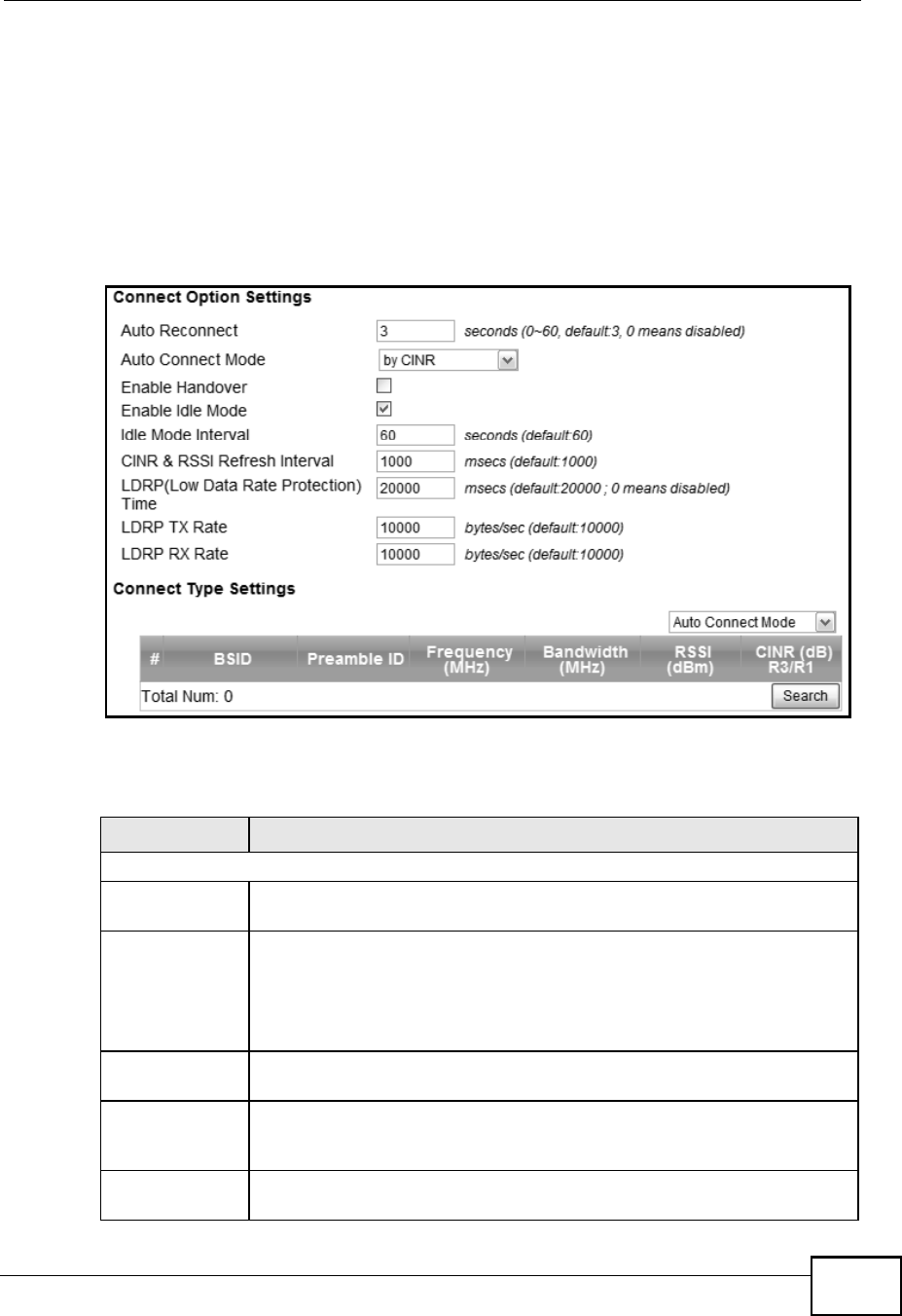
Chapter 6WiMAX
MAX208M User s Guide 61
6.2 Connection Settings
This screen allows you to configure how the WiMAX Device connects to the base
stations on the WiMAX network.
Click WiMAX > Profile > Connection Settings to open this screen as shown
next.
Figure 16 Connection Settings Screen
This screen contains the following fields:
Table 11 Connection Settings
LABEL DESCRIPTION
Connection Option Settings
Auto
Reconnect
Select the interval in seconds that the WiMAX Device waits after getting
disconnected from the base station before attempting to reconnect.
Auto
Connect
Mode
Select the auto connect mode.
!By channel power - Auto connects to the base station if the signal
strength of the channel is sufficient for the WiMAX Device.
!By CINR - Auto connects to the base station if the signal-to-noise
ratio is sufficient for the WiMAX Device.
Enable
Handover
Select this to maintain connectivity while the WiMAX Device switches its
connection from one base station to another base station.
Enable Idle
Mode
Select this to have the WiMAX Device enter the idle mode after it has no
traffic passing through for a pre-defined period. Make sure your base
station also supports this before selecting this.
Idle Mode
Interval
Set the idle duration in minutes. This is how long the WiMAX Device
waits during periods of no activity before going into idle mode.

Chapter 6WiMAX
MAX208M User s Guide
62
CINR & RSSI
Refresh
Interval
Set the refresh interval in milliseconds for calculating the signal-to-
noise measurement (CINR) and signal strength measurement (RSSI) of
the WiMAX Device.
LDRP (Low
Data Rate
Protection)
Enter the Low Data Rate Protection (LDRP) time in milliseconds. If the
uplink/downlink data rate is smaller than the LDRP time, the WiMAX
Device sends a disconnect request to the base station.
LDRP TX
Rate
Enter the outgoing data rates for LDRP in bytes per second.
LDRP RX
Rate
Enter the incoming data rates for LDRP in bytes per second.
Connection Type Settings
Mode SelectSelect how the WiMAX Device connects to the base station.
!Auto Connect Mode - The device connects automatically to the
first base station in range.
!Network Search Mode - The device scans for available base
stations then connects to the best one it can.
BSIDThis displays the MAC address of a base station within range of the
WiMAX Device.
Preamble IDThe preamble ID is the index identifier in the header of the base
station s broadcast messages. In the beginning of a mobile stations s
network entry process, it searches for the preamble and uses it to
additional channel information.
The preamble ID is used to synchronize the upstream and downstream
transmission timing with the base station.
Frequency
(MHz)
This field displays the radio frequency of the WiMAX Device s connection
to the base station.
Bandwidth
(MHz)
This field displays the bandwidth of the base station in megahertz
(MHz).
RSSI (dBm)This field displays the Received Signal Strength Indication (RSSI),
which is an overal measurement of radio signal strength. A higher RSSI
level indicates a stronger signal.
CINR (dB)
R3/R1
This field displays the average Carrier to Interference plus Noise Ratio
for the current connection. This value is an indication of overal radio
signal quality, where a higher value means a better quality signal.
SearchClick this to have the WiMAX Device scan for base stations.
Table 11 Connection Settings (continued)
LABEL DESCRIPTION

Chapter 6WiMAX
MAX208M User s Guide 63
6.3 Frequency Settings
Use this screen to have the WiMAX Device scan one or more specific radio
frequencies (given by your WiMAX service provider) to find available connections
to base stations.
Click WiMAX > Profile > Frequency Settings to open this screen as shown
next.
Figure 17 Frequency Settings Screen (By List)
Figure 18 Frequency Settings Screen (By Range)
This screen contains the following fields:
Table 12 Frequency Settings
LABEL DESCRIPTION
Setting TypeSelect whether to scan base stations by entering specific frequency(-
ies) (By List) or a range of frequencies (By Range).
Note: When you select By Range, you can only configure one
range of frequencies in this screen. To configure multiple
frequency ranges, use the WiMAX > Wide Scan screen.
Note: Some settings in this screen are only available depending on
the Setting Type selected.
Join Wide Scan
Result
The scanning result of the frequency to scan you configured in this
screen will be shown in the WiMAX > Connect screen. Select this
option to determine whether to also append the wide scanning result
(configured in the WiMAX > Wide Scan screen) to the same table.
Default
Bandwidth
Select the default bandwidth (size) per frequency band you specify in
table A.
A
B
A
B

Chapter 6WiMAX
MAX208M User s Guide
64
A (When By List is selected in the Setting Type field)
Frequency
(KHz)
This displays the center frequency of an frequency band in kilohertz
(KHz).
Click the number to modify it.
Enter the center frequency in this field when you are adding an entry.
Bandwidth
(MHz)
This displays the bandwidth of the frequency band in megahertz (MHz).
If you set a center frequency to 2610000 KHz with the bandwidth of 10
MHz, then the frequency band is from 2605000 to 2615000 KHz.
Click the number to modify it.
Enter the bandwidth of the frequency band in this field when you are
adding an entry.
DeleteClick this button to remove an item from the list.
AddClick this button to add an item to the list.
OKClick this button to save any changes made to the list.
A (When By Range is selected in the Setting Type field)
Start
Frequency
(KHz)
This indicates the beginning of a frequency band in kilohertz (KHz).
Click this field to modify it.
Enter the beginning frequency when you are adding an entry.
End
Frequency
(KHz)
This indicates the end of the frequency band in kilohertz (KHz).
Click this field to modify it.
Step (KHz)This indicates the frequency step within each band in kilohertz (KHz).
Click this field to modify it.
Bandwidth
(MHz)
This indicates the bandwidth in megahertz (MHz).
Click this field to modify it.
OKClick this button to save any changes made to the list.
Valid Band Info (B)
This table displays the entire frequency band the WiMAX Device supports. The
frequenc(ies) to scan that you configured in table A must be within this range.
Band Start
(KHz)
This indicates the beginning of the frequency band in kilohertz (KHz).
Band End
(KHz)
This indicates the end of the frequency band in kilohertz (KHz).
Table 12 Frequency Settings (continued)
LABEL DESCRIPTION
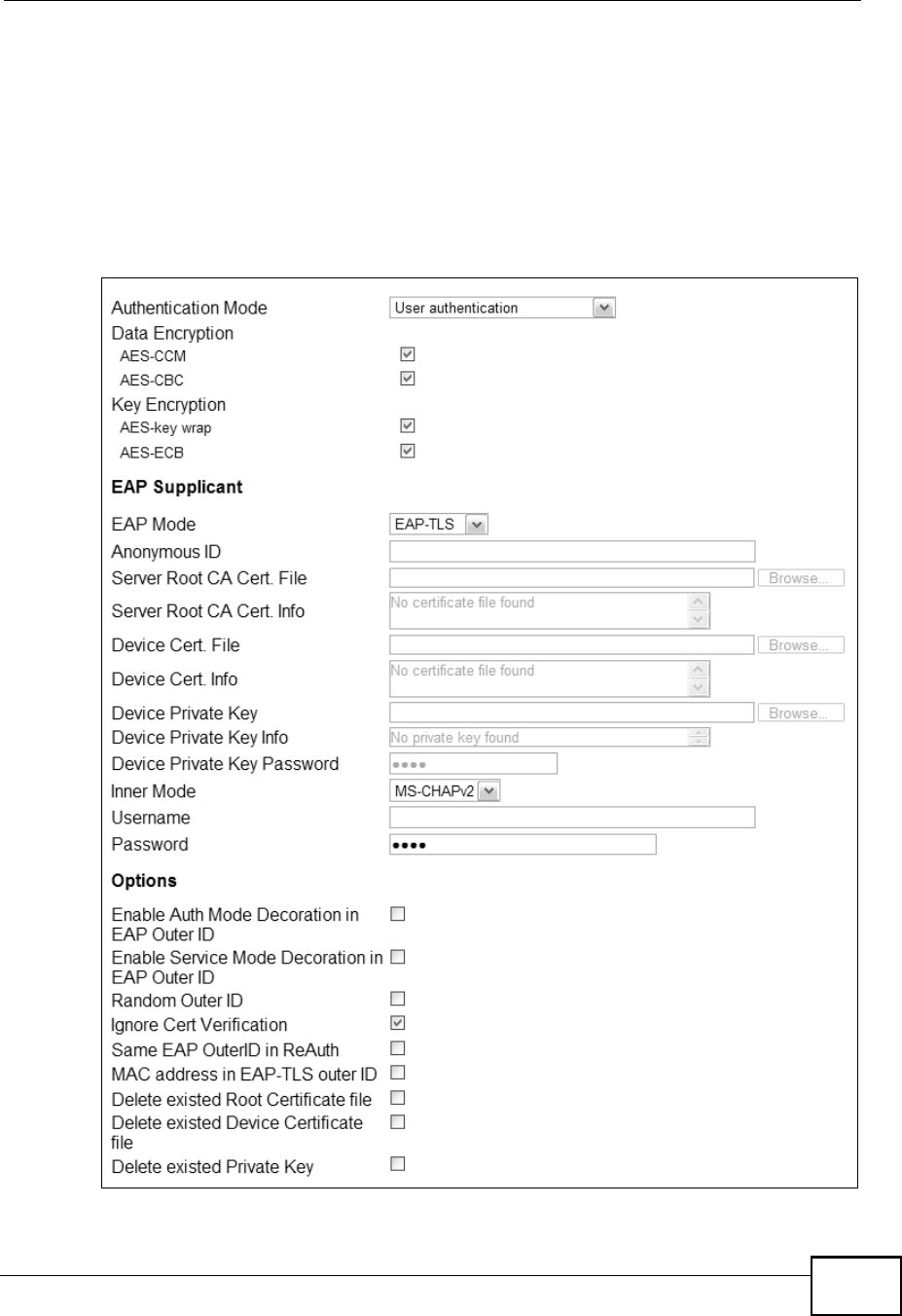
Chapter 6WiMAX
MAX208M User s Guide 65
6.4 Authentication Settings
These settings allow the WiMAX Device to establish a secure (authenticated)
connection with the service provider.
Click WiMAX > Profile > Authentication Settings to open this screen as shown
next.
Figure 19 Authentication Settings Screen

Chapter 6WiMAX
MAX208M User s Guide
66
This screen contains the following fields:
Table 13 Authentication Settings
LABEL DESCRIPTION
Authentication
Mode
Select the authentication mode from the list.
The WiMAX Device supports the following authentication modes:
!No authentication
!User authentication
!Device authentication
!User and device authentication
Data Encryption
AES-CCMSelect this to enable AES-CCM encryption. CCM combines counter-mode
encryption with CBC-MAC authentication.
AES-CBCSelect this to enable AES-CBC encryption. CBC creates message
authentication code from a block cipher.
Key Encryption
AES-key
wrap
Select this encapsulate cryptographic keys in a symmetric encryption
algorithm.
AES-ECBSelect this to divide cryptographic keys into blocks and encrypt them
separately.
EAP Supplicant
EAP ModeSelect an Extensible Authentication Protocol (EAP) mode.
The WiMAX Device supports the following:
!EAP-TLS - In this protocol, digital certifications are needed by both
the server and the wireless clients for mutual authentication. The
server presents a certificate to the client. After validating the
identity of the server, the client sends a different certificate to the
server. The exchange of certificates is done in the open before a
secured tunnel is created. This makes user identity vulnerable to
passive attacks. A digital certificate is an electronic ID card that
authenticates the sender s identity. However, to implement EAP-TLS,
you need a Certificate Authority (CA) to handle certificates, which
imposes a management overhead.
!EAP-TTLS - This protocol is an extension of the EAP-TLS
authentication that uses certificates for only the server-side
authentications to establish a secure connection. Client
authentication is then done by sending username and password
through the secure connection, thus client identity is protected. For
client authentication, EAP-TTLS supports EAP methods and legacy
authentication methods such as PAP, CHAP, MS-CHAP and MS-CHAP
v2.
Anonymous
ID
Enter the anonymous ID used for EAP supplicant authentication.
Server Root
CA Cert File
Browse for and choose a server root certificate file, if required.
Server Root
CA Info
This field displays information about the assigned server root
certificate.
Device Cert
File
Browse for and choose a device certificate file, if required.
Device Cert
Info
This field displays information about the assigned device certificate.

Chapter 6WiMAX
MAX208M User s Guide 67
Device
Private Key
Browse for and choose a device private key, if required.
Device
Private Key
Info
This field displays information about the assigned device private key.
Device
Private Key
Password
Enter the device private key, if required.
Inner ModeSets the EAP-TTLS inner mode.
The WiMAX Device supports the following:
!MS-CHAP v2 - This is version 2 of Microsoft s variant of Challenge
Handshake Authentication Protocol (CHAP). It allows for mutual
authentication between devices.
!MS-CHAP - This is Microsoft s variant of Challenge Handshake
Authentication Protocol (CHAP). It allows for mutual authentication
between devices.
!CHAP - The Challenge Handshake Authentication Protocol (CHAP)
uses PPP to authenticate remote devices using a three-way
handshake and shared secret verification.
!MD5 - Message-Digest, algorithm 5, (MD5) encryption is typically
used for checking file integrity. Because this encryption protocol
contains a number of serious security flaws it is generally not
recommended that you use it for authentication security.
!PAP - Password Authentication Protocol uses unencrypted plaintext
to send a passwords for authentication over the network. It s
probably not a good idea to rely on this for security.
UsernameEnter the username required for the EAP-TTLS inner method.
PasswordEnter the password required for the EAP-TTLS inner method.
Options
Enable Auth
Mode
Decoration
in EAP Outer
ID
Select this to enable authentication mode.
Enable
Service
Mode
Decoration
in EAP Outer
ID
Select this to enable service mode.
Random
Outer ID
Select this to allow the WiMAX Device to generate a 16-byte random
number as a username for the EAP Identity Response message.
Ignore Cert
Verification
Select this to ignore base station certification verification when a
certificate is received during EAP-TLS or EAP-TTLS.
Same EAP
OuterID in
ReAuth
Select this to use the same EAP to the outer ID when reauthenticating.
MAC address
in EAP-TLS
outer Id
Adds the MAC address of the WiMAX Device to the outer ID while the
EAP mode is set to EAP-TLS.
Table 13 Authentication Settings (continued)
LABEL DESCRIPTION
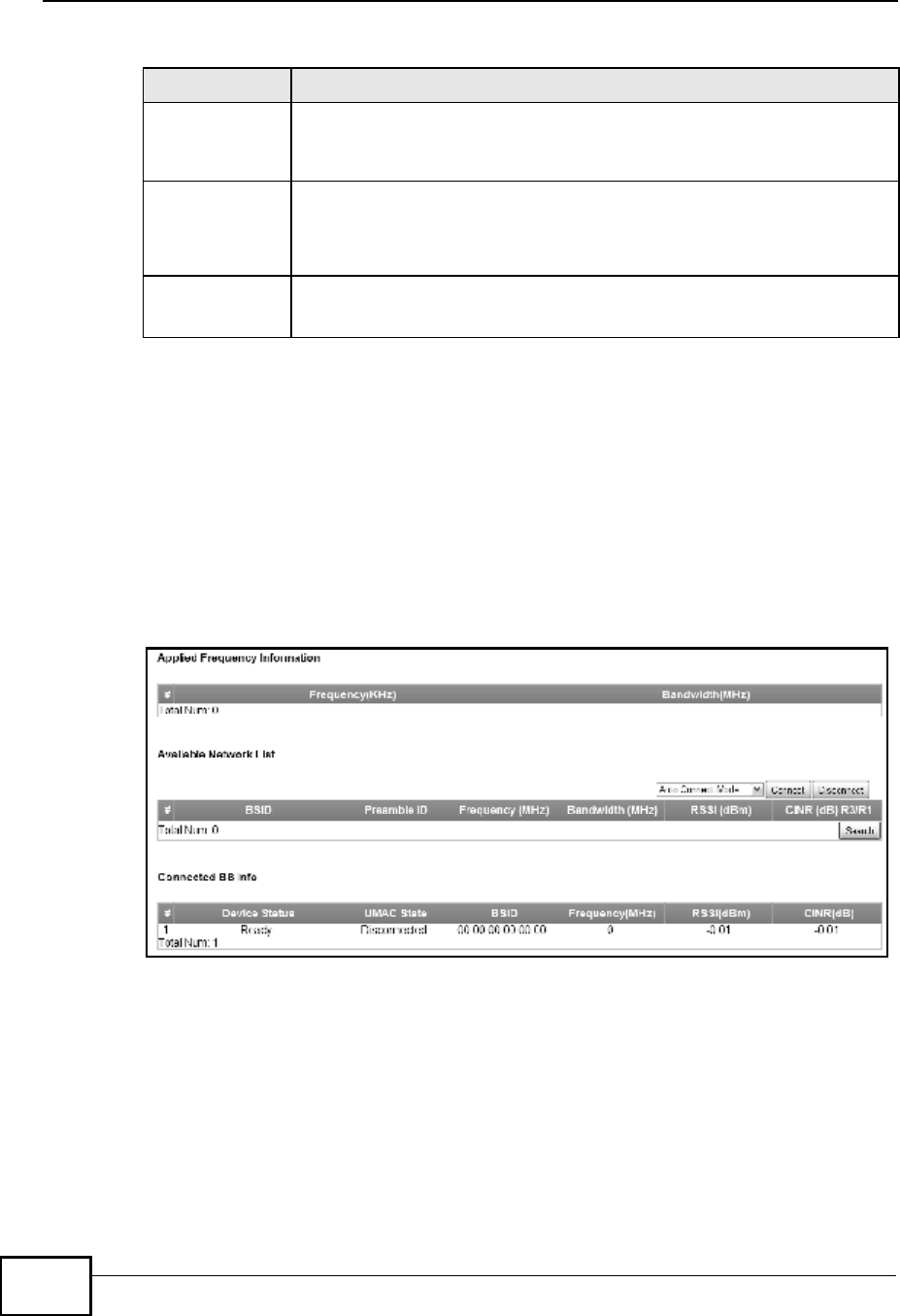
Chapter 6WiMAX
MAX208M User s Guide
68
6.5 Connect
This screen allows you to view the available WiMAX frequency band(s) and base
station(s) the WiMAX Device found through scanning and choose a base station to
which to connect.
Click WiMAX > Connect to open this screen as shown next.
Figure 20 Connect Screen
Delete
existed Root
Certificate
file
Select this to delete an existing root certificate file from the WiMAX
Device.
Delete
existed
Device
Certificate
file
Select this to delete an existing device certificate file from the WiMAX
Device.
Delete
existed
Private Key
Select this to delete an existing private key from the WiMAX Device.
Table 13 Authentication Settings (continued)
LABEL DESCRIPTION

Chapter 6WiMAX
MAX208M User s Guide 69
This screen contains the following fields:
Table 14 Connect
LABEL DESCRIPTION
Applied Frequency Information
This table shows the scanning result you made in the WiMAX > Profile > Frequency
Settings and WiMAX > Wide Scan screens.
Note: You cannot see the wide scanning result that you made in WiMAX > Wide
Scan screen if the Join Wide Scan Result is set to No in the WiMAX >
Profile > Frequency Settings screen.
Frequency
(KHz)
This field displays the available center frequency of a frequency band in
kilohertz (KHz).
Bandwidth
(MHz)
This field displays the bandwidth of the frequency band in megahertz
(MHz).
Available Network List
Connected
Mode
Select a connect mode:
!Auto Connect Mode - This allows the WiMAX Device to connect to
any of the base stations on the list automatically.
!Network Search Mode - This allows the WiMAX Device to connect
to a user-specified base station. Select this option, choose a base
station, click Connect.
ConnectClick this to connect to the selected base station.
DisconnectClick this to disconnect from the selected base station.
BSIDThis field displays the base station MAC address.
Preamble IDThis field displays the preamble ID.
The preamble ID is the index identifier in the header of the base
station s broadcast messages. In the beginning of a mobile stations s
network entry process, it searches for the preamble and uses it to
additional channel information.
The preamble ID is used to synchronize the upstream and downstream
transmission timing with the base station.
Frequency
(MHz)
This field displays the center frequency the base station uses in
kilohertz (KHz).
Bandwidth
(MHz)
This field displays the frequency band bandwidth the base station uses
in megahertz (MHz).
RSSI (dBm)This field displays the Received Signal Strength Indication (RSSI),
which is an overal measurement of radio signal strength. A higher RSSI
level indicates a stronger signal.
CINR (dB)
R3/R1
This field displays the average Carrier to Interference plus Noise Ratio
for the current connection. This value is an indication of overal radio
signal quality, where a higher value means a better quality signal.
SearchClick this to have the WiMAX Device scan for base stations in the
frequency band(s) listed in the Applied Frequency Information
table.
Connected BS Info

Chapter 6WiMAX
MAX208M User s Guide
70
Device
Status
This field displays the WiMAX Device current status for connecting to
the selected base station.
Scanning - The WiMAX Device is scanning for available base stations.
Ready - The WiMAX Device has finished scanning and you can connect
to a base station.
Connecting - The WiMAX Device attempts to connect to the selected
base station.
Connected - The WiMAX Device has successfully connected to the
selected base station.
UMAC StateThis field displays the status of the WiMAXconnection between the
WiMAX Device and the base station.
Network Search - The WiMAX Device is scanning for any available
WiMAX connections.
Disconnected - No WiMAX connection is available.
Network Entry - A WiMAX connection is initializing.
Normal - The WiMAX connection has been successfully established.
BSIDThis field displays the MAC address of the base station to which the
WiMAX Device is connected.
Frequency
(MHz)
This field displays the frequency the base station uses in megahertz
(MHz).
RSSI (dBm)This field displays the Received Signal Strength Indication (RSSI),
which is an overal measurement of radio signal strength. A higher RSSI
level indicates a stronger signal.
CINR (dB)This field displays the average Carrier to Interference plus Noise Ratio
for the current connection. This value is an indication of overal radio
signal quality, where a higher value means a better quality signal.
Table 14 Connect (continued)
LABEL DESCRIPTION
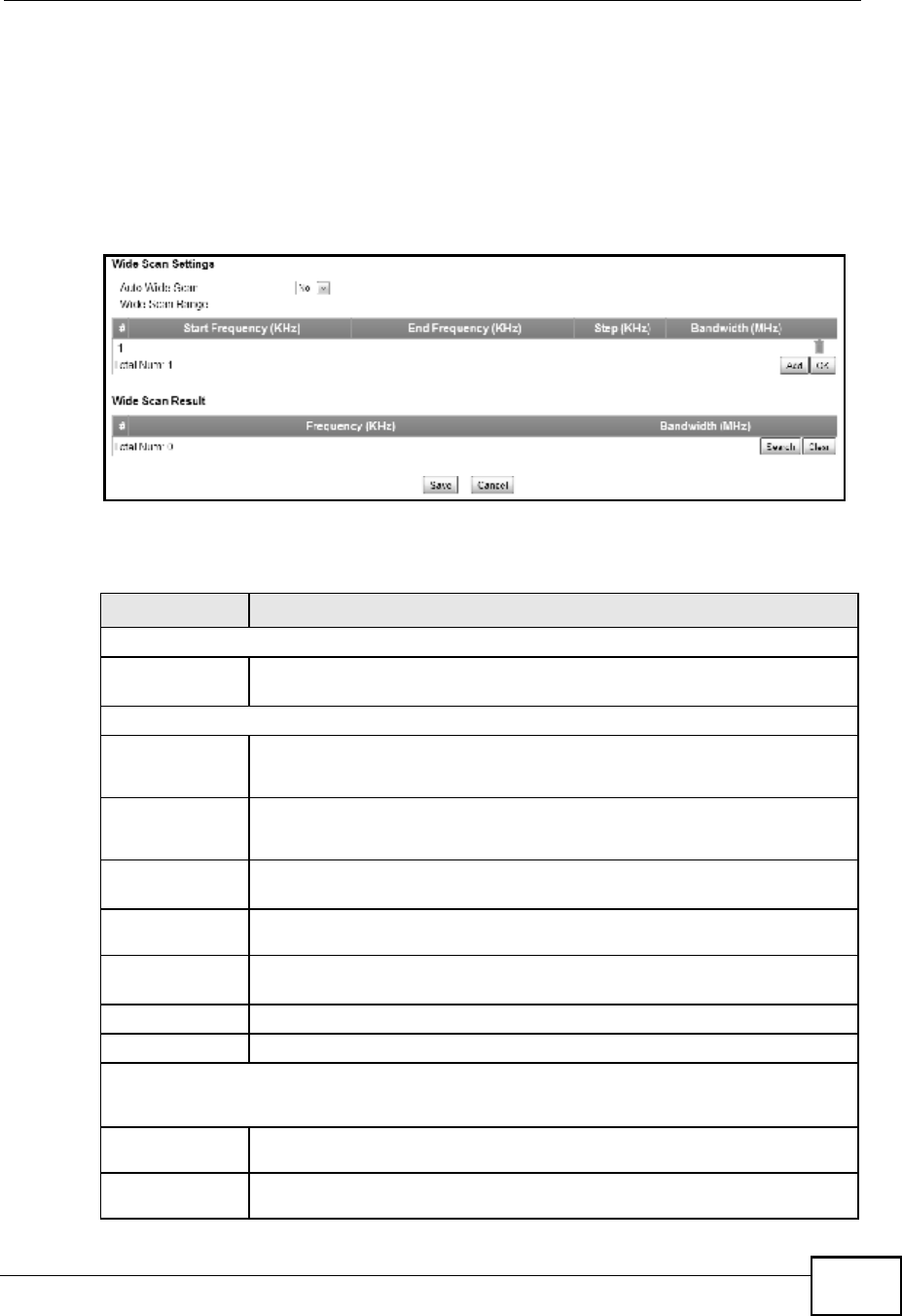
Chapter 6WiMAX
MAX208M User s Guide 71
6.6 Wide Scan
This screen allows you to discover base stations by entering one or more
frequency ranges and bandwidth on which to scan.
Click WiMAX > Wide Scan to open this screen as shown next.
Figure 21 Wide Scan Screen
This screen contains the following fields:
Table 15 Wide Scan
LABEL DESCRIPTION
Wide Scan Settings
Auto Wide
Scan
Use this to enable (Yes) or disable (No) automatically scanning for
base stations.
Wide Scan Range
Start
Frequency
(KHz)
Enter the start frequency in kilohertz (KHz) for a wide scan range.
End
Frequency
(KHz)
Enter the end frequency in kilohertz (KHz) for a wide scan range.
Step (KHz)Enter the step increment in kilohertz (KHz) that the wide scan jumps
each time it scans between the start and end frequencies.
Bandwidth
(MHz)
Enter the frequency bandwidth to be scanned.
DeleteClick this to remove a range of frequencies from the wide scan range
list.
AddClick this to add a range of frequencies to the wide scan range list.
OKClick this so save any changes to the wide scan range list.
Wide Scan Result
This table displays the available frequency band(s) found through the wide scan.
Frequency
(KHz)
This field displays the frequency in kilohertz (KHz).
Bandwidth
(MHz)
This field displays the bandwidth in megahertz (MHz).

Chapter 6WiMAX
MAX208M User s Guide
72
6.7 Link Status
This screen provides a general overview of the current WiMAX connection with the
service provider.
Click WiMAX > Link Status to open this screen as shown next.
Figure 22 Link Status Screen
This screen contains the following fields:
SearchClick this to initiate a wide scan.
ClearClick this to clear the wide scan results.
Table 15 Wide Scan (continued)
LABEL DESCRIPTION
Table 16 Link Status
LABEL DESCRIPTION
ProfileThis field displays the profile name.
BSIDThis field displays the MAC address of the base station to which the
WiMAX Device is currently connected.
RSSIThis field displays the Received Signal Strength Indication (RSSI),
which is an overal measurement of radio signal strength. A higher RSSI
level indicates a stronger signal.
CINR R3This field displays the average Carrier to Interference plus Noise Ratio
(R3) for the current connection. This value is an indication of overal
radio signal quality, where a higher value means a better quality signal.
CINR R1This field displays the average Carrier to Interference plus Noise Ratio
(R1) for the current connection. This value is an indication of overal
radio signal quality, where a higher value means a better quality signal.
CINR Std DevThis field displays the average Carrier to Interference plus Noise Ratio
(Std Dev) for the current connection. This value is an indication of
overal radio signal quality, where a higher value means a better quality
signal.

Chapter 6WiMAX
MAX208M User s Guide 73
FrequencyThis field displays the frequency in kilohertz (KHz).
TX PowerThis field displays the transmission power of the WiMAX Device in dBm.
UL MCSThis field displays the Uplink Modulation and Coding Sequence (UL
MCS).
DL MCSThis field displays the Downlink Modulation and Coding Sequence (DL
MCS).
RF TemperatureThis field displays the temperature of the WiMAX Device s RF circuit.
Handover
Success
This field displays how many times the WiMAX Device had ever
successfully switched its connection from one base station to another
base station, since the WiMAX Device last restarted.
Handover FailThis field displays how many times the WiMAX Device had been failed to
switch its connection from one base station to another base station,
since the WiMAX Device last restarted.
Table 16 Link Status (continued)
LABEL DESCRIPTION
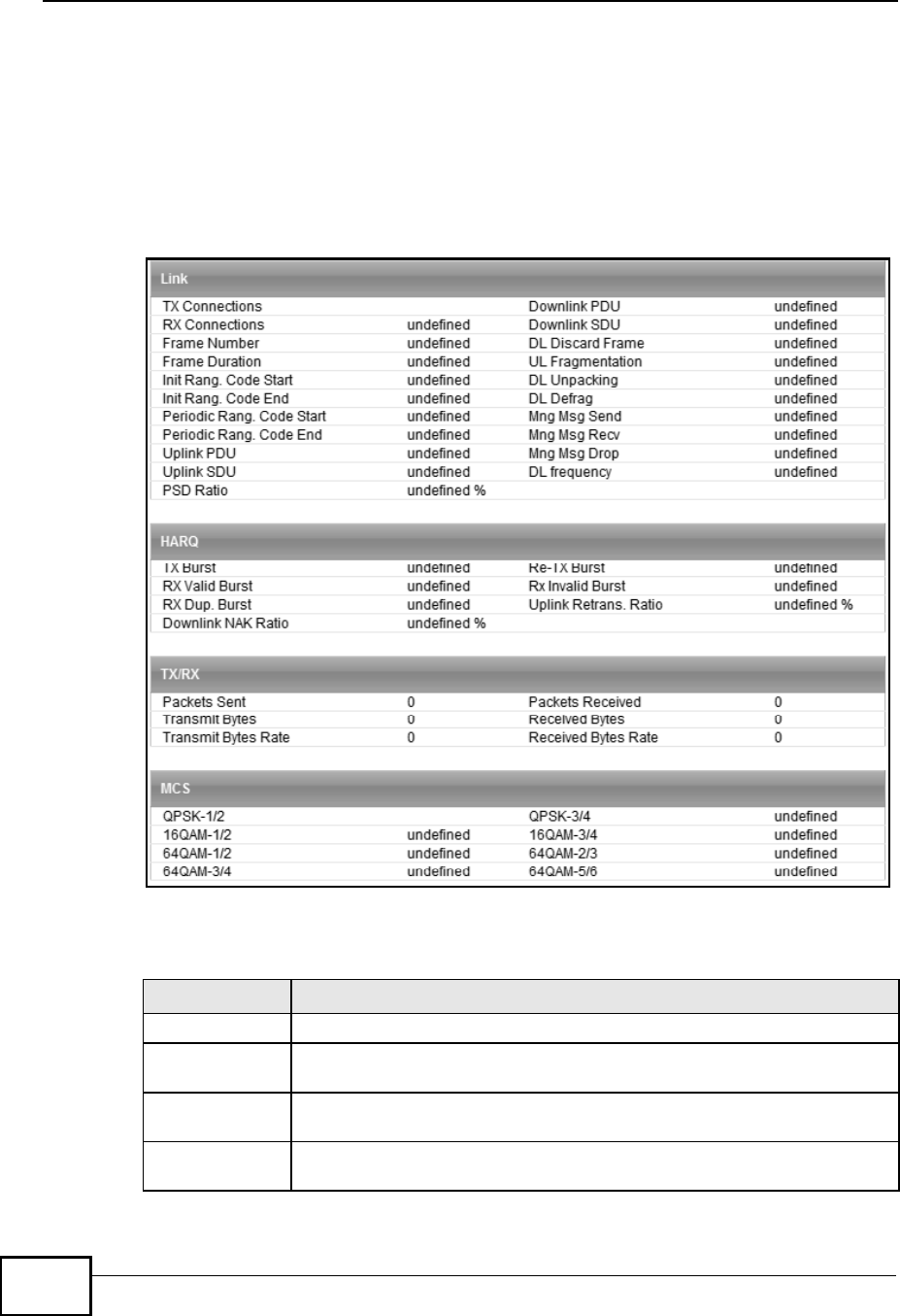
Chapter 6WiMAX
MAX208M User s Guide
74
6.8 Link Statistics
This screen provides a detailed overview of the current WiMAX connection with the
service provider..
Click WiMAX > Link Statistics to open this screen as shown next.
Figure 23 Link Statistics Screen
This screen contains the following sections:
Table 17 Link Statistics
LABEL DESCRIPTION
LinkThis section provides a detailed overview of link statistics.
HARQThis section provides a detailed overview of Hybrid Automatic Repeat
Request link statistics.
TX/RXThis section provides a detailed overview of transmission and receiving
link statistics.
MCSThis section provides a detailed overview of Modulation and Coding
Sequence (MCS) link statistics
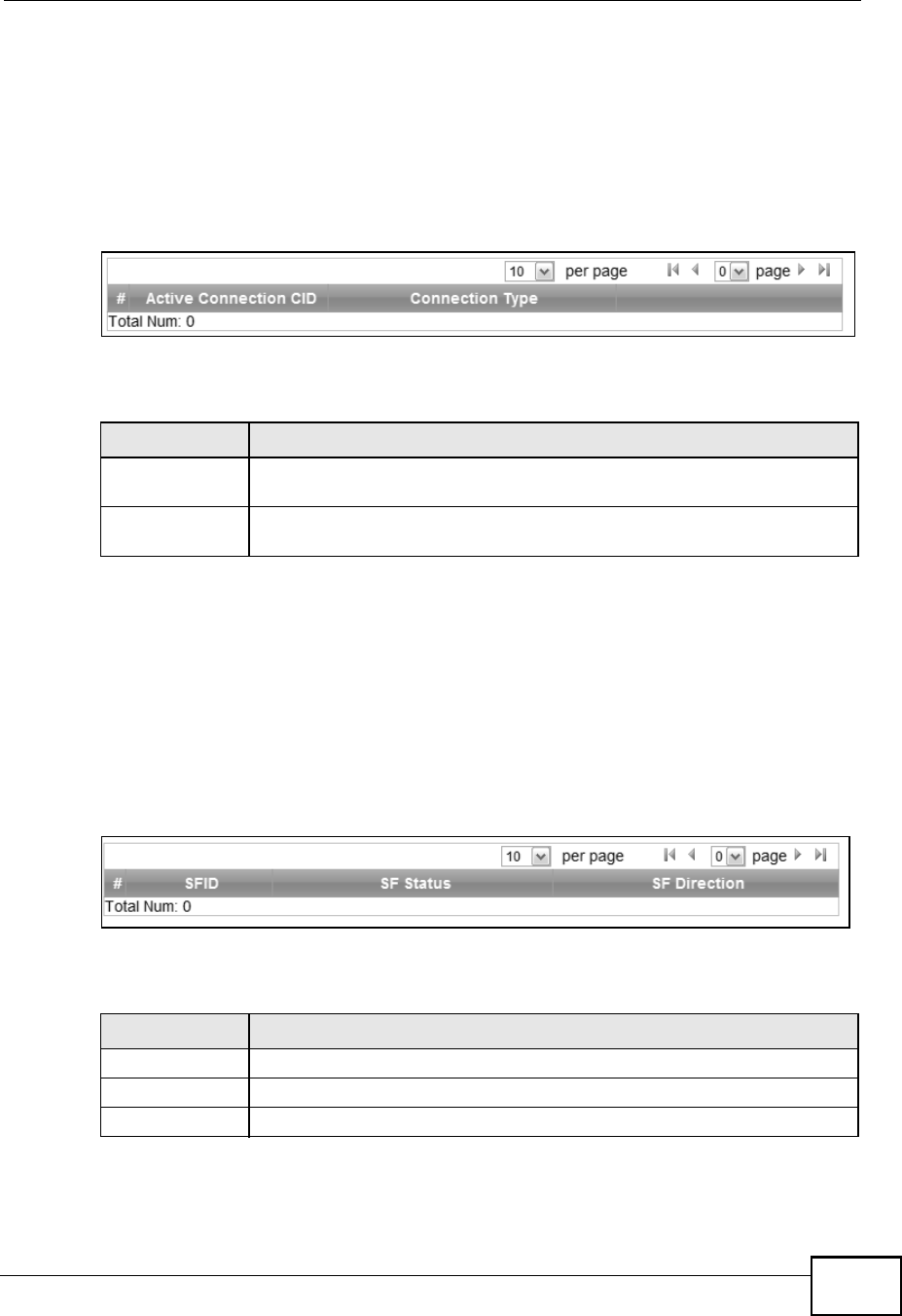
Chapter 6WiMAX
MAX208M User s Guide 75
6.9 Connection Info
This screen displays all of the connections made through the WiMAX device since
its last reboot.
Click WiMAX > Connection Info to open this screen as shown next.
Figure 24 Connection Info Screen
This screen contains the following fields:
6.10 Service Flow
This screen displays data priority information for all of the connections made
through the WiMAX device since its last reboot.
Click WiMAX > Service Flow to open this screen as shown next.
Figure 25 Service Flow Screen
This screen contains the following fields:
Table 18 Connection Info
LABEL DESCRIPTION
Active
Connection CID
This displays the unique, unidirectional 16-bit Connection Identifier
(CID) for an active connection.
Connection
Type
This displays the type of connection.
Table 19 Service Flow
LABEL DESCRIPTION
SFIDThis displays a 32-bit service flow identifier.
SF StatusThis display the service flow status.
SF DirectionThis displays the service flow direction.

Chapter 6WiMAX
MAX208M User s Guide
76

MAX208M User s Guide 77
CHAPTER 7
Network Settings
7.1 Overview
This chapter shows you how to configure the WiMAX Device s network settings.
7.1.1 What You Need to Know
The following terms and concepts may help as you read through this chapter.
IP Address
IP addresses identify individual devices on a network. Every networking device
(including computers, servers, routers, printers, etc.) needs an IP address to
communicate across the network. These networking devices are also known as
hosts.
Subnet Masks
Subnet masks determine the maximum number of possible hosts on a network.
You can also use subnet masks to divide one network into multiple sub-networks.
DHCP
A DHCP (Dynamic Host Configuration Protocol) server can assign your WiMAX
Device an IP address, subnet mask, DNS and other routing information when it s
turned on.

Chapter 7Network Settings
MAX208M User s Guide
78
DNS Server Address
DNS (Domain Name System) is for mapping a domain name to its corresponding
IP address and vice versa. The DNS server is extremely important because
without it, you must know the IP address of a machine before you can access it.
The DNS server addresses that you enter in the DHCP setup are passed to the
client machines along with the assigned IP address and subnet mask.
There are two ways that an ISP disseminates the DNS server addresses. The first
is for an ISP to tell a customer the DNS server addresses, usually in the form of an
information sheet, when s/he signs up. If your ISP gives you the DNS server
addresses, enter them in the DNS Server fields; otherwise, leave them blank.
Some ISPs choose to pass the DNS servers using the DNS server extensions of
PPP IPCP (IP Control Protocol) after the connection is up. If your ISP did not give
you explicit DNS servers, chances are the DNS servers are conveyed through IPCP
negotiation. The WiMAX Device supports the IPCP DNS server extensions through
the DNS proxy feature.
If the Primary and Secondary DNS Server fields are not specified, for instance,
left as 0.0.0.0, the WiMAX Device tells the DHCP clients that it itself is the DNS
server. When a computer sends a DNS query to the WiMAX Device, the WiMAX
Device forwards the query to the real DNS server learned through IPCP and relays
the response back to the computer.
Please note that DNS proxy works only when the ISP uses the IPCP DNS server
extensions. It does not mean you can leave the DNS servers out of the DHCP
setup under all circumstances. If your ISP gives you explicit DNS servers, make
sure that you enter their IP addresses. This way, the WiMAX Device can pass the
DNS servers to the computers and the computers can query the DNS server
directly without the WiMAX Device s intervention.
RIP Setup
RIP (Routing Information Protocol) allows a router to exchange routing
information with other routers. The RIP Direction field controls the sending and
receiving of RIP packets. When set to:
!RX/TX - the WiMAX Device will broadcast its routing table periodically and
incorporate the RIP information that it receives.
!RX Only - the WiMAX Device will not send any RIP packets but will accept all
RIP packets received.
!TX Only - the WiMAX Device will send out RIP packets but will not accept any
RIP packets received.
!None - the WiMAX Device will not send any RIP packets and will ignore any RIP
packets received.
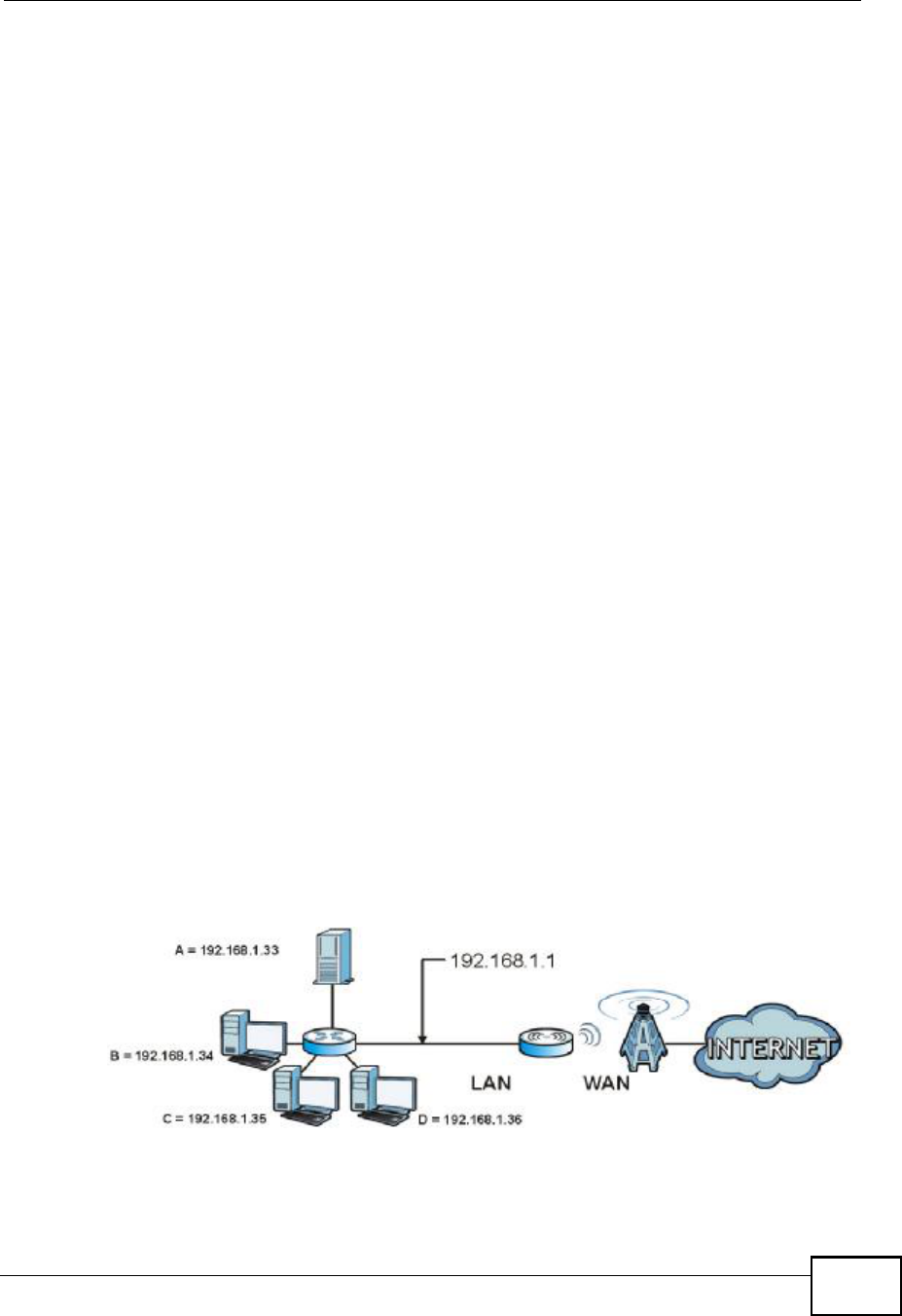
Chapter 7Network Settings
MAX208M User s Guide 79
The Version field controls the format and the broadcasting method of the RIP
packets that the WiMAX Device sends (it recognizes both formats when receiving).
RIP-1 is universally supported; but RIP-2 carries more information. RIP-1 is
probably adequate for most networks, unless you have an unusual network
topology.
Both RIP-2B and RIP-2M sends the routing data in RIP-2 format; the difference
being that RIP-2B uses subnet broadcasting while RIP-2M uses multicasting.
Port Forwarding
A NAT server set is a list of inside (behind NAT on the LAN) servers, for example,
web or FTP, that you can make accessible to the outside world even though NAT
makes your whole inside network appear as a single machine to the outside world.
With port forwarding, you can forward incoming service requests to the server(s)
on your local network. You may enter a single port number or a range of port
numbers to be forwarded, and the local IP address of the desired server. The port
number identifies a service; for example, web service is on port 80 and FTP on
port 21. In some cases, such as for unknown services or where one server can
support more than one service (for example both FTP and web service), it might
be better to specify a range of port numbers.
In addition to the servers for specified services, NAT supports a default server. A
service request that does not have a server explicitly designated for it is forwarded
to the default server. If the default is not defined, the service request is simply
discarded.
For example, let's say you want to assign ports 21-25 to one FTP, Telnet and SMTP
server (A in the example), port 80 to another (B in the example) and assign a
default server IP address of 192.168.1.35 to a third (C in the example). You
assign the LAN IP addresses and the ISP assigns the WAN IP address. The NAT
network appears as a single host on the Internet.
Figure 26 Multiple Servers Behind NAT Example

Chapter 7Network Settings
MAX208M User s Guide
80
Trigger Ports
Some services use a dedicated range of ports on the client side and a dedicated
range of ports on the server side. With regular port forwarding you set a
forwarding port in NAT to forward a service (coming in from the server on the
WAN) to the IP address of a computer on the client side (LAN). The problem is
that port forwarding only forwards a service to a single LAN IP address. In order to
use the same service on a different LAN computer, you have to manually replace
the LAN computer's IP address in the forwarding port with another LAN
computer's IP address,
Trigger port forwarding solves this problem by allowing computers on the LAN to
dynamically take turns using the service. The WiMAX Device records the IP
address of a LAN computer that sends traffic to the WAN to request a service with
a specific port number and protocol (a "trigger" port). When the WiMAX Device's
WAN port receives a response with a specific port number and protocol
("incoming" port), the WiMAX Device forwards the traffic to the LAN IP address of
the computer that sent the request. After that computer s connection for that
service closes, another computer on the LAN can use the service in the same
manner. This way you do not need to configure a new IP address each time you
want a different LAN computer to use the application.
ALG
Some applications, such as SIP, cannot operate through NAT (are NAT un-friendly)
because they embed IP addresses and port numbers in their packets data
payload. Some NAT routers may include a SIP Application Layer Gateway (ALG).
An Application Layer Gateway (ALG) manages a specific protocol (such as SIP,
H.323 or FTP) at the application layer.
A SIP ALG allows SIP calls to pass through NAT by examining and translating IP
addresses embedded in the data stream.
UPnP
Universal Plug and Play (UPnP) is a distributed, open networking standard that
uses TCP/IP for simple peer-to-peer network connectivity between devices. A
UPnP device can dynamically join a network, obtain an IP address, convey its
capabilities and learn about other devices on the network. In turn, a device can
leave a network smoothly and automatically when it is no longer in use.
How do I know if I'm using UPnP?
UPnP hardware is identified as an icon in the Network Connections folder
(Windows XP). Each UPnP compatible device installed on your network will appear
as a separate icon. Selecting the icon of a UPnP device will allow you to access the
information and properties of that device.

Chapter 7Network Settings
MAX208M User s Guide 81
NAT Traversal
UPnP NAT traversal automates the process of allowing an application to operate
through NAT. UPnP network devices can automatically configure network
addressing, announce their presence in the network to other UPnP devices and
enable exchange of simple product and service descriptions. NAT traversal allows
the following:
!Dynamic port mapping
!Learning public IP addresses
!Assigning lease times to mappings
Windows Messenger is an example of an application that supports NAT traversal
and UPnP.
Cautions with UPnP
The automated nature of NAT traversal applications in establishing their own
services and opening firewall ports may present network security issues. Network
information and configuration may also be obtained and modified by users in some
network environments.
All UPnP-enabled devices may communicate freely with each other without
additional configuration. Disable UPnP if this is not your intention.
UPnP and ZyXEL
ZyXEL has received UPnP certification from the official UPnP Forum (http://
www.upnp.org). ZyXEL's UPnP implementation supports IGD 1.0 (Internet
Gateway Device).
The WiMAX Device only sends UPnP multicasts to the LAN.
Content Filter
Internet content filtering allows you to create and enforce Internet access policies
tailored to their needs. Content filtering is the ability to block certain specific URL
keywords.
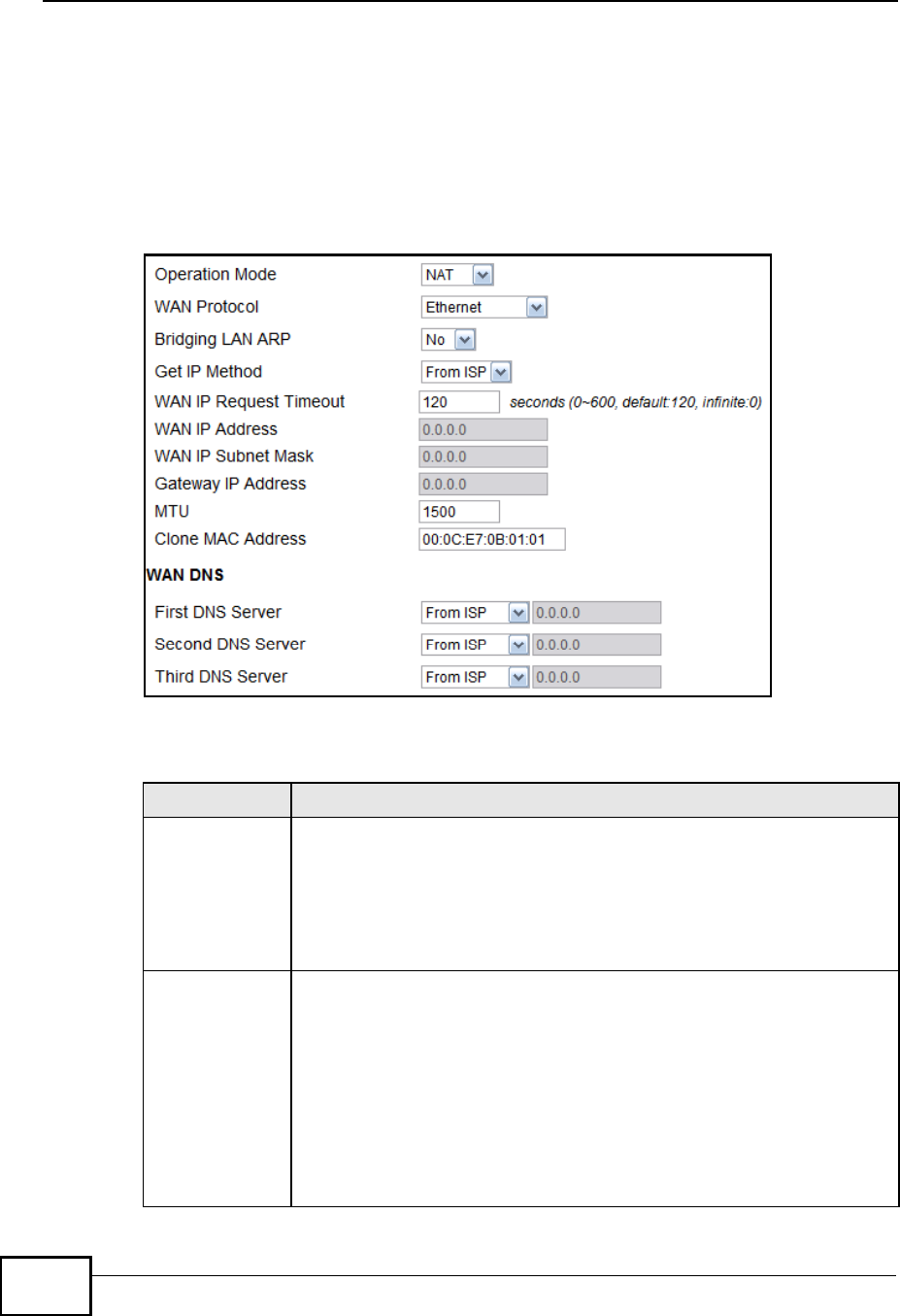
Chapter 7Network Settings
MAX208M User s Guide
82
7.2 WAN
Use these settings to configure the WAN connection between the WiMAX Device
and the service provider.
Click Network Setting > WAN to open this screen as shown next.
Figure 27 WAN Screen
This screen contains the following fields:
Table 20 WAN
LABEL DESCRIPTION
Operation ModeSelect the WiMAX Device s operational mode.
!Bridge - This puts the WiMAX Device in bridge mode, acting as a
transparent middle man between devices on the LAN and the
devices on the WAN.
!NAT - This allows the WiMAX Device to tag frames for NAT, allowing
devices on the LAN to use their own internal IP addresses while
communicating with devices on the WAN.
WAN ProtocolSelect the protocol the WiMAX Device uses to connect to the WAN.
The options are:
!Ethernet - Select this if you have a persistent connection to the
network.
!PPPoE - Select this if must log into the network before initiating a
persistent connection.
!GRE Tunnel - Select this if you connect to the network using Point-
to-Point Protocol to create VPNs.
!EtherIP - Select this if you need to tunnel Ethernet and IEEE 802.3
MAC frames across an IP Internet.

Chapter 7Network Settings
MAX208M User s Guide 83
Bridging LAN
ARP
This option enables or disables allow ARP requests to cross the WiMAX
Device.
Get IP MethodSelect how the WiMAX Device receives its IP address.
!User - Select this to manually enter the IP address the WiMAX
Device uses.
!From ISP - Select to automatically get the IP address the WiMAX
Device uses from the ISP.
WAN IP Request
Timeout
Enter the number of seconds the WiMAX Device waits for an IP from the
ISP before it times out.
WAN IP AddressIf the WiMAX Device gets its IP from the user, enter the IP address it is
to use.
WAN IP Subnet
Mask
If the WiMAX Device gets its IP from the ISP, enter the IP address it is
to use.
Gateway IP
Address
If the WiMAX Device gets its gateway IP address from the user, enter
the IP address it is to use.
MTUEnter the Maximum Transmission Unit (MTU) for the WiMAX Device.
This is the largest protocol unit that the WiMAX Device allows to pass
through it.
Clone MAC
Address
Enter a MAC address here for registering bridged devices on the
network if their current MAC addresses are causing problems. For
example, this can happen when a desktop computer swaps network
interface cards; the original NIC may have used its MAC address to
register itself on the network and now the new NIC is unrecognized.
Using a MAC address that you know is valid, i.e. a "clone#, allows that
device to stay registered.
First~Third DNS
Server
Select how the WiMAX Device acquires its DNS server address.
!From ISP - Select this to have the WiMAX Device acquire its DNS
server address from the ISP.
!User Define - Select this to manually enter the DNS server used by
the WiMAX Device.
Table 20 WAN (continued)
LABEL DESCRIPTION
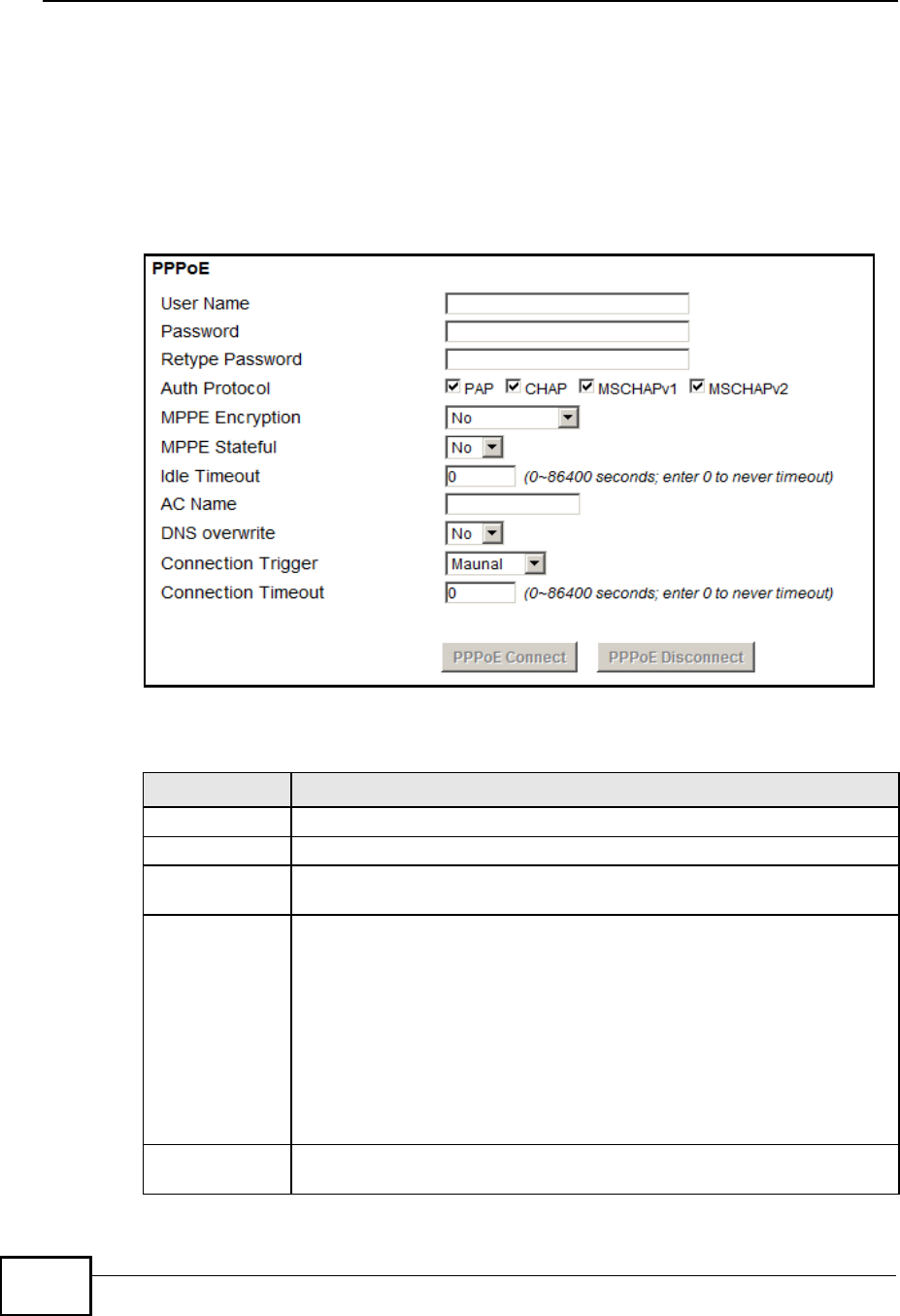
Chapter 7Network Settings
MAX208M User s Guide
84
7.3 PPPoE
Use these settings to configure the PPPoE connection between the WiMAX Device
and the service provider.
Click Network Setting > WAN > PPPoE
Figure 28 PPPoE Screen
This screen contains the following fields:
Table 21 PPPoE
LABEL DESCRIPTION
User NameEnter the username for PPPoE login into the WAN network.
PasswordEnter the password for PPPoE login into the WAN network.
Retype
Password
Retype the password to confirm it.
Auth ProtocolSelect a PPPoE authentication protocol. The WiMAX Device supports the
following:
!CHAP - The Challenge Handshake Authentication Protocol (CHAP)
uses PPP to authenticate remote devices using a three-way
handshake and shared secret verification.
!PAP - Password Authentication Protocol uses unencrypted plaintext
to send a passwords for authentication over the network. It s
probably not a good idea to rely on this for security.
!MS-CHAP v1/2 -This is Microsoft s variant of Challenge Handshake
Authentication Protocol (CHAP). It allows for mutual authentication
between devices.
MPPE
Encryption
Use this option to enable or disable authentication through Microsoft
Point-To-Point Encryption (MPPE) protocol.
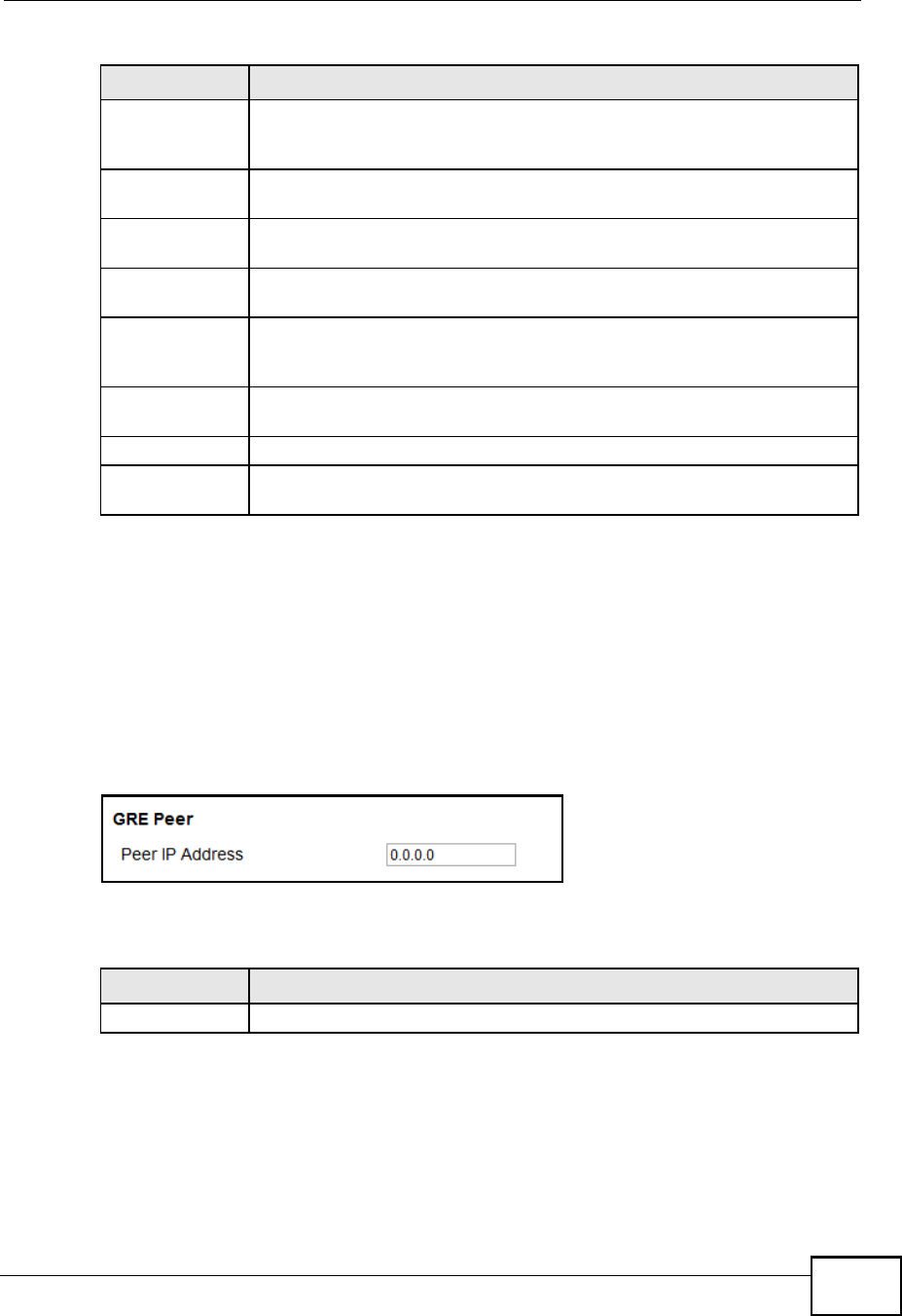
Chapter 7Network Settings
MAX208M User s Guide 85
7.4 GRE
Use these settings to configure the peer setting of the Generic Routing
Encapsulation (GRE) tunnel between the WiMAX Device and another GRE peer.
Click Network Setting > WAN > GRE to open this screen as shown next.
Figure 29 GRE Screen
This screen contains the following fields:
MPPE StatefulUse this option to allow or disallow the WiMAX Device to use the
Microsoft Point-To-Point Encryption (MPPE) protocol for stateful peer
negotiation.
Idle TimeoutEnter the number of second the WiMAX Device waits during
authentication before timing out.
AC NameEnter the access concentrator name for the PPPoE interface if your ISP
uses an AC PPPoE service.
DNS OverwriteUse this option to allow or disallow the WiMAX Device to overwrite DNS
static DNS entries on client devices.
Connection
Trigger
Set whether the WiMAX Device is persistently connected to the WAN
(AlwaysOn) or you must click the PPPoE Connect button each time you
want to get on the WAN (Manual).
Connection
Timeout
Enter in seconds the duration the WiMAX Device waits for idle activity
before disconnecting from the WAN.
PPPoE ConnectClick this to connect to the WAN using PPPoE.
PPPoE
Disconnect
Click this to disconnect from the WAN.
Table 21 PPPoE (continued)
LABEL DESCRIPTION
Table 22 GRE
LABEL DESCRIPTION
Peer IP AddressEnter the IP address of the GRE peer.
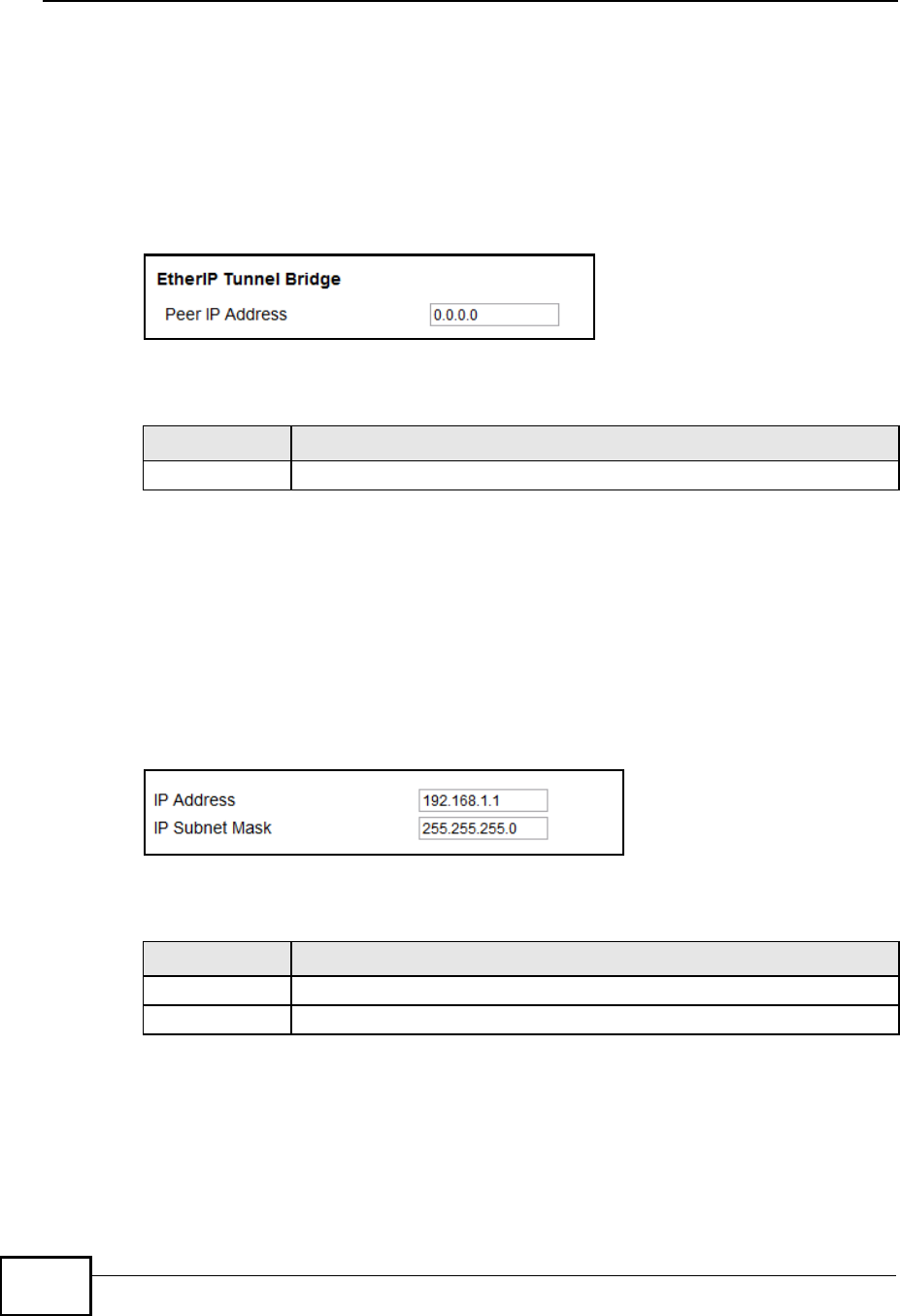
Chapter 7Network Settings
MAX208M User s Guide
86
7.5 EtherIP
Use these settings to configure the peer setting of the EtherIP tunnel between the
WiMAX Device and another EtherIP peer.
Click Network Setting > WAN > EtherIP to open this screen as shown next.
Figure 30 EtherIP Screen
This screen contains the following fields:
7.6 IP
Use these settings to configure the LAN connection between the WiMAX Device
and your local network.
Click Network Setting > LAN > IP to open this screen as shown next.
Figure 31 IP Screen
This screen contains the following fields:
Table 23 EtherIP
LABEL DESCRIPTION
Peer IP AddressEnter the IP address of the EtherIP peer.
Table 24 IP
LABEL DESCRIPTION
IP addressEnter the IP address of the LAN interface for the WiMAX Device.
IP Subnet MaskEnter the IP subnet maks of the LAN interface for the WiMAX Device.
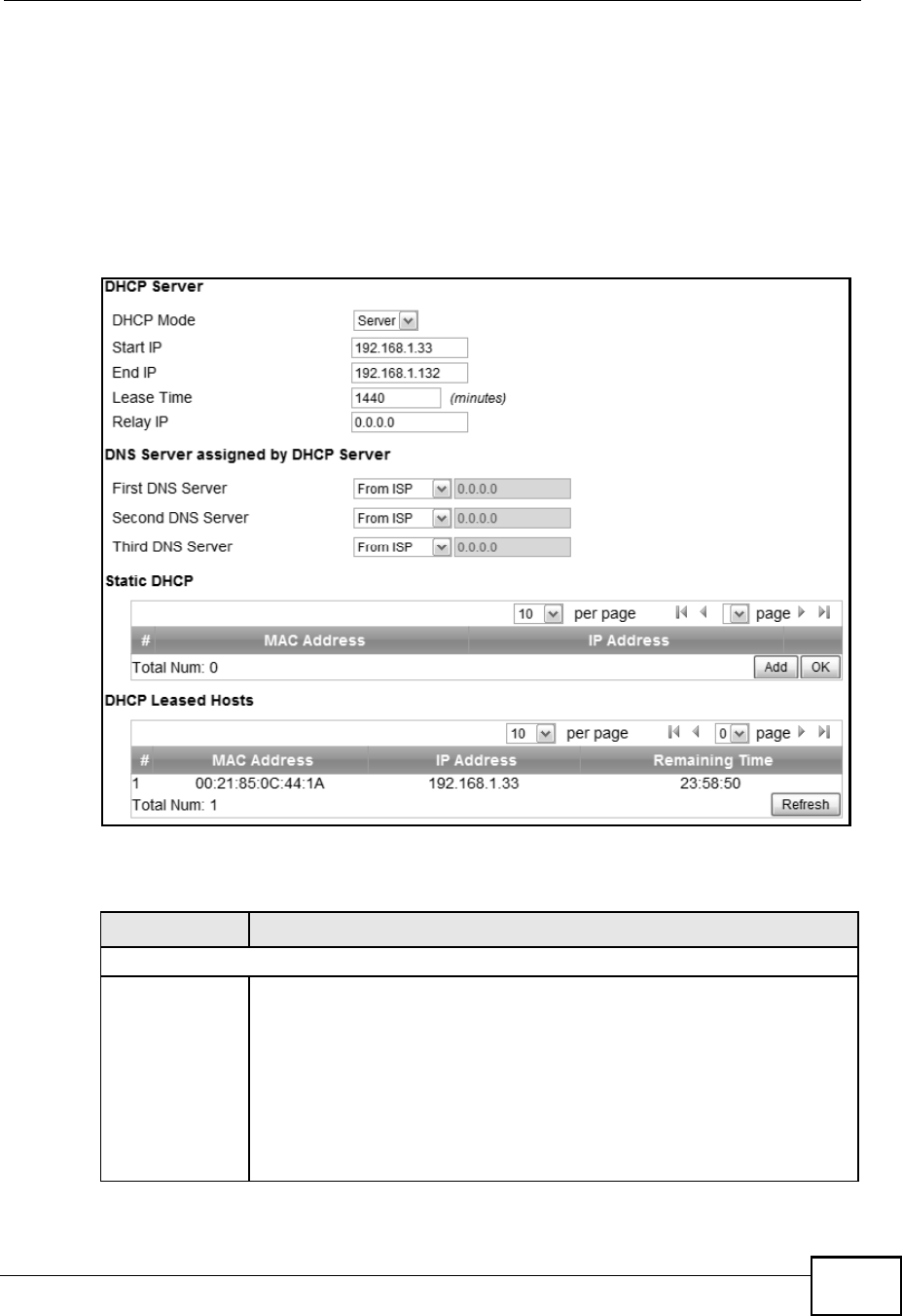
Chapter 7Network Settings
MAX208M User s Guide 87
7.7 DHCP
Use these settings to configure whether the WiMAX Device functions as a DHCP
server for your local network, or a DHCP relay between the local network and the
service provider. You can also disable the DHCP functions.
Click Network Setting > LAN > DHCP to open this screen as shown next.
Figure 32 DHCP Screen
This screen contains the following fields:
Table 25 DHCP
LABEL DESCRIPTION
DHCP Server
DHCP ModeSelect this if you want the WiMAX Device to be the DHCP server on the
LAN. As a DHCP server, the WiMAX Device assigns IP addresses to
DHCP clients on the LAN and provides the subnet mask and DNS server
information.
!None - This disables DHCP mode for the WiMAX Device.
!Server - This sets the WiMAX Device as a DHCP server for the LAN.
!Relay - This sets the WiMAX Device as a DHCP relay for the LAN,
allowing it to pass-through IP addresses assigned to LAN devices
from the ISP servers.

Chapter 7Network Settings
MAX208M User s Guide
88
7.8 Static Route
Use these settings to create fixed paths through the network.
Click Network Setting > Route > Static Route to open this screen as shown
next.
Figure 33 Static Route Screen
Start IPEnter the start IP address from which the WiMAX Device begins
allocating IP addresses.
End IPEnter the end IP address at which the WiMAX Device ceases allocating
IP addresses.
Lease TimeEnter the duration in minutes that devices on the LAN retain their
DHCP-issued IP addresses. At the end of the lease time, they poll the
WiMAX Device for a renewed or replacement IP.
Relay IPEnter the name of the IP address to be used.
DNS Server Assigned by the DHCP Server
First~Third
DNS Server
Select how the WiMAX Device acquires its DNS server address.
!None - Select this to not use a DNS server.
!From ISP - Select this to have the WiMAX Device acquire its DNS
server address from the ISP.
!User Define - Select this to manually enter the DNS server used by
the WiMAX Device.
Static DHCP
MAC
Address
This field displays the MAC address of the static DHCP client connected
to the WiMAX Device.
IP AddressThis field displays the IP address of the static DHCP client connected to
the WiMAX Device.
AddClick this to add a new static DHCP entry.
OKClick this to save any changes made to this list.
DHCP Leased Hosts
MAC
Address
This displays the MAC address of the DHCP leased host.
IP AddressThis displays the IP address of the DHCP leased host.
Remaining
Time
This displays the how much time is left on the host s lease.
RefreshClick this to refresh the list.
Table 25 DHCP (continued)
LABEL DESCRIPTION
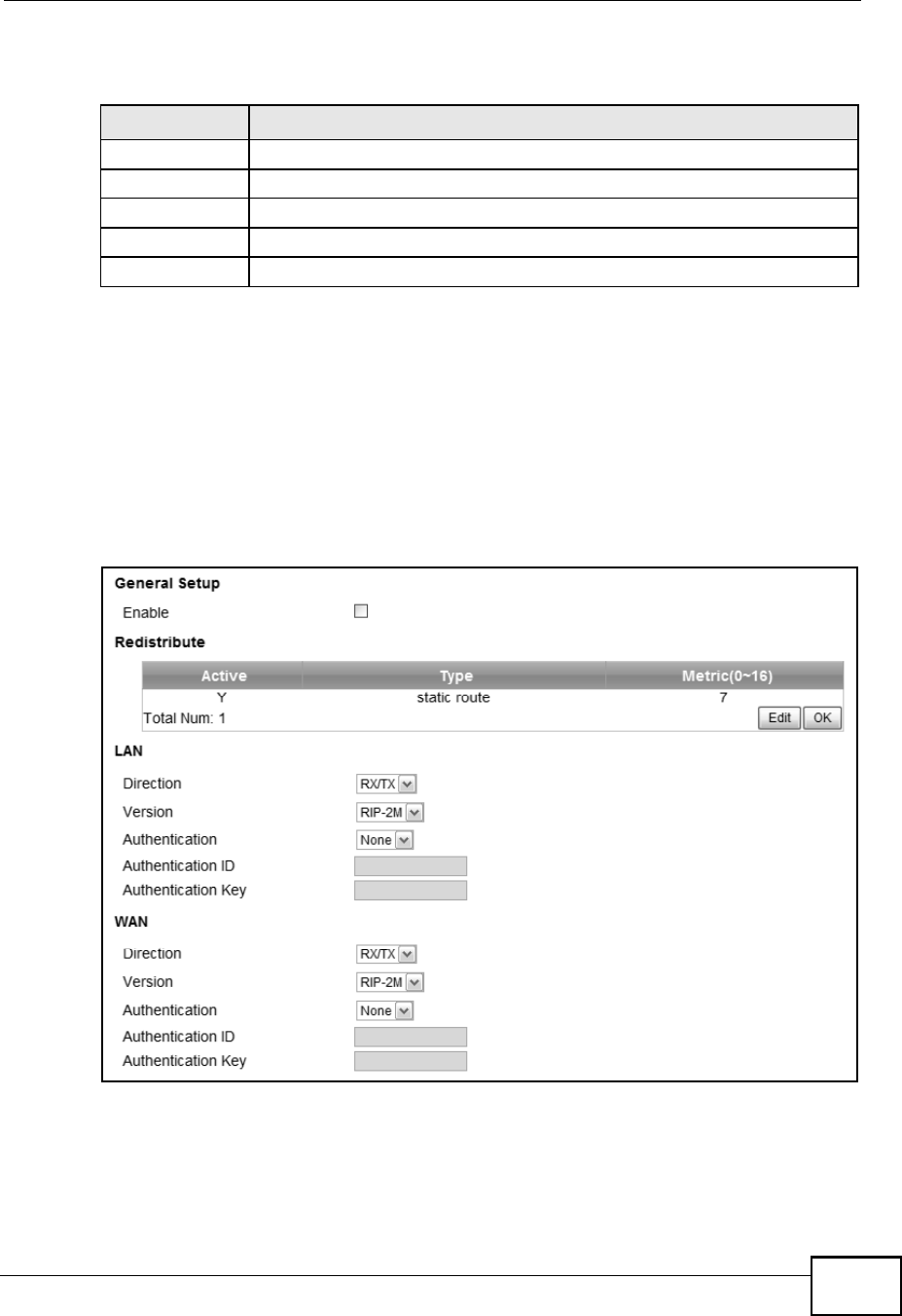
Chapter 7Network Settings
MAX208M User s Guide 89
This screen contains the following fields:
7.9 RIP
Use these settings to configure how the WiMAX Device exchanges information with
other routers.
Click Network Setting > Route > RIP to open this screen as shown next.
Figure 34 RIP Screen
Table 26 Static Route
LABEL DESCRIPTION
DestinationThis field displays the destination IP address of the static route.
Subnet MaskThis field displays the subnet mask of the static route.
Next HopThis field displays next hop information of the static route.
MetricThis field displays the static route metric.
AddClick this to add a new static route to the list.

Chapter 7Network Settings
MAX208M User s Guide
90
This screen contains the following fields:
7.10 Port Forwarding
Use these settings to forward incoming service requests to the ports on your local
network.
Note: Make sure you did not configure a DMZ host in the Network Setting > NAT >
DMZ screen if you want to make the settings of this screen work.
Table 27 RIP
LABEL DESCRIPTION
General Setup
EnableSelect this to enable RIP on the WiMAX Device.
Redistribute
ActiveThis indicates whether a route is being redistributed.
TypeThis indicates what type of route is being redistributed.
MetricThis indicates the metric that is being used for redistribution.
EditClick this to edit a selected route.
OKClick this to save any changes to the redistribution table.
LAN
DirectionSet the LAN network direction to use with RIP.
VersionSet the RIP version to use.
AuthenticationUse this option to enable or disable RIP authentication.
Authentication
ID
Enter the authentication ID to use for RIP authentication.
Authentication
Key
Enter the authentication key to use for RIP authentication.
WAN
DirectionSet the WAN network direction to use with RIP.
VersionSet the RIP version to use.
AuthenticationUse this option to enable or disable RIP authentication.
Authentication
ID
Enter the authentication ID to use for RIP authentication.
Authentication
Key
Enter the authentication key to use for RIP authentication.
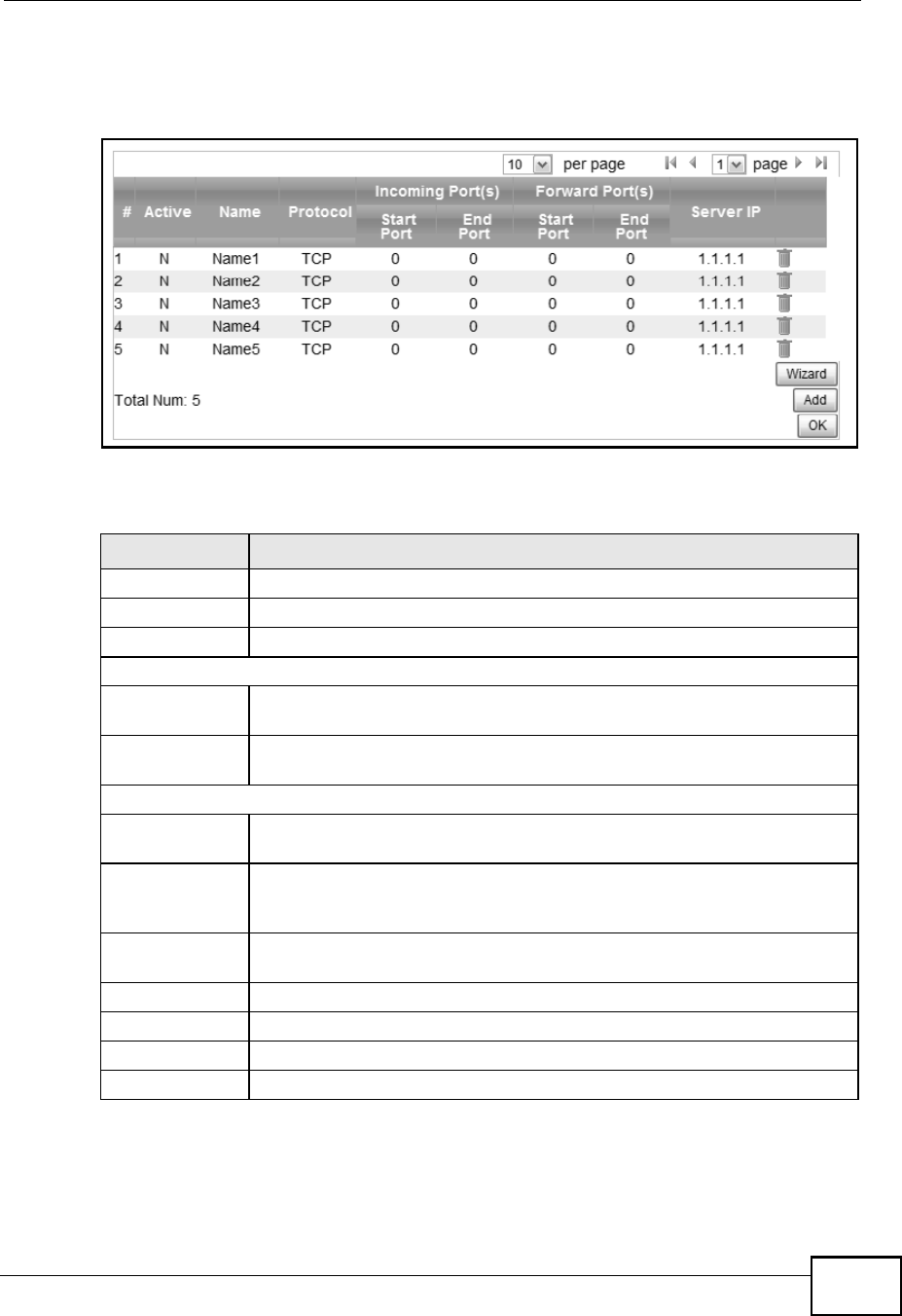
Chapter 7Network Settings
MAX208M User s Guide 91
Click Network Setting > NAT > Port Forwarding to open this screen as shown
next.
Figure 35 Port Forwarding Screen
This screen contains the following fields:
Table 28 Port Forwarding
LABEL DESCRIPTION
ActiveThis indicates whether the port forwarding rule is active or not.
NameThe displays the name of the port forwarding rule.
ProtocolThis displays the protocol to which the port forwarding rule applies.
Incoming Port(s)
Start PortThis displays the starting port number for incoming traffic for the port
forwarding rule.
End PortThis displays the ending port number for incoming traffic for the port
forwarding rule.
Forward Port(s)
Start Port This field displays the beginning of the range of port numbers forwarded
by this rule.
End Port This field displays the end of the range of port numbers forwarded by
this rule. If it is the same as the Start Port, only one port number is
forwarded.
Server IPThis displays the IP address of the server to which packet for the
selected port(s) are forwarded.
DeleteClick this to delete a specified rule.
WizardClick this to open the port forwarding "wizard#.
AddClick this to add a new port forwarding rule.
OKClick this to save any changes made to the port forwarding list.
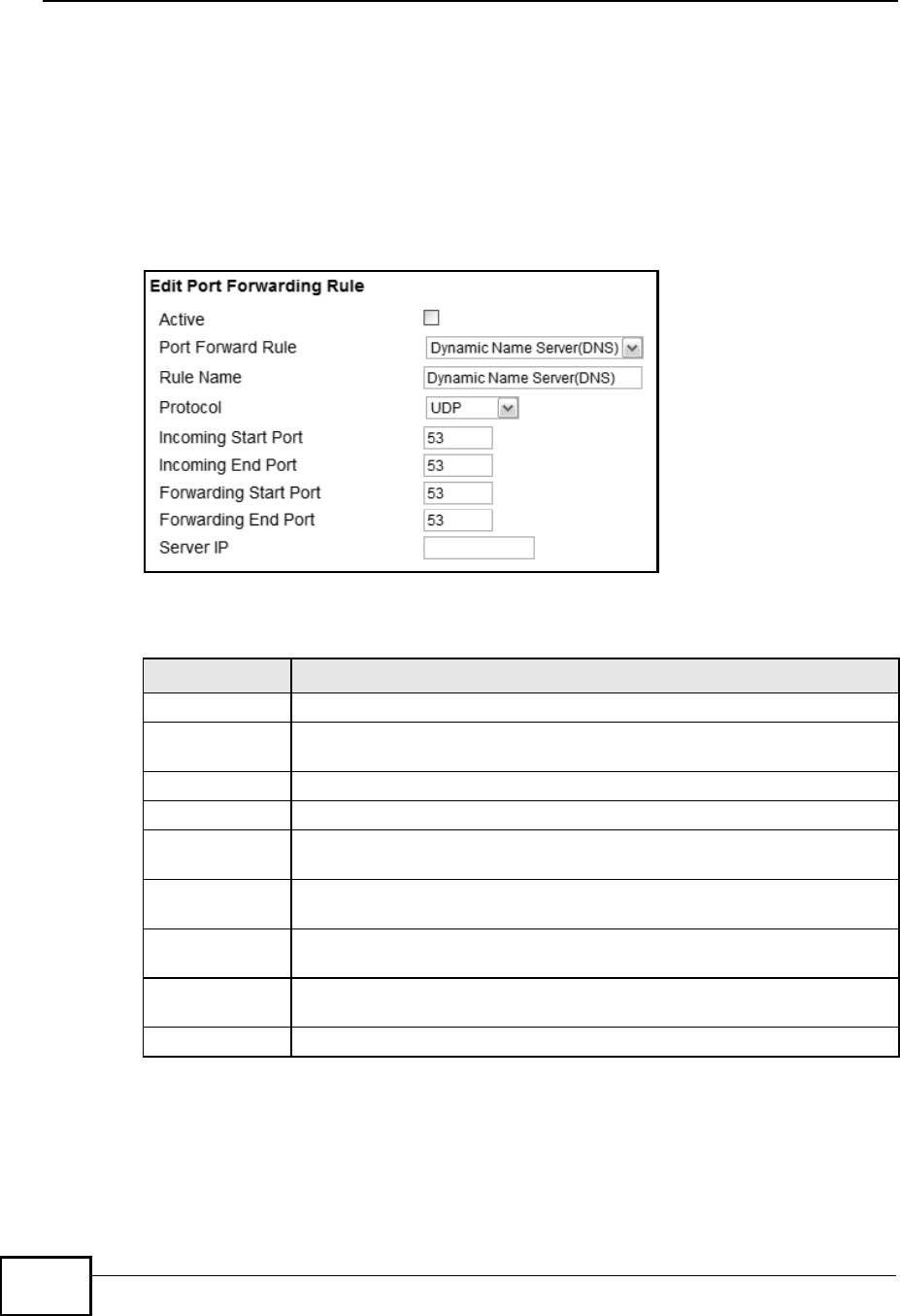
Chapter 7Network Settings
MAX208M User s Guide
92
7.10.1 Port Forwarding Wizard
Use this wizard to set up a port forwarding rule for incoming service requests to
the ports on your local network.
Click Network Setting > NAT > Port Forwarding > Wizard to open this
screen as shown next.
Figure 36 Port Forwarding Wizard Screen
This screen contains the following fields:
Table 29 Port Forwarding Wizard
LABEL DESCRIPTION
ActiveSelect this to make this port forwarding rule active.
Port Forward
Rule
Select the type of port forwarding rule.
Rule NameEnter a name for the port forwarding rule.
ProtocolSelect the port forwarding protocol.
Incoming Start
Port
Enter the starting port number for incoming traffic for the port
forwarding rule.
Incoming End
Port
Enter the ending port number for incoming traffic for the port
forwarding rule.
Forwarding
Start Port
Enter the starting port number for forwarded traffic for the port
forwarding rule.
Forwarding End
Port
Enter the ending port number for forwarded traffic for the port
forwarding rule.
Server IPEnter the port forwarding server IP address.
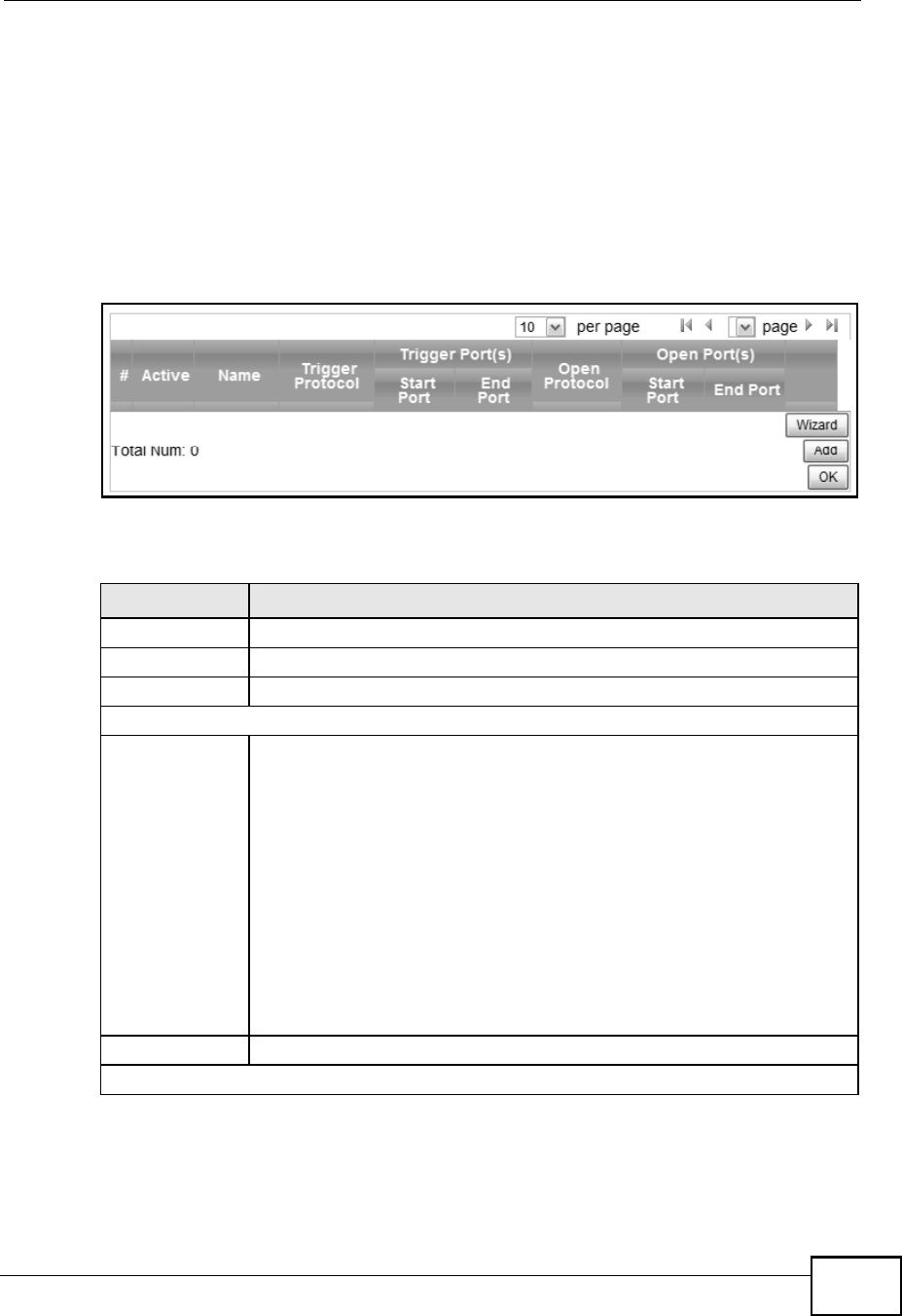
Chapter 7Network Settings
MAX208M User s Guide 93
7.11 Port Trigger
Use these settings to automate port forwarding and allow computers on local
network to provide services that would normally require a fixed address on the
local network.
Click Network Setting > NAT > Port Trigger to open this screen as shown
next.
Figure 37 Port Trigger Screen
This screen contains the following fields:
Table 30 Port Trigger
LABEL DESCRIPTION
ActiveThis indicates whether the port trigger rule is active or not.
NameThe displays the name of the port trigger rule.
Trigger ProtocolThis displays the protocol to which the port trigger rule applies.
Trigger Port(s)
Start / End
Port
This displays the start / end trigger port for the port trigger rule.
Click Add to create a new, empty rule, then enter the incoming port
number or range of port numbers you want to forward to the IP address
the WiMAX Device records.
To forward one port number, enter the port number in the Start Port
and End Port fields.
To forward a range of ports,
!enter the port number at the beginning of the range in the Start
Port field
!enter the port number at the end of the range in the End Port field.
If you want to delete this rule, click the Delete icon.
Open ProtocolThis indicates which protocol is used to open the port trigger ports.
Open Port(s)
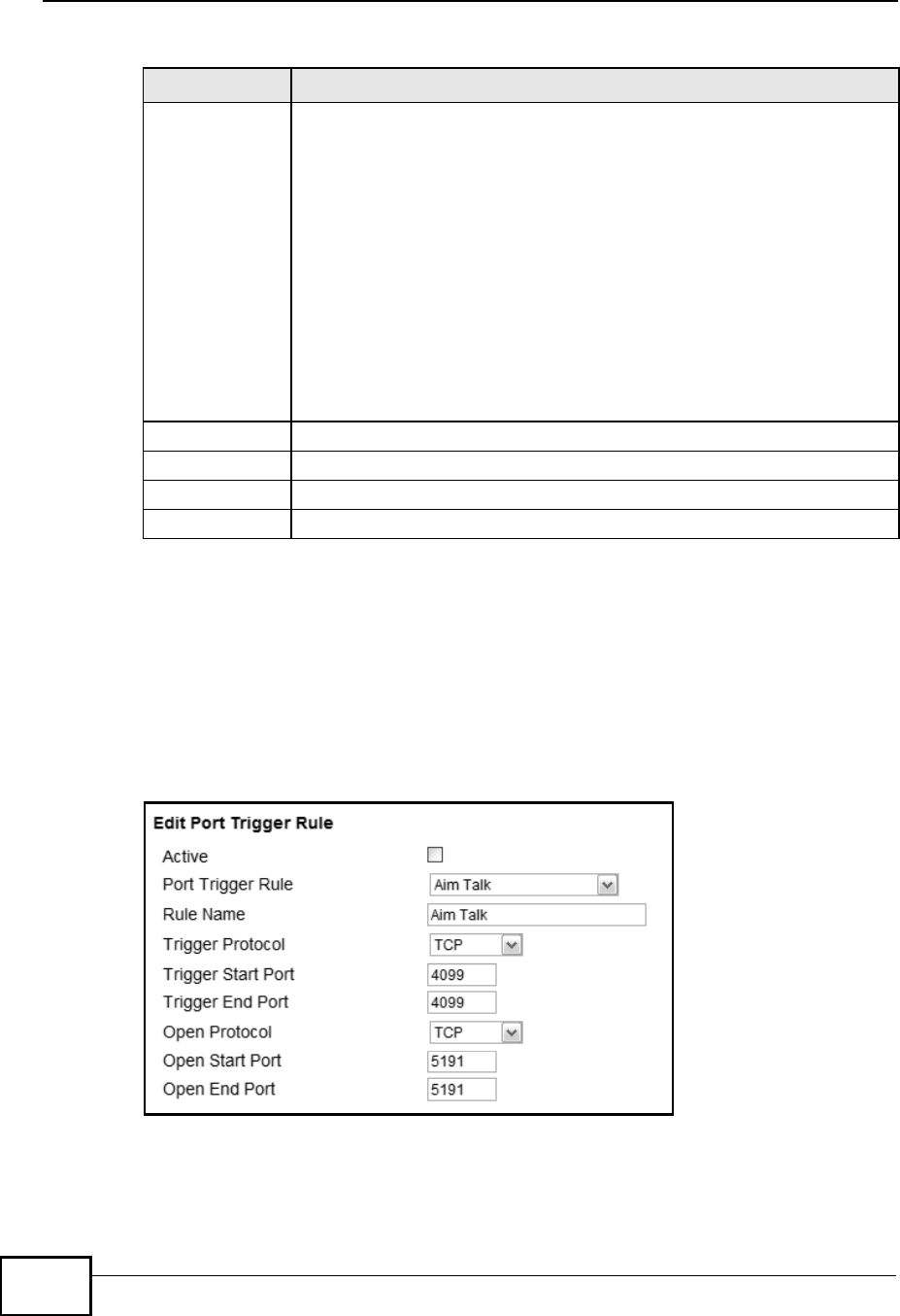
Chapter 7Network Settings
MAX208M User s Guide
94
7.11.1 Port Trigger Wizard
Use the wizard to create a port trigger rules that will allow the WiMAX Device to to
automate port forwarding and allow computers on local network to provide
services that would normally require a fixed address on the local network.
Click Network Setting > NAT > Port Trigger > Wizard
Figure 38 Port Trigger Wizard Screen
Start / End
Port
This displays the start / end open port for the port trigger rule.
Click Add to create a new, empty rule, then enter the outgoing port
number or range of port numbers that makes the WiMAX Device record
the source IP address and assign it to the selected incoming port
number(s).
To select one port number, enter the port number in the Start Port and
End Port fields.
To select a range of ports,
!enter the port number at the beginning of the range in the Start
Port field
!enter the port number at the end of the range in the End Port field.
If you want to delete this rule, click the Delete icon.
DeleteClick this to delete a specified rule.
WizardClick this to open the port trigger "wizard#.
AddClick this to add a new port trigger rule.
OKClick this to save any changes made to the port trigger list.
Table 30 Port Trigger (continued)
LABEL DESCRIPTION
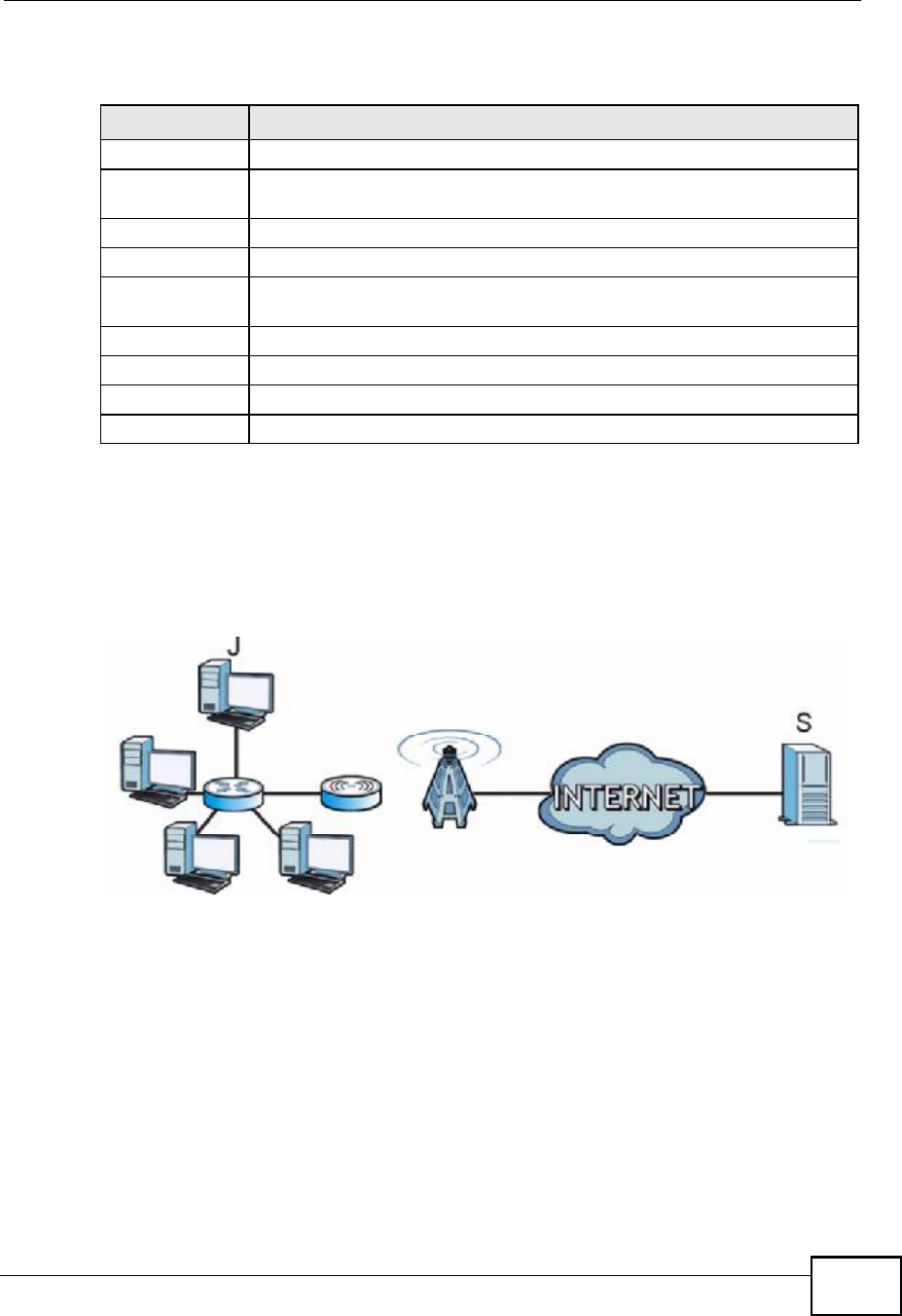
Chapter 7Network Settings
MAX208M User s Guide 95
This screen contains the following fields:
7.11.2 Trigger Port Forwarding Example
The following is an example of trigger port forwarding. In this example, J is Jane s
computer and S is the Real Audio server.
Figure 39 Trigger Port Forwarding Example
1Jane requests a file from the Real Audio server (port 7070).
2Port 7070 is a "trigger# port and causes the WiMAX Device to record Jane s
computer IP address. The WiMAX Device associates Jane's computer IP address
with the "incoming" port range of 6970-7170.
3The Real Audio server responds using a port number ranging between 6970-7170.
4The WiMAX Device forwards the traffic to Jane s computer IP address.
Table 31 Port Trigger Wizard
LABEL DESCRIPTION
ActiveSelect this to make this port trigger rule active.
Port Trigger
Rule
Select the type of port trigger rule.
Rule NameEnter a name for the port trigger rule.
Trigger ProtocolSelect the type of port trigger protocol.
Trigger Start
Port
Enter the port trigger start port.
Trigger End PortEnter the port trigger end port.
Open ProtocolSelect the type of open protocol for the port trigger rule.
Open Start PortSelect the starting open port for the port trigger rule.
Open End PortSelect the ending open port number for the port trigger rule.
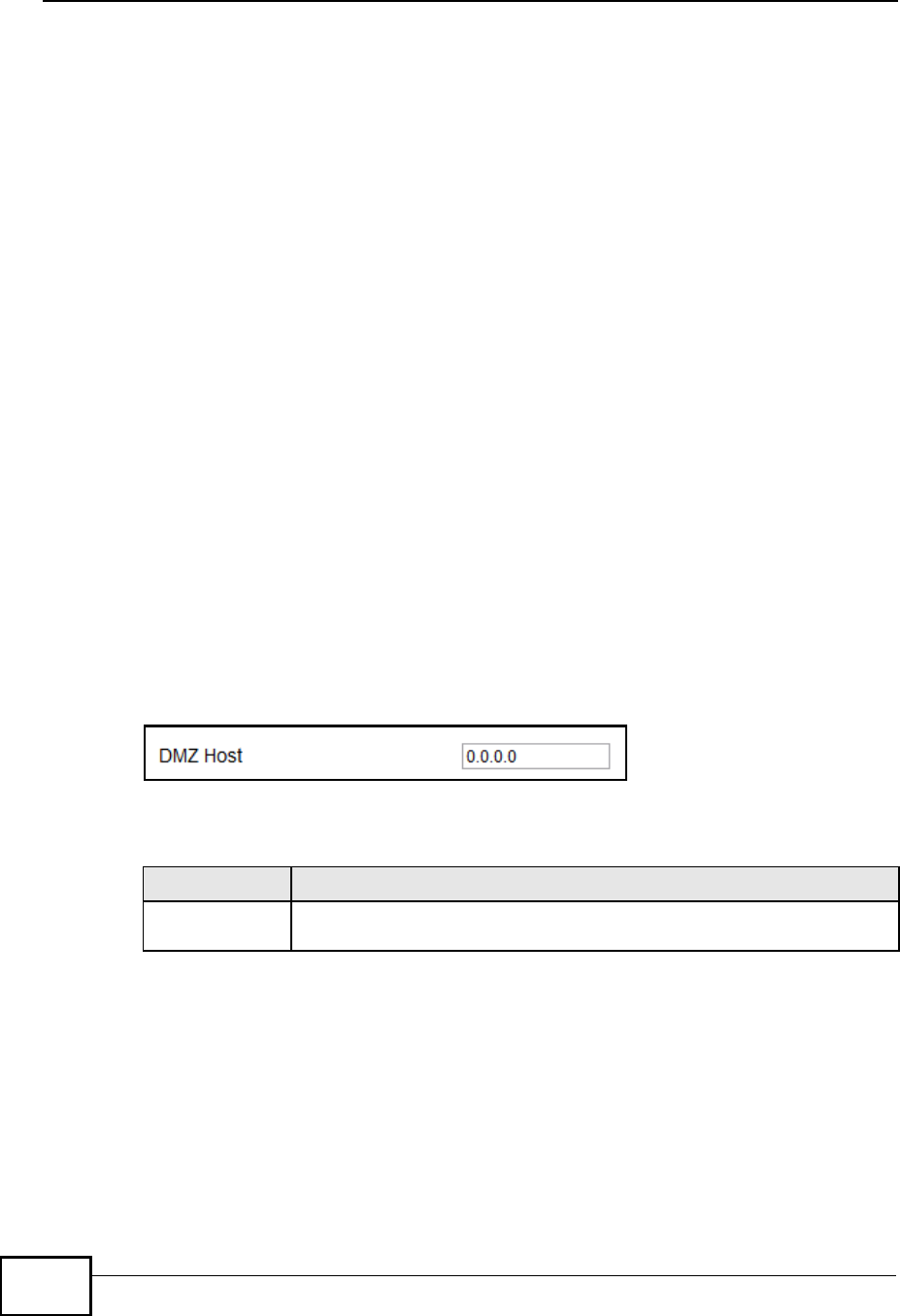
Chapter 7Network Settings
MAX208M User s Guide
96
5Only Jane can connect to the Real Audio server until the connection is closed or
times out. The WiMAX Device times out in three minutes with UDP (User
Datagram Protocol), or two hours with TCP/IP (Transfer Control Protocol/Internet
Protocol).
Two points to remember about trigger ports:
1Trigger events only happen on data that is coming from inside the WiMAX Device
and going to the outside.
2If an application needs a continuous data stream, that port (range) will be tied up
so that another computer on the LAN can t trigger it.
7.12 DMZ
Use this page to set the IP address of your network DMZ (if you have one) for the
WiMAX Device. All incoming packets received by this WiMAX Device s WAN
interface will be forwarded to the DMZ host you set.
Click Network Setting > NAT > DMZ to open this screen as shown next.
Note: The configuration you set in this screen takes priority than the Network Setting
> NAT > Port Forwarding screen.
Figure 40 DMZ Screen
This screen contains the following fields:
Table 32 DMZ
LABEL DESCRIPTION
DMZ HostEnter the IP address of your network DMZ host, if you have one.
0.0.0.0 means this feature is disabled.
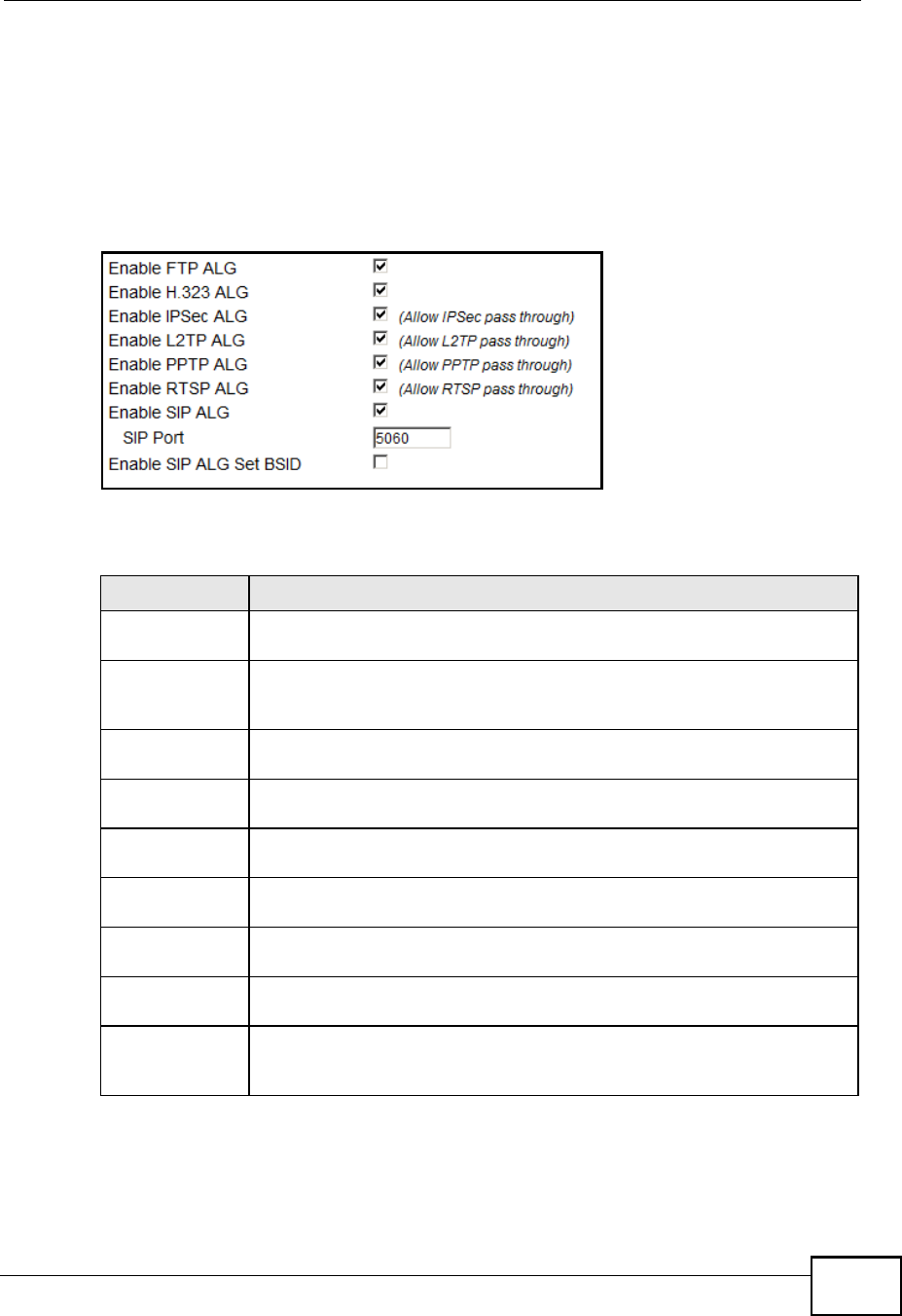
Chapter 7Network Settings
MAX208M User s Guide 97
7.13 ALG
Use these settings to bypass NAT on your WiMAX Device for those applications
that are "NAT un-friendly".
Click Network Setting > NAT > ALG to open this screen as shown next.
Figure 41 ALG Screen
This screen contains the following fields:
Table 33 ALG
LABEL DESCRIPTION
Enable FTP ALGTurns on the FTP ALG to detect FTP (File Transfer Program) traffic and
helps build FTP sessions through the WiMAX Device s NAT.
Enable H.323
ALG
Turns on the H.323 ALG to detect H.323 traffic (used for audio
communications) and helps build H.323 sessions through the WiMAX
Device s NAT.
Enable IPsec
ALG
Turns on the IPsec ALG to detect IPsec traffic and helps build IPsec
sessions through the WiMAX Device s NAT.
Enable L2TP
ALG
Turns on the L2TP ALG to detect L2TP traffic and helps build L2TP
sessions through the WiMAX Device s NAT.
Enable PPTP
ALG
Turns on the PPTP ALG to detect PPTP traffic and helps build PPTP
sessions through the WiMAX Device s NAT.
Enable RTSP
ALG
Turns on the RTSP ALG to detect RTSP traffic and helps build RTSP
sessions through the WiMAX Device s NAT.
Enable SIP ALGTurns on the SIP ALG to detect SIP traffic and helps build SIP sessions
through the WiMAX Device s NAT.
SIP PortIf you are using a custom UDP port number (not 5060) for SIP traffic,
enter it here.
Enable SIP ALG
Set BSID
Check this box to add the base station ID to the outgoing SIP
messages. Select this option only if the media server forwarding calls
requires this information.
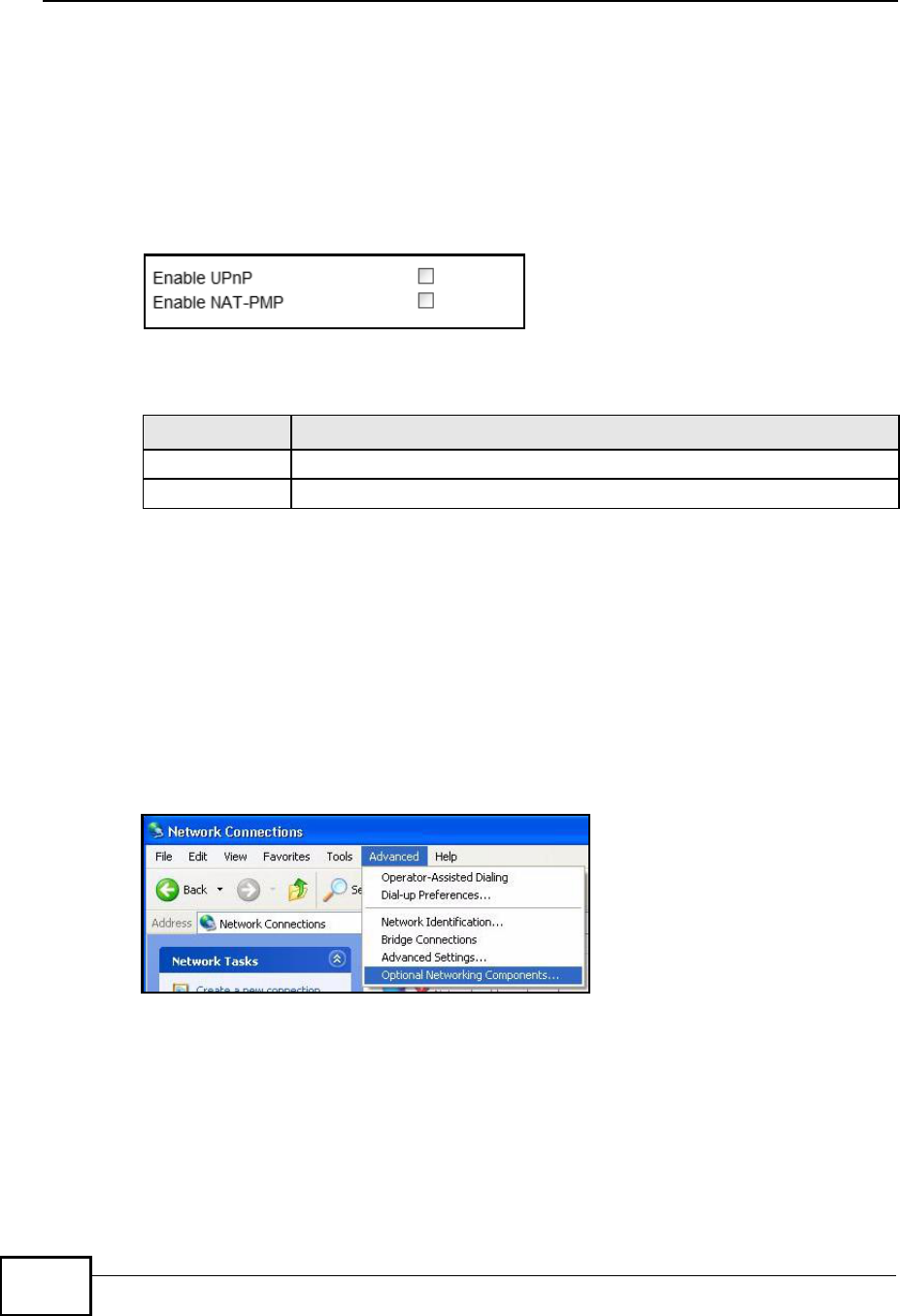
Chapter 7Network Settings
MAX208M User s Guide
98
7.14 UPnP
Use this page to enable the UPnP networking protocol on your WiMAX Device and
allow easy network connectivity with other UPnP-compatible devices.
Click Network Setting > UPnP to open this screen as shown next.
Figure 42 UPnP Screen
This screen contains the following fields:
7.14.1 Installing UPnP in Windows XP
Follow the steps below to install the UPnP in Windows XP.
1Click Start > Control Panel.
2Double-click Network Connections.
3In the Network Connections window, click Advanced in the main menu and
select Optional Networking Components .
Table 34 UPnP
LABEL DESCRIPTION
Enable UPnPSelect this to enable UPnP on the WiMAX Device.
Enable NAT-PMPSelect this to enable NAT Port Mapping Protocol on the WiMAX Device.
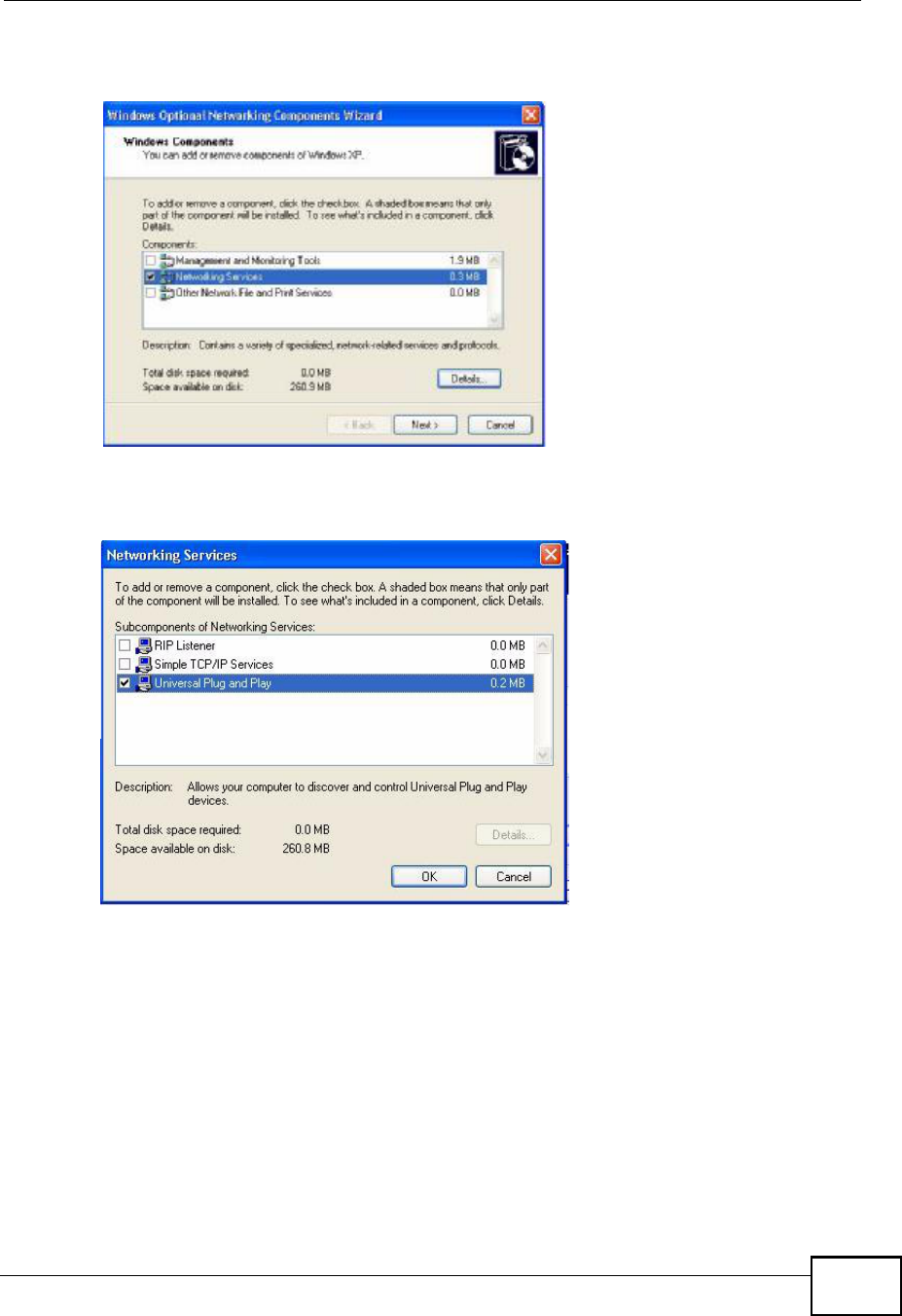
Chapter 7Network Settings
MAX208M User s Guide 99
4The Windows Optional Networking Components Wizard window displays.
Select Networking Service in the Components selection box and click Details.
5In the Networking Services window, select the Universal Plug and Play check
box.
6Click OK to go back to the Windows Optional Networking Component Wizard
window and click Next.
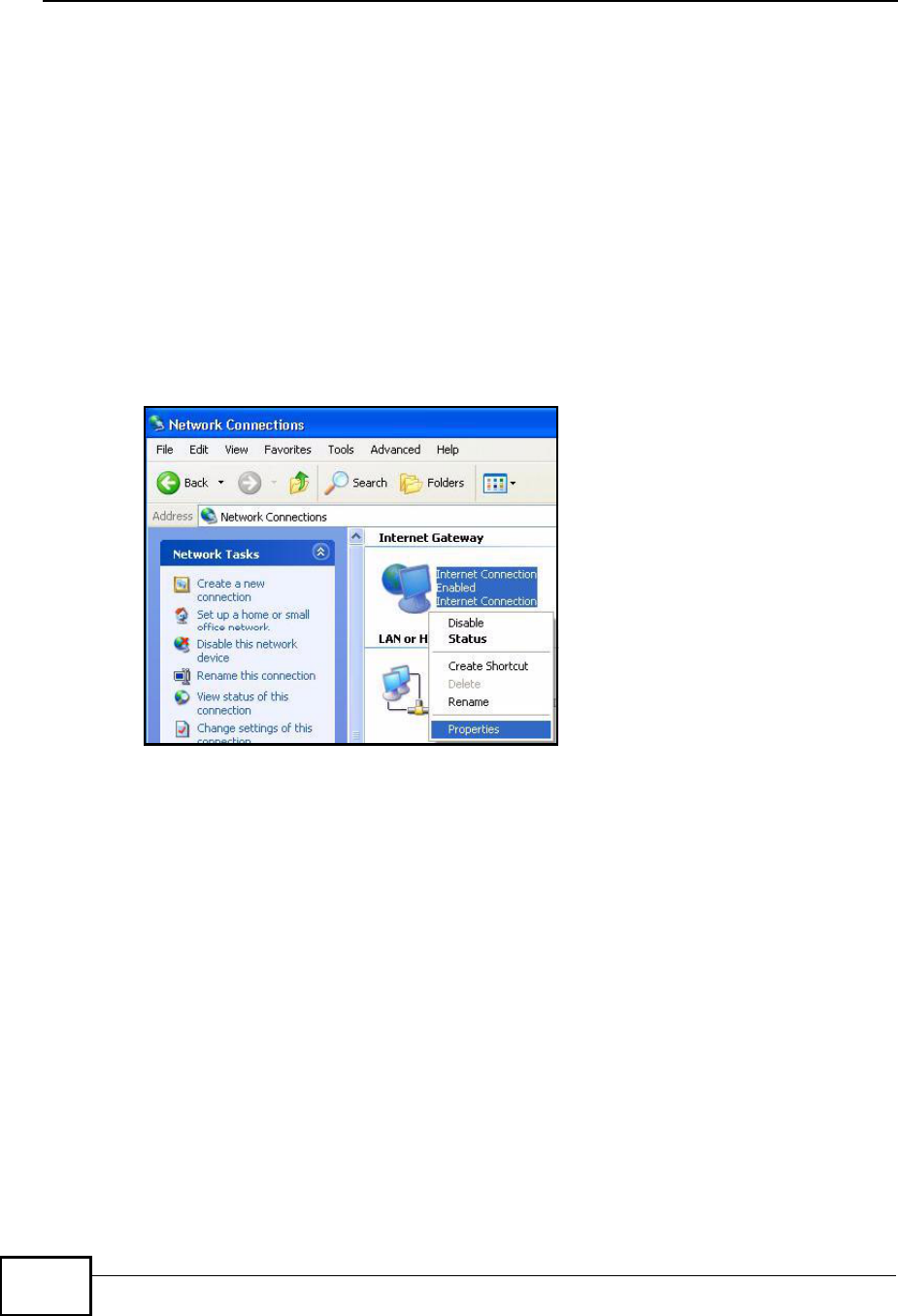
Chapter 7Network Settings
MAX208M User s Guide
100
7.14.1.1 Auto-discover Your UPnP-enabled Network Device in
Windows XP
This section shows you how to use the UPnP feature in Windows XP. You must
already have UPnP installed in Windows XP and UPnP activated on the WiMAX
Device.
Make sure the computer is connected to a LAN port of the WiMAX Device. Turn on
your computer and the WiMAX Device.
1Click Start and Control Panel. Double-click Network Connections. An icon
displays under Internet Gateway.
2Right-click the icon and select Properties.
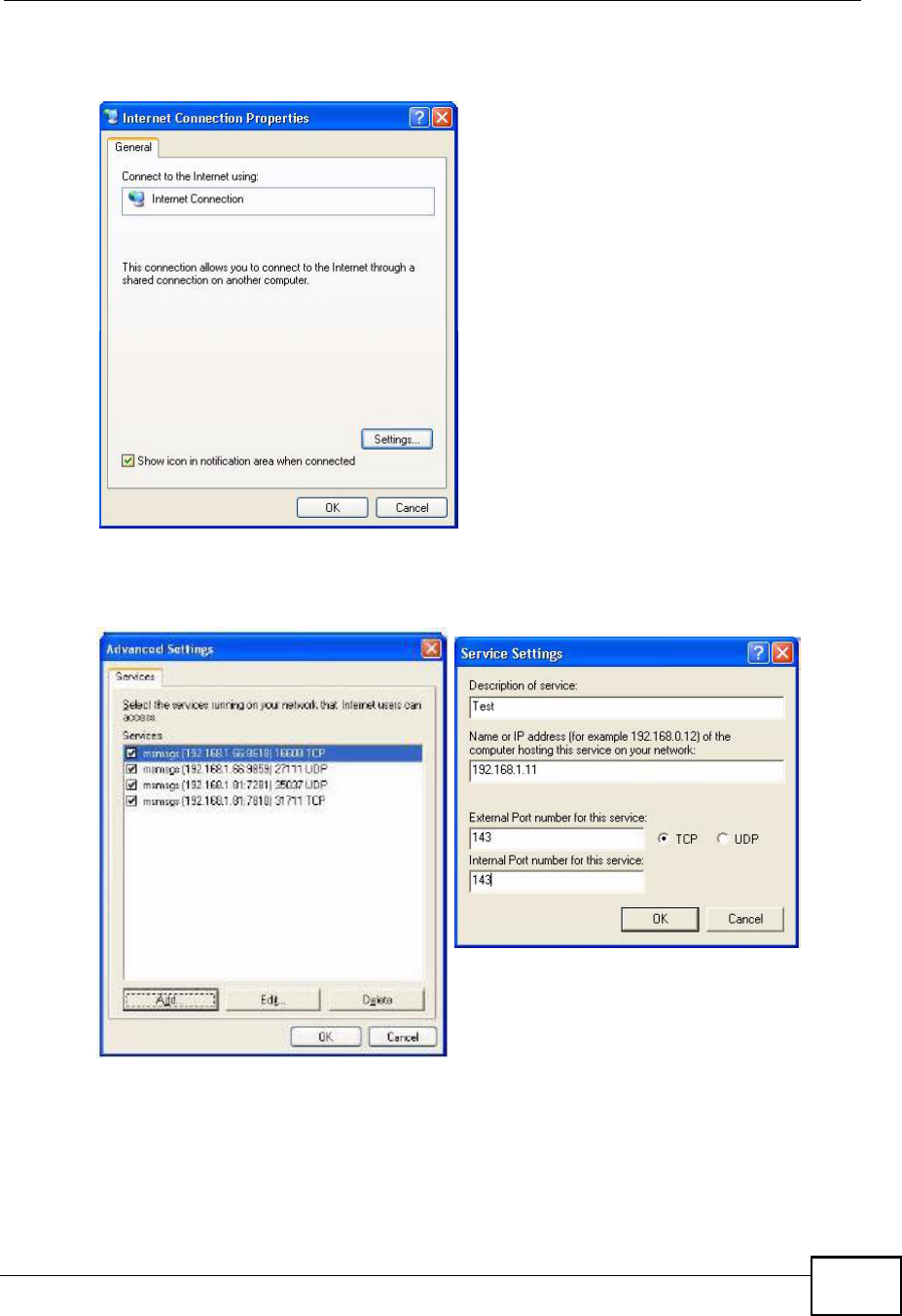
Chapter 7Network Settings
MAX208M User s Guide 101
3In the Internet Connection Properties window, click Settings to see the port
mappings there were automatically created.
4You may edit or delete the port mappings or click Add to manually add port
mappings.
5When the UPnP-enabled device is disconnected from your computer, all port
mappings will be deleted automatically.
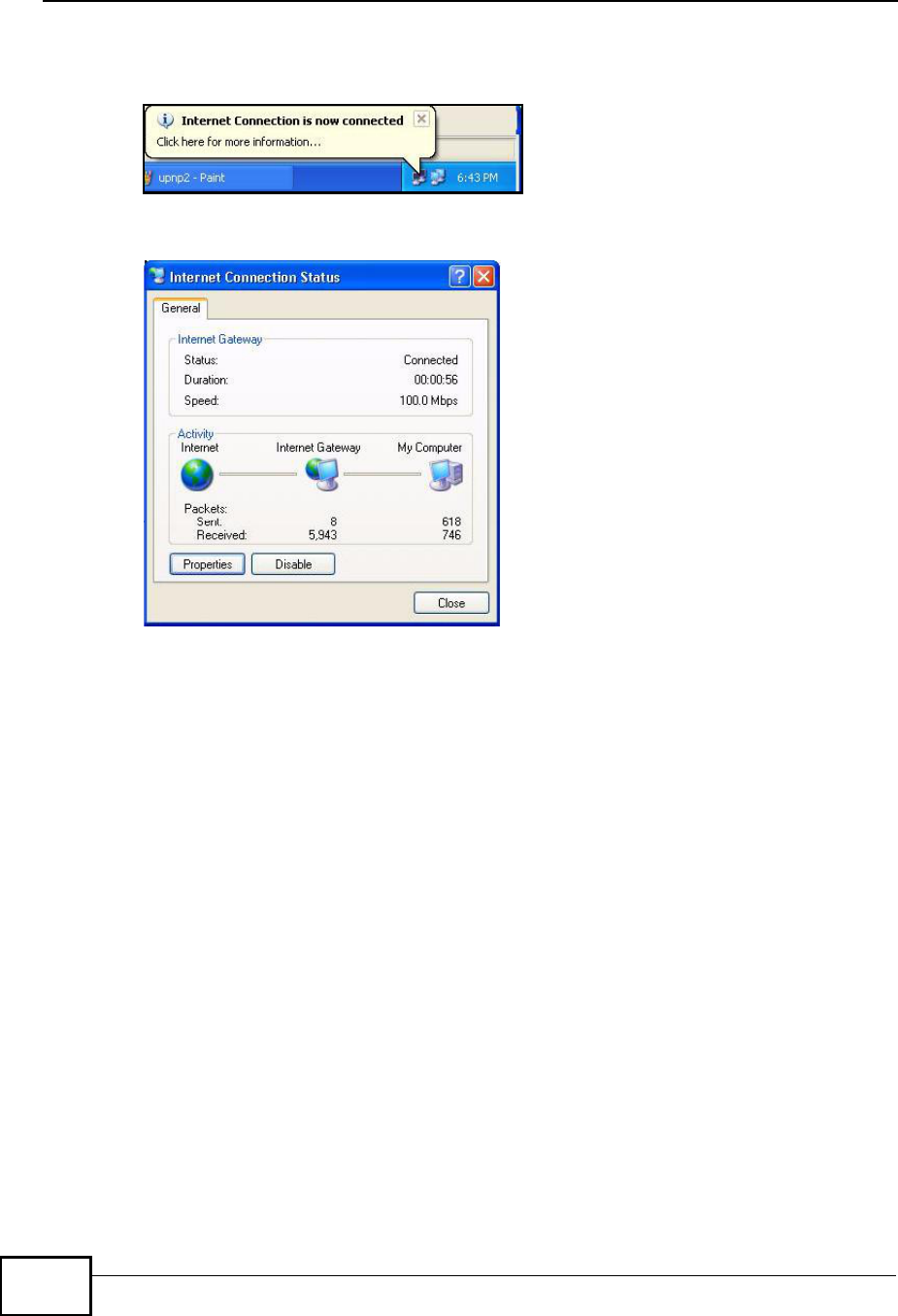
Chapter 7Network Settings
MAX208M User s Guide
102
6Select Show icon in notification area when connected option and click OK.
An icon displays in the system tray.
7Double-click on the icon to display your current Internet connection status.
7.14.2 Web Configurator Easy Access
With UPnP, you can access the web-based configurator on the WiMAX Device
without finding out the IP address of the WiMAX Device first. This becomes helpful
if you do not know the IP address of the WiMAX Device.
Follow the steps below to access the web configurator:
1Click Start and then Control Panel.
2Double-click Network Connections.
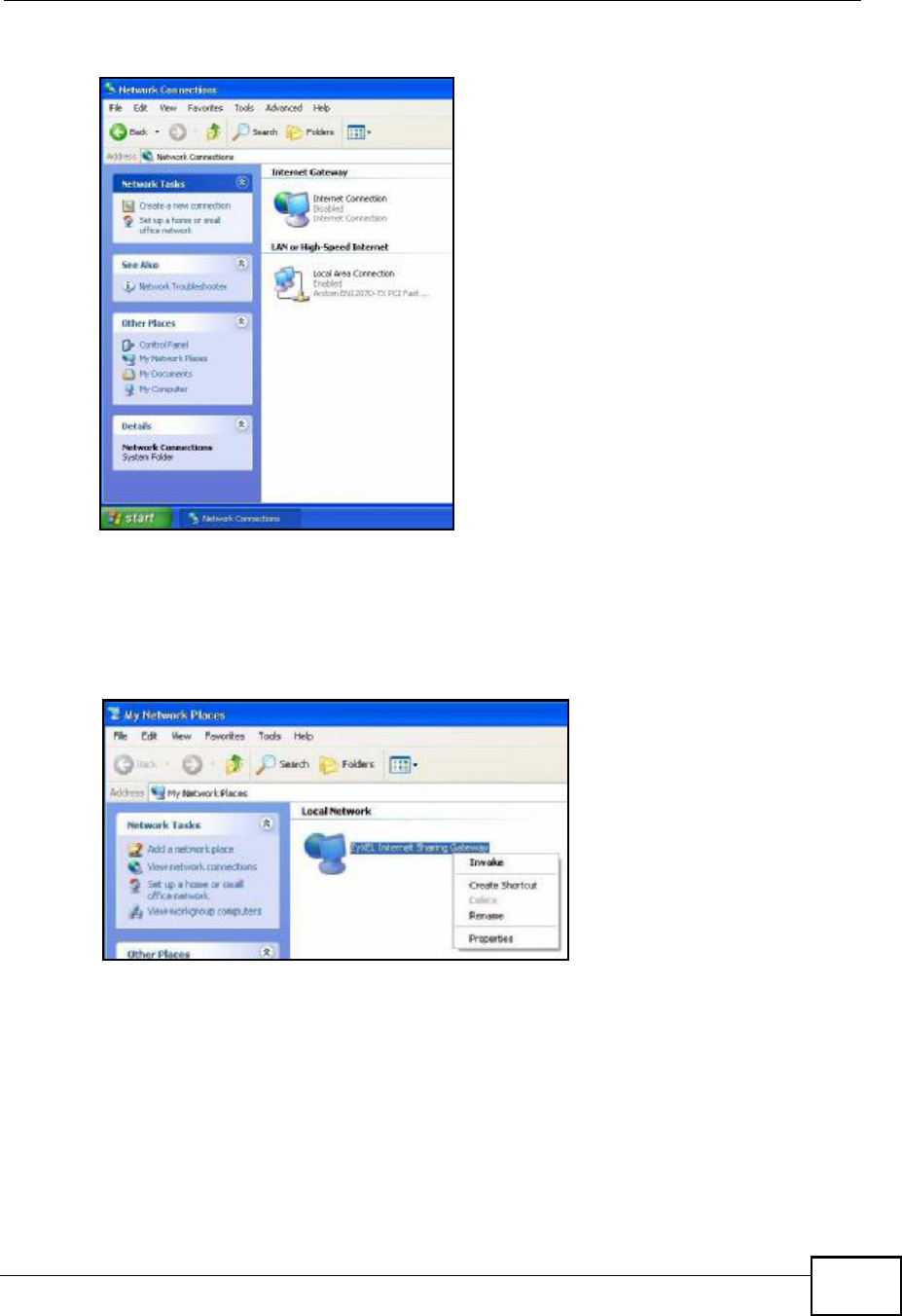
Chapter 7Network Settings
MAX208M User s Guide 103
3Select My Network Places under Other Places.
4An icon with the description for each UPnP-enabled device displays under Local
Network.
5Right-click on the icon for your WiMAX Device and select Invoke. The web
configurator login screen displays.
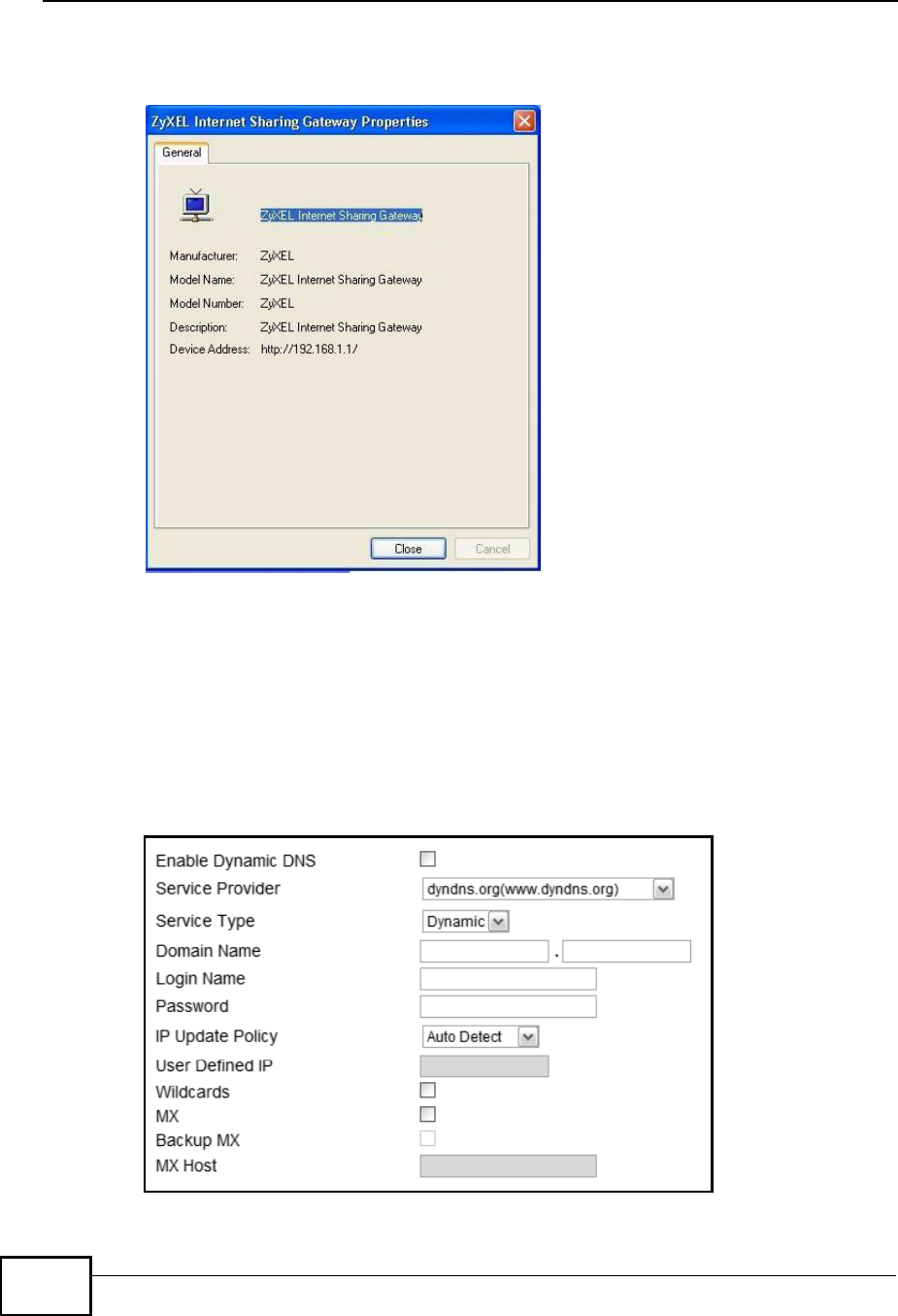
Chapter 7Network Settings
MAX208M User s Guide
104
6Right-click on the icon for your WiMAX Device and select Properties. A properties
window displays with basic information about the WiMAX Device.
7.15 DDNS
Use this page to configure the WiMAX Device as a dynamic DNS client.
Click Network Setting > DDNS
Figure 43 DDNS Screen
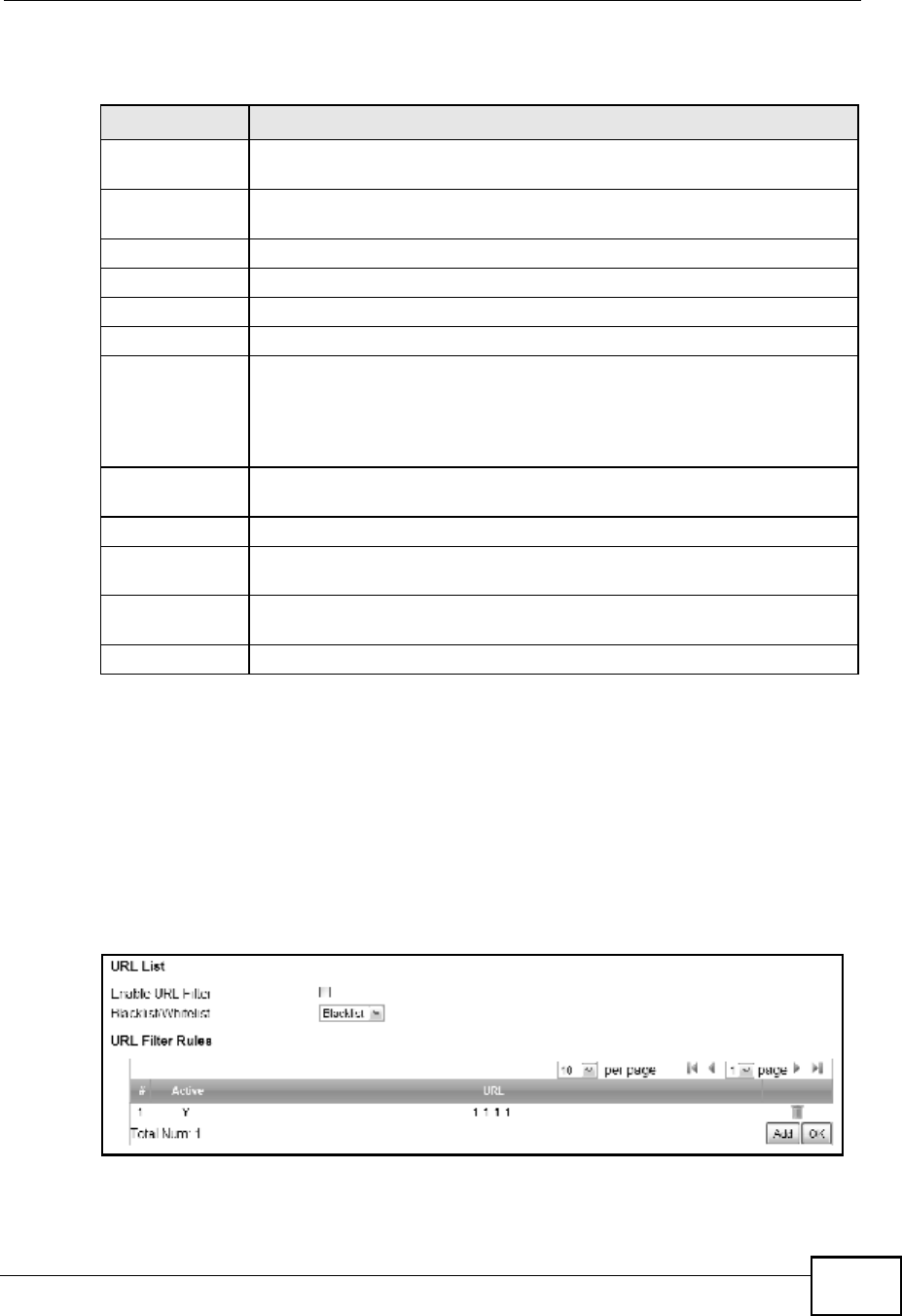
Chapter 7Network Settings
MAX208M User s Guide 105
This screen contains the following fields:
7.16 Content Filter
Use these settings to allow ("whitelist") or block ("blacklist") connections to and
from specific web sites through the WiMAX Device.
Click Network Setting > Content Filter to open this screen as shown next.
Figure 44 Content Filter Screen
Table 35 DDNS
LABEL DESCRIPTION
Enable Dynamic
DNS
Select this to enable dynamic DNS on the WiMAX Device.
Service
Provider
Select the dynamice DNS service provider for the WiMAX Device.
Service TypeSelect the dynamic DNS service type.
Domain NameEnter the domain name.
Login NameEnter the user name.
PasswordEnter the password.
IP Update PolicySelect the policy used by the WiMAX Device. Options are:
!Auto Detect
!WAN
!User Defined
User Defined IPIf you chose "User Defined# for the IP Update Policy, enter the user
defined IP address.
WildcardsSelect this to allow a hostname to use wildcards such as "*#.
MXSelect this to enable mail routing, if supported by the specified DYNDNS
service provider.
Backup MXSelect this to enable a secondary mail routing, if supported by the
specified DYNDNS service provider.
MX HostEnter the host to which mail is routed when the MX option is selected.

Chapter 7Network Settings
MAX208M User s Guide
106
This screen contains the following fields:
Table 36 Content Filter
LABEL DESCRIPTION
URL List
Enable URL
Filter
Select this employ the content filter to allow ("whitelist#) or block
("blacklist#) specific URL connections made through the WiMAX Device.
Blacklist/
Whitelist
Select whether the current filtering applies to the blacklist (sites that
are blocked) or the whitelist (sites that are allowed).
URL Filter Rule
ActiveIndicates whether the current URL filter is active or not.
URLIndicates the URL to be filtered according to blacklist or whitelist rules.
DeleteClick this to delete a specified rule.
AddClick this to add a new filter rule.
OKClick this to save any changes made to the list.

MAX208M User s Guide 107
CHAPTER 8
Security
8.1 Overview
This chapter shows you how to configure the WiMAX Device s network settings.
8.1.1 What You Need to Know
The following terms and concepts may help as you read through this chapter.
About the WiMAX Device!s Security Features
The WiMAX Device security features are designed to protect against Denial of
Service attacks when activated as well as block access to and from specific URLs
and MAC addresses. Its purpose is to allow a private Local Area Network (LAN) to
be securely connected to the Internet. The WiMAX Device can be used to prevent
theft, destruction and modification of data.
The WiMAX Device is installed between the LAN and a WiMAX base station
connecting to the Internet. This allows it to act as a secure gateway for all data
passing between the Internet and the LAN.
The WiMAX Device has one Ethernet (LAN) port. The LAN (Local Area Network)
port attaches to a network of computers, which needs security from the outside
world. These computers will have access to Internet services such as e-mail, FTP
and the World Wide Web. However, "inbound access# is not allowed (by default)
unless the remote host is authorized to use a specific service.
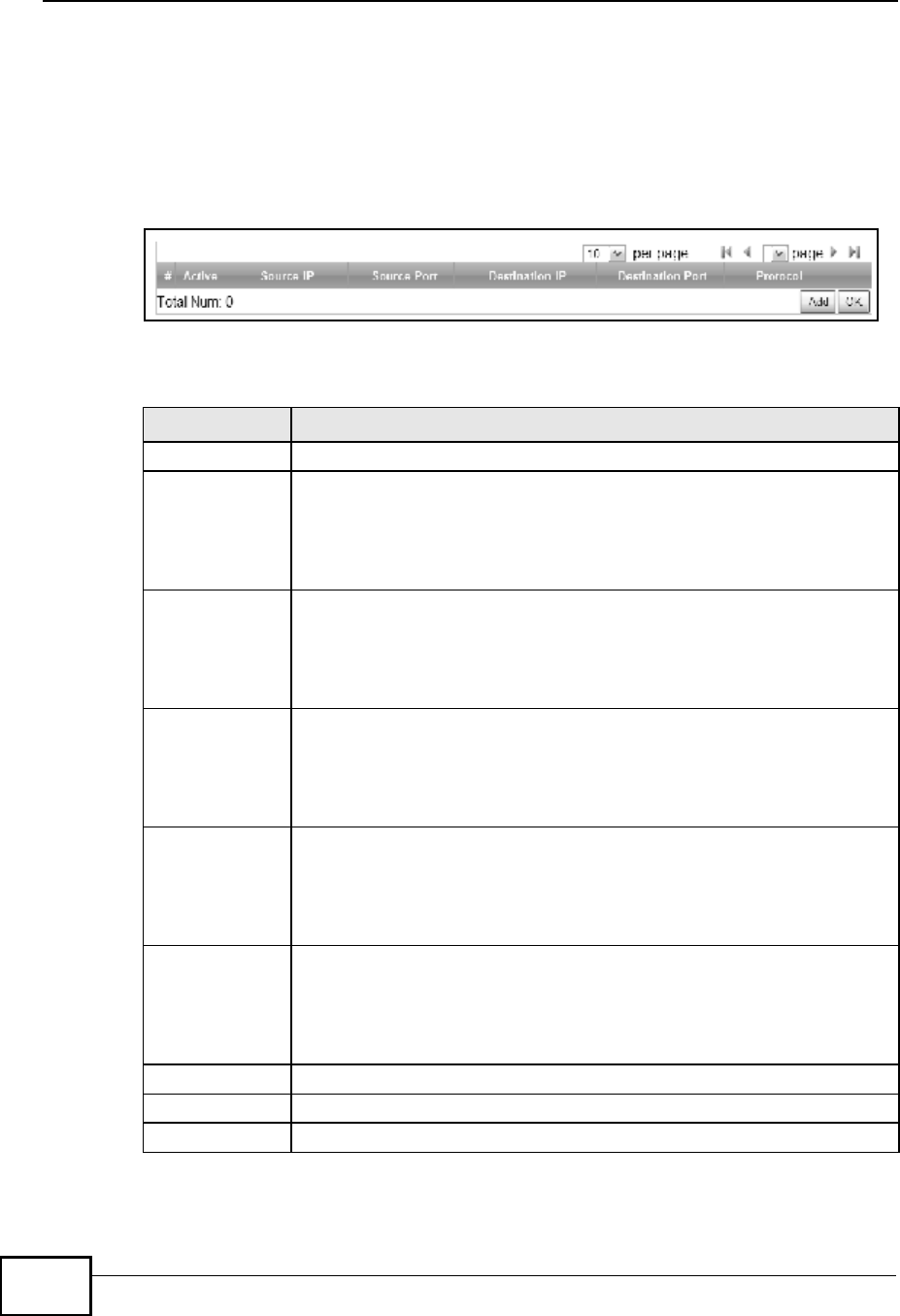
Chapter 8Security
MAX208M User s Guide
108
8.2 IP Filter
Use this screen to block incoming connections from specific IP addresses.
Click Security > Firewall > IP Filter to open this screen as shown next.
Figure 45 IP Filter Screen
This screen contains the following fields:
Table 37 IP Filter
LABEL DESCRIPTION
ActiveIndicates whether the current IP filter is active or not.
Source IPThis displays the source IP address for the IP filter rule.
Click Add to create a new, empty rule, then enter the incoming IP
address for the WiMAX Device to block.
If you want to delete this rule, click the Delete icon.
Source PortThis displays the source port number for the IP filter rule.
Click Add to create a new, empty rule, then enter the incoming port
number for the WiMAX Device to block.
If you want to delete this rule, click the Delete icon.
Destination IPThis displays the destination IP address for the IP filter rule.
Click Add to create a new, empty rule, then enter the outgoing IP
address for the WiMAX Device to block.
If you want to delete this rule, click the Delete icon.
Destination PortThis displays the destination port number for the IP filter rule.
Click Add to create a new, empty rule, then enter the outgoing port
number for the WiMAX Device to block.
If you want to delete this rule, click the Delete icon.
ProtocolThis displays the protocol blocked by the IP filter rule.
Click Add to create a new, empty rule, then select the protocol type for
the WiMAX Device to block.
If you want to delete this rule, click the Delete icon.
DeleteClick this to delete a specified rule.
AddClick this to add a new filter rule.
OKClick this to save any changes made to the list.
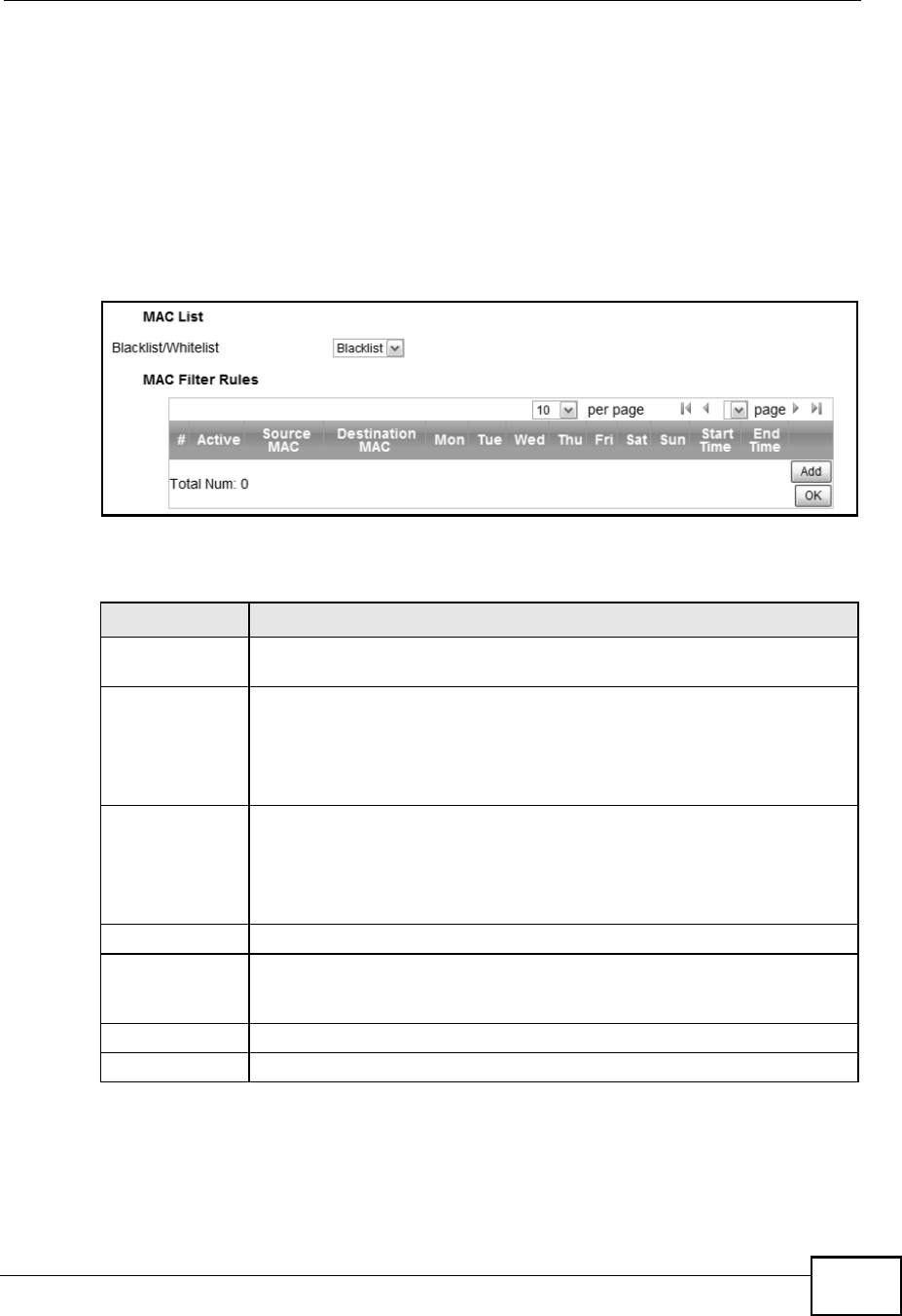
Chapter 8Security
MAX208M User s Guide 109
8.3 MAC Filter
Use this screen to allow ("whitelist") or block ("blacklist") connections to and from
specific devices on the network based on their unique MAC addresses.
Note: This feature only works when the WiMAX Device is in bridge mode.
Click Security > Firewall > MAC Filter to open this screen as shown next.
Figure 46 MAC Filter Screen
This screen contains the following fields:
Table 38 MAC Filter
LABEL DESCRIPTION
Blacklist/
Whitelist
Select either whitelist or blacklist for viewing and editing.
Source MACThis displays the source MAC for the MAC filter rule.
Click Add to create a new, empty rule, then enter the incoming MAC
address for the WiMAX Device to block.
If you want to delete this rule, click the Delete icon.
Destination
MAC
This displays the destination MAC for the MAC filter rule.
Click Add to create a new, empty rule, then enter the outgoing MAC
address for the WiMAX Device to block.
If you want to delete this rule, click the Delete icon.
Mon ~ Sun Select which days of the week you want the filter rule to be effective.
Start / End
Time
Select what time each day you want the filter rule to be effective. Enter
times in 24-hour format; for example, 3:00pm should be entered as
15:00.
AddClick this to add a new filter rule.
OKClick this to save any changes made to the list.
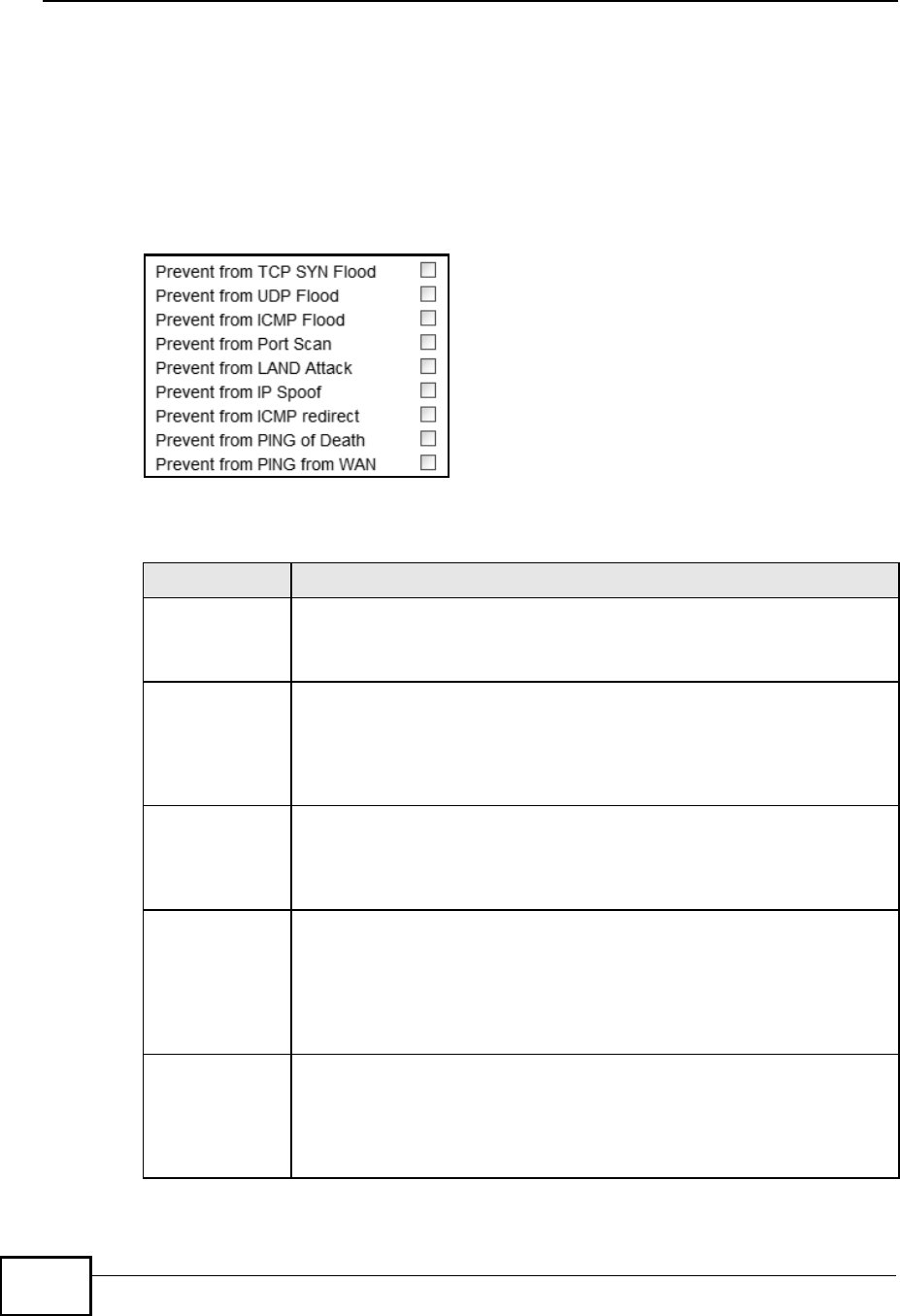
Chapter 8Security
MAX208M User s Guide
110
8.4 DDOS
Use these settings to potentially block specific types of Denial of Service attacks
directed at your WiMAX Device.
Click Security > Firewall > DDOS to open this screen as shown next.
Figure 47 DDOS Screen
This screen contains the following fields:
Table 39 DDOS
LABEL DESCRIPTION
Prevent from
TCP SYN Flood
Select this to monitor for and block TCP SYN flood attacks.
A SYN flood is one type of denial of service attack where an
overwhelming number of SYN requests assault a client device.
Prevent from
UDP Flood
Select this to monitor for and block UDP flood attacks.
An UDP flood is a type of denial of service attack where an
overwhelming number of UDP packets assault random ports on a client
device. Because the device is forced to analyze and respond to each
packet, it quickly becomes unreachable to other devices.
Prevent from
ICMP Flood
Select this to monitor for and block ICMP flood attacks.
An ICMP flood is a type of denial of service attack where an
overwhelming number of ICMP ping assault a client device, locking it
down and preventing it from responding to requests from other servers.
Prevent from
Port Scan
Select this to monitor for and block port scan attacks.
A port scan attack is typicall the precursor to a full-blown denial of
service attack wherein each port on a device is probed for security holes
that can be exploited. Once a security flaw is discovered, an attacker
can initiate the appropriate denial of service attack or intrusion attack
against the client device.
Prevent from
LAND Attack
Select this to monitor for and block LAND attacks.
A Local Area Network Denial (LAND) attack is a type of denial of service
attack where a spoofed TCP SYN packet targets a client device s IP
address and forces it into an infinite recursive loop of querying itself and
then replying, effectively locking it down.

Chapter 8Security
MAX208M User s Guide 111
Prevent from IP
Spoof
Select this to monitor for and block IP address spoof attacks.
An IP address spoof is an attack whereby the source IP address in the
incoming IP packets allows a malicious party to masquerade as a
legitimate user and gain access to the client device.
Prevent from
ICMP redirect
Select this to monitor for and block ICMP redirect attacks.
An ICMP redirect attack is one where forged ICMP redirect messages
can force the client device to route packets for certain connections
through an attacker s host.
Prevent from
PING of Death
Select this to monitor for and block ping of death attacks.
A Ping of Death (POD) attack is one where larger-than-allowed ping
packets are fragmented then sent against a client device. This results in
the client device suffering from a buffer overflow and subsequent
system crash.
Prevent from
PING from WAN
Select this to ignore ping requests from the WAN.
Table 39 DDOS (continued)
LABEL DESCRIPTION

Chapter 8Security
MAX208M User s Guide
112

MAX208M User s Guide 113
CHAPTER 9
Maintenance
9.1 Overview
Use these screens to manage and maintain your WiMAX Device.
9.1.1 What You Need to Know
The following terms and concepts may help as you read through this chapter.
Remote Management Limitations
Remote management over LAN or WAN will not work when:
1You have disabled that service in one of the remote management screens.
2The IP address in the Secured Client IP field does not match the client IP
address. If it does not match, the WiMAX Device will disconnect the session
immediately.
3There is already another remote management session with an equal or higher
priority running. You may only have one remote management session running at
one time.

Chapter 9Maintenance
MAX208M User s Guide
114
Remote Management and NAT
When NAT is enabled:
!Use the WiMAX Device s WAN IP address when configuring from the WAN.
!Use the WiMAX Device s LAN IP address when configuring from the LAN.
System Timeout
There is a default system management idle timeout of five minutes. The WiMAX
Device automatically logs you out if the management session remains idle for
longer than this timeout period. The management session does not time out when
a statistics screen is polling.
SNMP
Simple Network Management Protocol (SNMP) is a protocol used for exchanging
management information between network devices. SNMP is a member of the
TCP/IP protocol suite. Your WiMAX Device supports SNMP agent functionality,
which allows a manager station to manage and monitor the WiMAX Device
through the network. The WiMAX Device supports SNMP version one (SNMPv1)
and version two (SNMPv2). The next figure illustrates an SNMP management
operation.
Note: SNMP is only available if TCP/IP is configured.
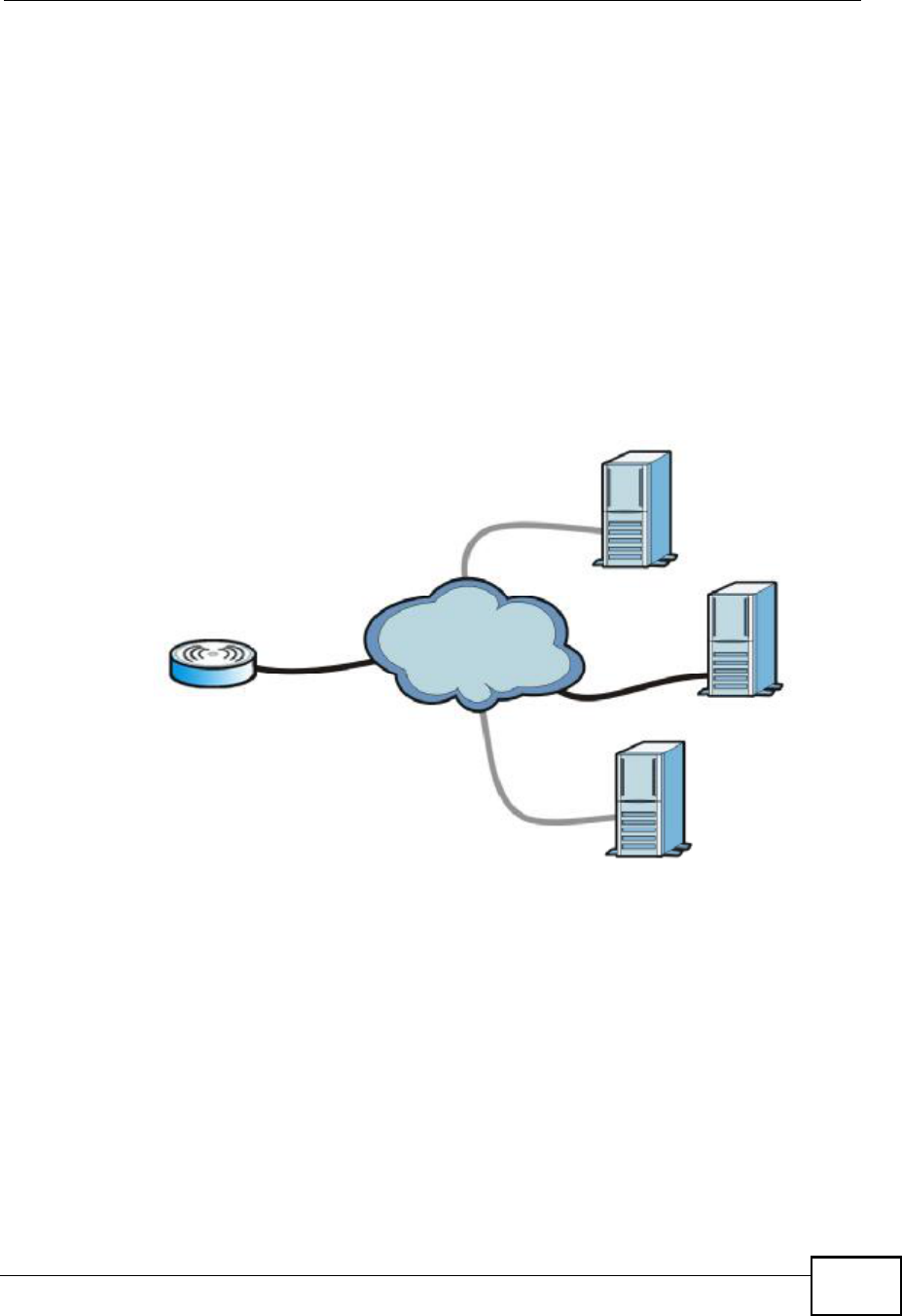
Chapter 9Maintenance
MAX208M User s Guide 115
TR-069
TR-069 is an abbreviation of "Technical Report 069#, a protocol designed to
facilitate the remote management of Customer Premise Equipement (CPE), such
as the WiMAX Device. It can be managed over a WAN by means of an Auto
Configuration Server (ACS). TR-069 is based on sending Remote Procedure Calls
(RPCs) between the ACS and the client device. RPCs are sent in Extensible Markup
Language (XML) format over HTTP or HTTPS.
An administrator can use an ACS to remotely set up the WiMAX Device, modify its
settings, perform firmware upgrades, and monitor and diagnose it. In order to do
so, you must enable the TR-069 feature on your WiMAX Device and then configure
it appropriately. (The ACS server which it will use must also be configured by its
administrator.)
Figure 48 TR-069 Example
In this example, the WiMAX Device receives data from at least 3 sources: A SIP
server for handling voice calls, an HTTP server for handling web services, and an
ACS, for configuring the WiMAX Device remotely. All three servers are owned and
operated by the client s Internet Service Provider. However, without the
configuration settings from the ACS, the WiMAX Device cannot access the other
two servers. Once the WiMAX Device receives its configuration settings and
implements them, it can connect to the other servers. If the settings change, it
will once again be unable to connect until it receives its updates from the ACS.
The WiMAX Device can be configured to periodically check for updates from the
auto-configuration server so that the end user need not be worried about it.
SIP
ACS
HTTP
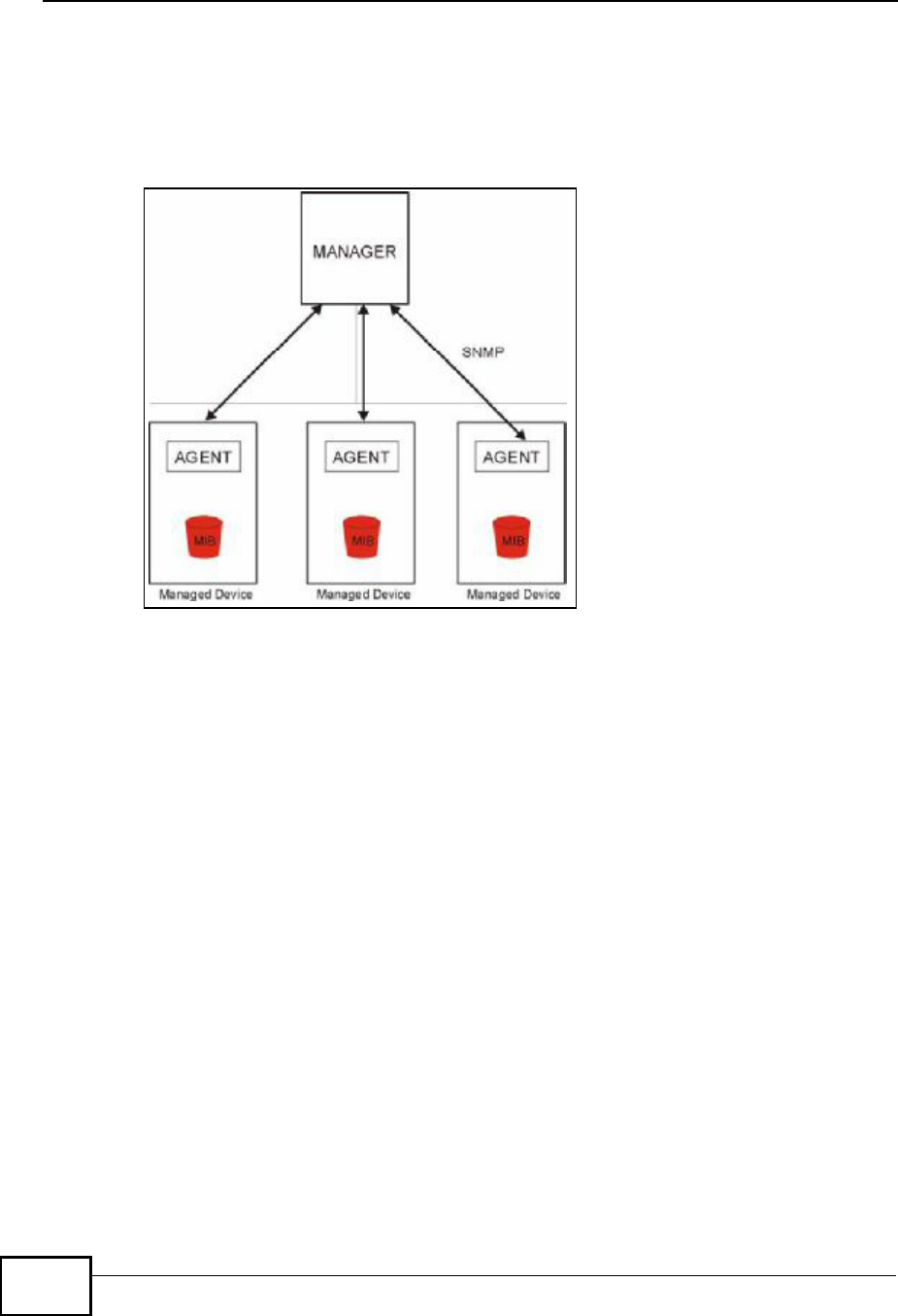
Chapter 9Maintenance
MAX208M User s Guide
116
SNMP
An SNMP managed network consists of two main types of component: agents and
a manager.
Figure 49 SNMP Management Model
An agent is a management software module that resides in a managed device (the
WiMAX Device). An agent translates the local management information from the
managed device into a form compatible with SNMP. The manager is the console
through which network administrators perform network management functions. It
executes applications that control and monitor managed devices.
The managed devices contain object variables/managed objects that define each
piece of information to be collected about a device. Examples of variables include
such as number of packets received, node port status etc. A Management
Information Base (MIB) is a collection of managed objects. SNMP allows a
manager and agents to communicate for the purpose of accessing these objects.
The WiMAX Device supports MIB II that is defined in RFC-1213 and RFC-1215. The
focus of the MIBs is to let administrators collect statistical data and monitor status
and performance.
SNMP itself is a simple request/response protocol based on the manager/agent
model. The manager issues a request and the agent returns responses using the
following protocol operations:
!Get - Allows the manager to retrieve an object variable from the agent.
!GetNext - Allows the manager to retrieve the next object variable from a table
or list within an agent. In SNMPv1, when a manager wants to retrieve all
elements of a table from an agent, it initiates a Get operation, followed by a
series of GetNext operations.

Chapter 9Maintenance
MAX208M User s Guide 117
!Set - Allows the manager to set values for object variables within an agent.
!Trap - Used by the agent to inform the manager of some events.
The WiMAX Device sends traps to the SNMP manager when any of the following
events occurs:
OMA-DM
When the WiMAX Device initiates communication with the server (often times at
start up or after the first time you turn it on), the server uploads commands, new
files (if any), and other information used by a service provider to customize the
WiMAX Device s features.
Device management works as follows:
1The server (A) sends out the query (1) to the WiMAX Device (B).
2The WiMAX Device responds by sending back its credentials (2), to which the
server responds with its credentials along with a string of management operations
(3).
3The client responds to the management operations (4), perhaps confirming file
alterations or confirming receipt of file uploads and so on.
Table 40 SNMP Traps
TRAP # TRAP NAME DESCRIPTION
0coldStart (defined in RFC-
1215)
A trap is sent after booting (power on).
1warmStart (defined in RFC-
1215)
A trap is sent after booting (software reboot).
4authenticationFailure (defined
in RFC-1215)
A trap is sent to the manager when receiving
any SNMP get or set requirements with the
wrong community (password).
6whyReboot (defined in ZYXEL-
MIB)
A trap is sent with the reason of restart before
rebooting when the system is going to restart
(warm start).
6a For intentional reboot: A trap is sent with the message "System reboot
by user!" if reboot is done intentionally, (for
example, download new files, CI command "sys
reboot", etc.).
6b For fatal error: A trap is sent with the message of the fatal
code if the system reboots because of fatal
errors.
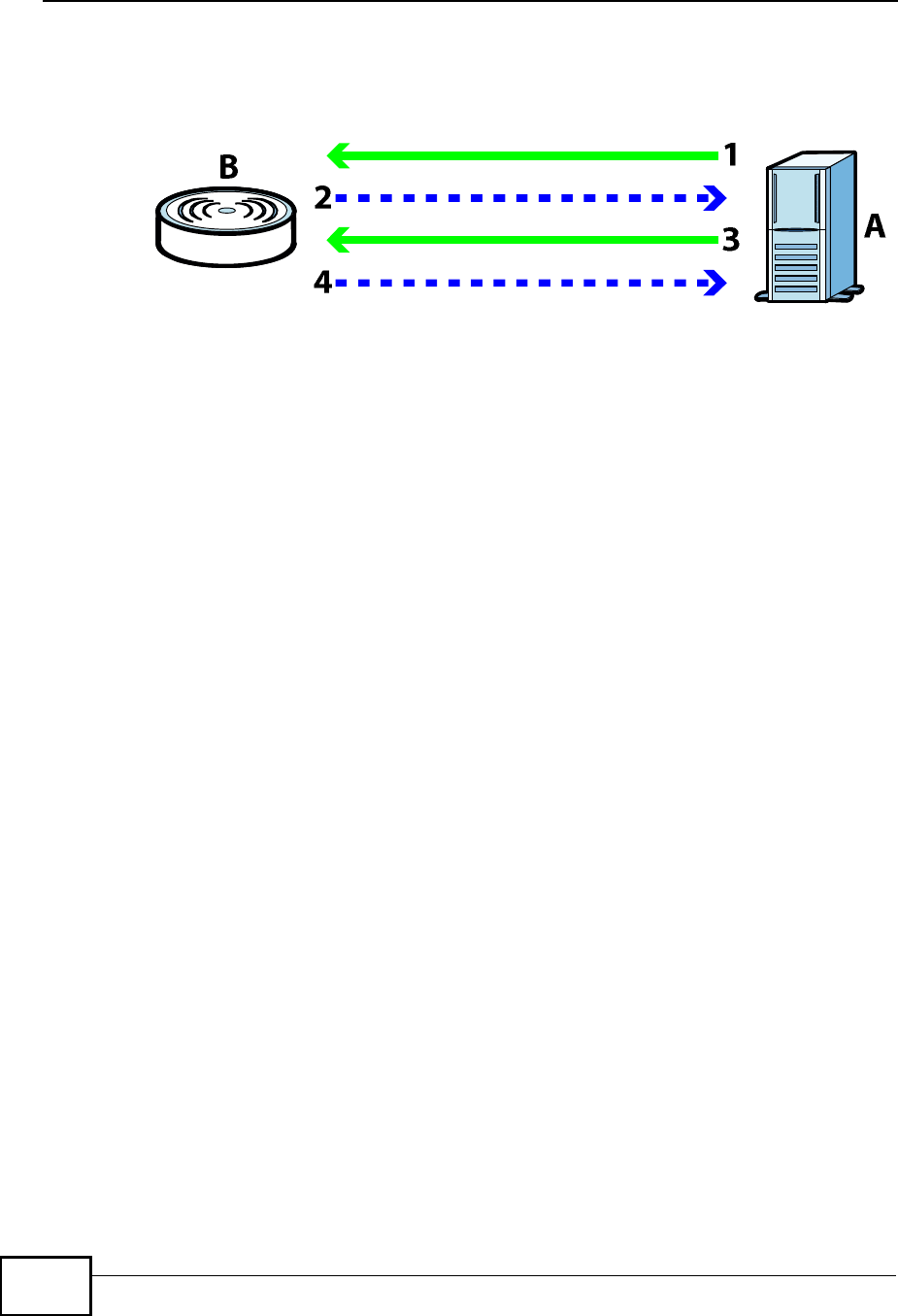
Chapter 9Maintenance
MAX208M User s Guide
118
4The server disconnects from the WiMAX Device once all of its management
operations have been carried out.
Figure 50 OMA-DM Data Management
OMA-DM Authentication
In order to ensure the integrity of the connection between an OMA-DM server and
the WiMAX Device, communication between the two is encoded using one of three
common algorithms. They are not intended to be used in lieu of proper digital
security, but instead as a means of transmitting multiple disparate types of data
over HTTP. Security encryption for communication is handled by different
processes configured elsewhere in the WiMAX Device s web configurator
Basic Access Authentication $ Sends a person s user name and password in
Base64. This auhentication protocol is supported by all browsers that are HTTP
1.0/1.1 compliant. Although converted to Base64 for the sake of cross-
compatibility, credentials are nonetheless passed between the web browser and
the server in plaintext, making it extremely easy to intercept and read. As such, it
is rarely used anymore.
Digest Access Authentication $ This protocol was designed to replace basic
access authentication. Instead of encoding a user name and password in plaintext,
this protocol uses what is known as an MD5 message authentication code. It
allows the server to issue a single-use, randomly generated number (known as a
%nonce ) to the client (in this case, the web browser), which then uses the number
as the %public key for encrypting its data. When the server receives the encrypted
data, it unlocks it using the %key that was just provided. While stronger than basic
access authentication, this protocol is not as strong as, say, HMAC, or as secure as
the client using a client-side private key encryption scheme.
Hash Message Authentication Code $ Also known as HMAC, this code relies on
cryptographic hash functions to bolster an existing protocol, such as MD5. It is a
method for generating a stronger, significantly higher encryption key.
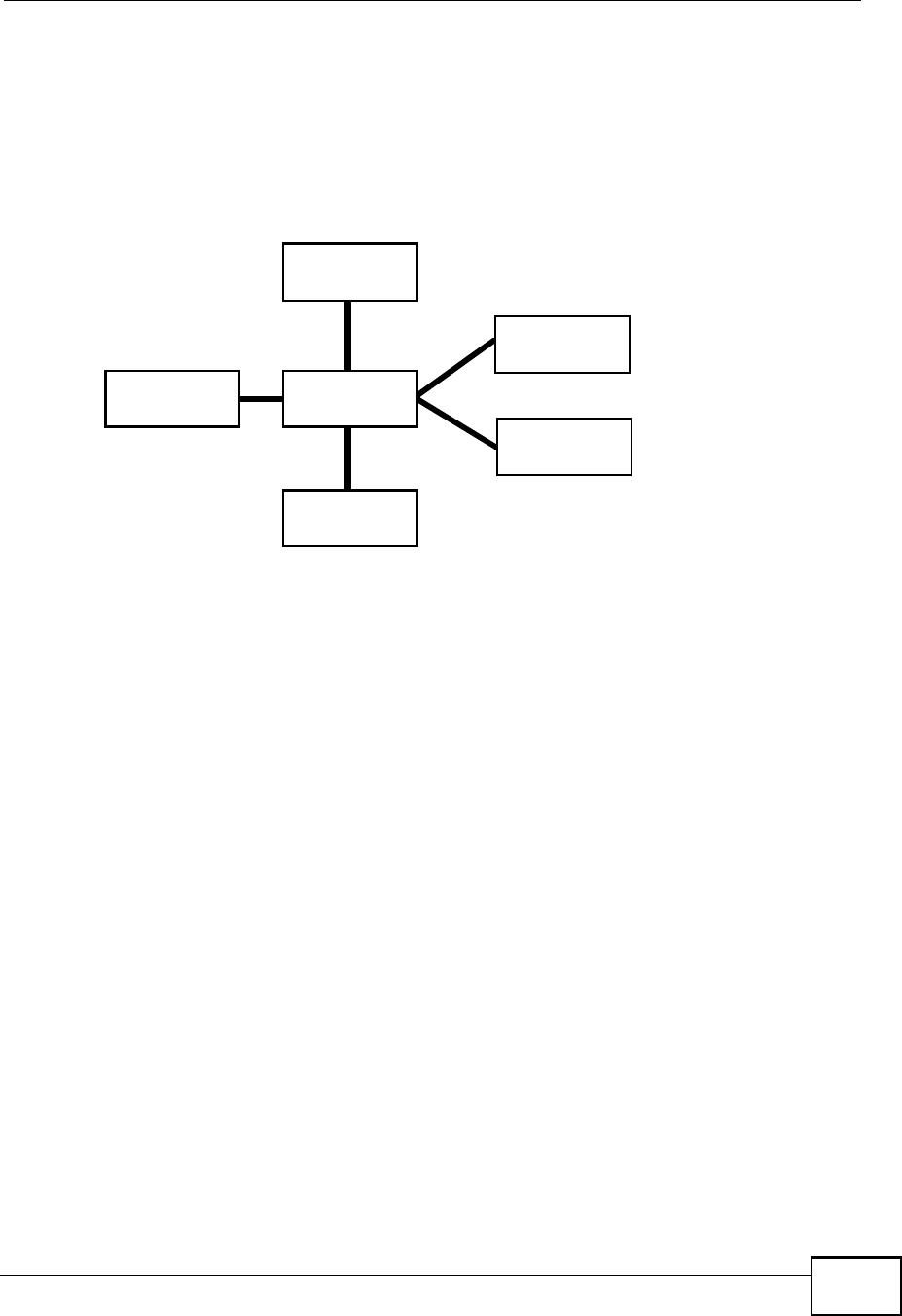
Chapter 9Maintenance
MAX208M User s Guide 119
OMA-DM Data Model
Each device that conforms to the current OMA-DM standard has an identical data
structure embedded in its controlling firmware. This allows a similarly conforming
OMA-DM server to navigate the folder structure and to make file alterations where
appropriate or required.
Figure 51 OMA-DM Data Model
In the example data model shown here, the parent folders must conform to the
OMA-DM standard. The child folders, on the other hand, can be customized on an
individual basis. This allows the parent folders to all maintain a consistent URI
(Uniform Resource Indentifier) across all devices that meet the OMA-DM
standard s requirements.
For example, in the preceding figure the URI for the "Games# folder is "./Vendor/
Games/#. The "./Vendor/# portion of the URI exists on all devices that conform to
the OMA-DM standard. The "Games# folder, however, may or may not exist
depending on the services provided by the company managing the device.
Daytime
A network protocol used by devices for debugging and time measurement. A
computer can use this protocol to set its internal clock but only if it knows in which
order the year, month, and day are returned by the server. Not all servers use the
same format.
Time
A network protocol for retrieving the current time from a server. The computer
issuing the command compares the time on its clock to the information returned
by the server, adjusts itself automatically for time zone differences, then
calculates the difference and corrects itself if there has been any temporal drift.
Root Folder
./
DMAcc
Vendor
Operator
MP3s
Games
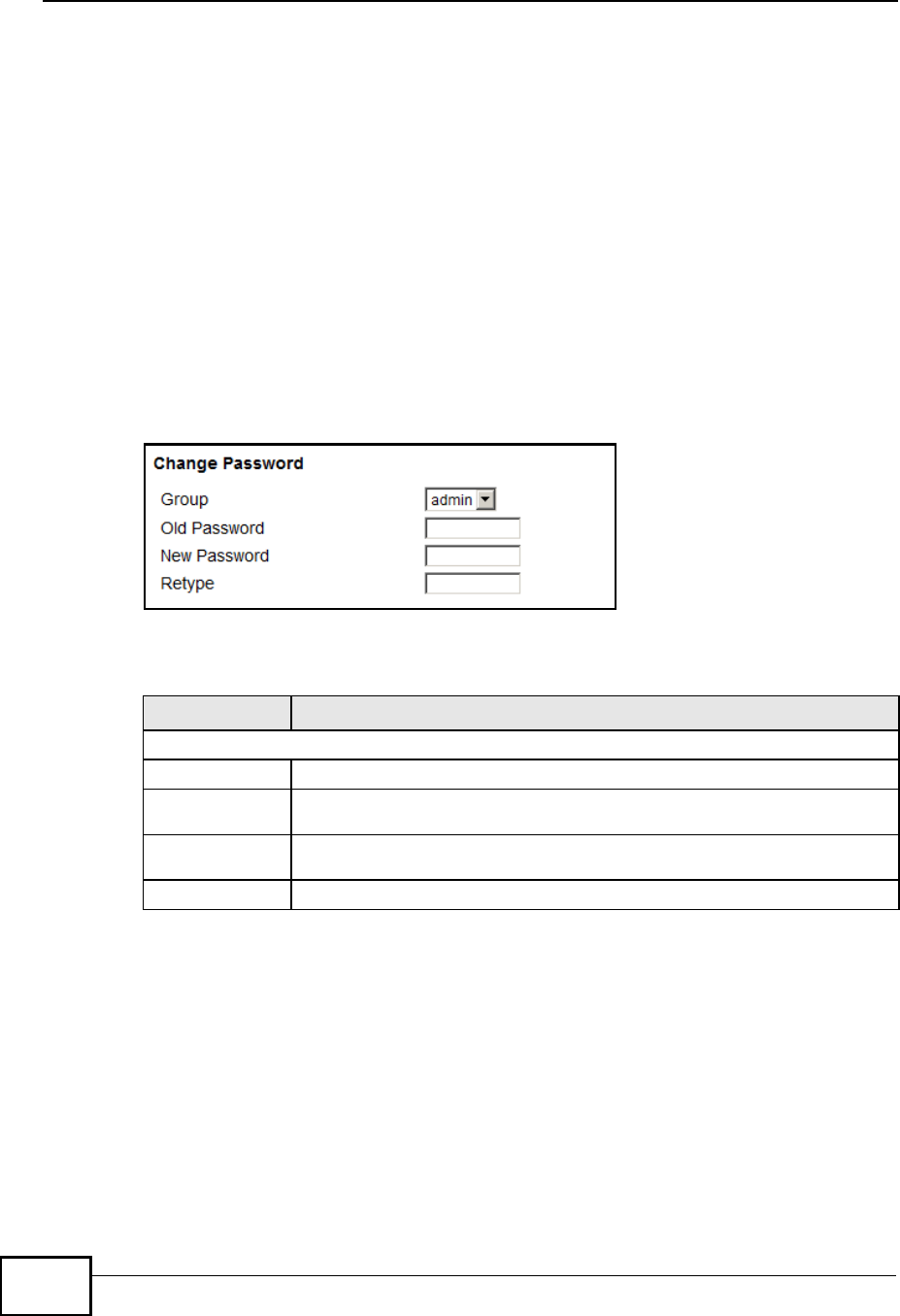
Chapter 9Maintenance
MAX208M User s Guide
120
NTP
NTP stands for Network Time Protocol. It is employed by devices connected to the
Internet in order to obtain a precise time setting from an official time server.
These time servers are accurate to within 200 microseconds.
9.2 Password
Use this screen to set up user and admin accounts for logging into and managing
the WiMAX Device.
Click Maintenance > Password to open this screen as shown next.
Figure 52 Password Screen
This screen contains the following fields:
Table 41 Password
LABEL DESCRIPTION
Change Password
GroupSelect the group for which you want to change the login password.
Old
Password
Enter the old password for the login group.
New
Password
Enter the new password for the login group.
RetypeRetype the new password for the login group.
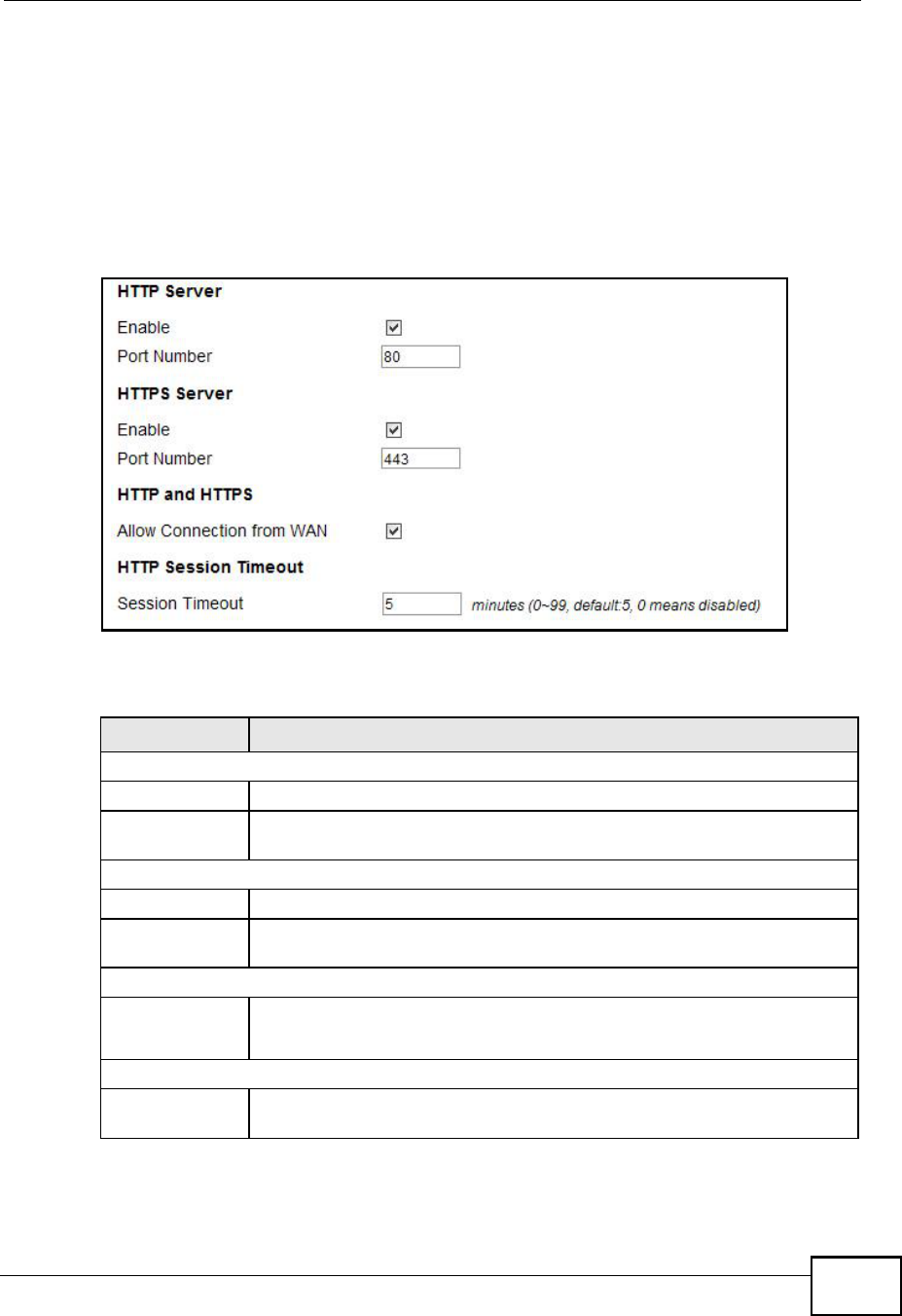
Chapter 9Maintenance
MAX208M User s Guide 121
9.3 HTTP
Use this screen to allow remote access to the WiMAX Device from a network
connection over HTTP.
Click Maintenance > Remote MGMT > HTTP to open this screen as shown
next.
Figure 53 HTTP Screen
This screen contains the following fields:
Table 42 HTTP
LABEL DESCRIPTION
HTTP Server
EnableSelect this to enable remote management using this service.
Port NumberEnter the port number this service can use to access the WiMAX Device.
The computer must use the same port number.
HTTPS Server
EnableSelect this to enable remote management using this service.
Port NumberEnter the port number this service can use to access the WiMAX Device.
The computer must use the same port number.
HTTP and HTTPS
Allow
Connection
from WAN
Select this to allow incoming connections from the WAN over either
HTTP or HTTPS.
HTTP Session Timeout
Session
Timeout
Enter the number of minutes (0-99) the WiMAX Device waits to delete
an inactive web connection (HTTP or HTTPS).
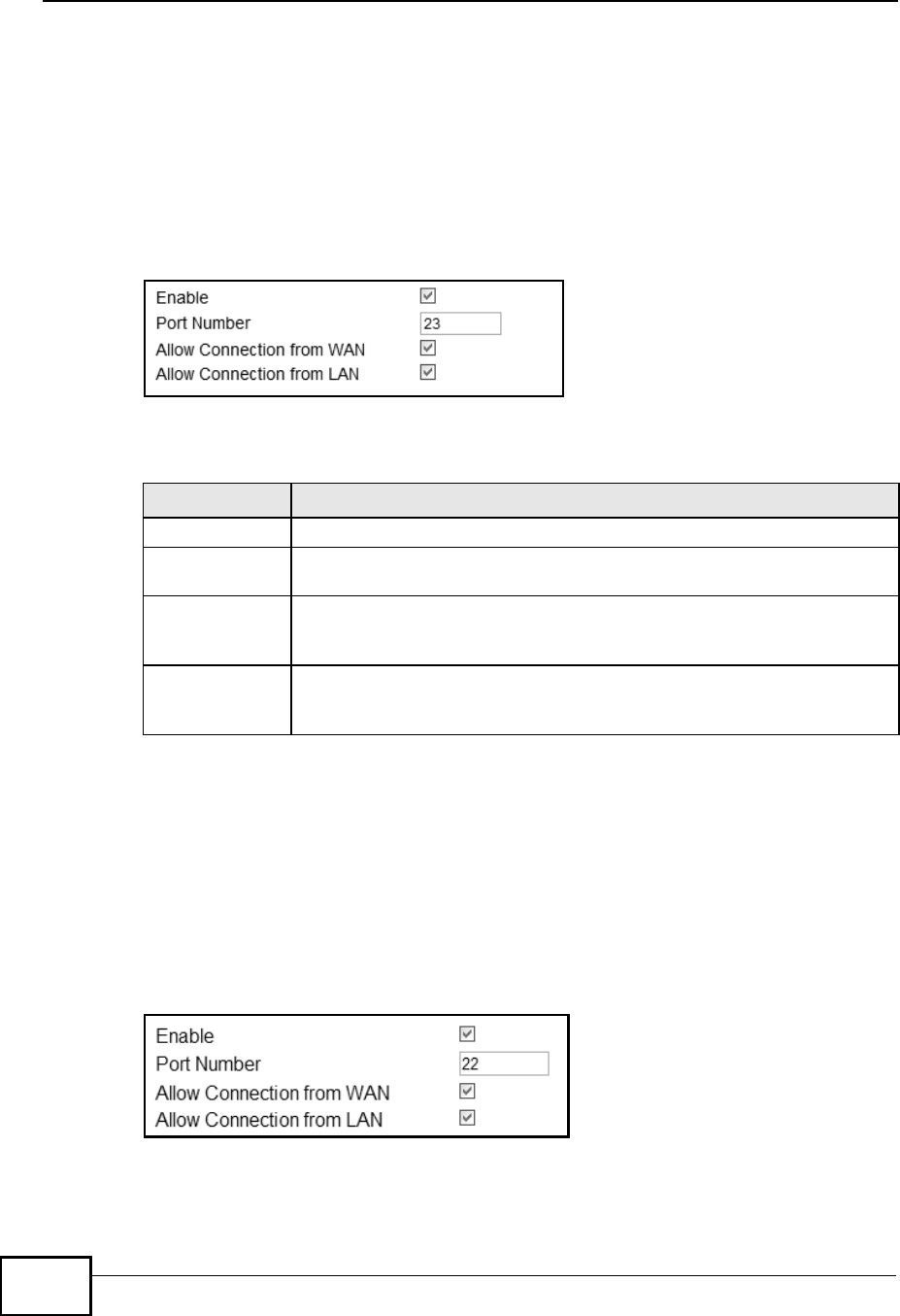
Chapter 9Maintenance
MAX208M User s Guide
122
9.4 Telnet
Use this screen to allow remote access to the WiMAX Device from a network
connection over Telnet.
Click Maintenance > Remote MGMT > Telnet to open this screen as shown
next.
Figure 54 Telnet Screen
This screen contains the following fields:
9.5 SSH
Use this screen to allow remote access to the WiMAX Device from a network
connection over SSH.
Click Maintenance > Remote MGMT > SSH to open this screen as shown next.
Figure 55 SSH Screen
Table 43 Telnet
LABEL DESCRIPTION
EnableSelect this to enable remote management using this service.
Port NumberEnter the port number this service can use to access the WiMAX Device.
The computer must use the same port number.
Allow
Connection
from WAN
Select this to allow connections using this service that originate on the
WAN.
Allow
Connection
from LAN
Select this to allow connection using this service that originate on the
LAN.
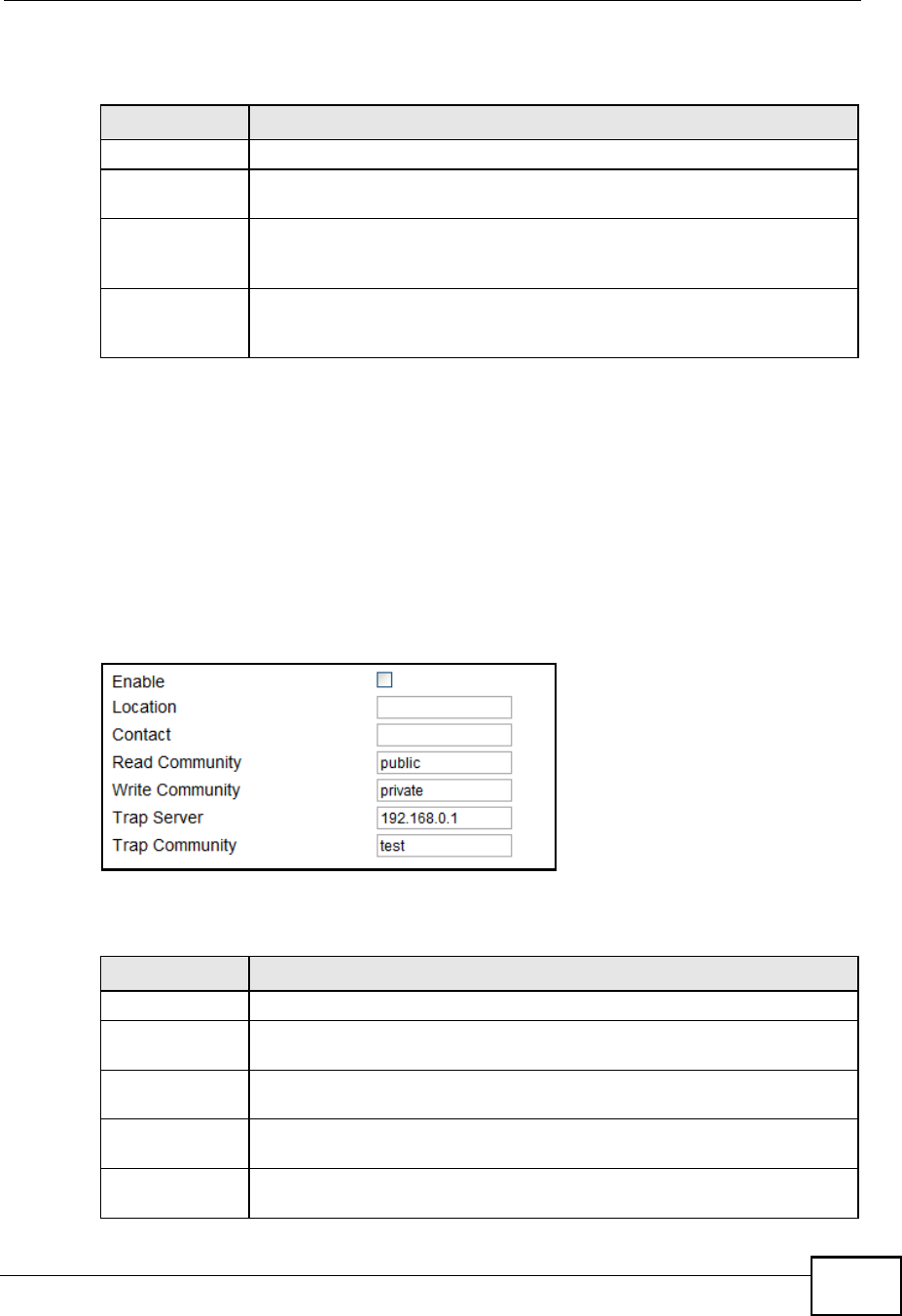
Chapter 9Maintenance
MAX208M User s Guide 123
This screen contains the following fields:
9.6 SNMP
Use this screen to allow remote access to the WiMAX Device from a network
connection over SNMP.
Click Maintenance > Remote MGMT > SNMP to open this screen as shown
next.
Figure 56 SNMP Screen
This screen contains the following fields:
Table 44 SSH
LABEL DESCRIPTION
EnableSelect this to enable remote management using this service.
Port NumberEnter the port number this service can use to access the WiMAX Device.
The computer must use the same port number.
Allow
Connection
from WAN
Select this to allow connections using this service that originate on the
WAN.
Allow
Connection
from LAN
Select this to allow connection using this service that originate on the
LAN.
Table 45 SNMP
LABEL DESCRIPTION
EnableSelect this to enable remote management using this service.
LocationEnter the location of the SNMP server (for example, "Engineering Dept.,
Floor 6, Building A, New York City#).
ContactEnter contact information for the administrator managing the SNMP
server (for example, "Bill Smith, IT Dept., (555) 555-5454#).
Read
Community
Enter the password for the incoming Get and GetNext requests from the
management station. The default is public and allows all requests.
Write
Community
Enter the password for incoming Set requests from the management
station. The default is public and allows all requests.
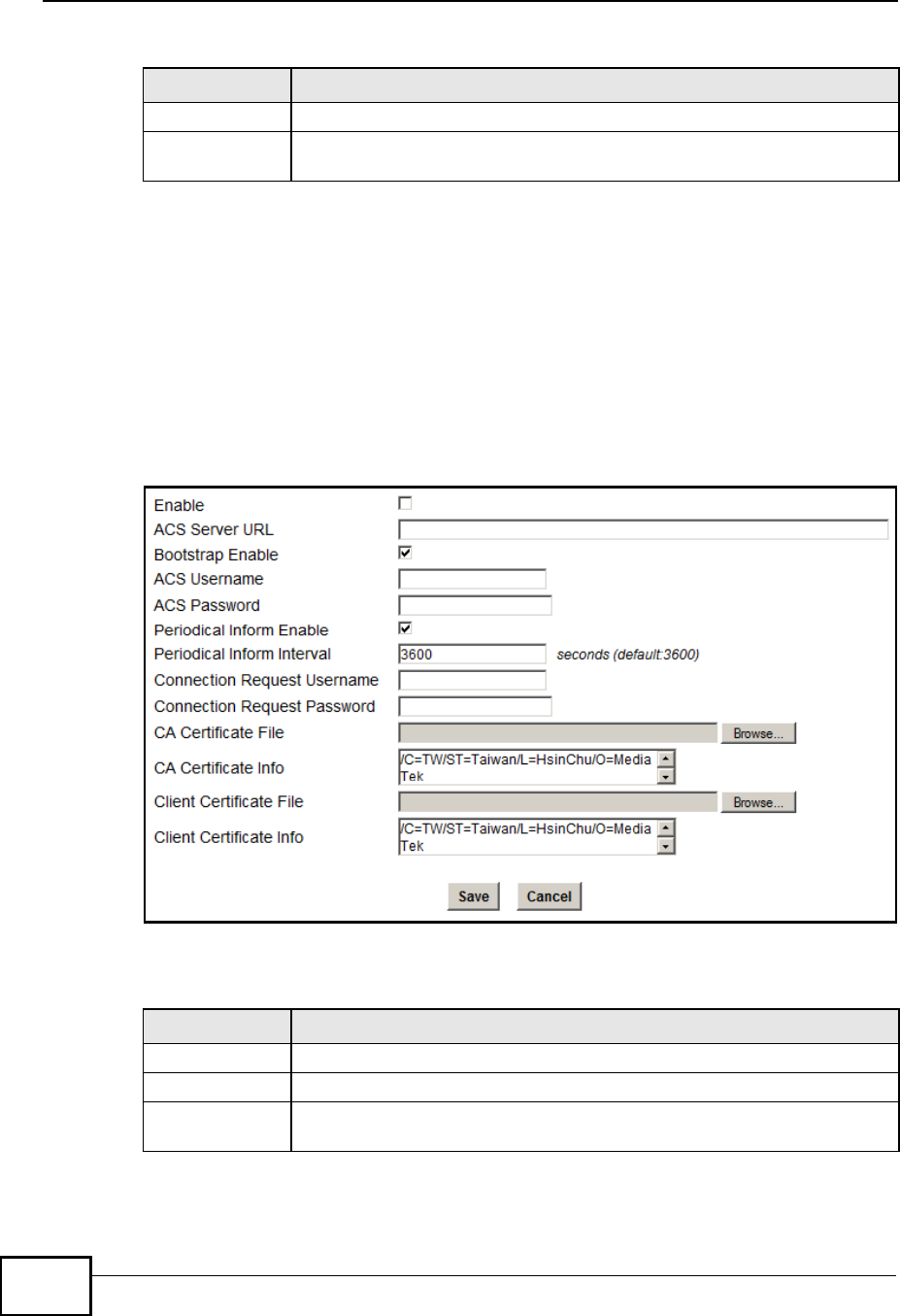
Chapter 9Maintenance
MAX208M User s Guide
124
9.7 CWMP
Use this screen to allow CWMP connections for remote management, firmware
upgrades and troubleshooting.
Click Maintenance > Remote MGMT > CWMP to open this screen as shown
next.
Figure 57 CWMP Screen
This screen contains the following fields:
Trap Server Enter the IP address of the station to send your SNMP traps to.
Trap
Community
Enter the trap community, which is the password sent with each trap to
the SNMP manager. The default is public and allows all requests.
Table 45 SNMP (continued)
LABEL DESCRIPTION
Table 46 CWMP
LABEL DESCRIPTION
EnableSelect this to enable remote management using this service.
ACS Server URLEnter the URL or IP address of the auto-configuration server.
Bootstrap
Enable
Select this to enable bootstrap events.

Chapter 9Maintenance
MAX208M User s Guide 125
ACS Username Enter the user name sent when the WiMAX Device connects to the ACS
and which is used for authentication.
You can enter up to 31 alphanumeric characters (a-z, A-Z, 0-9) and
underscores but spaces are not allowed.
ACS Password Enter the password sent when the WiMAX Device connects to an ACS
and which is used for authentication.
You can enter up to 31 alphanumeric characters (a-z, A-Z, 0-9) and
underscores but spaces are not allowed.
Perodical
Inform Enable
Select this to allow the WiMAX Device to periodically connect to the ACS
and check for configuration updates.
If you do not enable this feature then the WiMAX Device can only be
updated automatically when the ACS initiates contact with it and if you
selected the checkbox on this screen.
Periodical
Inform Interval
Enter the time interval (in seconds) at which the WiMAX Device
connects to the auto-configuration server.
Connection
Request
Username
Enter the connection request user name that the ACS must send to the
WiMAX Device when it requests a connection.
You can enter up to 31 alphanumeric characters (a-z, A-Z, 0-9) and
underscores but spaces are not allowed.
Note: This must be provided by the ACS administrator.
Connection
Request
Password
Enter the connection request password that the ACS must send to the
WiMAX Device when it requests a connection.
You can enter up to 31 alphanumeric characters (a-z, A-Z, 0-9) and
underscores but spaces are not allowed.
Note: This must be provided by the ACS administrator.
CA Certificate
File
Click Browse to upload a Certificate Authority (CA) certificate to the
WiMAX Device.
CA Certificate
Info
This displays information about the currently active CA certificate.
Client
Certificate File
Click Browse to upload a client certificate to the WiMAX Device.
Client
Certificate Info
This displays information about the currently active client certificate.
Table 46 CWMP (continued)
LABEL DESCRIPTION
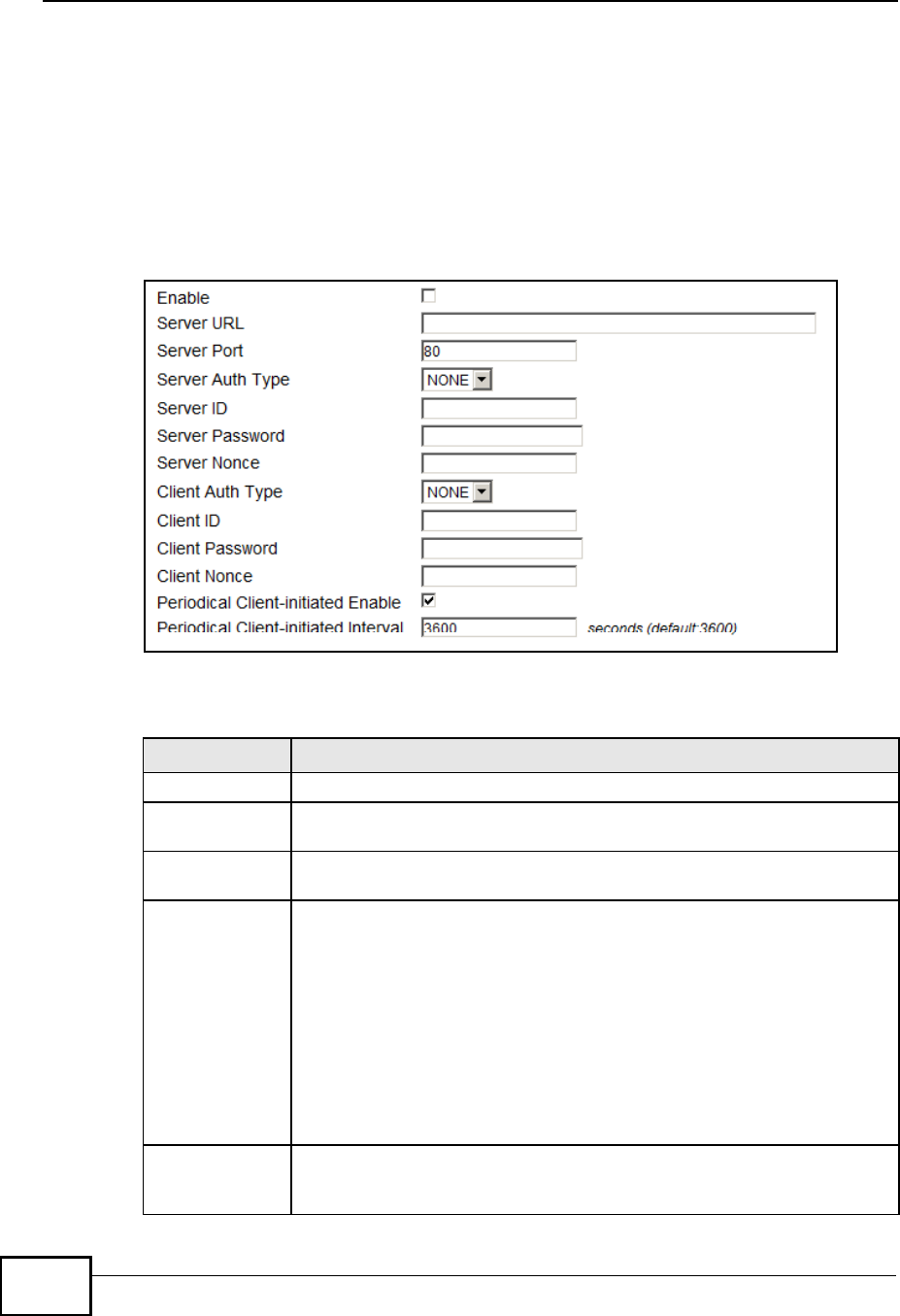
Chapter 9Maintenance
MAX208M User s Guide
126
9.8 OMA-DM
Use this screen to allow remote access to the WiMAX Device from a network
connection over OMA-DM.
Click Maintenance > Remote MGMT > OMA-DM to open this screen as shown
next.
Figure 58 OMA-DM Screen
This screen contains the following fields:
Table 47 OMA-DM
LABEL DESCRIPTION
EnableSelect this to enable remote management using this service.
Server URL Enter the IP address or URL of the OMA-DM server that you intend to
use to manage this device.
Server PortEnter the port number for the IP address of the OMA-DM server set up
in the preceding field.
Server Auth
Type
Select the encryption algorithm scheme used by the OMA-DM server to
communicate with client devices. If the scheme selected here does not
match the actual scheme used by the server, then server will challenge
the WiMAX Device to automatically update its settings.
!None - No authentication.
!Basic - Server ID and Password are encoded using a Basic Access
Authentication Code.
!Digest (MD5) - Server ID and Password are encoded using a Digest
Access Authentication Code.
!HMAC - Server ID and Password are encoded using a keyed Hash
Message Authentication Code.
Server ID Enter the identification code for the server. This is used by the WiMAX
Device during the communication handshake process to identify the
server.

Chapter 9Maintenance
MAX208M User s Guide 127
Server
Password
Enter the password for the server s identification code. This shared
public key is used by the WiMAX Device during the communication
handshake process to identify the server.
Server Nonce The WiMAX Device and the OMA-DM server use nonces to authenticate
each other if you select MD5 as the authentication algorithm in the
Server Auth Type field. Nonce is an abbreviation of 'number used
once'. It is normally a random or pseudo-random number applied in an
authentication protocol to protect existing communications from being
reused in %replay attacks .
Type up to 20 digits for the OMA-DM server nonce.
Client Auth
Type
Select the encryption algorithm scheme used by the OMA-DM server to
communicate with client devices. If the scheme selected here does not
match the actual scheme used by the server, then server will challenge
the WiMAX Device to automatically update its settings.
!None - No authentication.
!Basic - Server ID and Password are encoded using a Basic Access
Authentication Code.
!Digest (MD5) - Server ID and Password are encoded using a Digest
Access Authentication Code.
!HMAC - Server ID and Password are encoded using a keyed Hash
Message Authentication Code.
Note: Make sure that the scheme selected here matches the the
Server Auth Type.
Client ID Enter the client name for the WiMAX Device.
Client Password Enter the password for the WiMAX Device s client name.
Perodical Client-
Initiated Enable
Select this to allow the WiMAX Device to periodically connect to the
OMA-DM server and check for configuration updates.
If you do not enable this feature then the WiMAX Device can only be
updated automatically when the OM-DM server initiates contact with it
and if you selected the checkbox on this screen.
Periodical
Client-Initiated
Interval
Enter the time interval (in seconds) at which the WiMAX Device
connects to the OMA-DM server.
Table 47 OMA-DM (continued)
LABEL DESCRIPTION
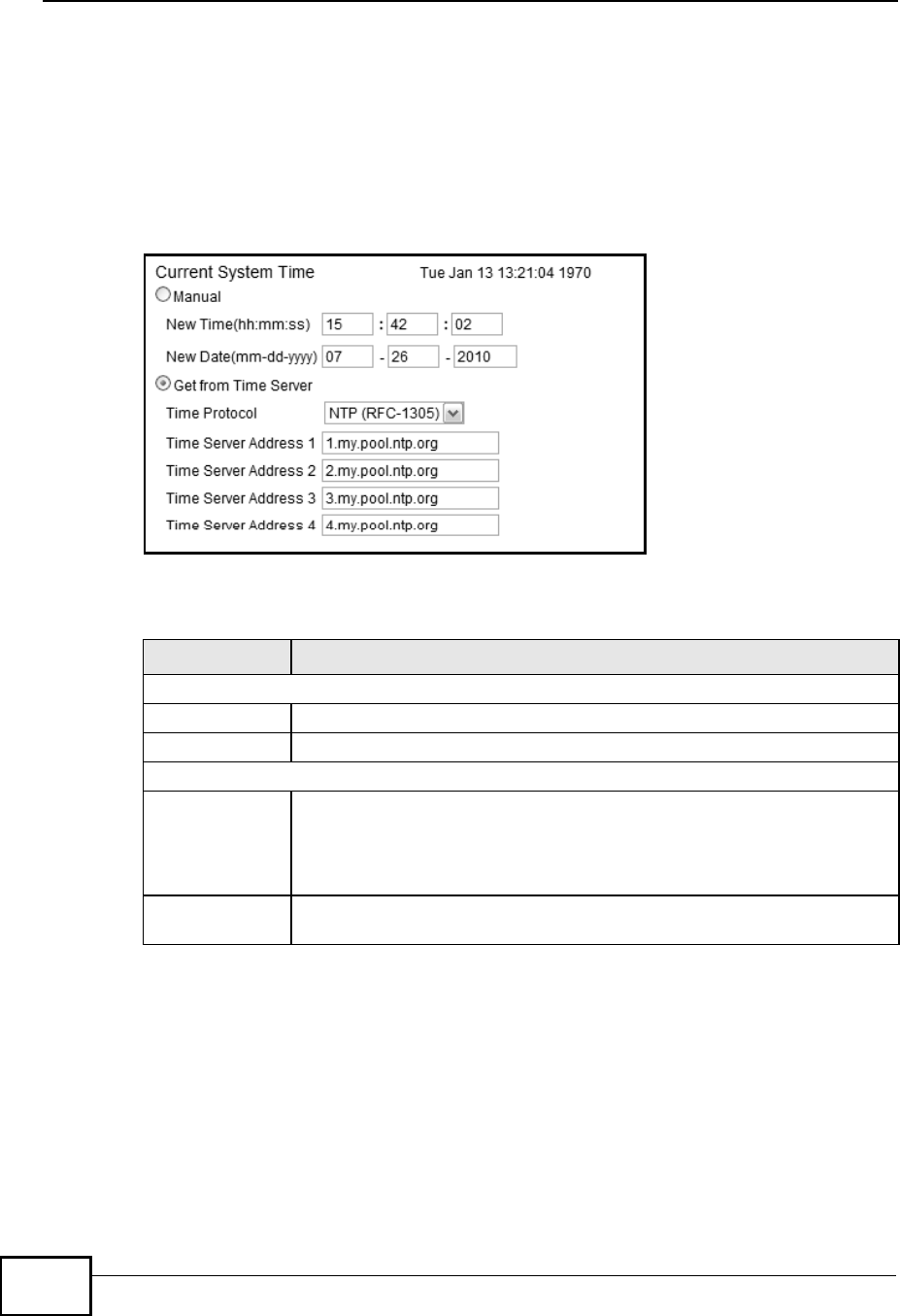
Chapter 9Maintenance
MAX208M User s Guide
128
9.9 Date
Use these settings to set the system time or configure an NTP server for automatic
time synchronization.
Click Maintenance > Date/Time > Date to open this screen as shown next.
Figure 59 Date Screen
This screen contains the following fields:
Table 48 Date
LABEL DESCRIPTION
Manual
New Time Enter the new time in this field.
New Date Enter the new date in this field.
Get from Time Server
Time
Protocol
Select the time service protocol that your time server uses. Check with
your ISP or network administrator, or use trial-and-error to find a
protocol that works.
!NTP (RFC 1305) - This format is similar to Time (RFC 868).
Time Server
Address 1~4
Enter the IP address or URL of your time server. Check with your ISP or
network administrator if you are unsure of this information.
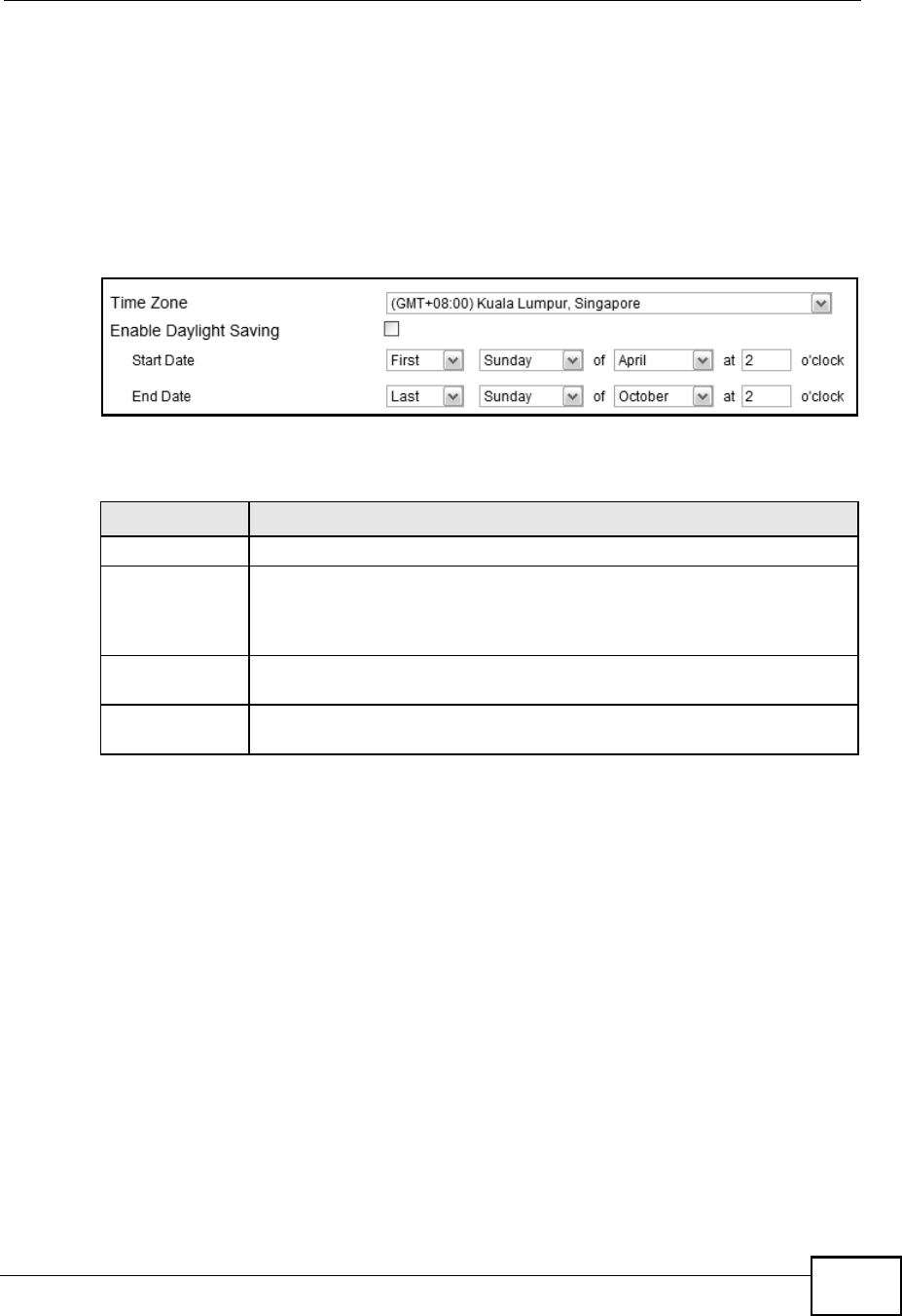
Chapter 9Maintenance
MAX208M User s Guide 129
9.10 Time Zone
Use this screen to set the time zone in which the WiMAX device is physically
located.
Click Maintenance > Date/Time > Time Zone to open this screen as shown
next.
Figure 60 Time Zone Screen
This screen contains the following fields:
9.11 Upgrade File
Use this screen to browse to a firmware file on a local computer and upload it to
the WiMAX Device. Firmware files usually use the system model name with a
"*.bin" extension, such as "WiMAX Device.bin". The upload process uses HTTP
(Hypertext Transfer Protocol) and may take up to two minutes. After a successful
upload, the system restarts.
Contact your service provider for information on available firmware upgrades.
Note: Only use firmware for your WiMAX Device s specific model.
Table 49 Time Zone
LABEL DESCRIPTION
Time ZoneSelect the time zone at your location.
Enable Daylight
Savings Time
Select this if your location uses daylight savings time. Daylight savings
is a period from late spring to early fall when many places set their
clocks ahead of normal local time by one hour to give more daytime
light in the evening.
Start DateEnter which hour on which day of which week of which month daylight-
savings time starts.
End DateEnter which hour on the which day of which week of which month
daylight-savings time ends.
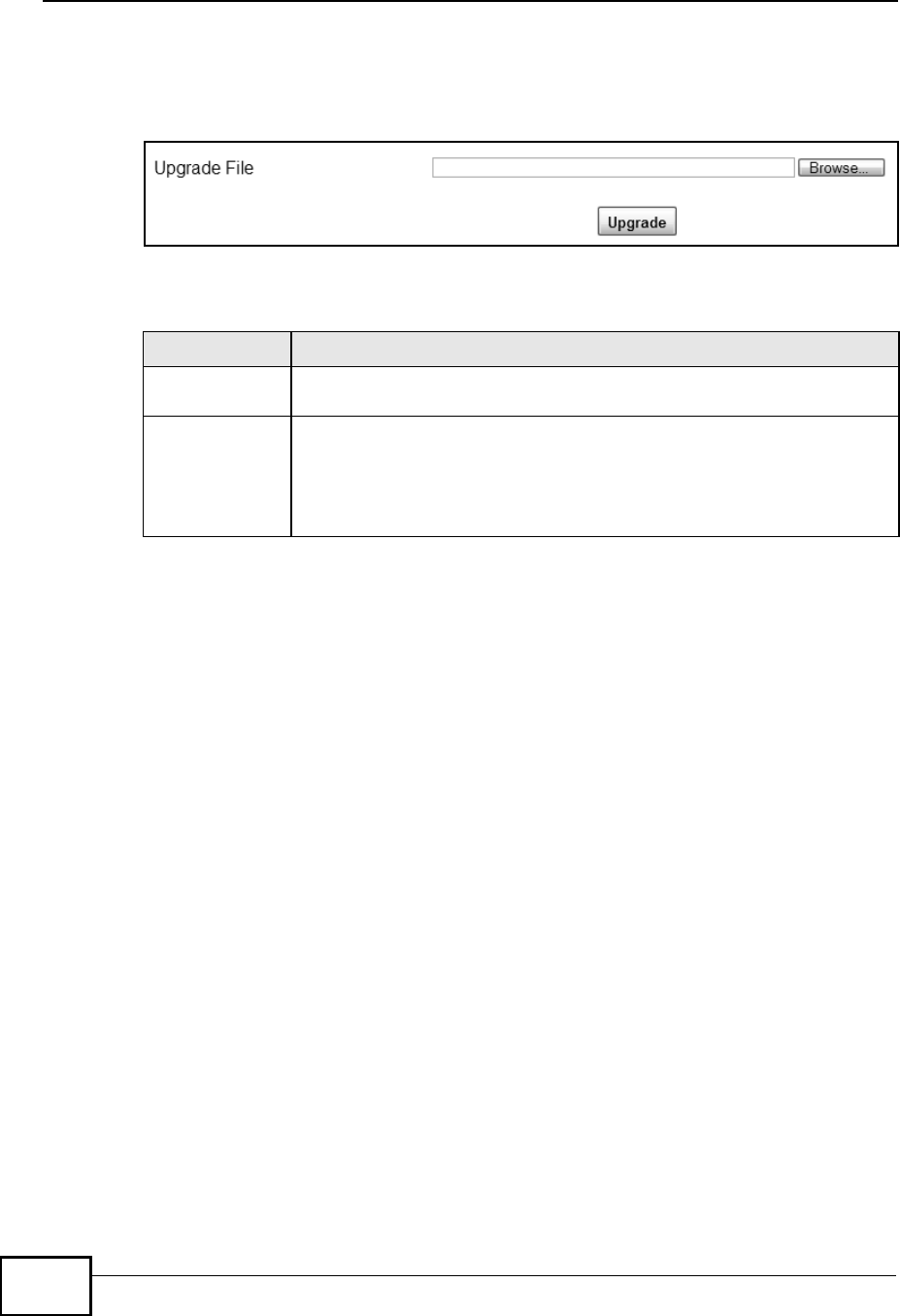
Chapter 9Maintenance
MAX208M User s Guide
130
Click Maintenance > Firmware Upgrade > Upgrade File to open this screen
as shown next.
Figure 61 Upgrade File Screen
This screen contains the following fields:
9.11.1 The Firmware Upload Process
When the WiMAX Device uploads new firmware, the process usually takes about
two minutes. The device also automatically restarts in this time. This causes a
temporary network disconnect.
Note: Do not turn off the device while firmware upload is in progress!
After two minutes, log in again, and check your new firmware version in the
Status screen. You might have to open a new browser window to log in.
If the upload is not successful, you will be notified by error message.
Table 50 Upgrade File
LABEL DESCRIPTION
Upgrade FileClick Browse then browse to the location of a firmware upgrade file
and select it.
Upgrade Click this to begin uploading the selected file. This may take up to two
minutes.
Note: Do not turn off the device while firmware upload is in
progress!
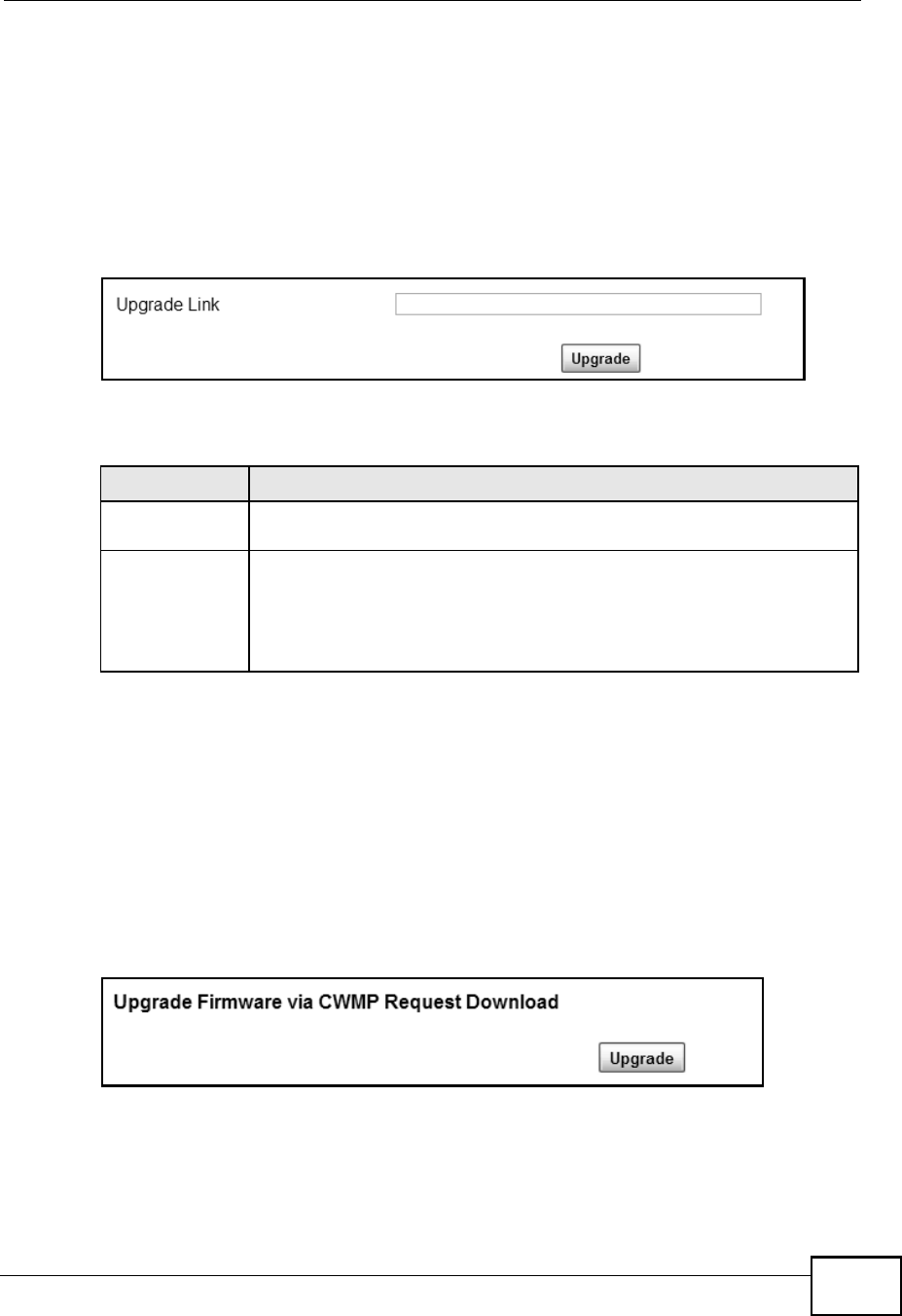
Chapter 9Maintenance
MAX208M User s Guide 131
9.12 Upgrade Link
Use this screen to set the URL of a firmware file on a remote computer and upload
it to the WiMAX Device.
Click Maintenance > Firmware Upgrade > Upgrade Link to open this screen
as shown next.
Figure 62 Upgrade Link Screen
This screen contains the following fields:
9.13 CWMP Upgrade
Use this screen to upgrade the firmware on the WiMAX Device using CWMP
Request Download.
Click Maintenance > Firmware Upgrade > CWMP Upgrade to open this
screen as shown next.
Figure 63 CWMP Upgrade Screen
Table 51 Upgrade Link
LABEL DESCRIPTION
Upgrade LinkEnter the URL or IP address of the firmware s upgrade location on the
network.
Upgrade Click this to begin uploading the selected file. This may take up to two
minutes.
Note: Do not turn off the device while firmware upload is in
progress!
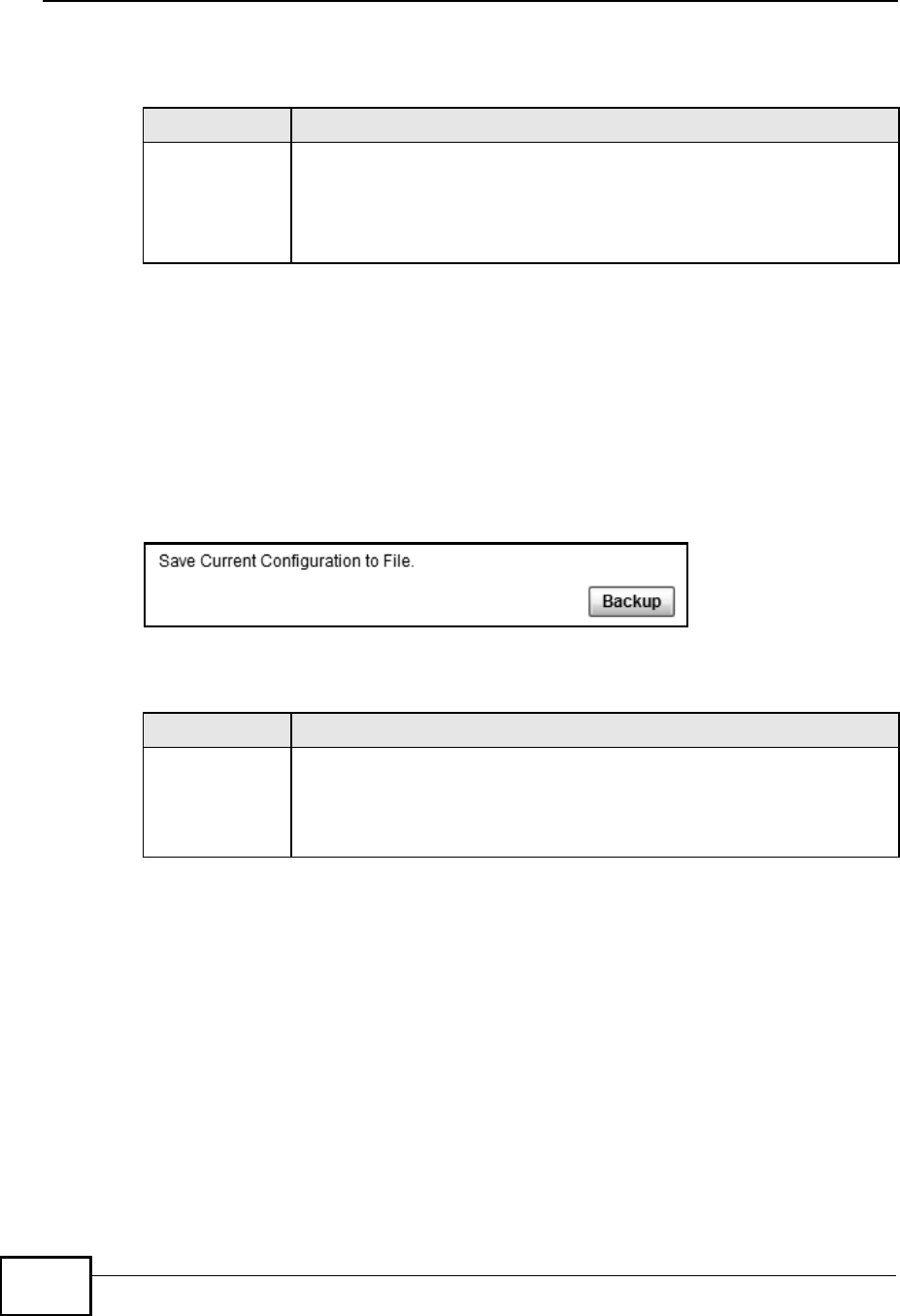
Chapter 9Maintenance
MAX208M User s Guide
132
This screen contains the following fields:
9.14 Backup
Use this screen to backup your current WiMAX Device settings to a local computer.
Click Maintenance > Backup/Restore > Backup to open this screen as shown
next.
Figure 64 Backup/Restore Screen
This screen contains the following fields:
Table 52 CWMP Upgrade
LABEL DESCRIPTION
Upgrade Click this to begin upgrading firmware using CWMP Request. This may
take up to two minutes.
Note: Do not turn off the device while firmware upload is in
progress!
Table 53 Backup/Restore
LABEL DESCRIPTION
BackupClick this to save the WiMAX Device s current configuration to a file on
your computer. Once your device is configured and functioning properly,
it is highly recommended that you back up your configuration file before
making configuration changes. The backup configuration file is useful if
you need to return to your previous settings.
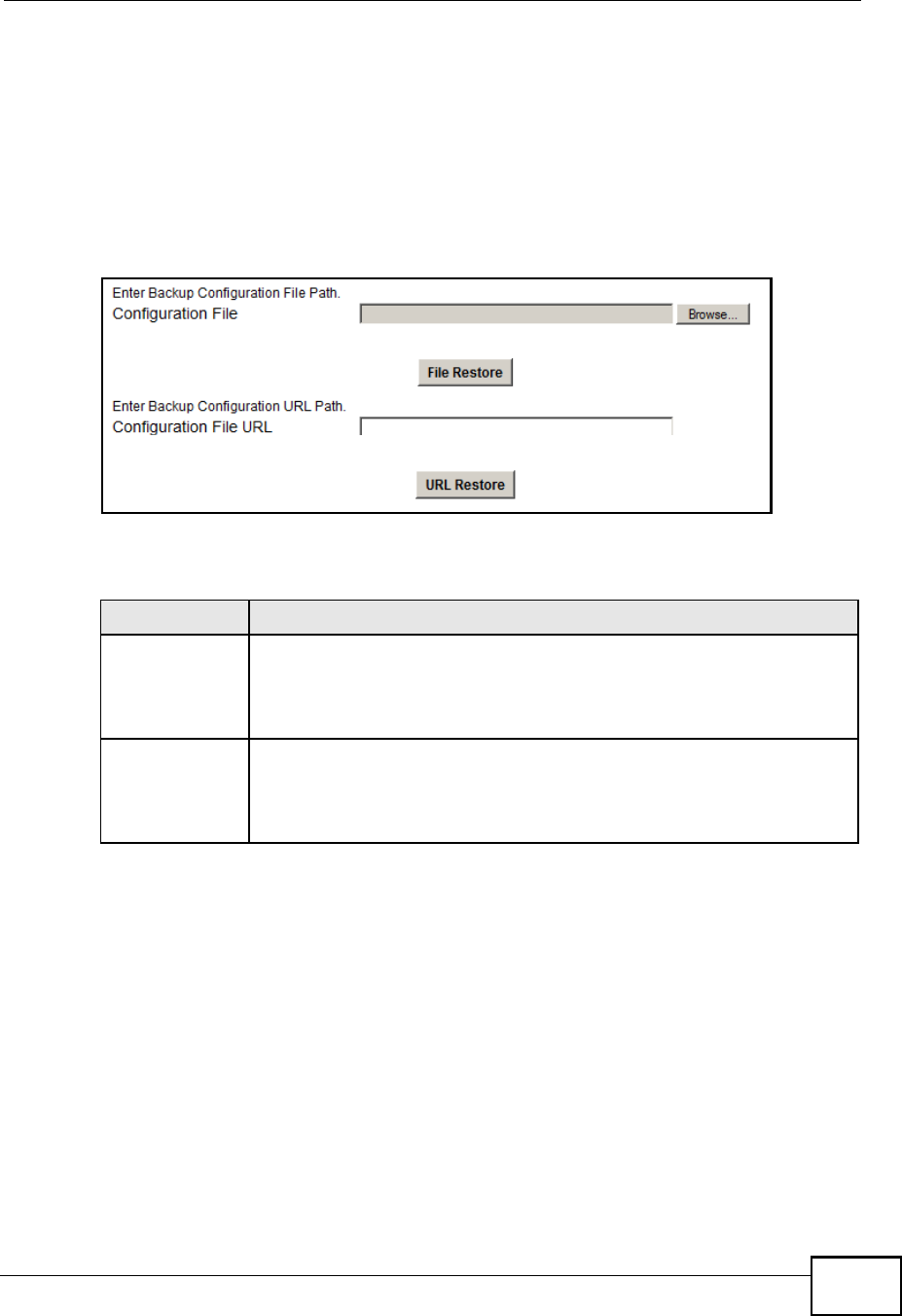
Chapter 9Maintenance
MAX208M User s Guide 133
9.15 Restore
Use this screen to restore your WiMAX Device settings from a backup file on a
local computer.
Click Maintenance > Backup/Restore > Restore to open this screen as shown
next.
Figure 65 Restore Screen
This screen contains the following fields:
9.15.1 The Restore Configuration Process
When the WiMAX Device restores a configuration file, the device automatically
restarts. This causes a temporary network disconnect.
Note: Do not turn off the device while configuration file upload is in progress.
If the WiMAX Device s IP address is different in the configuration file you selected,
you may need to change the IP address of your computer to be in the same
subnet as that of the default management IP address (192.168.5.1). See the
Quick Start Guide or the appendices for details on how to set up your computer s
IP address.
Table 54 Restore
LABEL DESCRIPTION
Configuration
File
Click Browse then navigate to the location of a firmware upgrade file
and select it.
Click File Restore to upload the specified configuration to the WiMAX
Device and replace the current settings.
Backup
Configuration
File URL
Enter the URL or IP address of the backup configuration file s location
on the network.
Click URL Restore to upload the specified configuration to the WiMAX
Device and replace the current settings.
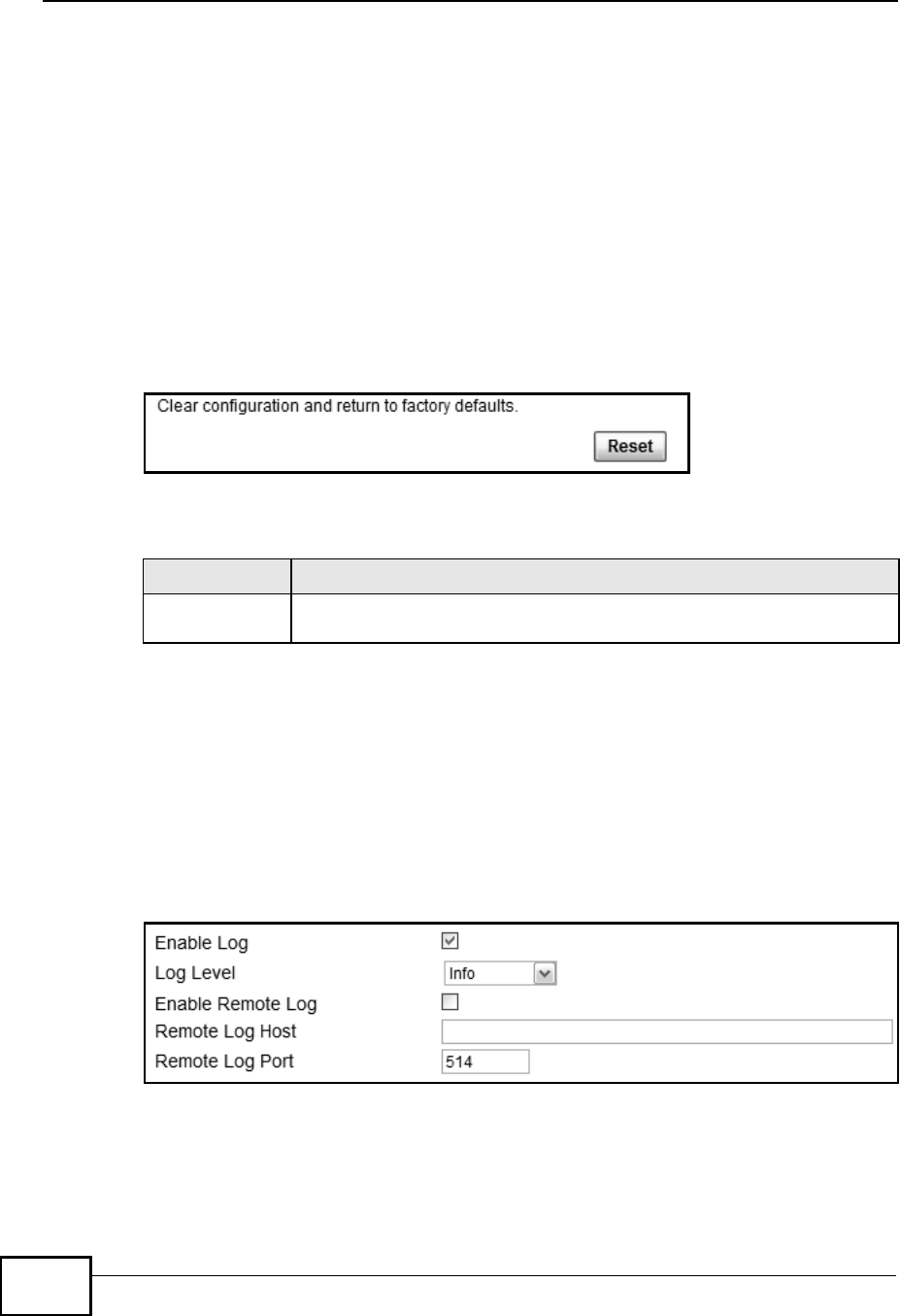
Chapter 9Maintenance
MAX208M User s Guide
134
You might have to open a new browser to log in again.
If the upload was not successful, you are notified with an error message.
9.16 Factory Defaults
Use this screen to restore the WiMAX Device to its factory default settings.
Click Maintenance > Backup/Restore > Factory Defaults to open this screen
as shown next.
Figure 66 Factory Defaults Screen
This screen contains the following fields:
9.17 Log Setting
Use this screen to configure which type of events on the WiMAX Device are
logged.
Click Maintenance > Log > Log Setting to open this screen as shown next.
Figure 67 Log Setting Screen
Table 55 Factory Defaults
LABEL DESCRIPTION
Reset Click this to clear all user-entered configuration information and return
the WiMAX Device to its factory defaults. There is no warning screen.
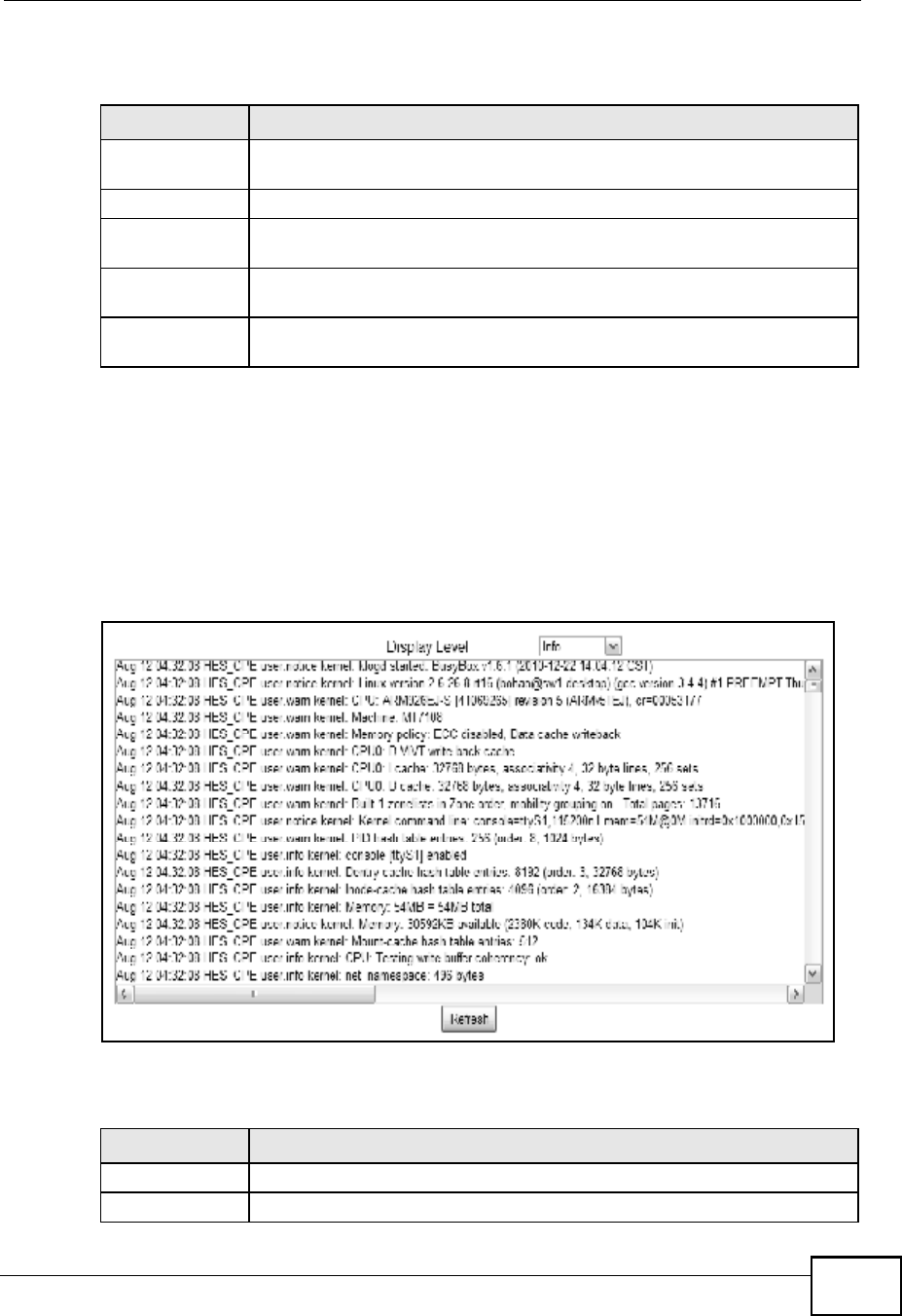
Chapter 9Maintenance
MAX208M User s Guide 135
This screen contains the following fields:
9.18 Log Display
Use this screen to view the log messages of the WiMAX Device.
Click Maintenance > Log > Log Display to open this screen as shown next.
Figure 68 Log Display Screen
This screen contains the following fields:
Table 56 Log Setting
LABEL DESCRIPTION
Enable LogSelect this to have the WiMAX Device log network activity according to
the selected Log Level.
Log LevelSelect the type of logs to record.
Enable Remote
Log
Select this to allow logs to be recorded and stored on a remote logs
server.
Remote Log
Host
Enter the remote log host IP address if Enable Remote Log is
selected.
Remote Log
Port
Enter the remote log host port if Enable Remote Log is selected.
Table 57 Log Display
LABEL DESCRIPTION
Display LevelSelect the type of logs to display from this menu.
RefreshClick this to refresh the logs in the display window.
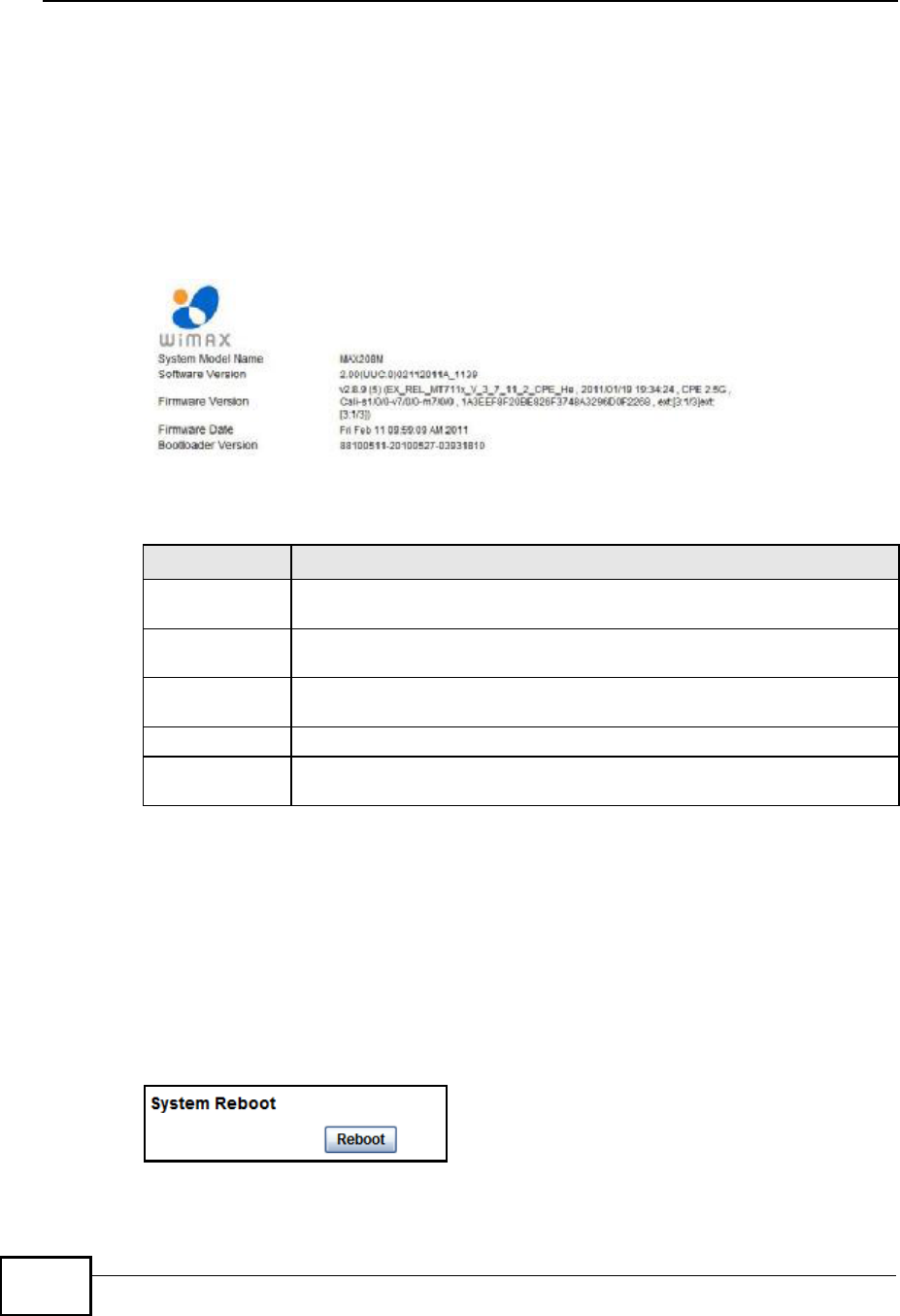
Chapter 9Maintenance
MAX208M User s Guide
136
9.19 About
This screen displays information about the WiMAX Device that can be useful when
upgrading firmware, considering deployment options, and working with technical
support if the device encounters difficulties.
Click Maintenance > About to open this screen as shown next.
Figure 69 About Screen
This screen contains the following fields:
9.20 Reboot
Use this screen to perform a software restart of the WiMAX Device. You may log in
again within a few minutes of using the reboot button.
Click Maintenance > Reboot to open this screen as shown next.
Figure 70 Reboot Screen
Table 58 About
LABEL DESCRIPTION
System Model
Name
This field displays the WiMAX Device system name. It is used for
identification.
Software
Version
This field displays the Web Configurator software version that the
WiMAX Device is currently running.
Firmware
Version
This field displays the current version of the firmware inside the device.
Firmware DateThis field displays the date the firmware version was created.
Bootloader
Version
This field displays the bootloader version.

Chapter 9Maintenance
MAX208M User s Guide 137
This screen contains the following fields:
Table 59 Reboot
LABEL DESCRIPTION
RebootClick this button to have the device perform a software restart. The
Power LED blinks as it restarts and the shines steadily if the restart is
successful.
Note: Wait one minute before logging back into the WiMAX Device
after a restart.

Chapter 9Maintenance
MAX208M User s Guide
138

MAX208M User s Guide 139
CHAPTER 10
Troubleshooting
This chapter offers some suggestions to solve problems you might encounter. The
potential problems are divided into the following categories:
!Power, Hardware Connections, and LEDs
!WiMAX Device Access and Login
!Internet Access
!Reset the WiMAX Device to Its Factory Defaults
10.1 Power, Hardware Connections, and LEDs
The WiMAX Device does not turn on. None of the LEDs turn on.
1Make sure you are using the power adapter or cord included with the WiMAX
Device.
2Make sure the power adapter or cord is connected to the WiMAX Device and
plugged in to an appropriate power source. Make sure the power source is turned
on.
3Disconnect and re-connect the power adapter or cord to the WiMAX Device.
4If the problem continues, contact the vendor.
One of the LEDs does not behave as expected.
1Make sure you understand the normal behavior of the LED. See Section 1.2.1 on
page 18 for more information.
2Check the hardware connections. See the Quick Start Guide.

Chapter 10Troubleshooting
MAX208M User s Guide
140
3Inspect your cables for damage. Contact the vendor to replace any damaged
cables.
4Disconnect and re-connect the power adapter to the WiMAX Device.
5If the problem continues, contact the vendor.
10.2 WiMAX Device Access and Login
I forgot the IP address for the WiMAX Device.
1See the cover page of this guide for the default IP address.
2If you changed the IP address and have forgotten it, you might get the IP address
of the WiMAX Device by looking up the IP address of the default gateway for your
computer. To do this in most Windows computers, click Start > Run, enter cmd,
and then enter ipconfig. The IP address of the Default Gateway might be the IP
address of the WiMAX Device (it depends on the network), so enter this IP address
in your Internet browser.
3If this does not work, you have to reset the WiMAX Device to its factory defaults.
See Section 10.4 on page 143.
I forgot the password.
1See the cover page of this guide for the default password.
2If this does not work, you have to reset the WiMAX Device to its factory defaults.
See Section 10.4 on page 143.
I cannot see or access the Login screen in the web configurator.
1Make sure you are using the correct IP address.
!See the cover page of this guide for the default IP address.
!If you changed the IP address (Section 7.6 on page 86), use the new IP
address.

Chapter 10Troubleshooting
MAX208M User s Guide 141
!If you changed the IP address and have forgotten it, see the troubleshooting
suggestions for I forgot the IP address for the WiMAX Device.
2Check the hardware connections, and make sure the LEDs are behaving as
expected. See the Quick Start Guide and Section 1.2.1 on page 18.
3Make sure your Internet browser does not block pop-up windows and has
JavaScript and Java enabled. See Appendix C on page 183.
4If there is a DHCP server on your network, make sure your computer is using a
dynamic IP address. Your WiMAX Device is a DHCP server by default.
If there is no DHCP server on your network, make sure your computer s IP
address is in the same subnet as the WiMAX Device. See Appendix D on page 193.
5Reset the WiMAX Device to its factory defaults, and try to access the WiMAX
Device with the default IP address. See Section 10.4 on page 143.
6If the problem continues, contact the network administrator or vendor, or try one
of the advanced suggestions.
Advanced Suggestions
!Try to access the WiMAX Device using another service, such as Telnet. If you can
access the WiMAX Device, check the remote management settings and firewall
rules to find out why the WiMAX Device does not respond to HTTP.
!If your computer is connected wirelessly, use a computer that is connected to a
LAN/ETHERNET port.
I can see the Login screen, but I cannot log in to the WiMAX Device.
1Make sure you have entered the user name and password correctly. See the cover
page of this guide for the default user name and password. These fields are case-
sensitive, so make sure [Caps Lock] is not on.
2You cannot log in to the web configurator while someone is using Telnet to access
the WiMAX Device. Log out of the WiMAX Device in the other session, or ask the
person who is logged in to log out.
3Disconnect and re-connect the power adapter or cord to the WiMAX Device.
4If this does not work, you have to reset the WiMAX Device to its factory defaults.
See Section 10.4 on page 143.

Chapter 10Troubleshooting
MAX208M User s Guide
142
I cannot Telnet to the WiMAX Device.
See the troubleshooting suggestions for I cannot see or access the Login screen in
the web configurator. Ignore the suggestions about your browser.
10.3 Internet Access
I cannot access the Internet.
1Check the hardware connections, and make sure the LEDs are behaving as
expected. See the Quick Start Guide and Section 1.2.1 on page 18.
2Make sure you entered your ISP account information correctly in the wizard. These
fields are case-sensitive, so make sure [Caps Lock] is not on.
3Check your security settings. See Chapter 8 on page 107.
4Check your WiMAX settings. The WiMAX Device may have been set to search the
wrong frequencies for a wireless connection. See Chapter 6 on page 57. If you are
unsure of the correct values, contact your service provider.
5If you are trying to access the Internet wirelessly, make sure the wireless settings
in the wireless client are the same as the settings in the AP.
6Disconnect all the cables from your WiMAX Device, and follow the directions in the
Quick Start Guide again.
7If the problem continues, contact your ISP.
I cannot access the Internet any more. I had access to the Internet (with the
WiMAX Device), but my Internet connection is not available any more.
1Check the hardware connections, and make sure the LEDs are behaving as
expected. See the Quick Start Guide and Section 1.2.1 on page 18.
2Disconnect and re-connect the power adapter to the WiMAX Device.

Chapter 10Troubleshooting
MAX208M User s Guide 143
3If the problem continues, contact your ISP.
The Internet connection is slow or intermittent.
1The quality of the WiMAX Device s wireless connection to the base station may be
poor. Poor signal reception may be improved by moving the WiMAX Device away
from thick walls and other obstructions, or to a higher floor in your building.
2There may be radio interference caused by nearby electrical devices such as
microwave ovens and radio transmitters. Move the WiMAX Device away or switch
the other devices off. Weather conditions may also affect signal quality.
3There might be a lot of traffic on the network. Look at the LEDs, and check Section
1.2.1 on page 18. If the WiMAX Device is sending or receiving a lot of information,
try closing some programs that use the Internet, especially peer-to-peer
applications.
4Disconnect and re-connect the power adapter to the WiMAX Device.
5If the problem continues, contact the network administrator or vendor, or try one
of the advanced suggestions.
The Internet connection disconnects.
1Check your WiMAX link and signal strength using the Strength Indicator LEDs
on the device.
2Contact your ISP if the problem persists.
10.4 Reset the WiMAX Device to Its Factory
Defaults
If you reset the WiMAX Device, you lose all of the changes you have made. The
WiMAX Device re-loads its default settings, and the password resets to the default
(see the cover page of this guide). You have to make all of your changes again.
You will lose all of your changes when you push the Reset button.
To reset the WiMAX Device,

Chapter 10Troubleshooting
MAX208M User s Guide
144
1Make sure the Power LED is on and not blinking.
2Press and hold the Reset button for five to ten seconds. Release the Reset button
when the Power LED begins to blink. The default settings have been restored.
If the WiMAX Device restarts automatically, wait for the WiMAX Device to finish
restarting, and log in to the Web Configurator.
If the WiMAX Device does not restart automatically, disconnect and reconnect the
WiMAX Device s power. Then, follow the directions above again.
10.5 Pop-up Windows, JavaScript and Java
Permissions
Please see Appendix C on page 183.

MAX208M User s Guide 145
CHAPTER 11
Product Specifications
This chapter gives details about your WiMAX Device s hardware and firmware
features.
FEATURE DESCRIPTION
Operation Requirements !Storage conditions: $25°C to 55°C, 10% to 95%
humidity
!Operation conditions: 0°C to 45°C, 10% to 90%
humidity
!Operating Humidity: 10% to 95% RH
Power Supply Requirement !DC 12 V, 1A
LAN Port !RJ-45 Interface
!1 Port
!10/100BaseT
!AUTO MDI/MDIX
Reset Button / Restore to
Factory Default Button
!System Reset
!System configuration can be restored to factory
default if hold the Reset Button longer than 5 seconds
LAN Status LED (Green /
Yellow)
Green LED for 10M
!ON: Linked
!Blinking: Data transmitting
!OFF: Link off
Yellow LED for 100M
!ON: Linked
!Blinking: Data transmitting
!OFF: Link off
RSSI LED (Green)3 LED bar : LED 1~3 indicates RSSI
(Power level reception, only on when connected)
!LEDs 1, 2, 3 on: RSSI >= -69 dBm
!LEDs 1, 2 on: RSSI: -70~-79 dBm
!LED 1 on: RSSI: -80~-89 dBm
!All LED s off: no WiMAX connection

Chapter 11Product Specifications
MAX208M User s Guide
146
Antennna !Center Frequency: 2600 MHz
!Frequency Range: 2500 MHz~2700 MHz
!Bandwidth: 300 MHz
!Peak Gain: 6 dBi
!H-Plane Average Gain: 3.5 dBi
!VSWR: 2
!Polarization: Linear, Vertical
!H-Plane HPBW: 180°
!V-Plane HPBW: 25°
!Down tilt: 0°
!Impedance: 50
!Connector: Big SMA Straight Plus Reverse for RG-178
WiMAX complianceFully compliant with IEEE 802.16e Mobile WiMAX
corrigendum 1 & 2 and WiMAX Forum Wave 2 System
Profiles
Operating Frequency Band2.5GHz~2.7GHz
Certification ProfileSupport WF profiles: 1A, 2A, 3A, 5A, 5AL, 5BL (5MHz,
7MHz, 10MHz bandwidth)
Maximum nominal
Transmission Power
Maximum nominal Tx power at the antenna connector:
26dBm.
Transmitter Power ControlTransmit power control by step of 1dB, relative accuracy
of +/- 0.5dB (as per IEEE 802.16e-2005, §8.4.12.1).
Transmitter spectral flatnessTransmitter spectral flatness as defined in IEEE 802.16e-
2005, §8.4.12.2.
Transmitter Error Vector
Magnitude (EVM)
Transmitter relative constellation error (EVM) as defined
in IEEE 802.16e-2005, §8.4.12.3.
Receiver SNRCompliant to IEEE 802.16e-2005 section §8.4.13.1
Receiver SensitivityThe receiver minimum sensitivity level Rss, measured
under the conditions defined in IEEE 802.16e-2005.
Cumulated Noise Figure and
Implementation Loss of the
Receiver
Lower than 6.4dB
Receiver SNRCompliant to IEEE 802.16e-2005 section §8.4.13.1
Receiver SensitivityThe receiver minimum sensitivity level Rss, measured
under the conditions defined in IEEE 802.16e-2005.
Receiver DiversityMaximum Ratio Combining (MRC)
FEATURE DESCRIPTION

Chapter 11Product Specifications
MAX208M User s Guide 147
Receiver Adjacent Channel
Rejection
The receiver adjacent channel rejection measured under
the conditions defined in IEEE 802.16e-2005 is at least:
25dB for QPSK ½, 14dB for 16QAM ¾, 7dB for 64QAM ¾.
Receiver Non-Adjacent
Channel Rejection
The receiver non-adjacent channel rejection measured
under the conditions defined in IEEE 802.16e-2005 is at
least: 38dB for QPSK ½, 33dB for 16QAM ¾, 26dB for
64QAM ¾.
Table 60 Firmware Specifications
FEATUREDESCRIPTION
Web-based Configuration
and Management Tool
Also known as "the web configurator#, this is a firmware-
based management solution for the WiMAX Device. You must
connect using a compatible web browser in order to use it.
High Speed Wireless
Internet Access
The WiMAX Device is ideal for high-speed wireless Internet
browsing.
WiMAX (Worldwide Interoperability for Microwave Access) is a
wireless networking standard providing high-bandwidth,
wide-range secured wireless service. The WiMAX Device is a
WiMAX mobile station (MS) compatible with the IEEE 802.16e
standard.
FirewallThe WiMAX Device is a stateful inspection firewall with DoS
(Denial of Service) protection. By default, when the firewall is
activated, all incoming traffic from the WAN to the LAN is
blocked unless it is initiated from the LAN. The WiMAX
Device s firewall supports TCP/UDP inspection, DoS detection
and prevention, real time alerts, reports and logs.
Content FilteringThe WiMAX Device can block access to web sites containing
specified keywords. You can define time periods and days
during which content filtering is enabled and include or
exclude a range of users on the LAN from content filtering.
Network Address
Translation (NAT)
Network Address Translation (NAT) allows the translation of
an Internet protocoladdress used within one network (for
example a private IP address used in a local network) to a
different IP address known withinanother network (for
example a public IP address used on the Internet).
Universal Plug and Play
(UPnP)
Your device and other UPnP enabled devices can use the
standard TCP/IP protocol to dynamically join a network,
obtain an IP address and convey their capabilities to each
other.
Dynamic DNS SupportWith Dynamic DNS support, you can have a static hostname
alias for a dynamic IP address, allowing the host to be more
easily accessible from various locations on the Internet. You
must register for this service with a Dynamic DNS service
provider.
FEATURE DESCRIPTION

Chapter 11Product Specifications
MAX208M User s Guide
148
DHCPDHCP (Dynamic Host Configuration Protocol) allows the
individual clients (computers) to obtain the TCP/IP
configuration at start-up from a centralized DHCP server. Your
device has built-in DHCP server capability enabled by default.
It can assign IP addresses, an IP default gateway and DNS
servers to DHCP clients. Your device can also act as a
surrogate DHCP server (DHCP Relay) where it relays IP
address assignment from the actual real DHCP server to the
clients.
IP AliasIP alias allows you to partition a physical network into logical
networks over the same Ethernet interface. Your device
supports three logical LAN interfaces via its single physical
Ethernet interface with the your device itself as the gateway
for each LAN network.
Time and DateGet the current time and date from an external server when
you turn on your WiMAX Device. You can also set the time
manually.
LoggingUse the WiMAX Device s logging feature to view connection
history, surveillance logs, and error messages.
Table 61 Standards Supported
STANDARD DESCRIPTION
RFC 768User Datagram Protocol
RFC 791Internet Protocol v4
RFC 792Internet Control Message Protocol
RFC 792Transmission Control Protocol
RFC 826Address Resolution Protocol
RFC 854Telnet Protocol
RFC 1349Type of Service Protocol
RFC 1706DNS NSAP Resource Records
RFC 1889Real-time Transport Protocol (RTP)
RFC 1890Real-time Transport Control Protocol (RTCP)
RFC 2030Simple Network Time Protocol
RFC 2104HMAC: Keyed-Hashing for Message Authentication
RFC 2131Dynamic Host Configuration Protocol
RFC 2401Security Architecture for the Internet Protocol
RFC 2409Internet Key Exchange
RFC 2475Architecture for Differentiated Services (Diffserv)
RFC 2617Hypertext Transfer Protocol (HTTP) Authentication: Basic and
Digest Access Authentication
RFC 2782A DNS RR for specifying the location of services (DNS SRV)
Table 60 Firmware Specifications (continued)
FEATUREDESCRIPTION

Chapter 11Product Specifications
MAX208M User s Guide 149
RFC 2833Real-time Transport Protocol Payload for DTMF Digits, Telephony
Tones and Telephony Signals
RFC 3550RTP - A Real Time Protocol for Real-Time Applications
RFC 3581An Extension to the Session Initiation Protocol (SIP) for
Symmetric Response Routing
RFC 3611RTP Control Protocol Extended Reports (RTCP XR)-XR
RFC 3715IP Sec/NAT Compatibility
IEEE 802.310BASE5 10 Mbit/s (1.25 MB/s)
IEEE 802.3u100BASE-TX, 100BASE-T4, 100BASE-FX Fast Ethernet at 100
Mbit/s (12.5 MB/s) with auto-negotiation
Table 61 Standards Supported (continued)
STANDARD DESCRIPTION

Chapter 11Product Specifications
MAX208M User s Guide
150

MAX208M User s Guide 151
APPENDIX A
WiMAX Security
Wireless security is vital to protect your wireless communications. Without it,
information transmitted over the wireless network would be accessible to any
networking device within range.
User Authentication and Data Encryption
The WiMAX (IEEE 802.16) standard employs user authentication and encryption to
ensure secured communication at all times.
User authentication is the process of confirming a user s identity and level of
authorization. Data encryption is the process of encoding information so that it
cannot be read by anyone who does not know the code.
WiMAX uses PKMv2 (Privacy Key Management version 2) for authentication, and
CCMP (Counter Mode with Cipher Block Chaining Message Authentication Protocol)
for data encryption.
WiMAX supports EAP (Extensible Authentication Protocol, RFC 2486) which allows
additional authentication methods to be deployed with no changes to the base
station or the mobile or subscriber stations.
PKMv2
PKMv2 is a procedure that allows authentication of a mobile or subscriber station
and negotiation of a public key to encrypt traffic between the MS/SS and the base
station. PKMv2 uses standard EAP methods such as Transport Layer Security
(EAP-TLS) or Tunneled TLS (EAP-TTLS) for secure communication.
In cryptography, a %key is a piece of information, typically a string of random
numbers and letters, that can be used to %lock (encrypt) or %unlock (decrypt) a
message. Public key encryption uses key pairs, which consist of a public (freely
available) key and a private (secret) key. The public key is used for encryption and
the private key is used for decryption. You can decrypt a message only if you have
the private key. Public key certificates (or %digital IDs ) allow users to verify each
other s identity.

Appendix AWiMAX Security
MAX208M User s Guide
152
RADIUS
RADIUS is based on a client-server model that supports authentication,
authorization and accounting. The base station is the client and the server is the
RADIUS server. The RADIUS server handles the following tasks:
!Authentication
Determines the identity of the users.
!Authorization
Determines the network services available to authenticated users once they are
connected to the network.
!Accounting
Keeps track of the client s network activity.
RADIUS is a simple package exchange in which your base station acts as a
message relay between the MS/SS and the network RADIUS server.
Types of RADIUS Messages
The following types of RADIUS messages are exchanged between the base station
and the RADIUS server for user authentication:
!Access-Request
Sent by an base station requesting authentication.
!Access-Reject
Sent by a RADIUS server rejecting access.
!Access-Accept
Sent by a RADIUS server allowing access.
!Access-Challenge
Sent by a RADIUS server requesting more information in order to allow access.
The base station sends a proper response from the user and then sends another
Access-Request message.
The following types of RADIUS messages are exchanged between the base station
and the RADIUS server for user accounting:
!Accounting-Request
Sent by the base station requesting accounting.
!Accounting-Response
Sent by the RADIUS server to indicate that it has started or stopped accounting.
In order to ensure network security, the access point and the RADIUS server use a
shared secret key, which is a password they both know. The key is not sent over

Appendix AWiMAX Security
MAX208M User s Guide 153
the network. In addition to the shared key, password information exchanged is
also encrypted to protect the network from unauthorized access.
Diameter
Diameter (RFC 3588) is a type of AAA server that provides several improvements
over RADIUS in efficiency, security, and support for roaming.
Security Association
The set of information about user authentication and data encryption between two
computers is known as a security association (SA). In a WiMAX network, the
process of security association has three stages.
!Authorization request and reply
The MS/SS presents its public certificate to the base station. The base station
verifies the certificate and sends an authentication key (AK) to the MS/SS.
!Key request and reply
The MS/SS requests a transport encryption key (TEK) which the base station
generates and encrypts using the authentication key.
!Encrypted traffic
The MS/SS decrypts the TEK (using the authentication key). Both stations can
now securely encrypt and decrypt the data flow.
CCMP
All traffic in a WiMAX network is encrypted using CCMP (Counter Mode with Cipher
Block Chaining Message Authentication Protocol). CCMP is based on the 128-bit
Advanced Encryption Standard (AES) algorithm.
%Counter mode refers to the encryption of each block of plain text with an
arbitrary number, known as the counter. This number changes each time a block
of plain text is encrypted. Counter mode avoids the security weakness of repeated
identical blocks of encrypted text that makes encrypted data vulnerable to
pattern-spotting.
%Cipher Block Chaining Message Authentication (also known as CBC-MAC) ensures
message integrity by encrypting each block of plain text in such a way that its
encryption is dependent on the block before it. This series of %chained blocks
creates a message authentication code (MAC or CMAC) that ensures the encrypted
data has not been tampered with.

Appendix AWiMAX Security
MAX208M User s Guide
154
Authentication
The WiMAX Device supports EAP-TTLS authentication.
EAP-TTLS (Tunneled Transport Layer Service)
EAP-TTLS is an extension of the EAP-TLS authentication that uses certificates for
only the server-side authentications to establish a secure connection (with EAP-
TLS digital certifications are needed by both the server and the wireless clients for
mutual authentication). Client authentication is then done by sending username
and password through the secure connection, thus client identity is protected. For
client authentication, EAP-TTLS supports EAP methods and legacy authentication
methods such as PAP, CHAP, MS-CHAP and MS-CHAP v2.

MAX208M User s Guide 155
APPENDIX B
Setting Up Your Computer!s IP
Address
Note: Your specific ZyXEL device may not support all of the operating systems
described in this appendix. See the product specifications for more information
about which operating systems are supported.
This appendix shows you how to configure the IP settings on your computer in
order for it to be able to communicate with the other devices on your network.
Windows Vista/XP/2000, Mac OS 9/OS X, and all versions of UNIX/LINUX include
the software components you need to use TCP/IP on your computer.
If you manually assign IP information instead of using a dynamic IP, make sure
that your network s computers have IP addresses that place them in the same
subnet.
In this appendix, you can set up an IP address for:
!Windows XP/NT/2000 on page156
!Windows Vista on page159
!Mac OS X: 10.3 and 10.4 on page163
!Mac OS X: 10.5 on page167
!Linux: Ubuntu 8 (GNOME) on page 170
!Linux: openSUSE 10.3 (KDE) on page176
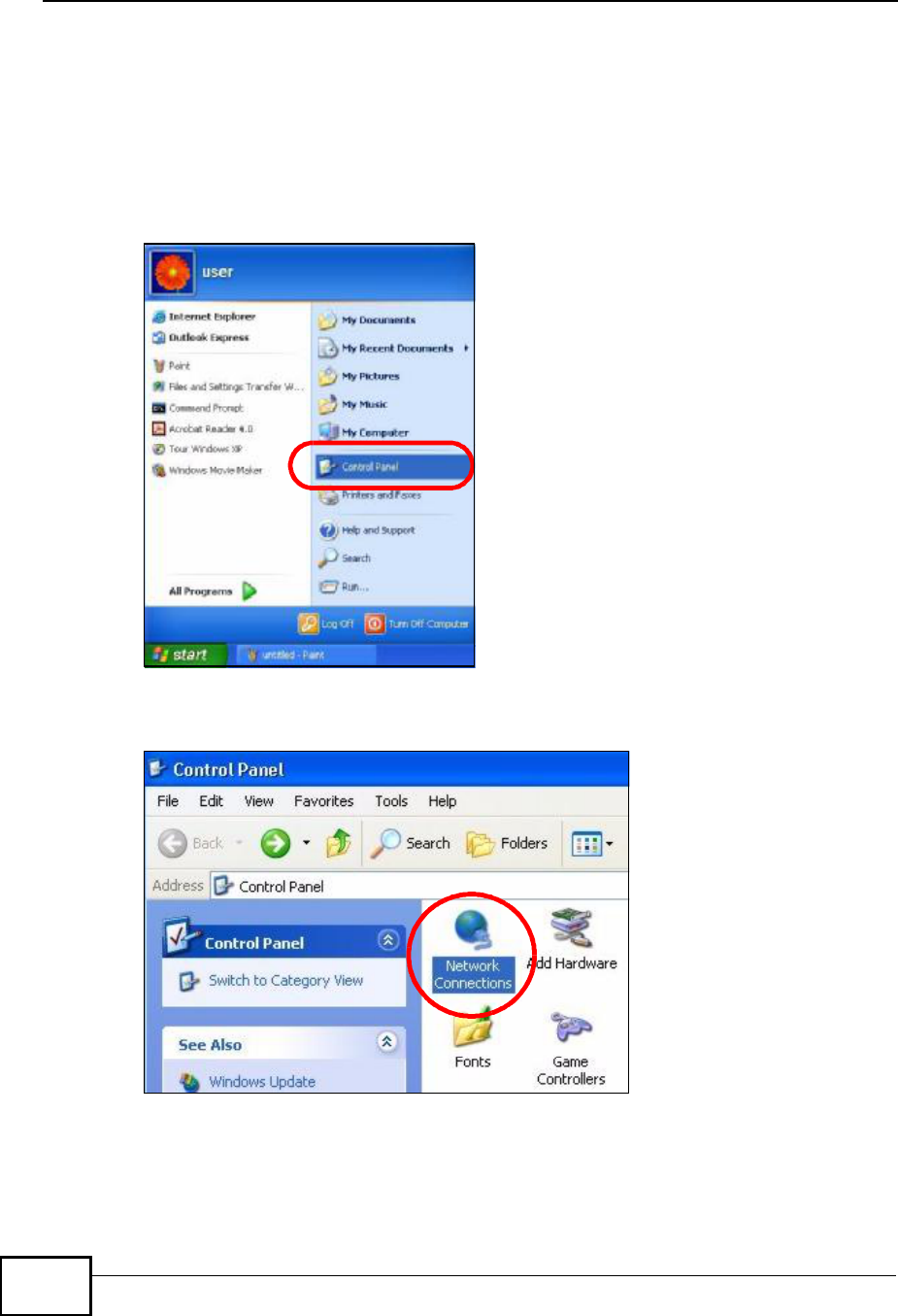
Appendix BSetting Up Your Computer s IP Address
MAX208M User s Guide
156
Windows XP/NT/2000
The following example uses the default Windows XP display theme but can also
apply to Windows 2000 and Windows NT.
1Click Start > Control Panel.
Figure 71 Windows XP: Start Menu
2In the Control Panel, click the Network Connections icon.
Figure 72 Windows XP: Control Panel
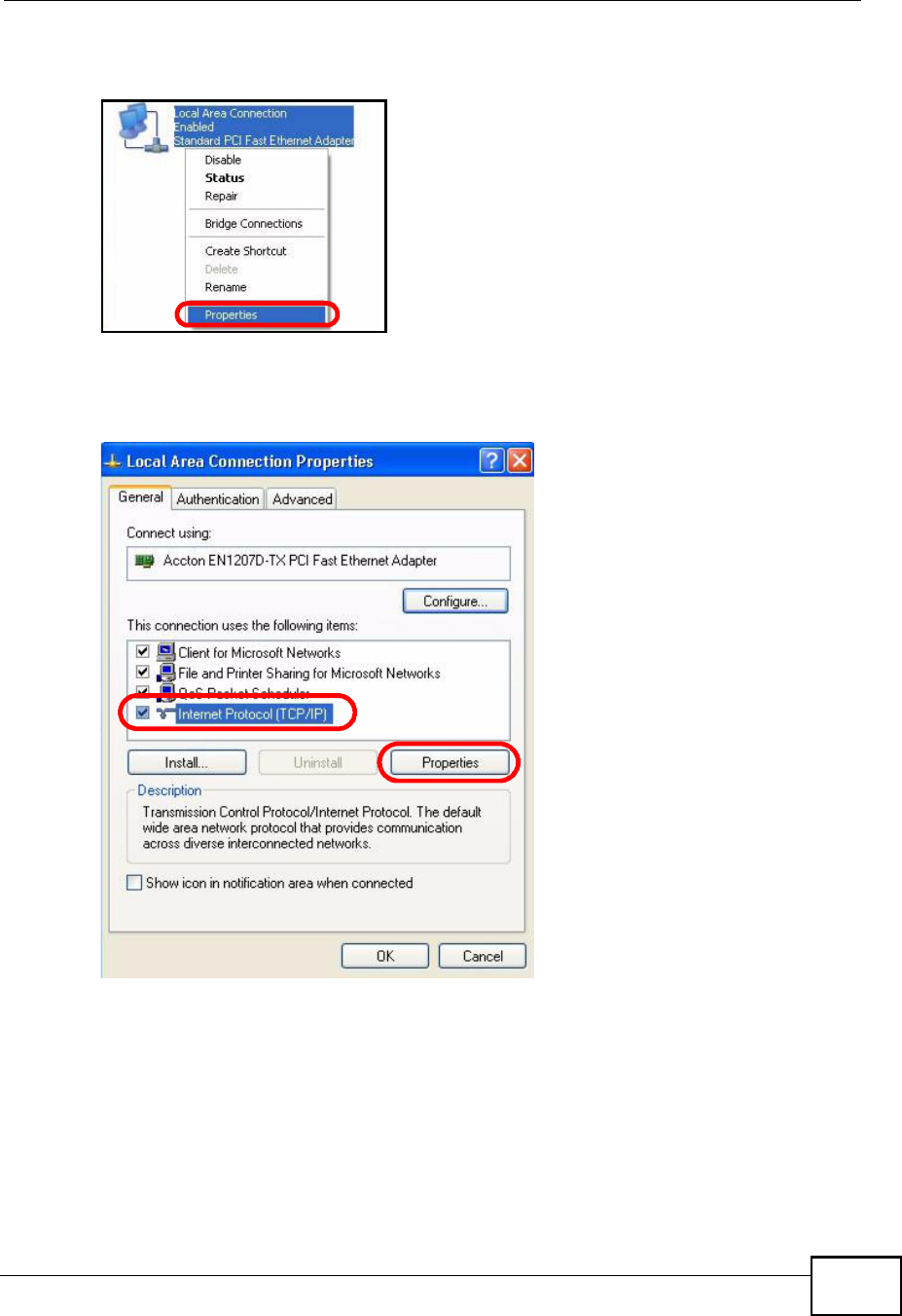
Appendix BSetting Up Your Computer s IP Address
MAX208M User s Guide 157
3Right-click Local Area Connection and then select Properties.
Figure 73 Windows XP: Control Panel > Network Connections > Properties
4On the General tab, select Internet Protocol (TCP/IP) and then click
Properties.
Figure 74 Windows XP: Local Area Connection Properties
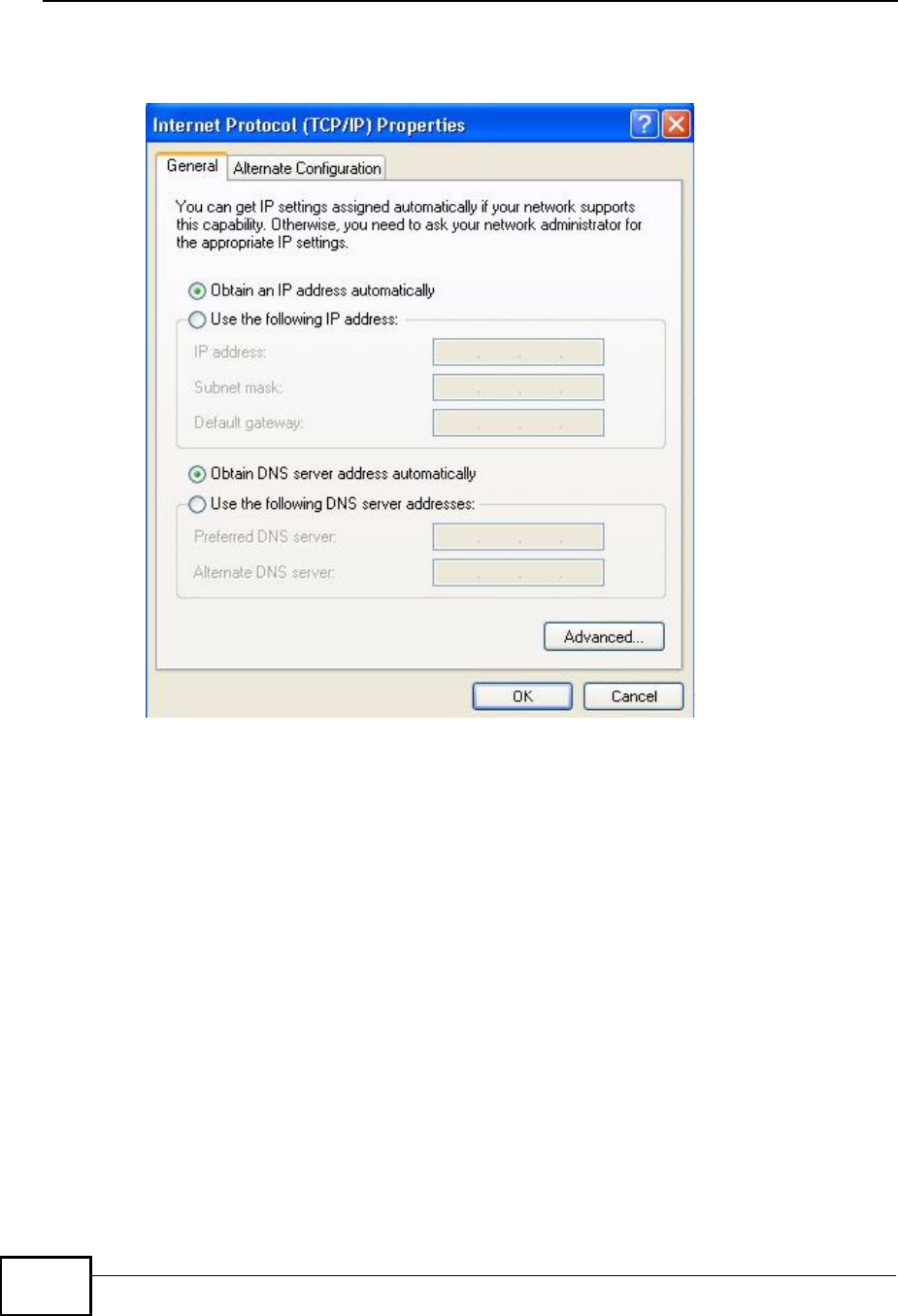
Appendix BSetting Up Your Computer s IP Address
MAX208M User s Guide
158
5The Internet Protocol TCP/IP Properties window opens.
Figure 75 Windows XP: Internet Protocol (TCP/IP) Properties
6Select Obtain an IP address automatically if your network administrator or ISP
assigns your IP address dynamically.
Select Use the following IP Address and fill in the IP address, Subnet mask,
and Default gateway fields if you have a static IP address that was assigned to
you by your network administrator or ISP. You may also have to enter a Preferred
DNS server and an Alternate DNS server, if that information was provided.
7Click OK to close the Internet Protocol (TCP/IP) Properties window.
Click OK to close the Local Area Connection Properties window.Verifying Settings
1Click Start > All Programs > Accessories > Command Prompt.
2In the Command Prompt window, type "ipconfig" and then press [ENTER].
You can also go to Start > Control Panel > Network Connections, right-click a
network connection, click Status and then click the Support tab to view your IP
address and connection information.
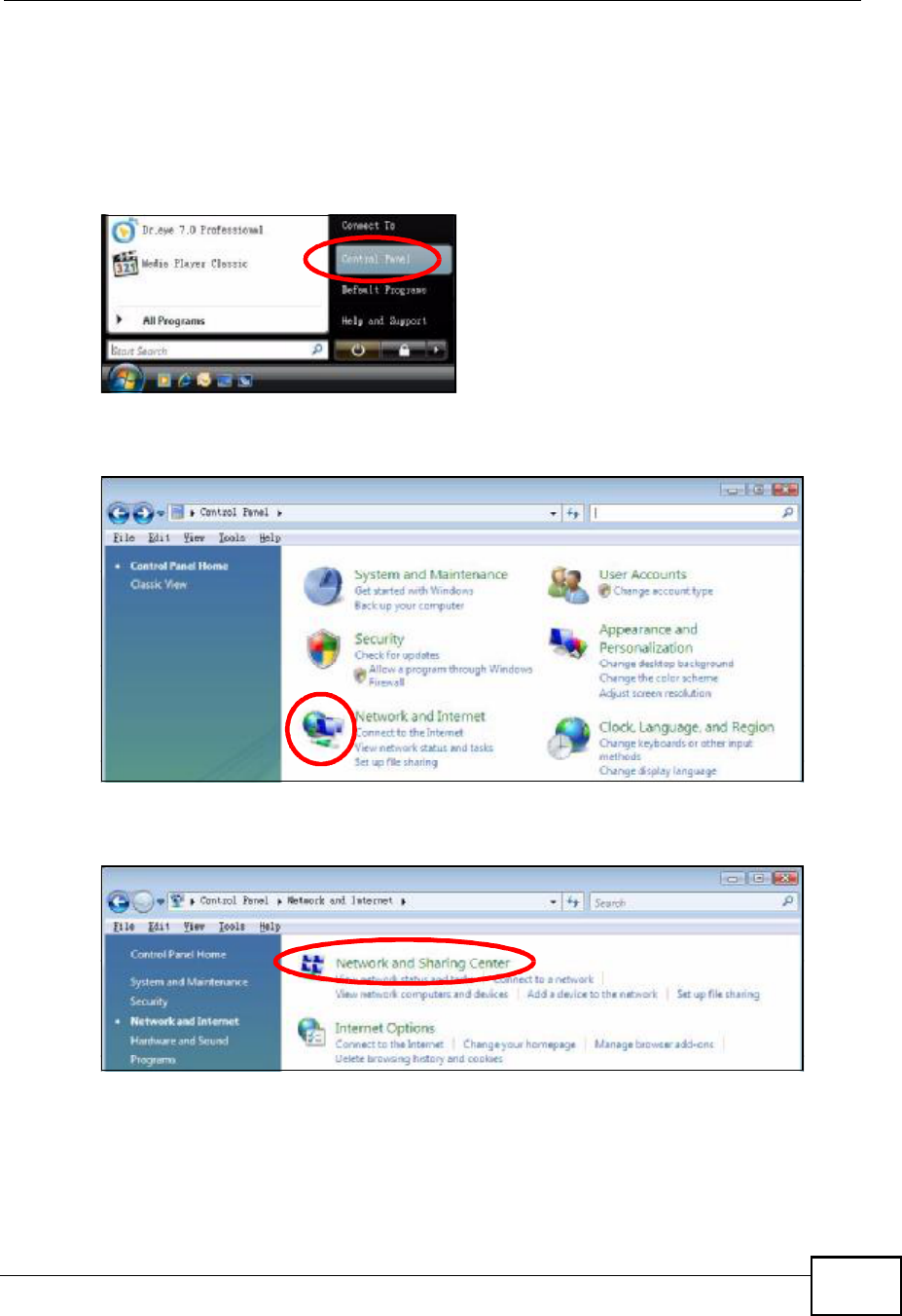
Appendix BSetting Up Your Computer s IP Address
MAX208M User s Guide 159
Windows Vista
This section shows screens from Windows Vista Professional.
1Click Start > Control Panel.
Figure 76 Windows Vista: Start Menu
2In the Control Panel, click the Network and Internet icon.
Figure 77 Windows Vista: Control Panel
3Click the Network and Sharing Center icon.
Figure 78 Windows Vista: Network And Internet
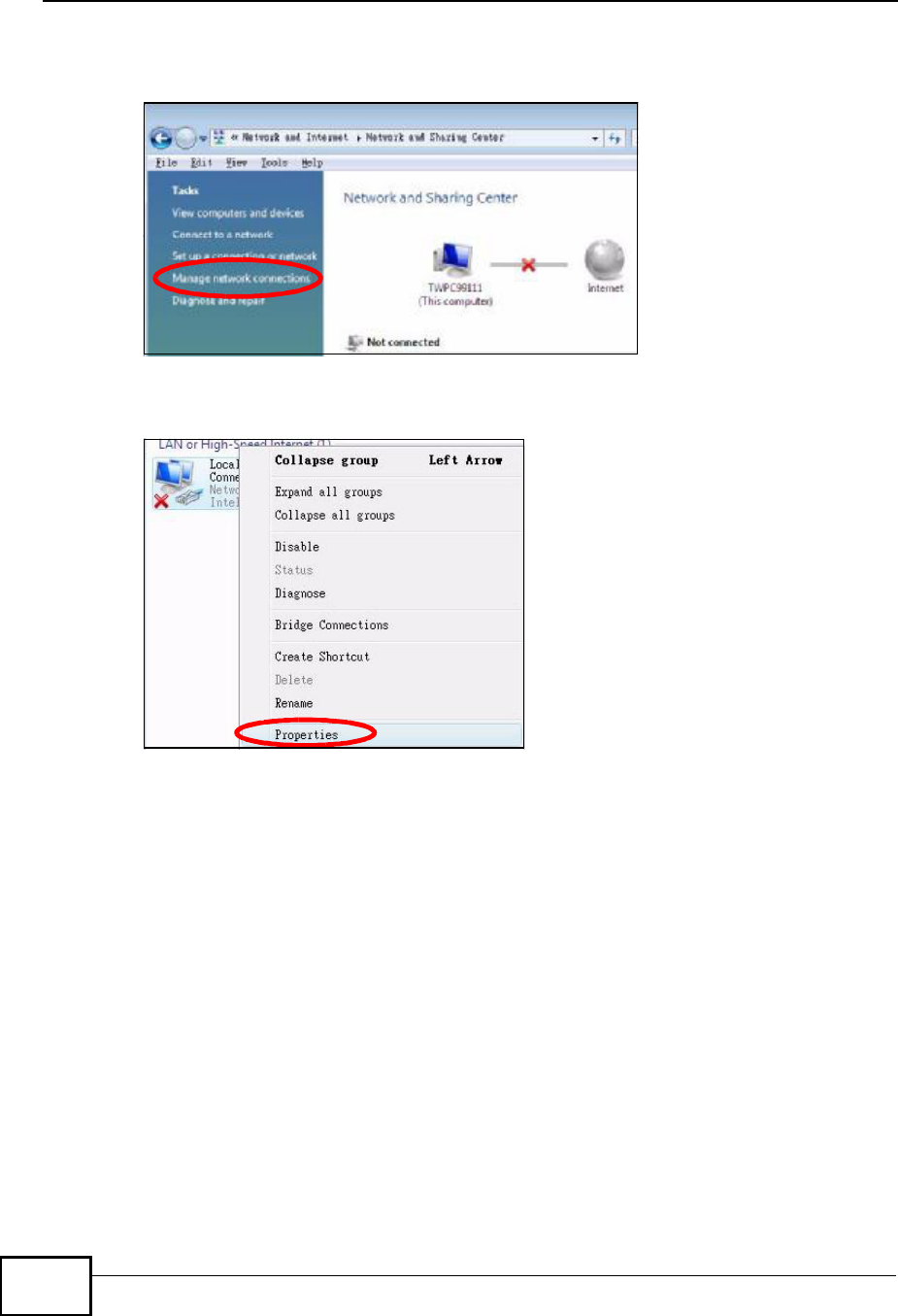
Appendix BSetting Up Your Computer s IP Address
MAX208M User s Guide
160
4Click Manage network connections.
Figure 79 Windows Vista: Network and Sharing Center
5Right-click Local Area Connection and then select Properties.
Figure 80 Windows Vista: Network and Sharing Center
Note: During this procedure, click Continue whenever Windows displays a screen
saying that it needs your permission to continue.
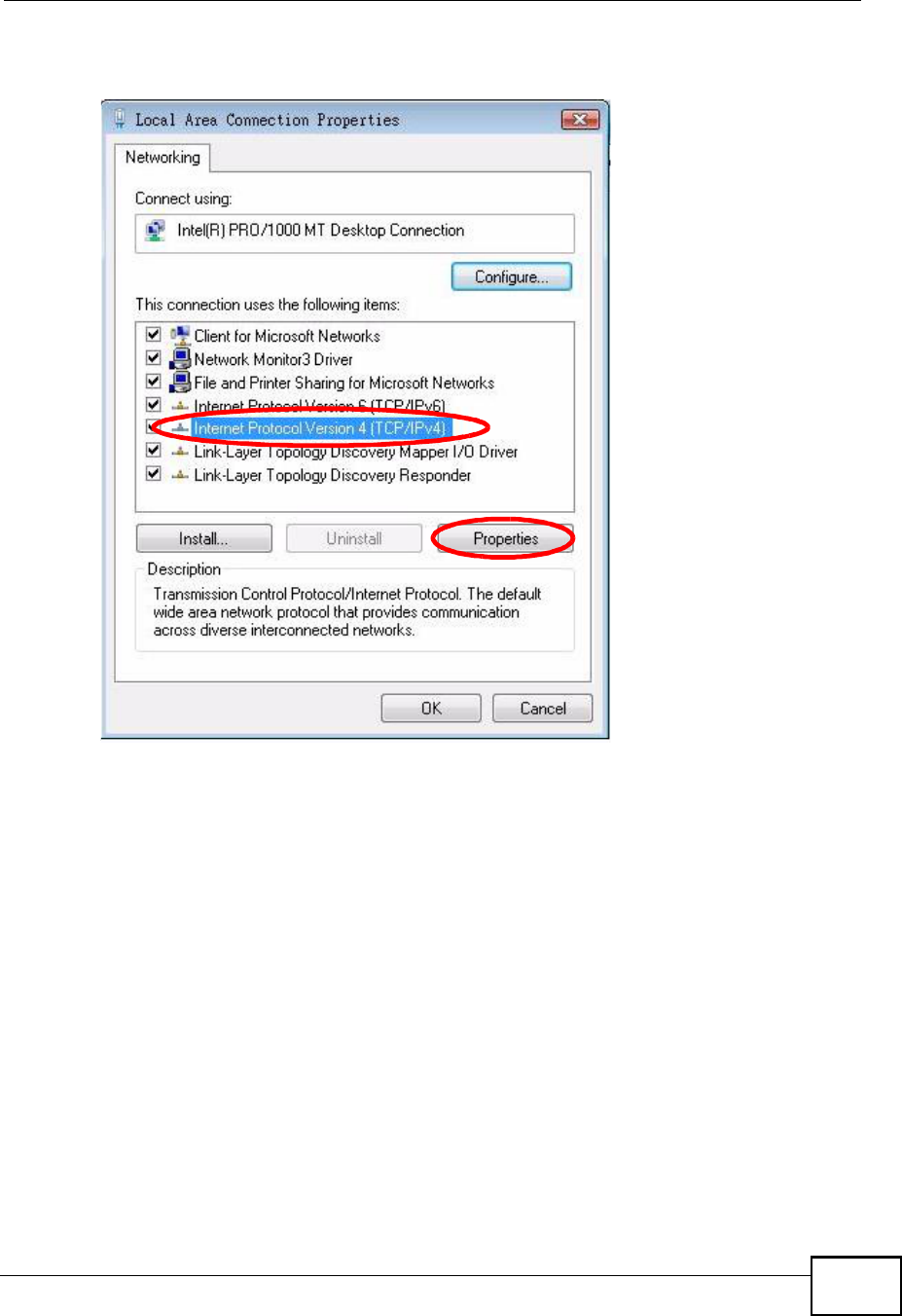
Appendix BSetting Up Your Computer s IP Address
MAX208M User s Guide 161
6Select Internet Protocol Version 4 (TCP/IPv4) and then select Properties.
Figure 81 Windows Vista: Local Area Connection Properties
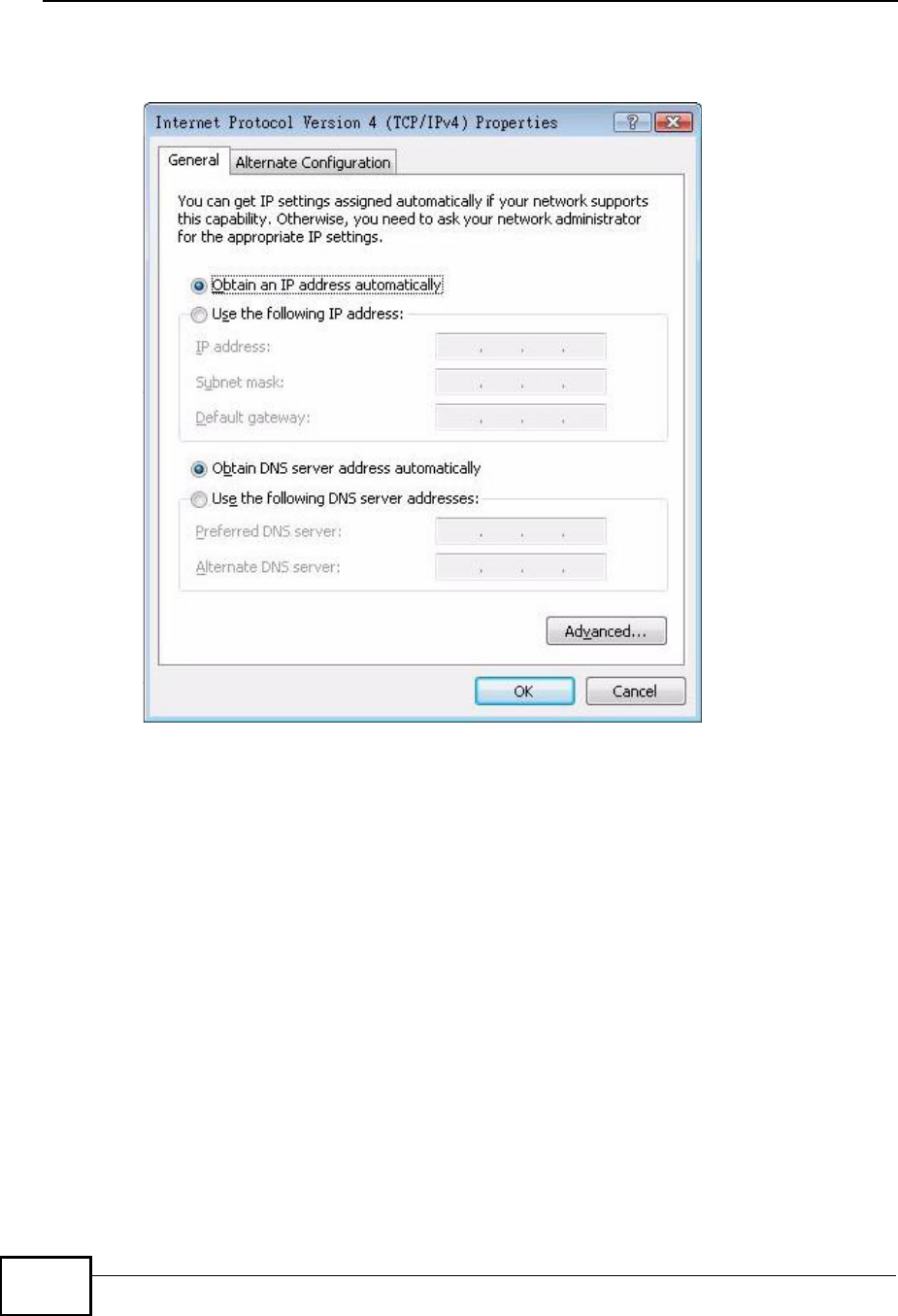
Appendix BSetting Up Your Computer s IP Address
MAX208M User s Guide
162
7The Internet Protocol Version 4 (TCP/IPv4) Properties window opens.
Figure 82 Windows Vista: Internet Protocol Version 4 (TCP/IPv4) Properties
8Select Obtain an IP address automatically if your network administrator or ISP
assigns your IP address dynamically.
Select Use the following IP Address and fill in the IP address, Subnet mask,
and Default gateway fields if you have a static IP address that was assigned to
you by your network administrator or ISP. You may also have to enter a Preferred
DNS server and an Alternate DNS server, if that information was
provided.Click Advanced.
9Click OK to close the Internet Protocol (TCP/IP) Properties window.
Click OK to close the Local Area Connection Properties window.Verifying Settings
1Click Start > All Programs > Accessories > Command Prompt.
2In the Command Prompt window, type "ipconfig" and then press [ENTER].
You can also go to Start > Control Panel > Network Connections, right-click a
network connection, click Status and then click the Support tab to view your IP
address and connection information.
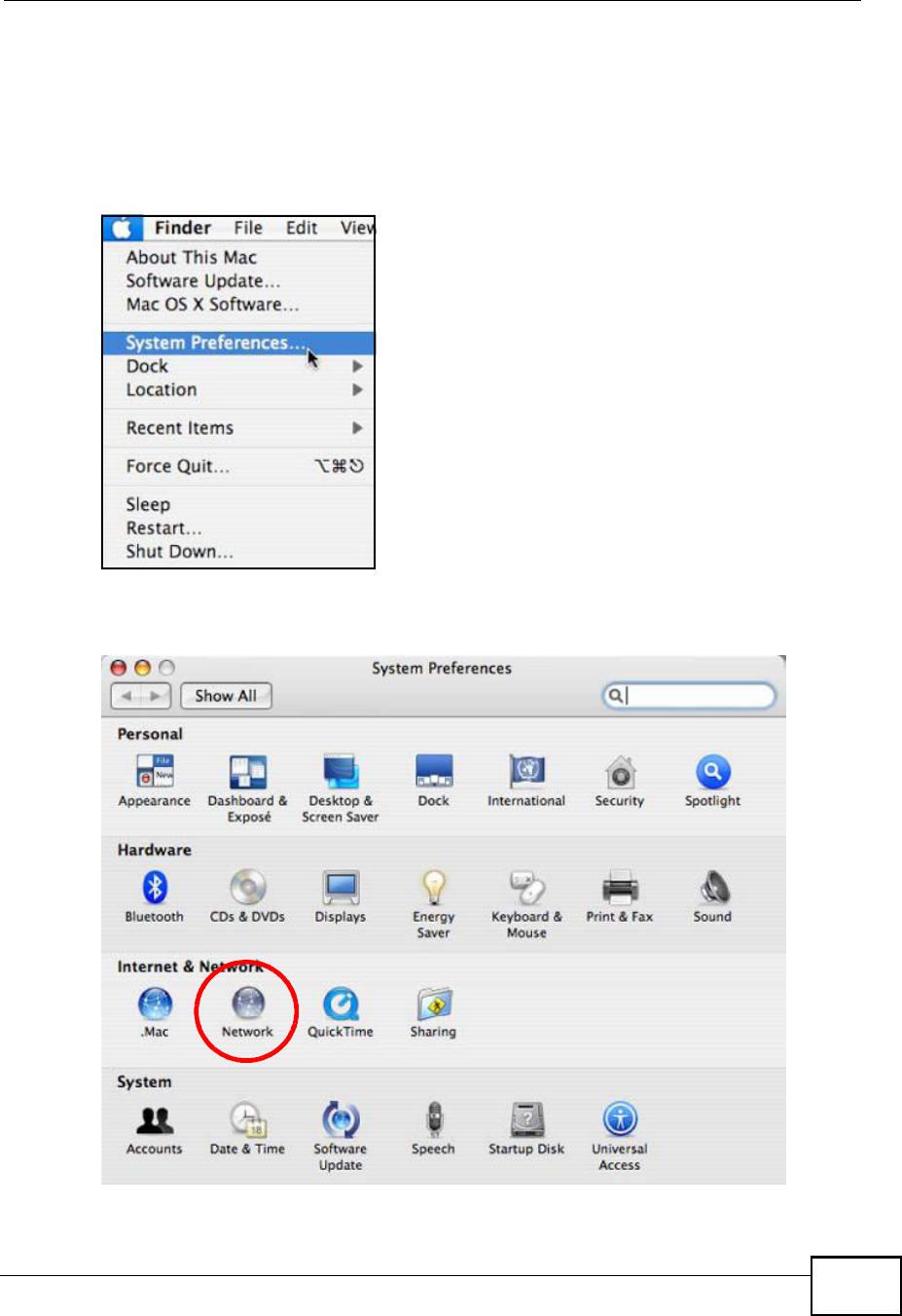
Appendix BSetting Up Your Computer s IP Address
MAX208M User s Guide 163
Mac OS X: 10.3 and 10.4
The screens in this section are from Mac OS X 10.4 but can also apply to 10.3.
1Click Apple > System Preferences.
Figure 83 Mac OS X 10.4: Apple Menu
2In the System Preferences window, click the Network icon.
Figure 84 Mac OS X 10.4: System Preferences
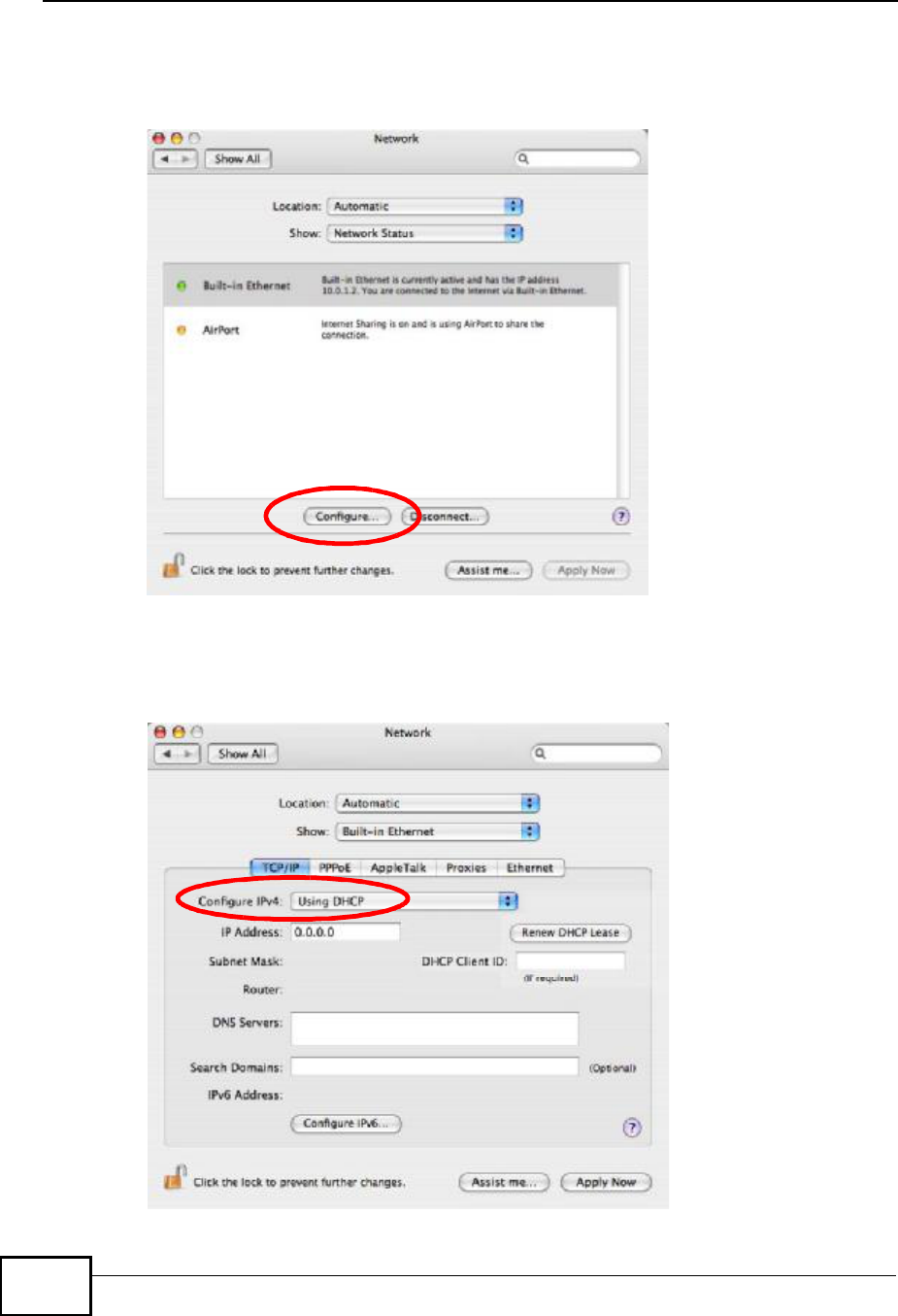
Appendix BSetting Up Your Computer s IP Address
MAX208M User s Guide
164
3When the Network preferences pane opens, select Built-in Ethernet from the
network connection type list, and then click Configure.
Figure 85 Mac OS X 10.4: Network Preferences
4For dynamically assigned settings, select Using DHCP from the Configure IPv4
list in the TCP/IP tab.
Figure 86 Mac OS X 10.4: Network Preferences > TCP/IP Tab.
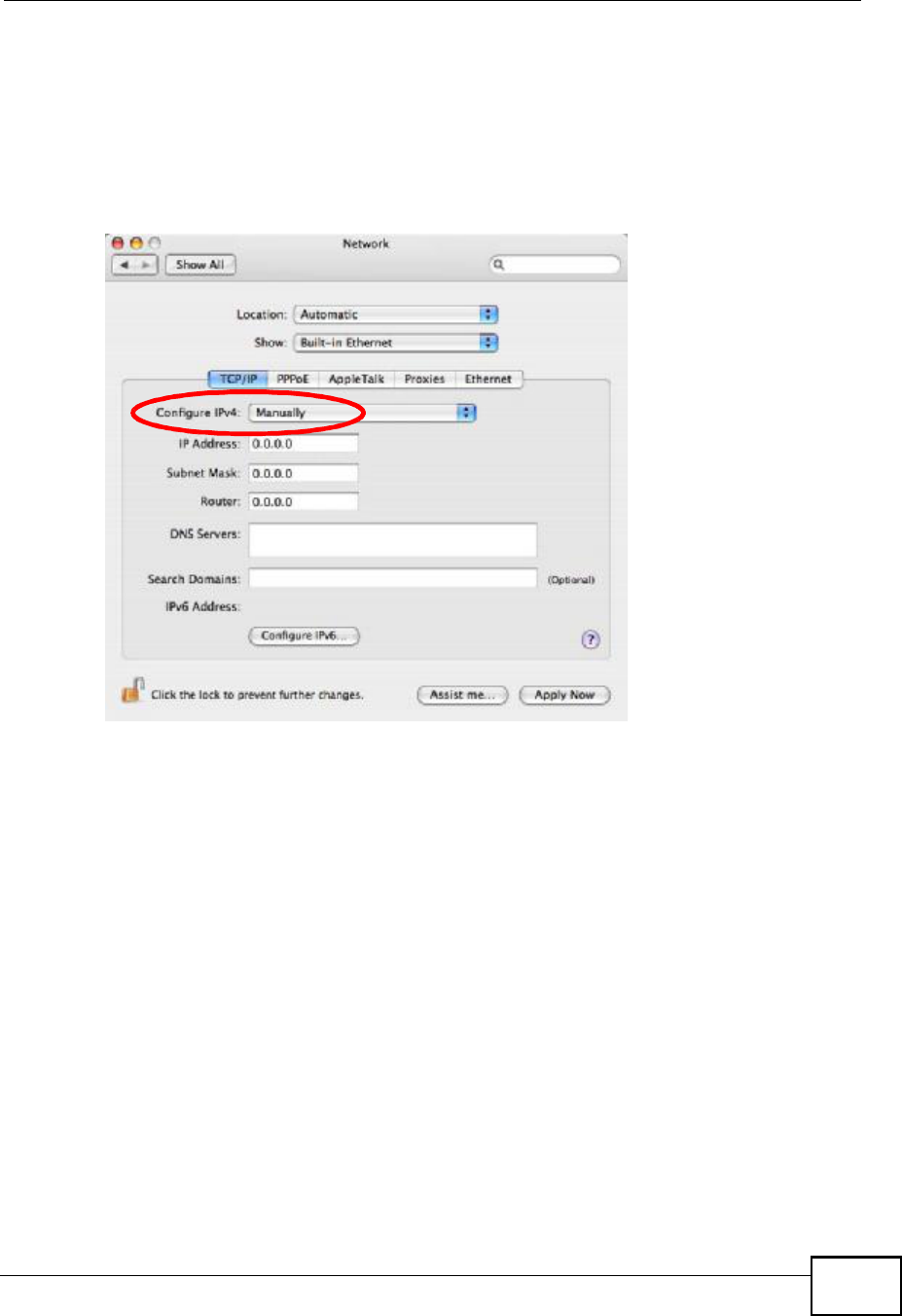
Appendix BSetting Up Your Computer s IP Address
MAX208M User s Guide 165
5For statically assigned settings, do the following:
!From the Configure IPv4 list, select Manually.
!In the IP Address field, type your IP address.
!In the Subnet Mask field, type your subnet mask.
!In the Router field, type the IP address of your device.
Figure 87 Mac OS X 10.4: Network Preferences > Ethernet
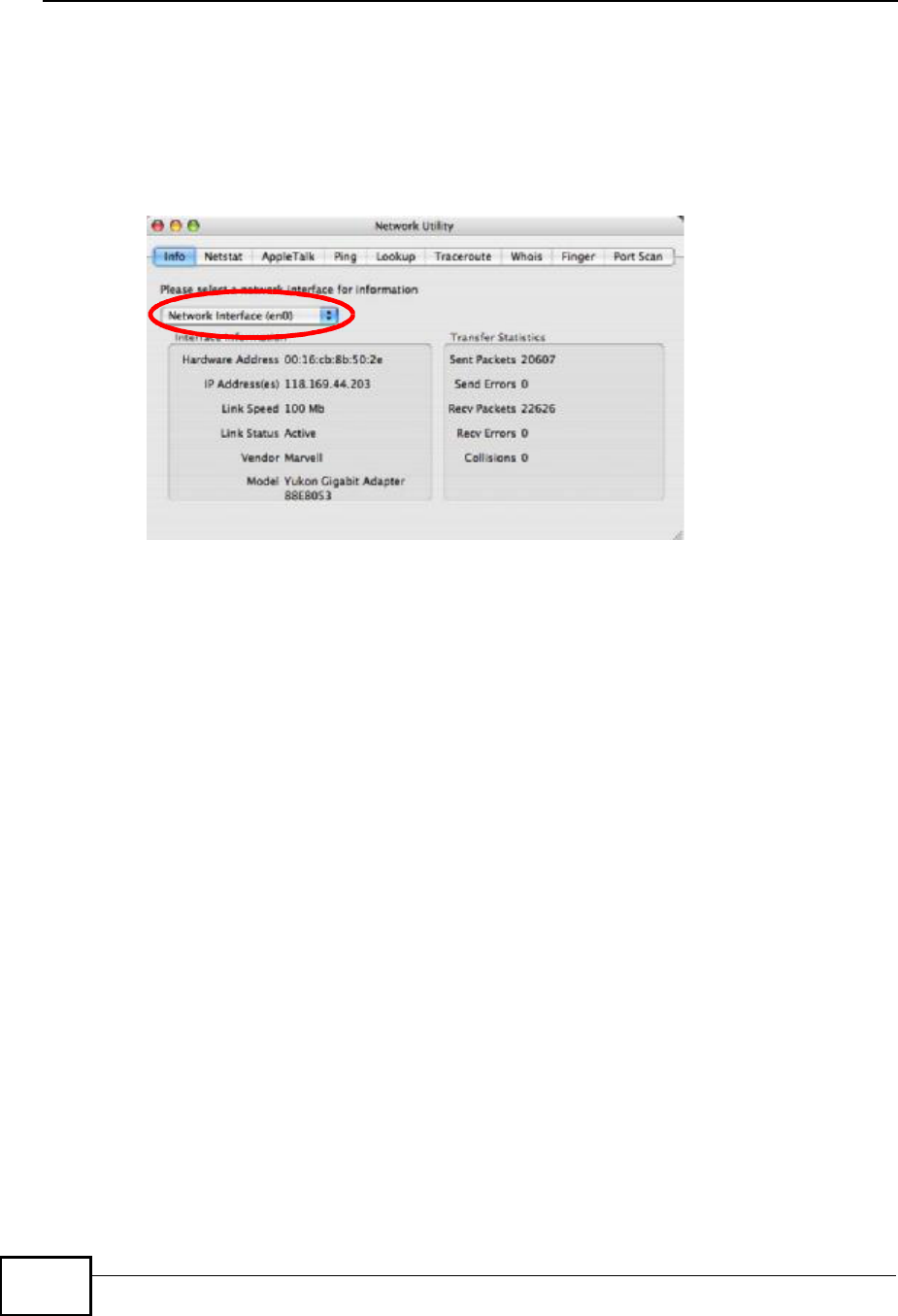
Appendix BSetting Up Your Computer s IP Address
MAX208M User s Guide
166
Click Apply Now and close the window.Verifying Settings
Check your TCP/IP properties by clicking Applications > Utilities > Network
Utilities, and then selecting the appropriate Network Interface from the Info
tab.
Figure 88 Mac OS X 10.4: Network Utility
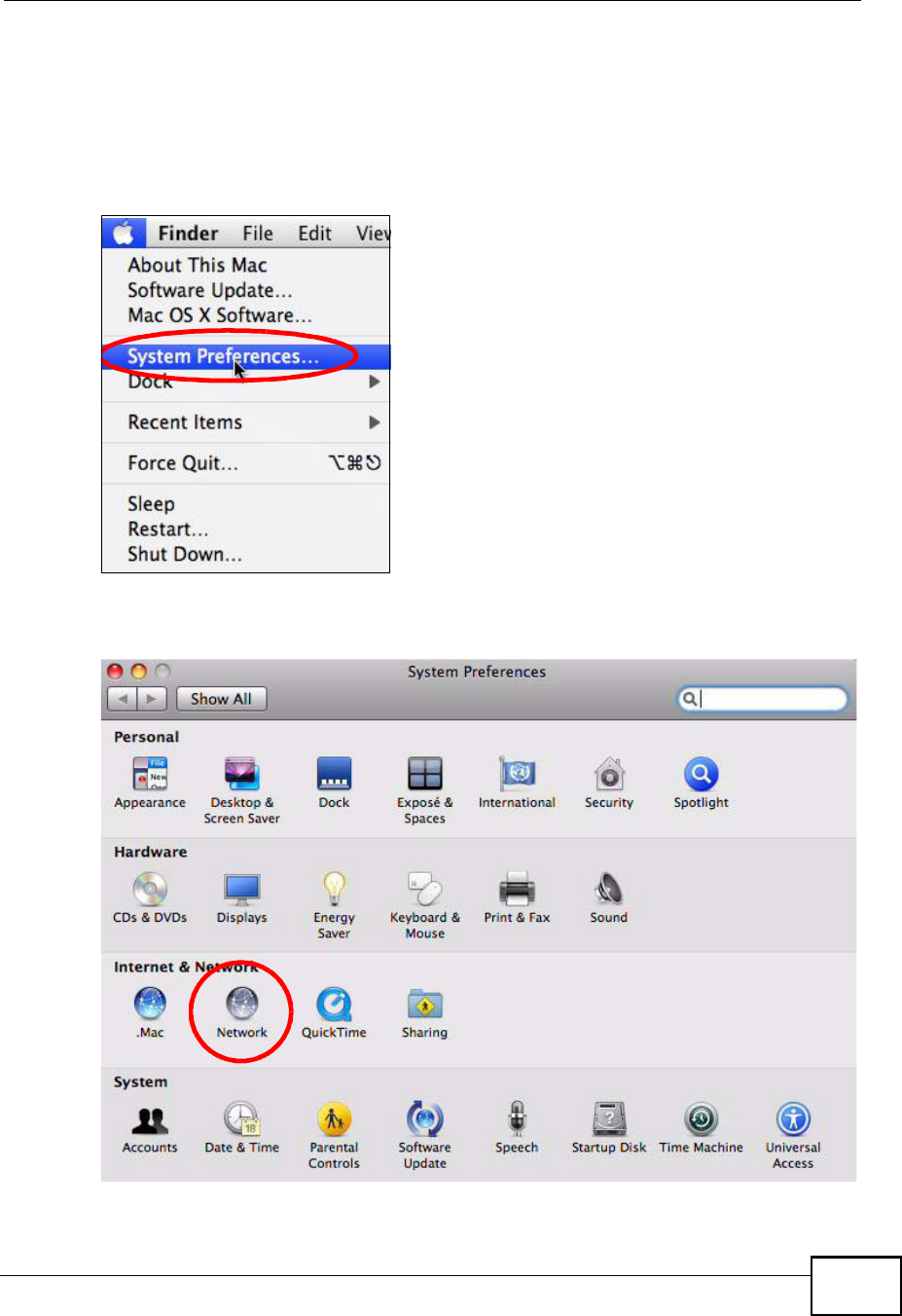
Appendix BSetting Up Your Computer s IP Address
MAX208M User s Guide 167
Mac OS X: 10.5
The screens in this section are from Mac OS X 10.5.
1Click Apple > System Preferences.
Figure 89 Mac OS X 10.5: Apple Menu
2In System Preferences, click the Network icon.
Figure 90 Mac OS X 10.5: Systems Preferences
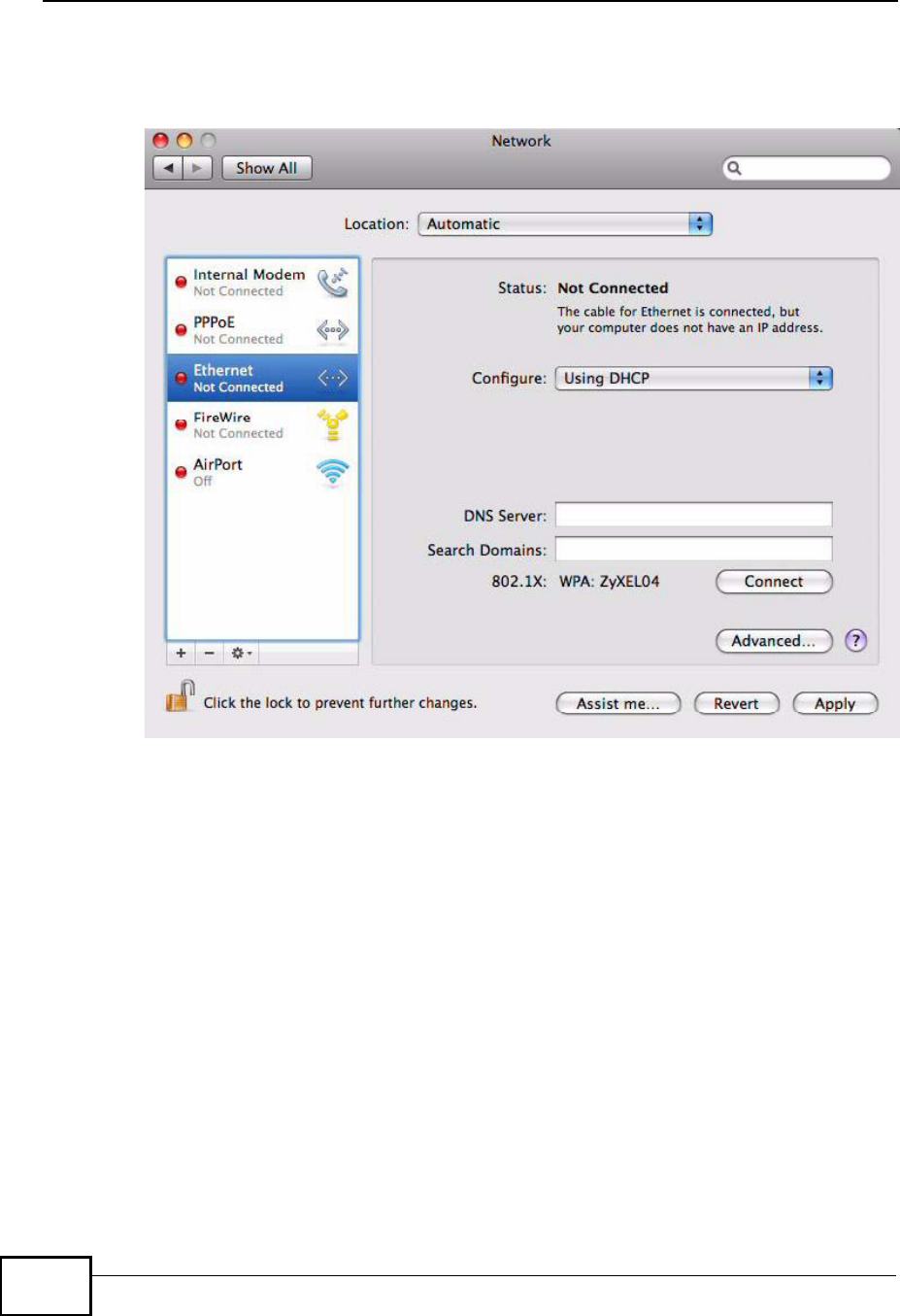
Appendix BSetting Up Your Computer s IP Address
MAX208M User s Guide
168
3When the Network preferences pane opens, select Ethernet from the list of
available connection types.
Figure 91 Mac OS X 10.5: Network Preferences > Ethernet
4From the Configure list, select Using DHCP for dynamically assigned settings.
5For statically assigned settings, do the following:
!From the Configure list, select Manually.
!In the IP Address field, enter your IP address.
!In the Subnet Mask field, enter your subnet mask.
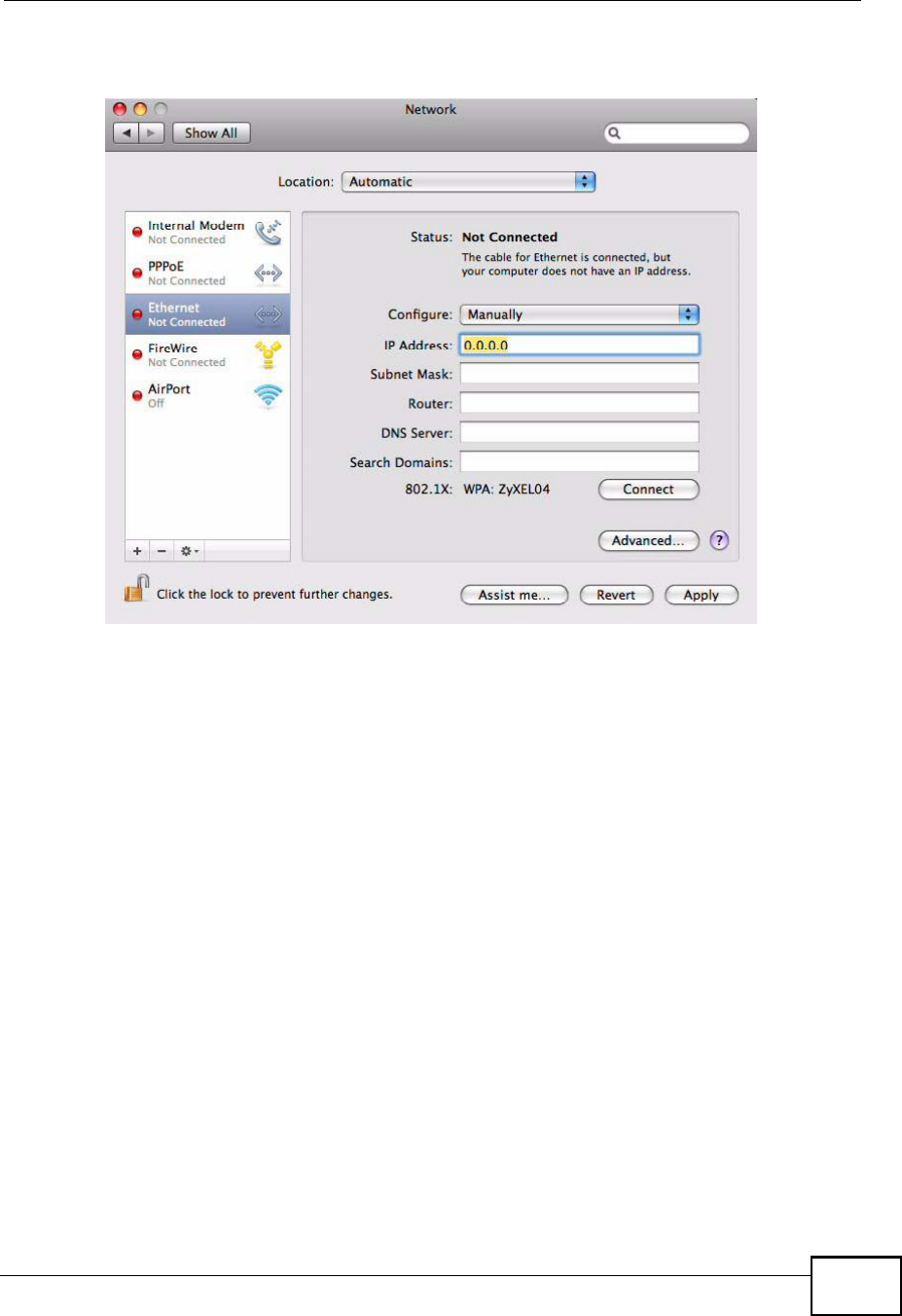
Appendix BSetting Up Your Computer s IP Address
MAX208M User s Guide 169
!In the Router field, enter the IP address of your WiMAX Device.
Figure 92 Mac OS X 10.5: Network Preferences > Ethernet
6Click Apply and close the window.
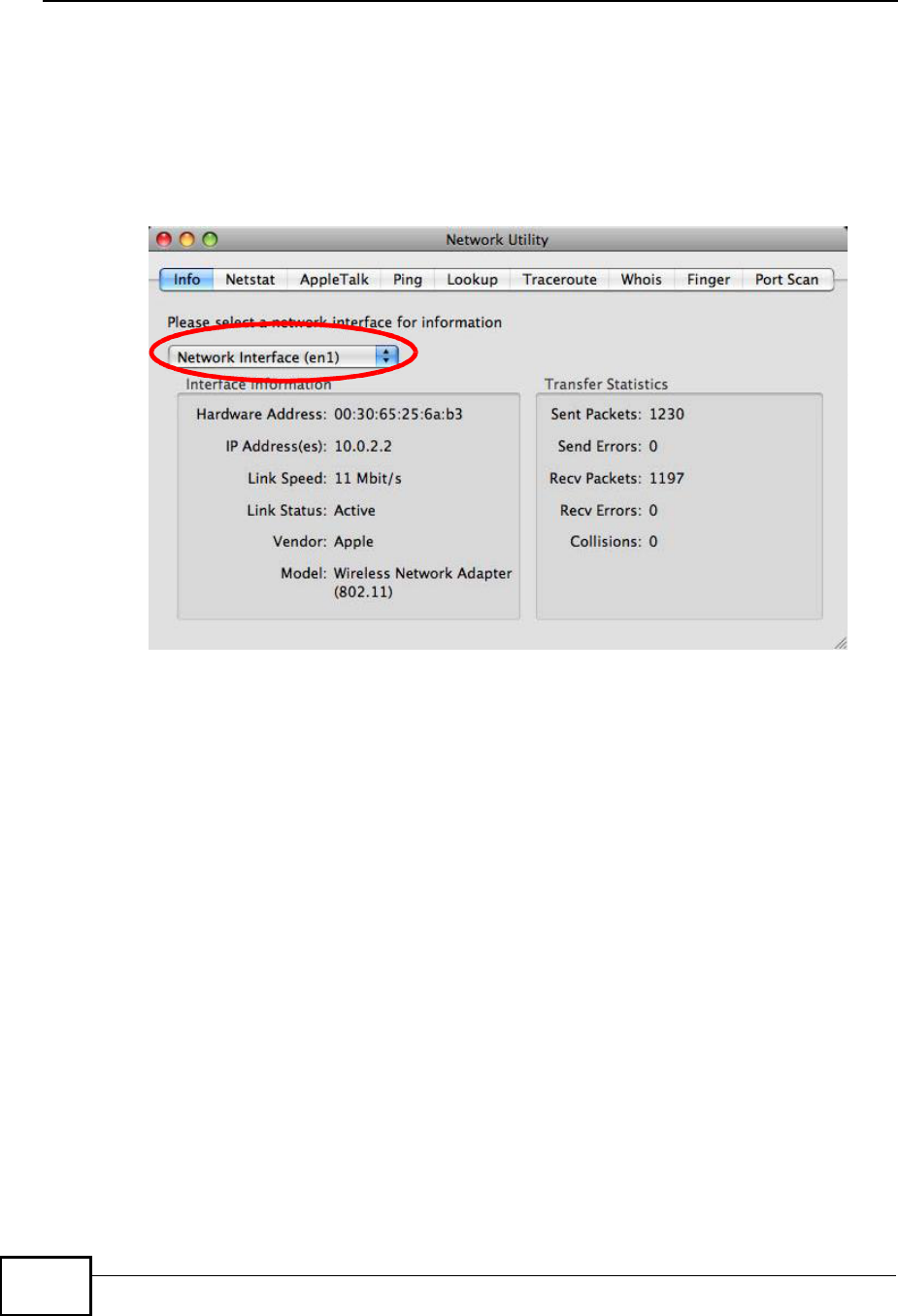
Appendix BSetting Up Your Computer s IP Address
MAX208M User s Guide
170
Verifying Settings
Check your TCP/IP properties by clicking Applications > Utilities > Network
Utilities, and then selecting the appropriate Network interface from the Info
tab.
Figure 93 Mac OS X 10.5: Network Utility
Linux: Ubuntu 8 (GNOME)
This section shows you how to configure your computer s TCP/IP settings in the
GNU Object Model Environment (GNOME) using the Ubuntu 8 Linux distribution.
The procedure, screens and file locations may vary depending on your specific
distribution, release version, and individual configuration. The following screens
use the default Ubuntu 8 installation.
Note: Make sure you are logged in as the root administrator.
Follow the steps below to configure your computer IP address in GNOME:
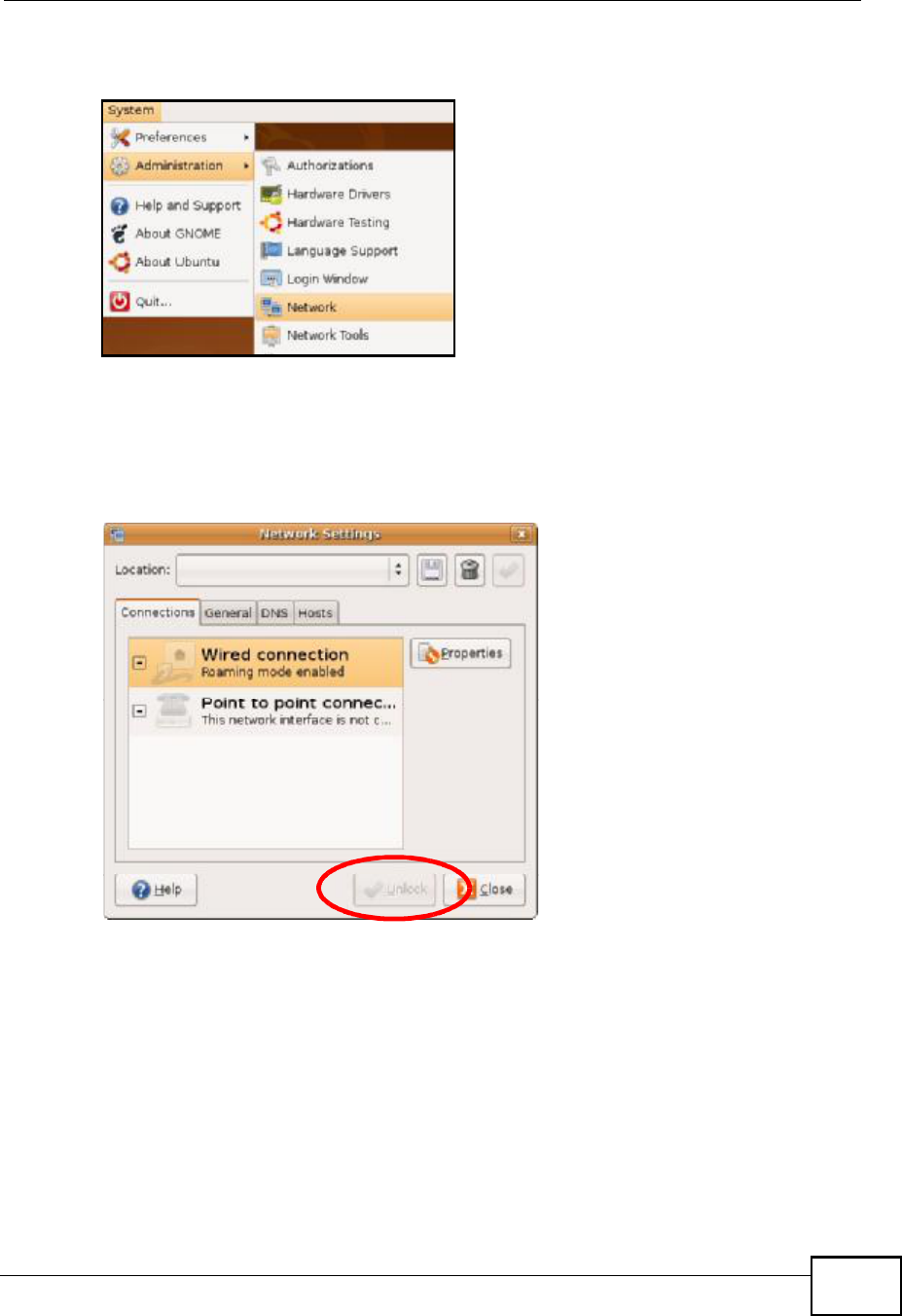
Appendix BSetting Up Your Computer s IP Address
MAX208M User s Guide 171
1Click System > Administration > Network.
Figure 94 Ubuntu 8: System > Administration Menu
2When the Network Settings window opens, click Unlock to open the
Authenticate window. (By default, the Unlock button is greyed out until clicked.)
You cannot make changes to your configuration unless you first enter your admin
password.
Figure 95 Ubuntu 8: Network Settings > Connections
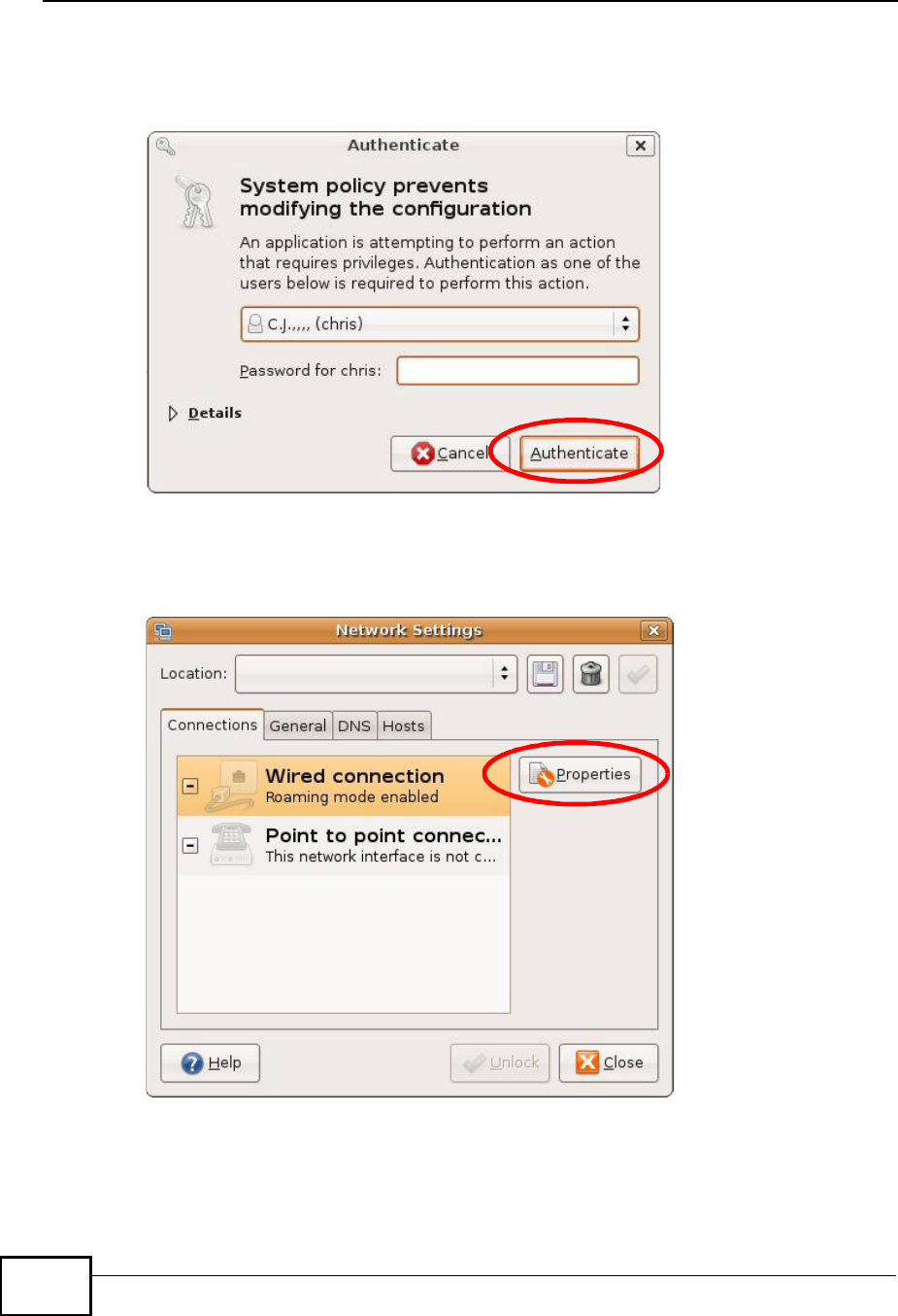
Appendix BSetting Up Your Computer s IP Address
MAX208M User s Guide
172
3In the Authenticate window, enter your admin account name and password then
click the Authenticate button.
Figure 96 Ubuntu 8: Administrator Account Authentication
4In the Network Settings window, select the connection that you want to
configure, then click Properties.
Figure 97 Ubuntu 8: Network Settings > Connections
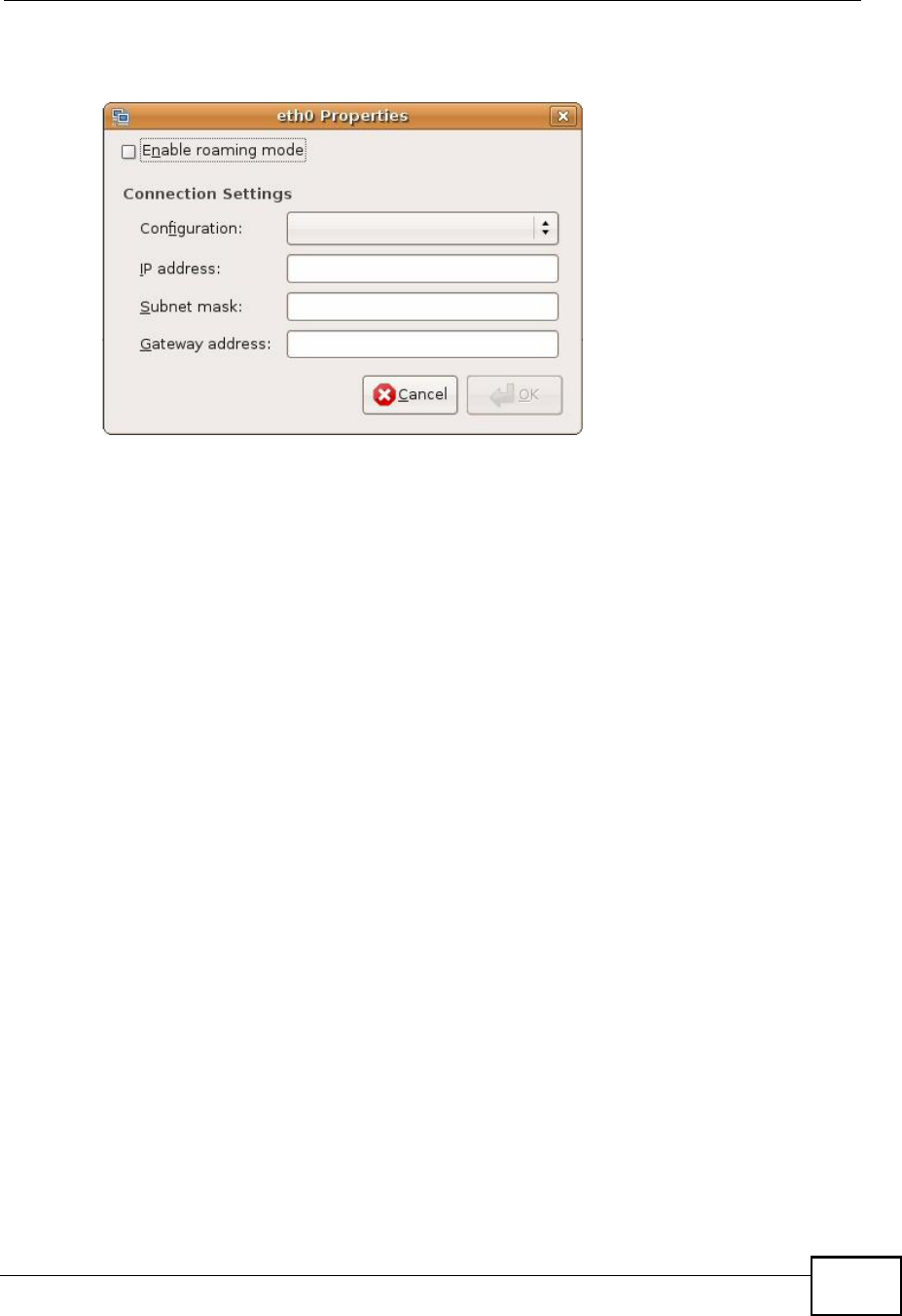
Appendix BSetting Up Your Computer s IP Address
MAX208M User s Guide 173
5The Properties dialog box opens.
Figure 98 Ubuntu 8: Network Settings > Properties
!In the Configuration list, select Automatic Configuration (DHCP) if you
have a dynamic IP address.
!In the Configuration list, select Static IP address if you have a static IP
address. Fill in the IP address, Subnet mask, and Gateway address fields.
6Click OK to save the changes and close the Properties dialog box and return to
the Network Settings screen.
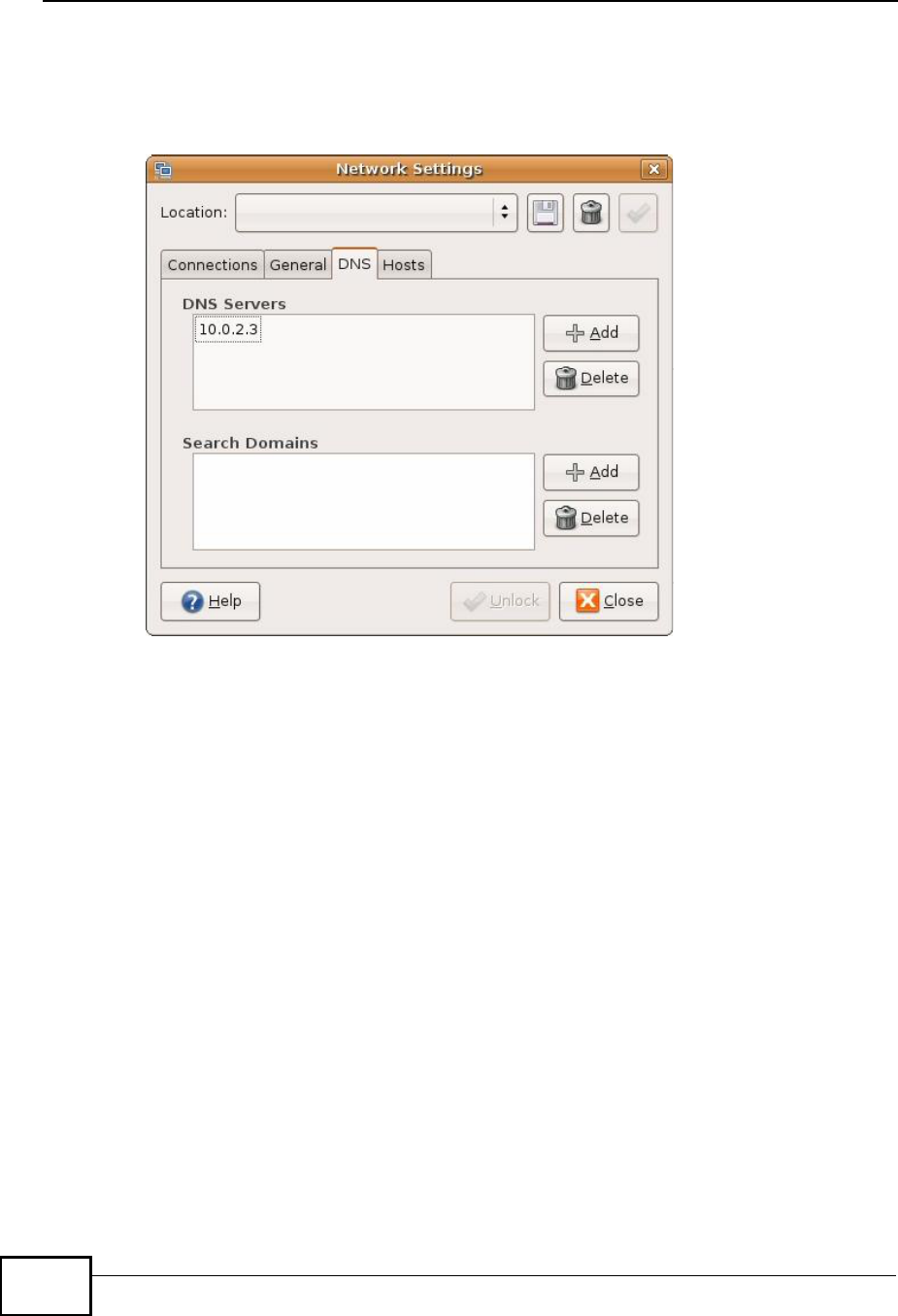
Appendix BSetting Up Your Computer s IP Address
MAX208M User s Guide
174
7If you know your DNS server IP address(es), click the DNS tab in the Network
Settings window and then enter the DNS server information in the fields
provided.
Figure 99 Ubuntu 8: Network Settings > DNS
8Click the Close button to apply the changes.
Verifying Settings
Check your TCP/IP properties by clicking System > Administration > Network
Tools, and then selecting the appropriate Network device from the Devices
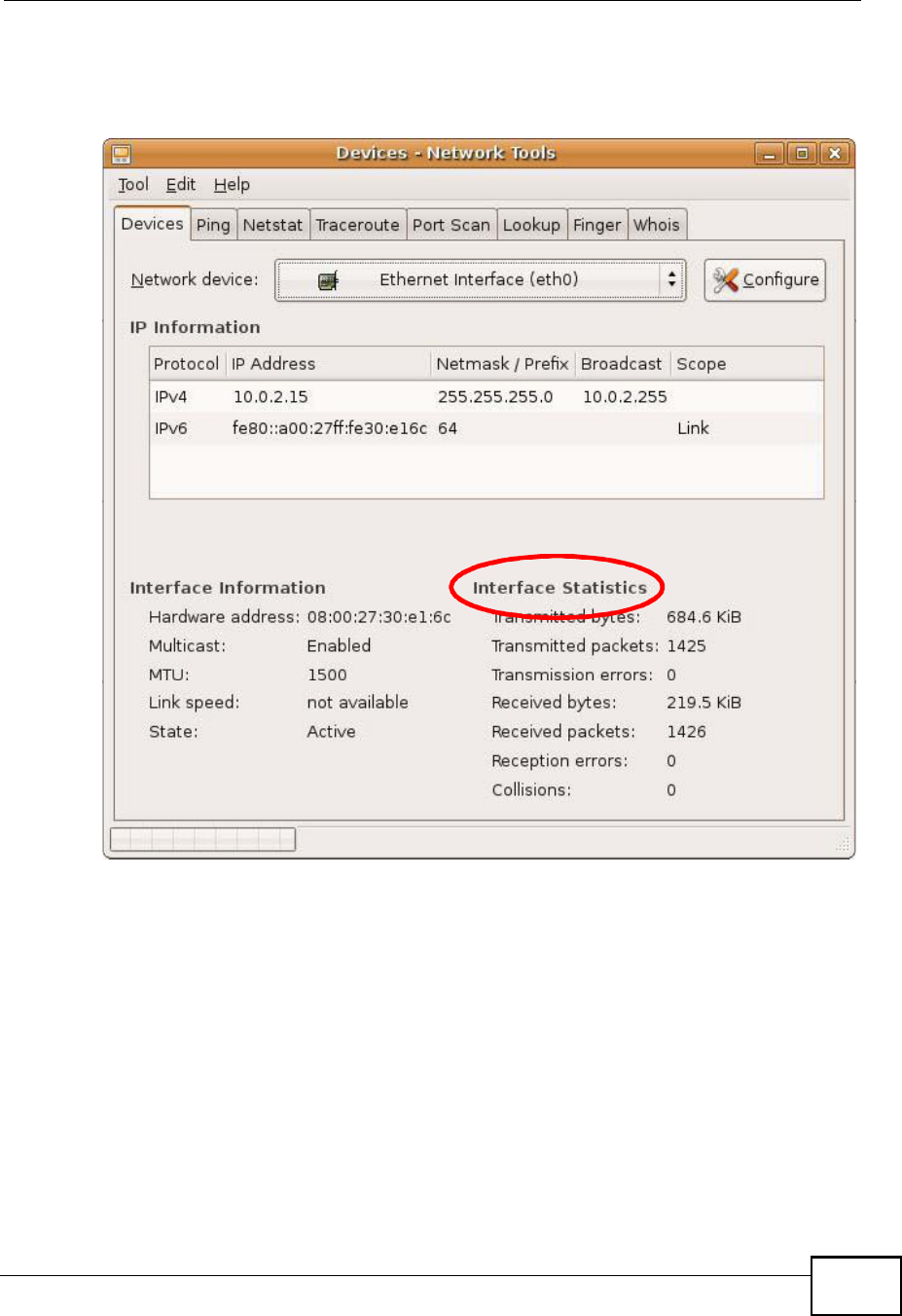
Appendix BSetting Up Your Computer s IP Address
MAX208M User s Guide 175
tab. The Interface Statistics column shows data if your connection is working
properly.
Figure 100 Ubuntu 8: Network Tools
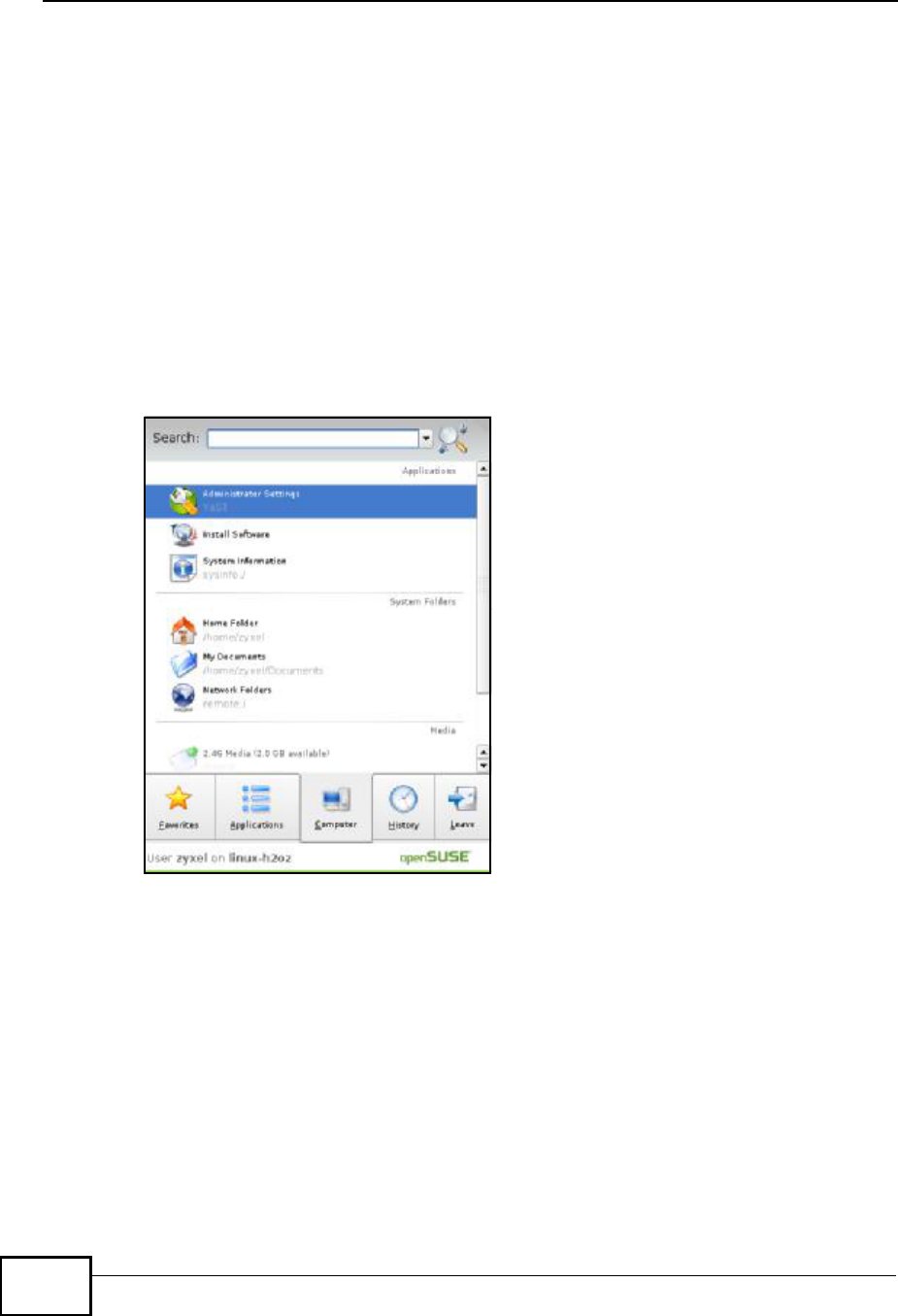
Appendix BSetting Up Your Computer s IP Address
MAX208M User s Guide
176
Linux: openSUSE 10.3 (KDE)
This section shows you how to configure your computer s TCP/IP settings in the K
Desktop Environment (KDE) using the openSUSE 10.3 Linux distribution. The
procedure, screens and file locations may vary depending on your specific
distribution, release version, and individual configuration. The following screens
use the default openSUSE 10.3 installation.
Note: Make sure you are logged in as the root administrator.
Follow the steps below to configure your computer IP address in the KDE:
1Click K Menu > Computer > Administrator Settings (YaST).
Figure 101 openSUSE 10.3: K Menu > Computer Menu
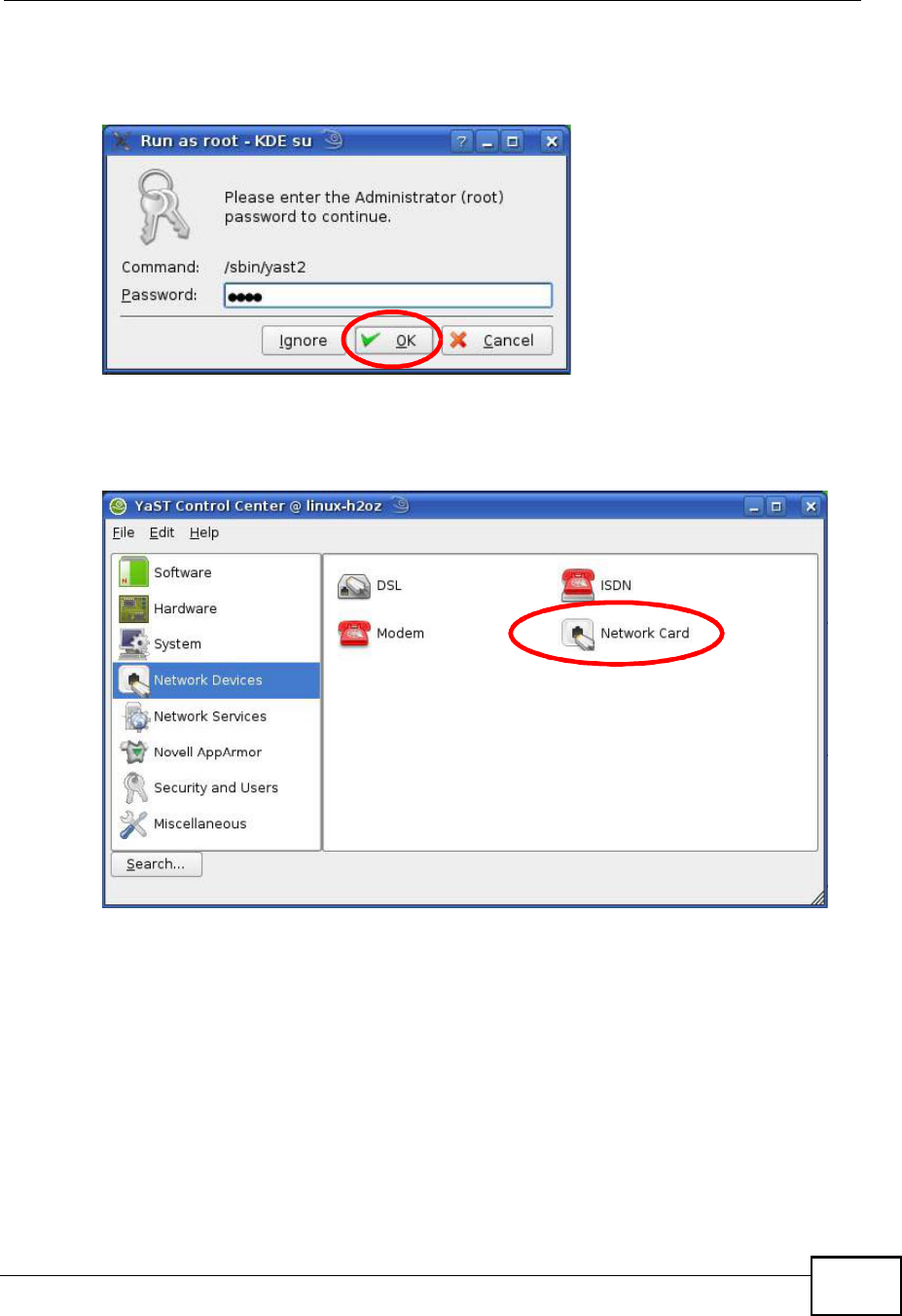
Appendix BSetting Up Your Computer s IP Address
MAX208M User s Guide 177
2When the Run as Root - KDE su dialog opens, enter the admin password and
click OK.
Figure 102 openSUSE 10.3: K Menu > Computer Menu
3When the YaST Control Center window opens, select Network Devices and
then click the Network Card icon.
Figure 103 openSUSE 10.3: YaST Control Center
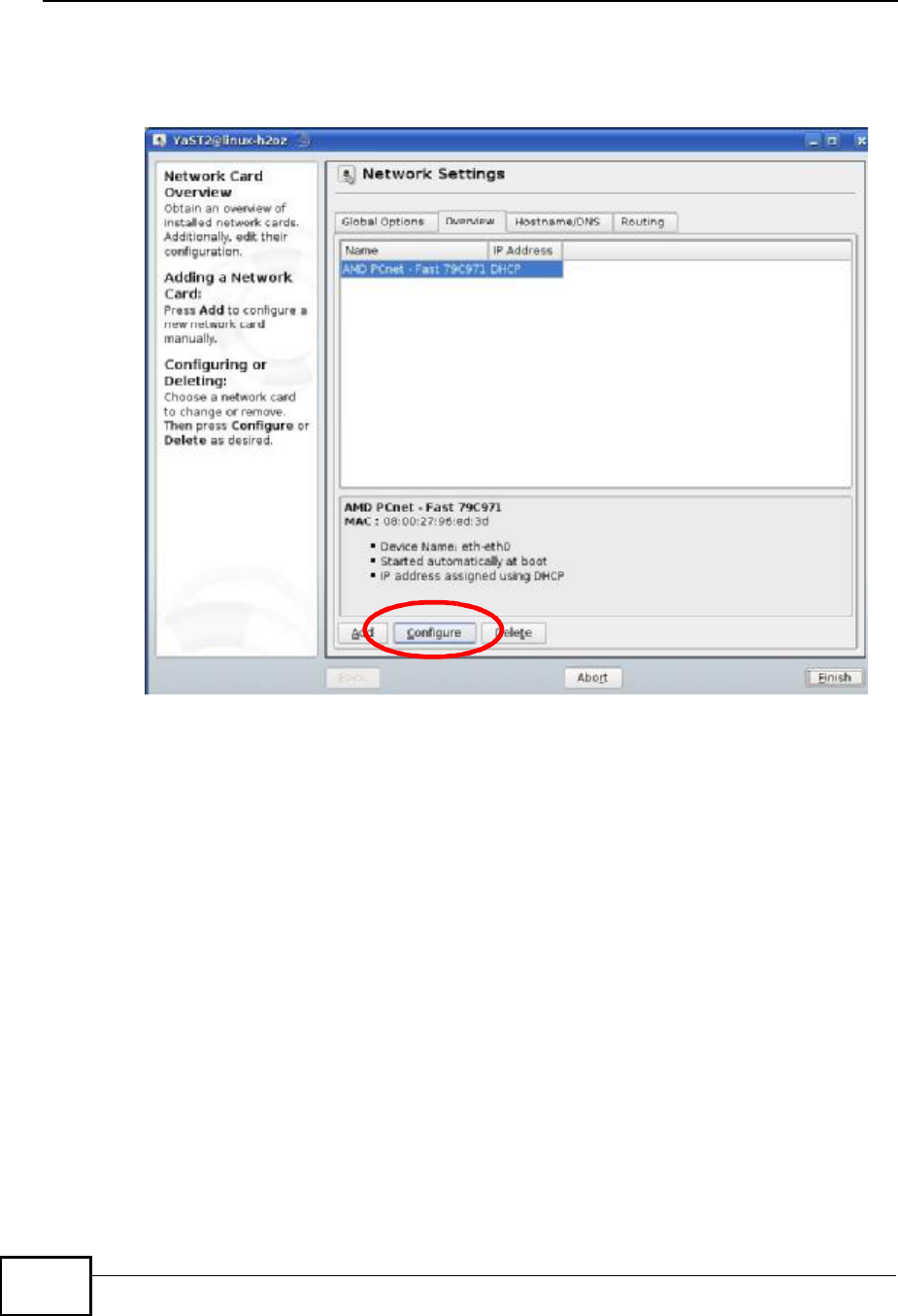
Appendix BSetting Up Your Computer s IP Address
MAX208M User s Guide
178
4When the Network Settings window opens, click the Overview tab, select the
appropriate connection Name from the list, and then click the Configure button.
Figure 104 openSUSE 10.3: Network Settings
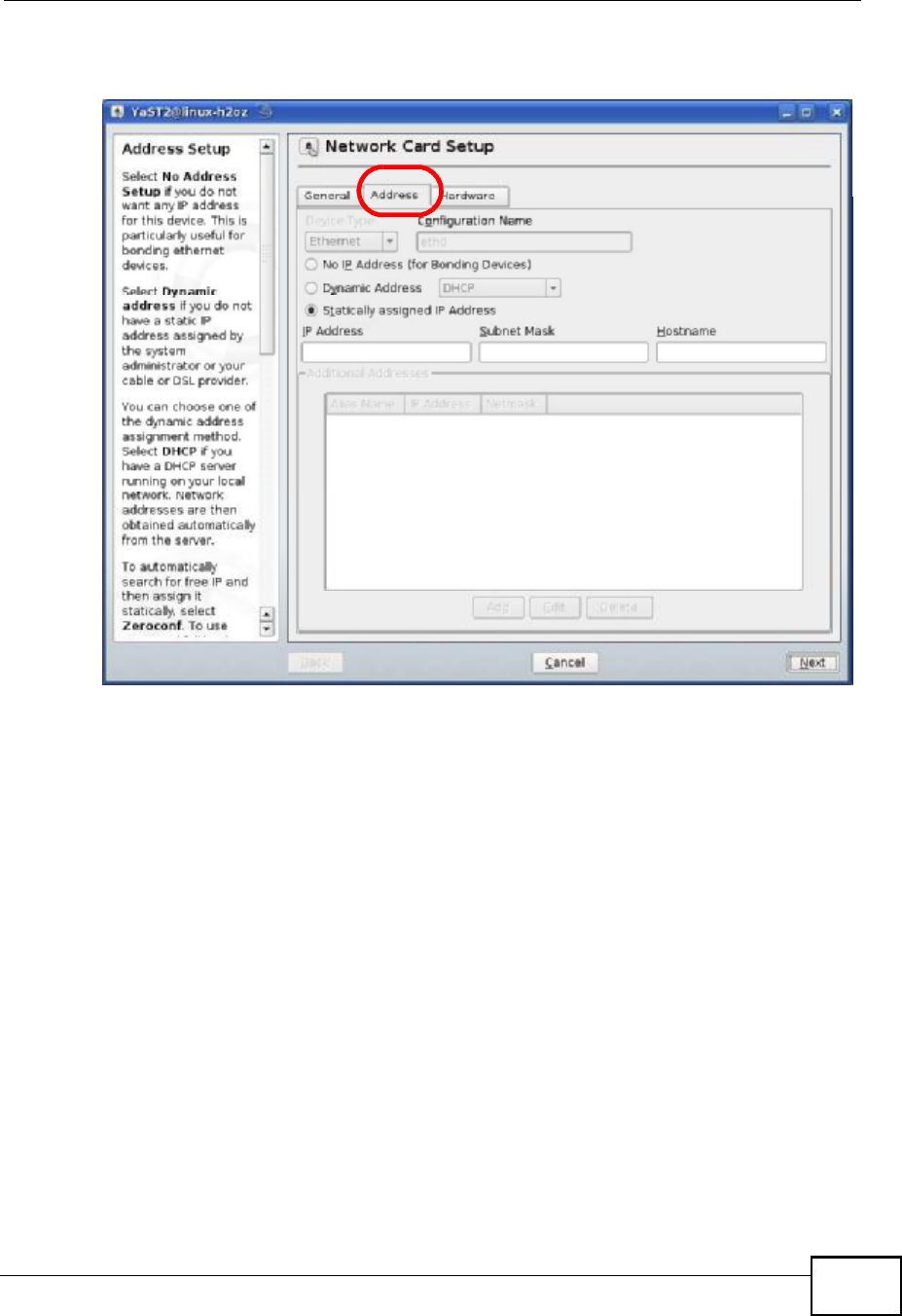
Appendix BSetting Up Your Computer s IP Address
MAX208M User s Guide 179
5When the Network Card Setup window opens, click the Address tab
Figure 105 openSUSE 10.3: Network Card Setup
6Select Dynamic Address (DHCP) if you have a dynamic IP address.
Select Statically assigned IP Address if you have a static IP address. Fill in the
IP address, Subnet mask, and Hostname fields.
7Click Next to save the changes and close the Network Card Setup window.
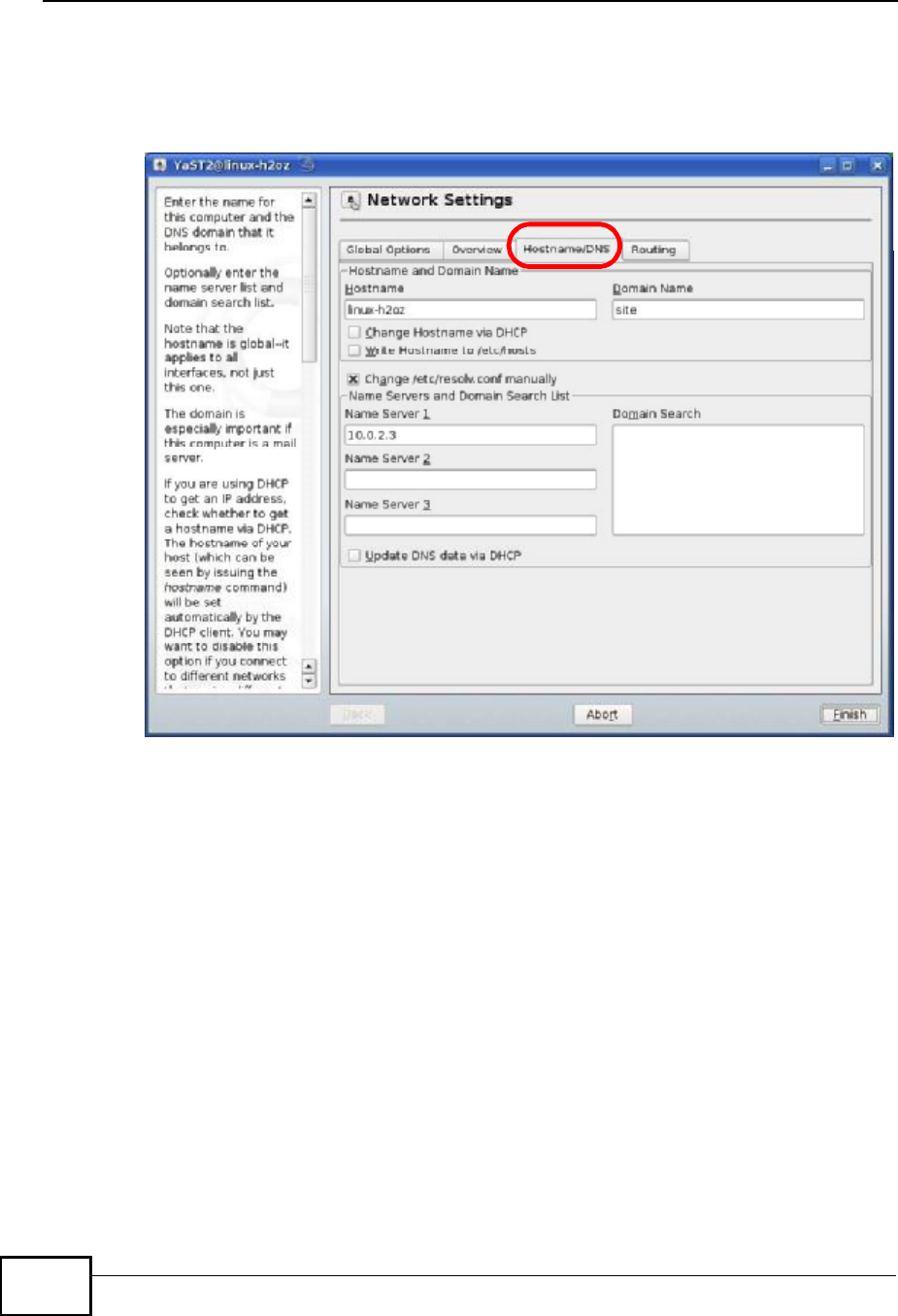
Appendix BSetting Up Your Computer s IP Address
MAX208M User s Guide
180
8If you know your DNS server IP address(es), click the Hostname/DNS tab in
Network Settings and then enter the DNS server information in the fields
provided.
Figure 106 openSUSE 10.3: Network Settings
9Click Finish to save your settings and close the window.
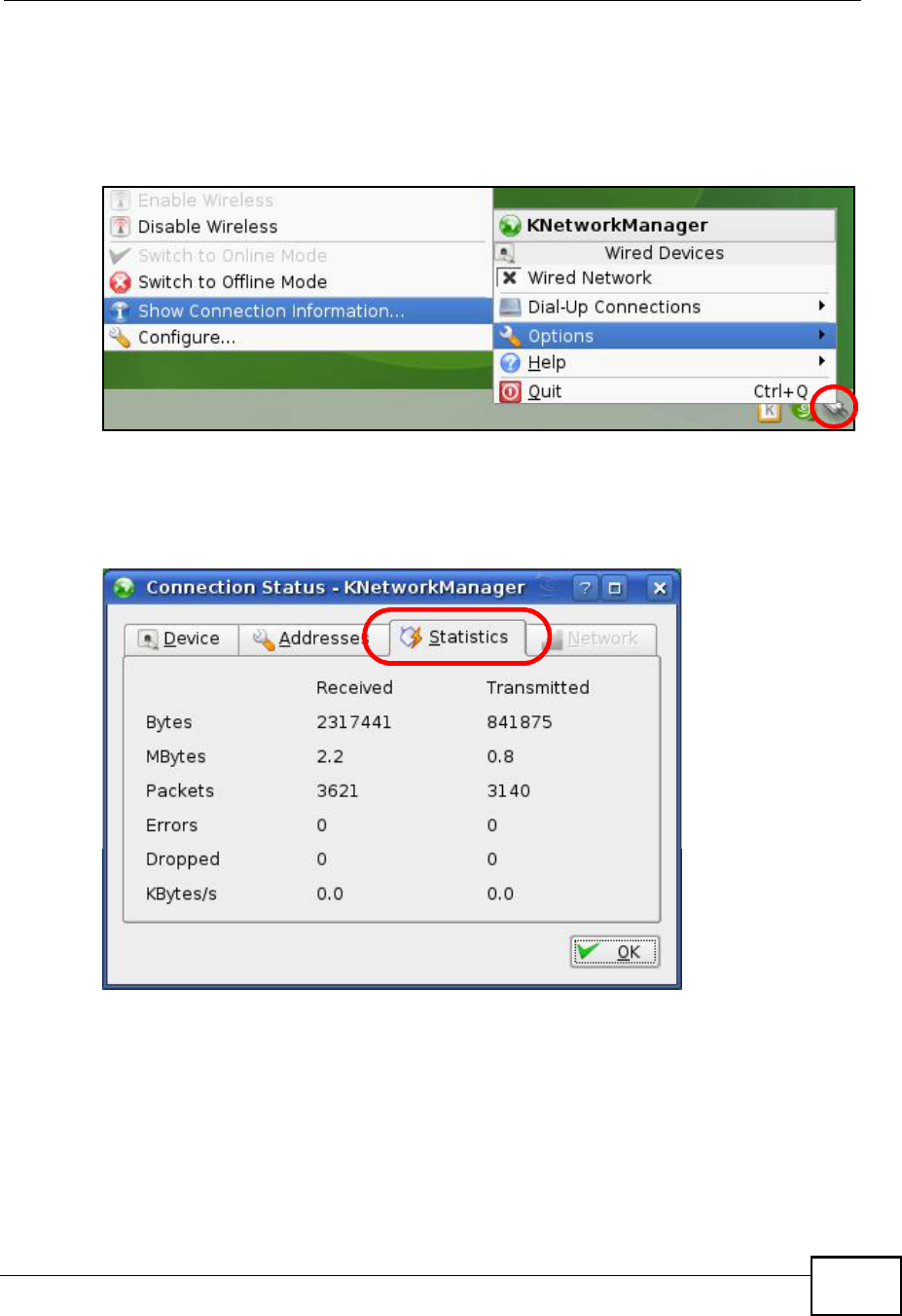
Appendix BSetting Up Your Computer s IP Address
MAX208M User s Guide 181
Verifying Settings
Click the KNetwork Manager icon on the Task bar to check your TCP/IP
properties. From the Options sub-menu, select Show Connection Information.
Figure 107 openSUSE 10.3: KNetwork Manager
When the Connection Status - KNetwork Manager window opens, click the
Statistics tab to see if your connection is working properly.
Figure 108 openSUSE: Connection Status - KNetwork Manager

Appendix BSetting Up Your Computer s IP Address
MAX208M User s Guide
182
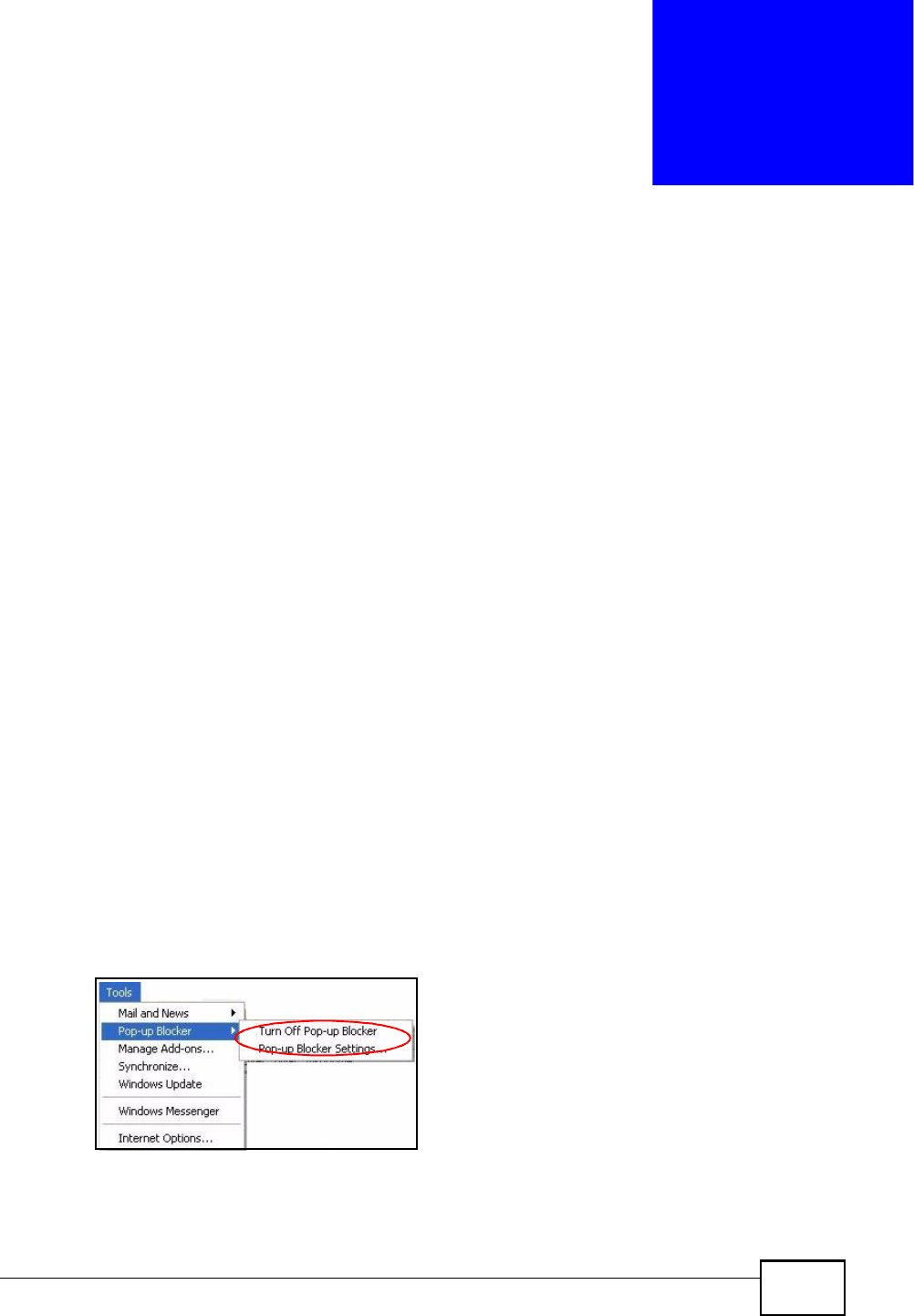
MAX208M User s Guide 183
APPENDIX C
Pop-up Windows, JavaScript
and Java Permissions
In order to use the web configurator you need to allow:
!Web browser pop-up windows from your device.
!JavaScript (enabled by default).
!Java permissions (enabled by default).
Note: Internet Explorer 6 screens are used here. Screens for other Internet Explorer
versions may vary.
Internet Explorer Pop-up Blockers
You may have to disable pop-up blocking to log into your device.
Either disable pop-up blocking (enabled by default in Windows XP SP (Service
Pack) 2) or allow pop-up blocking and create an exception for your device s IP
address.
Disable Pop-up Blockers
1In Internet Explorer, select Tools, Pop-up Blocker and then select Turn Off
Pop-up Blocker.
Figure 109 Pop-up Blocker
You can also check if pop-up blocking is disabled in the Pop-up Blocker section in
the Privacy tab.
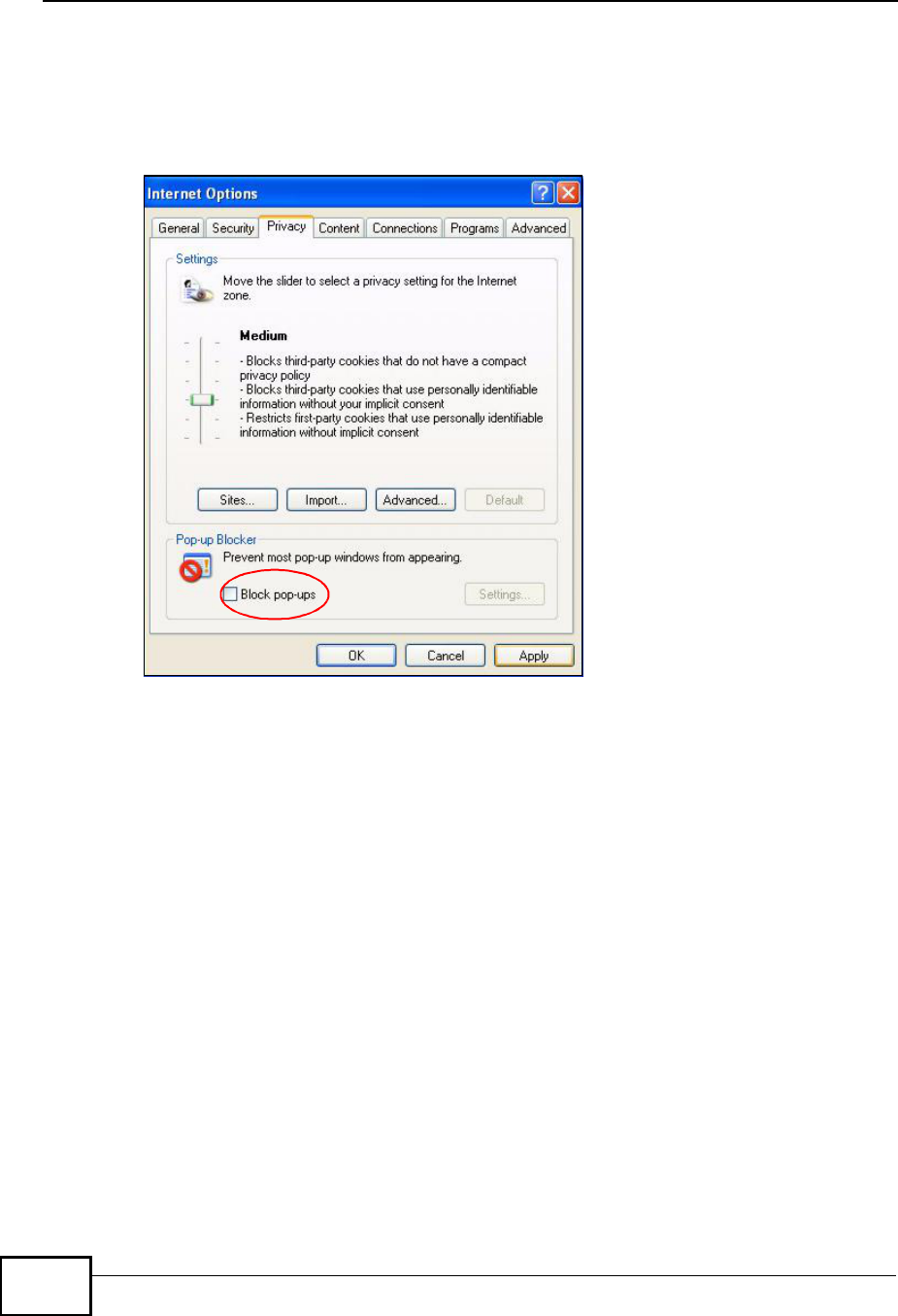
Appendix CPop-up Windows, JavaScript and Java Permissions
MAX208M User s Guide
184
1In Internet Explorer, select Tools, Internet Options, Privacy.
2Clear the Block pop-ups check box in the Pop-up Blocker section of the screen.
This disables any web pop-up blockers you may have enabled.
Figure 110 Internet Options: Privacy
3Click Apply to save this setting.
Enable Pop-up Blockers with Exceptions
Alternatively, if you only want to allow pop-up windows from your device, see the
following steps.
1In Internet Explorer, select Tools, Internet Options and then the Privacy tab.
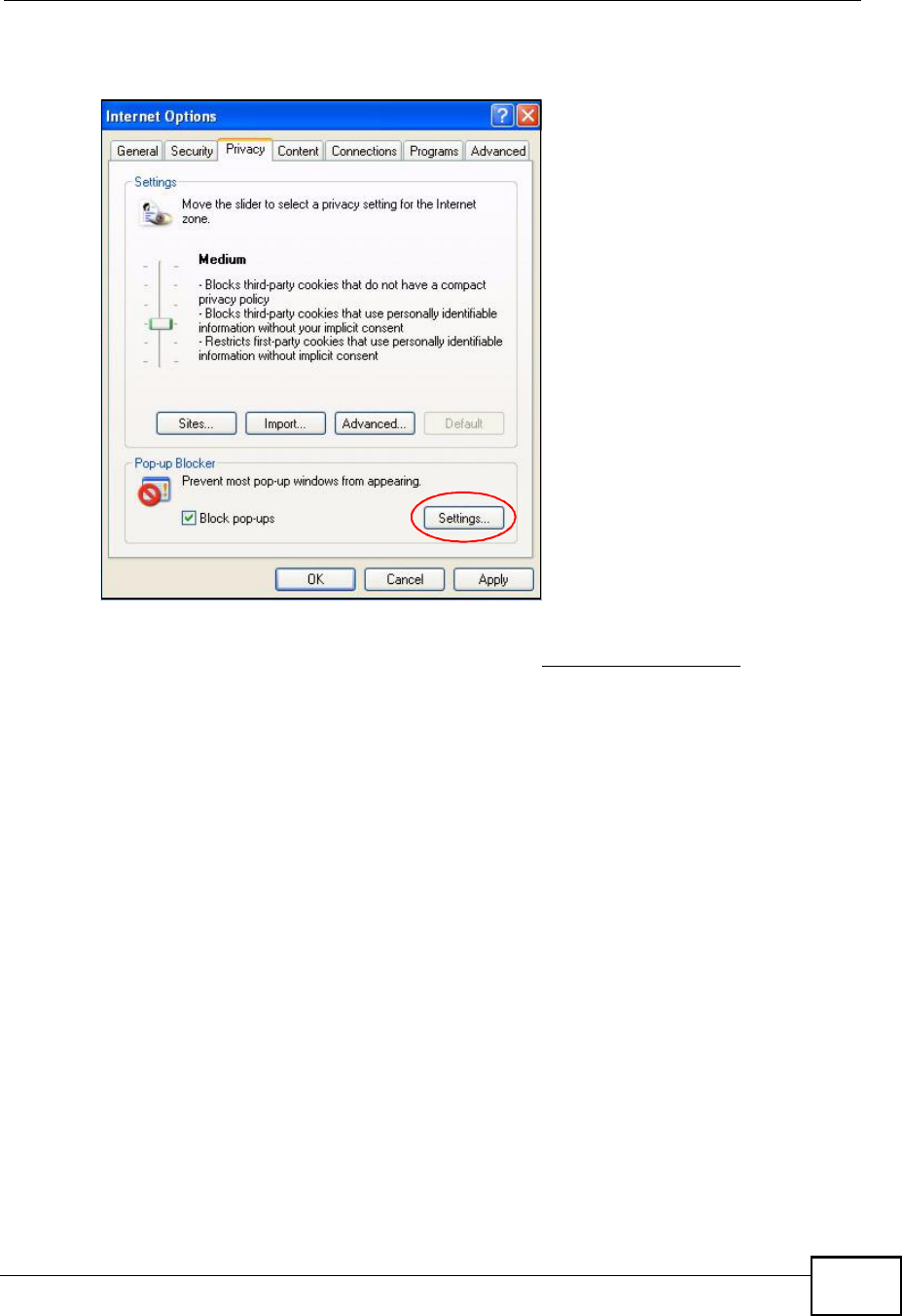
Appendix CPop-up Windows, JavaScript and Java Permissions
MAX208M User s Guide 185
2Select Settings to open the Pop-up Blocker Settings screen.
Figure 111 Internet Options: Privacy
3Type the IP address of your device (the web page that you do not want to have
blocked) with the prefix "http://#. For example, http://192.168.167.1.
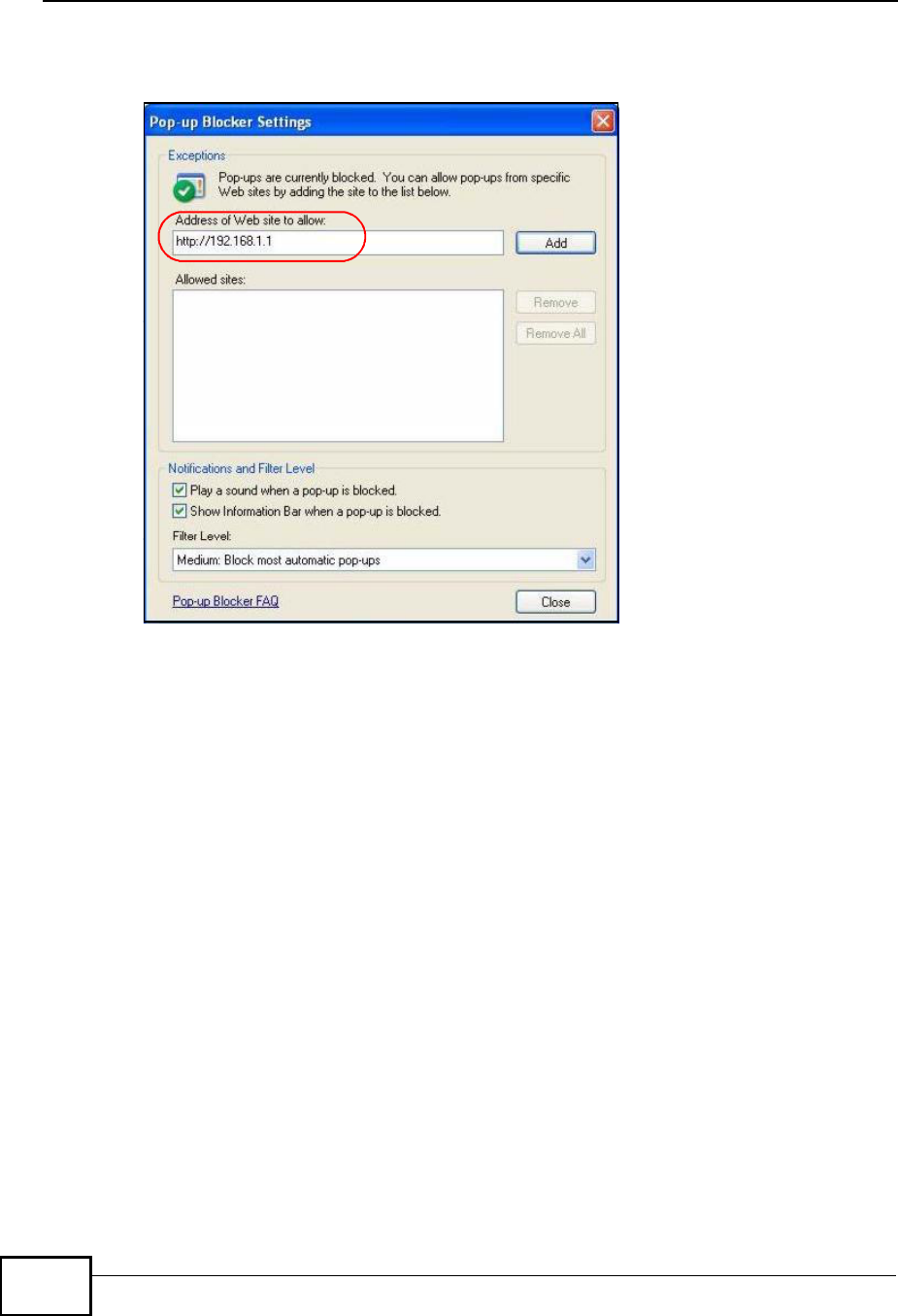
Appendix CPop-up Windows, JavaScript and Java Permissions
MAX208M User s Guide
186
4Click Add to move the IP address to the list of Allowed sites.
Figure 112 Pop-up Blocker Settings
5Click Close to return to the Privacy screen.
6Click Apply to save this setting.
JavaScript
If pages of the web configurator do not display properly in Internet Explorer, check
that JavaScript is allowed.
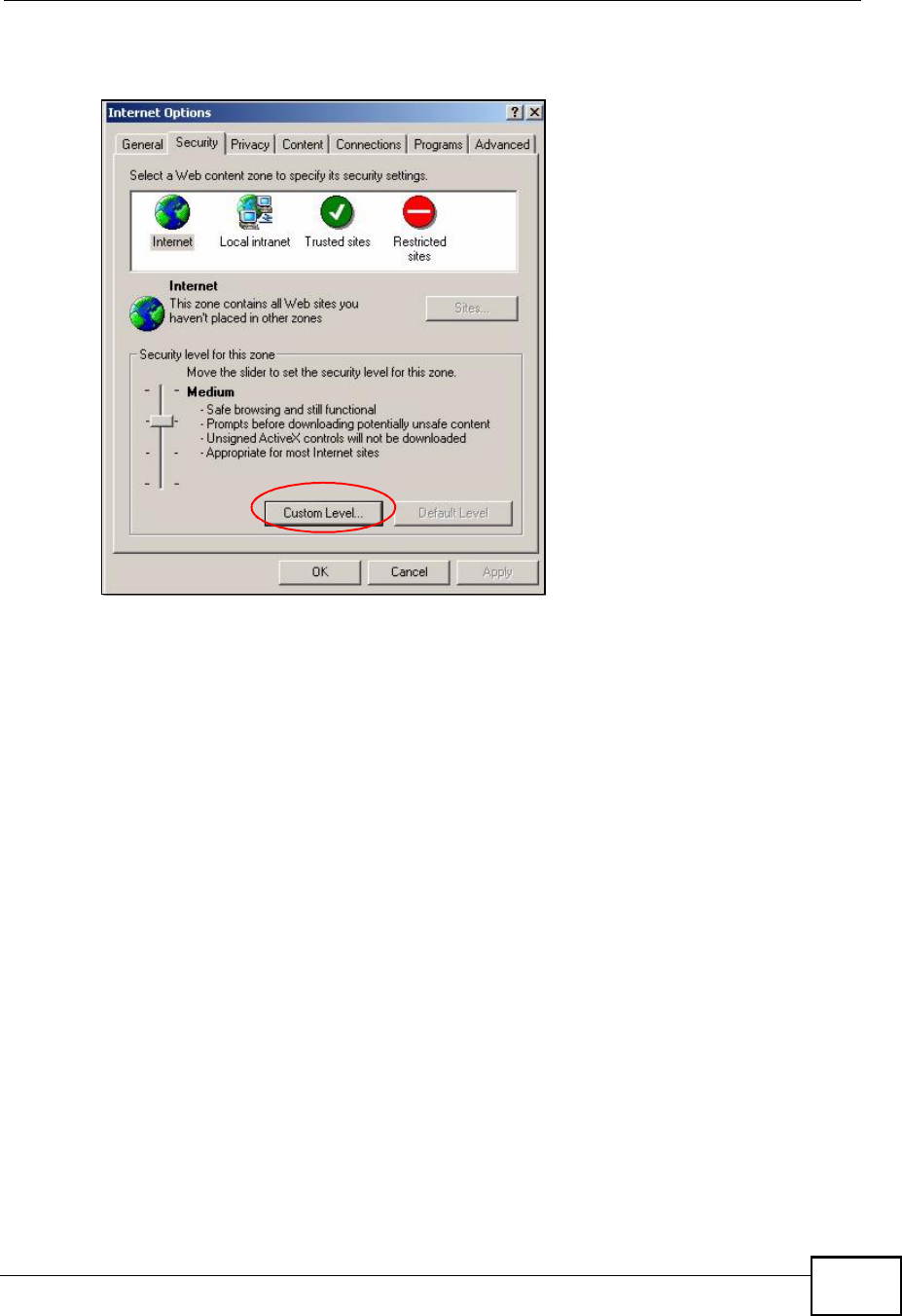
Appendix CPop-up Windows, JavaScript and Java Permissions
MAX208M User s Guide 187
1In Internet Explorer, click Tools, Internet Options and then the Security tab.
Figure 113 Internet Options: Security
2Click the Custom Level... button.
3Scroll down to Scripting.
4Under Active scripting make sure that Enable is selected (the default).
5Under Scripting of Java applets make sure that Enable is selected (the
default).
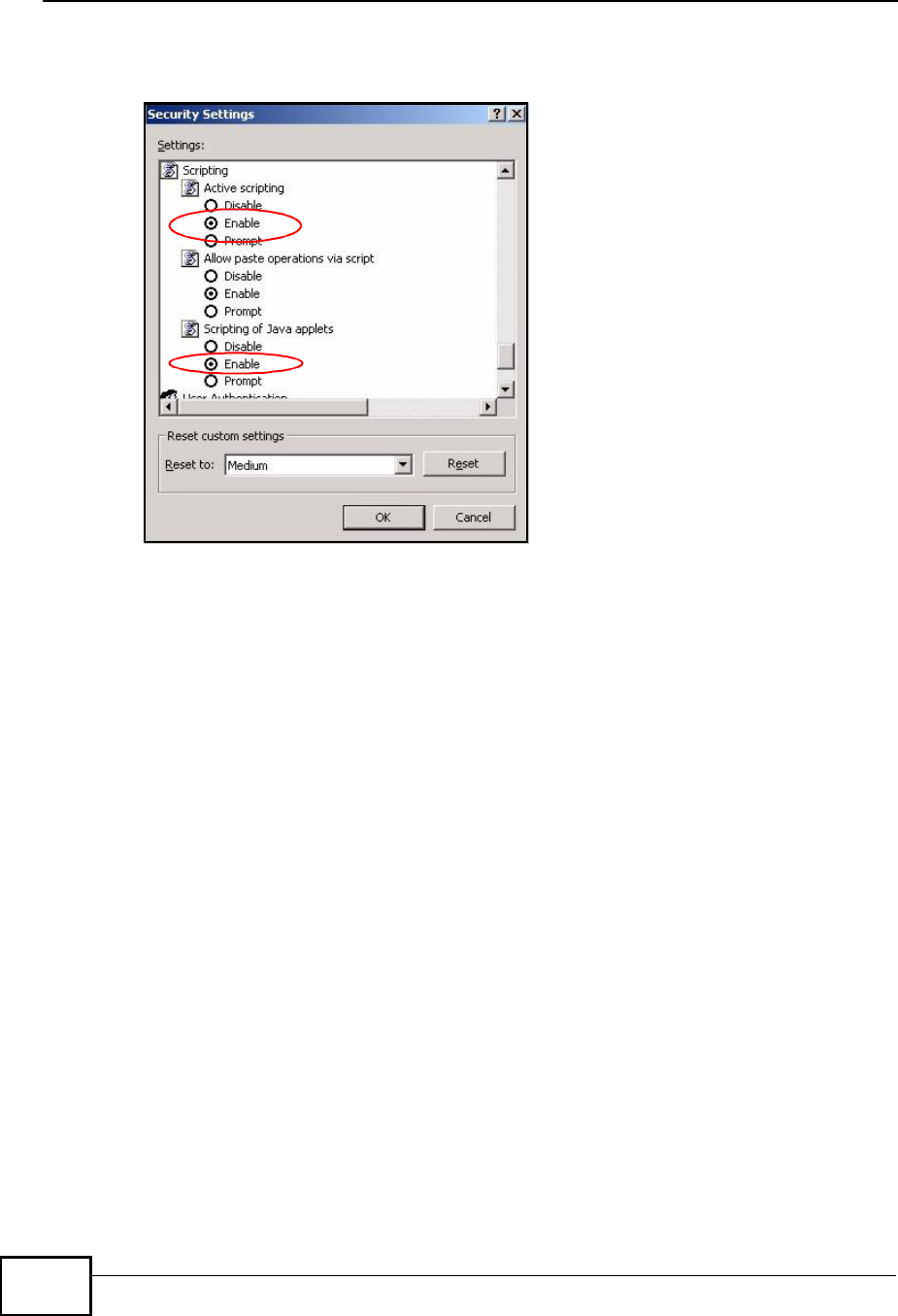
Appendix CPop-up Windows, JavaScript and Java Permissions
MAX208M User s Guide
188
6Click OK to close the window.
Figure 114 Security Settings - Java Scripting
Java Permissions
1From Internet Explorer, click Tools, Internet Options and then the Security
tab.
2Click the Custom Level... button.
3Scroll down to Microsoft VM.
4Under Java permissions make sure that a safety level is selected.
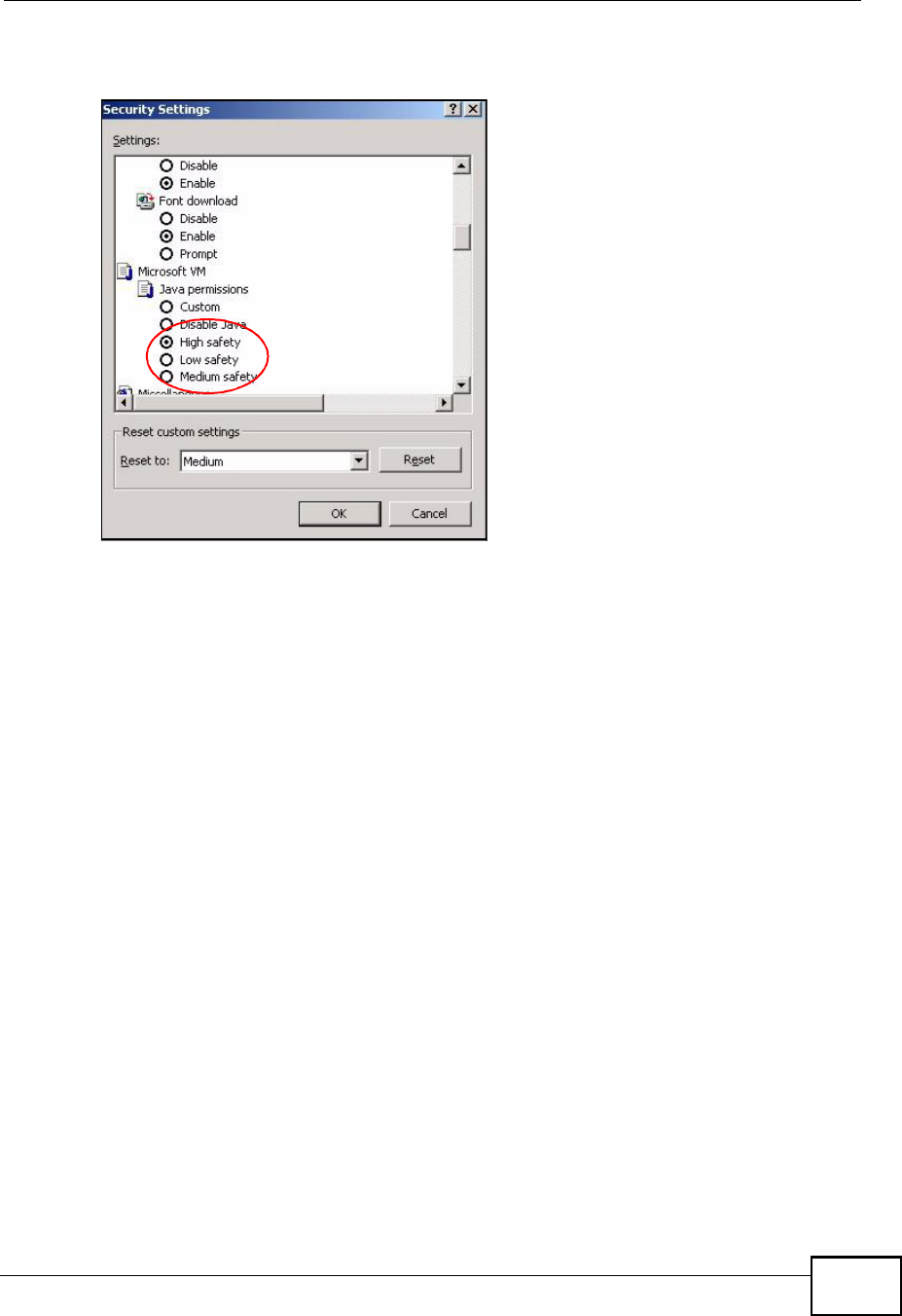
Appendix CPop-up Windows, JavaScript and Java Permissions
MAX208M User s Guide 189
5Click OK to close the window.
Figure 115 Security Settings - Java
JAVA (Sun)
1From Internet Explorer, click Tools, Internet Options and then the Advanced
tab.
2Make sure that Use Java 2 for <applet> under Java (Sun) is selected.
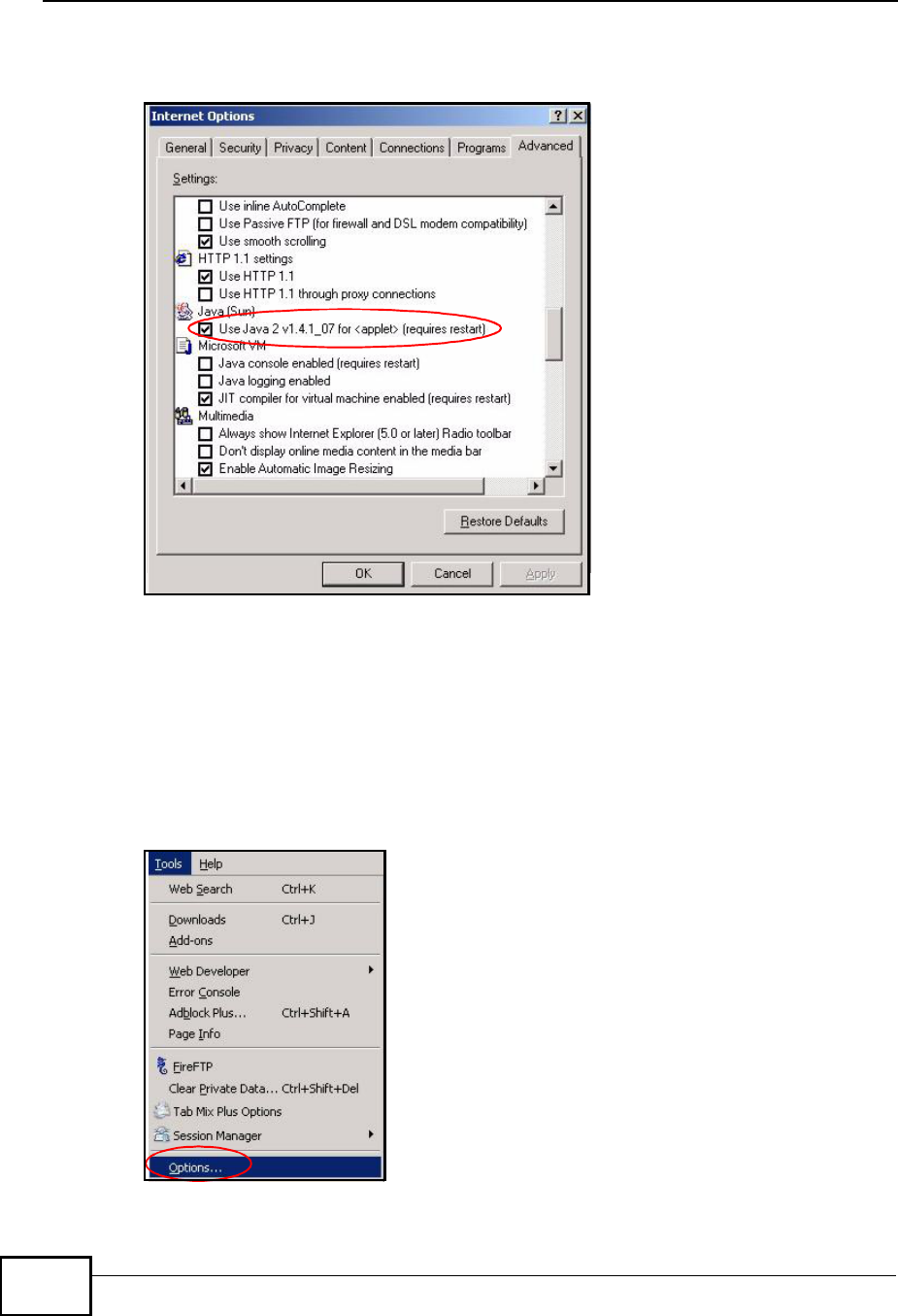
Appendix CPop-up Windows, JavaScript and Java Permissions
MAX208M User s Guide
190
3Click OK to close the window.
Figure 116 Java (Sun)
Mozilla Firefox
Mozilla Firefox 2.0 screens are used here. Screens for other versions may vary.
You can enable Java, Javascript and pop-ups in one screen. Click Tools, then click
Options in the screen that appears.
Figure 117 Mozilla Firefox: TOOLS > Options
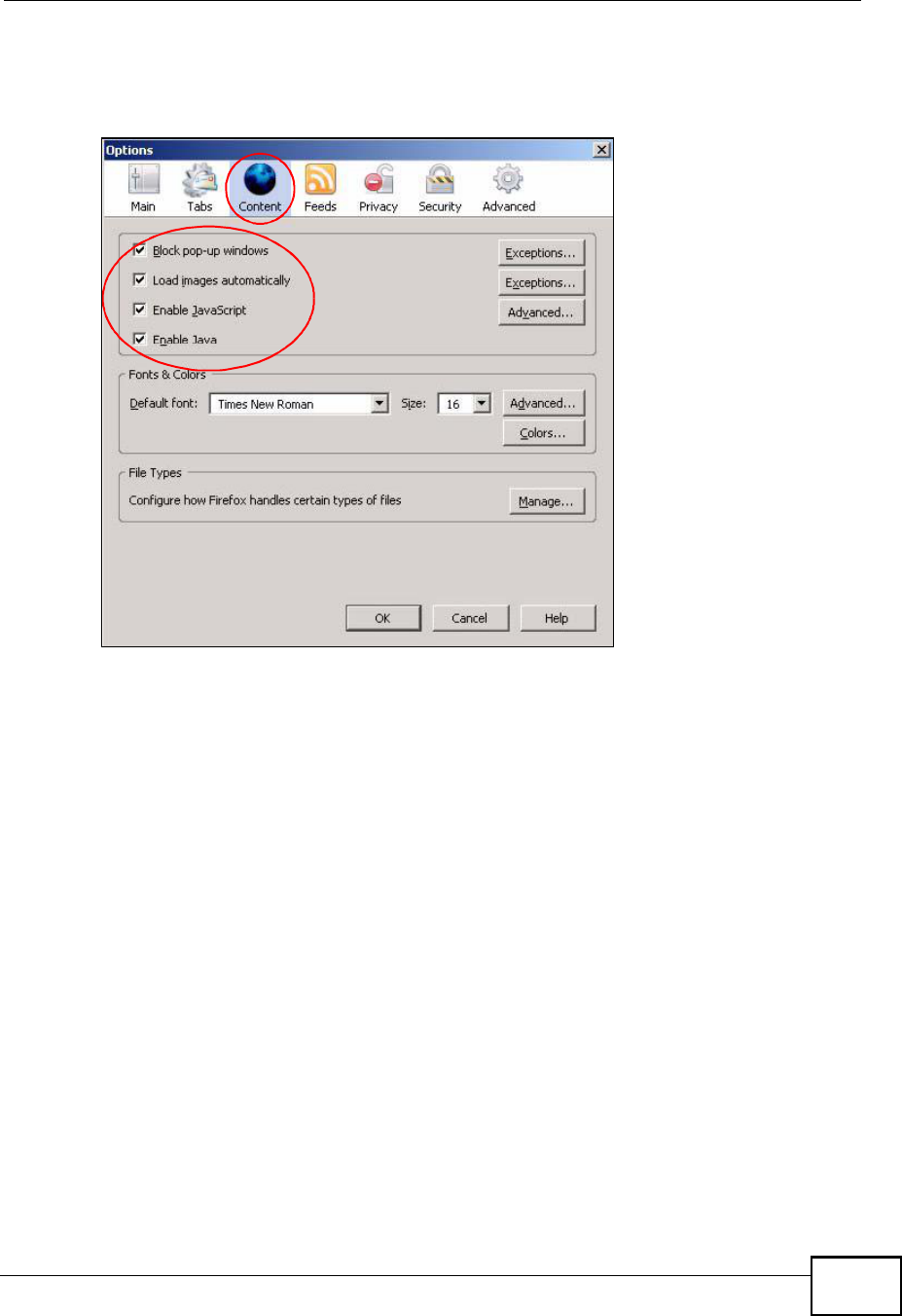
Appendix CPop-up Windows, JavaScript and Java Permissions
MAX208M User s Guide 191
Click Content.to show the screen below. Select the check boxes as shown in the
following screen.
Figure 118 Mozilla Firefox Content Security

Appendix CPop-up Windows, JavaScript and Java Permissions
MAX208M User s Guide
192

MAX208M User s Guide 193
APPENDIX D
IP Addresses and Subnetting
This appendix introduces IP addresses and subnet masks.
IP addresses identify individual devices on a network. Every networking device
(including computers, servers, routers, printers, etc.) needs an IP address to
communicate across the network. These networking devices are also known as
hosts.
Subnet masks determine the maximum number of possible hosts on a network.
You can also use subnet masks to divide one network into multiple sub-networks.
Introduction to IP Addresses
One part of the IP address is the network number, and the other part is the host
ID. In the same way that houses on a street share a common street name, the
hosts on a network share a common network number. Similarly, as each house
has its own house number, each host on the network has its own unique
identifying number - the host ID. Routers use the network number to send packets
to the correct network, while the host ID determines to which host on the network
the packets are delivered.
Structure
An IP address is made up of four parts, written in dotted decimal notation (for
example, ). Each of these four parts is known as an octet. An octet is an eight-
digit binary number (for example 11000000, which is 192 in decimal notation).
Therefore, each octet has a possible range of 00000000 to 11111111 in binary, or
0 to 255 in decimal.
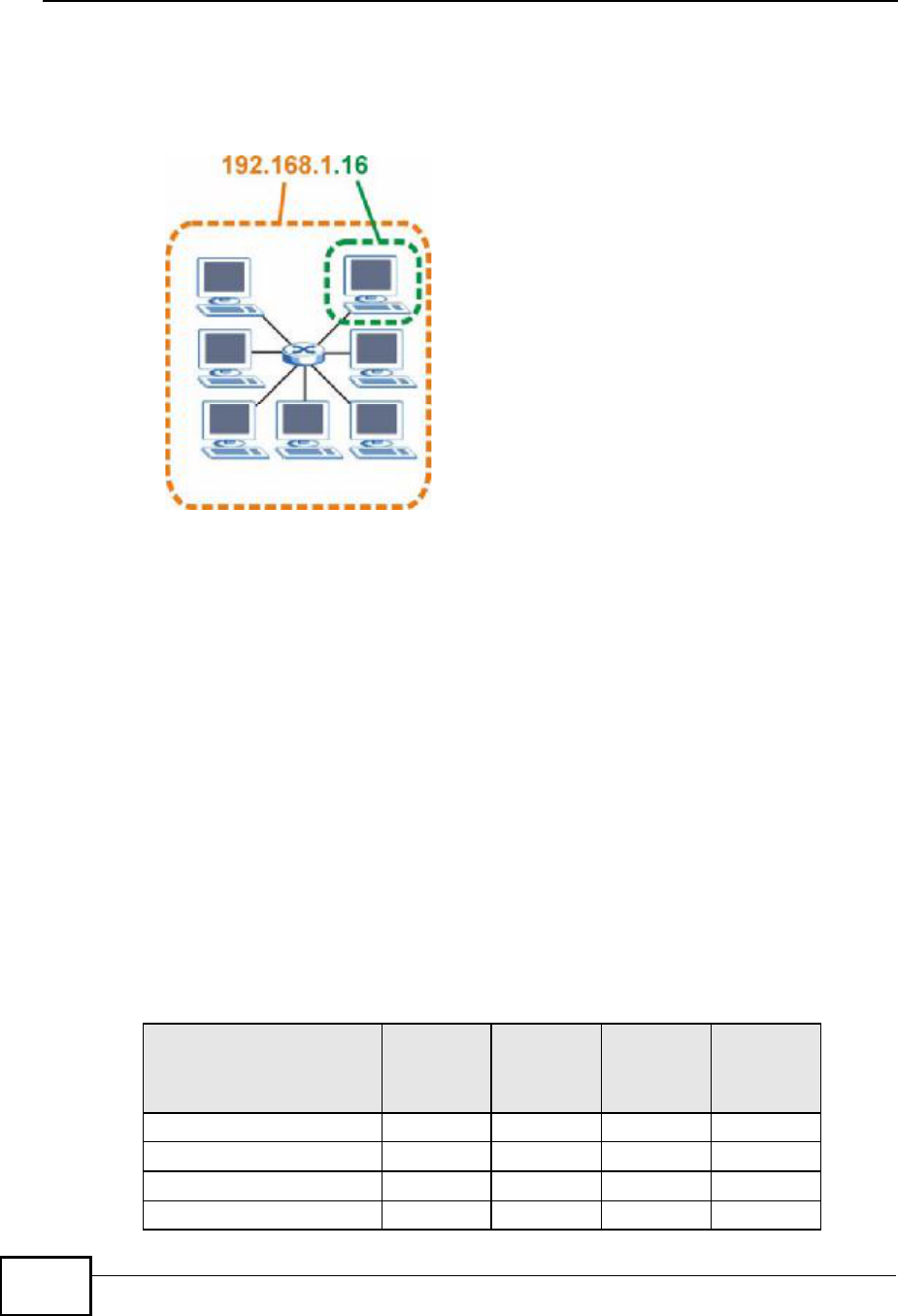
Appendix DIP Addresses and Subnetting
MAX208M User s Guide
194
The following figure shows an example IP address in which the first three octets
(192.168.1) are the network number, and the fourth octet (16) is the host ID.
Figure 119 Network Number and Host ID
How much of the IP address is the network number and how much is the host ID
varies according to the subnet mask.
Subnet Masks
A subnet mask is used to determine which bits are part of the network number,
and which bits are part of the host ID (using a logical AND operation). The term
"subnet# is short for "sub-network#.
A subnet mask has 32 bits. If a bit in the subnet mask is a "1# then the
corresponding bit in the IP address is part of the network number. If a bit in the
subnet mask is "0# then the corresponding bit in the IP address is part of the host
ID.
The following example shows a subnet mask identifying the network number (in
bold text) and host ID of an IP address (192.168.1.2 in decimal).
Table 62 IP Address Network Number and Host ID Example
1ST
OCTET:
(192)
2ND
OCTET:
(168)
3RD
OCTET:
(1)
4TH
OCTET
(2)
IP Address (Binary)11000000101010000000000100000010
Subnet Mask (Binary) 111111111111111111111111 00000000
Network Number 110000001010100000000001
Host ID00000010

Appendix DIP Addresses and Subnetting
MAX208M User s Guide 195
By convention, subnet masks always consist of a continuous sequence of ones
beginning from the leftmost bit of the mask, followed by a continuous sequence of
zeros, for a total number of 32 bits.
Subnet masks can be referred to by the size of the network number part (the bits
with a "1# value). For example, an "8-bit mask# means that the first 8 bits of the
mask are ones and the remaining 24 bits are zeroes.
Subnet masks are expressed in dotted decimal notation just like IP addresses. The
following examples show the binary and decimal notation for 8-bit, 16-bit, 24-bit
and 29-bit subnet masks.
Network Size
The size of the network number determines the maximum number of possible
hosts you can have on your network. The larger the number of network number
bits, the smaller the number of remaining host ID bits.
An IP address with host IDs of all zeros is the IP address of the network
(192.168.1.0 with a 24-bit subnet mask, for example). An IP address with host
IDs of all ones is the broadcast address for that network (192.168.1.255 with a
24-bit subnet mask, for example).
As these two IP addresses cannot be used for individual hosts, calculate the
maximum number of possible hosts in a network as follows:
Table 63 Subnet Masks
BINARY
DECIMAL
1ST
OCTET
2ND
OCTET
3RD
OCTET
4TH
OCTET
8-bit mask 11111111 00000000 00000000 00000000 255.0.0.0
16-bit
mask
11111111 11111111 00000000 00000000 255.255.0.0
24-bit
mask
11111111 11111111 11111111 00000000 255.255.255.0
29-bit
mask
11111111 11111111 11111111 11111000 255.255.255.24
8
Table 64 Maximum Host Numbers
SUBNET MASK HOST ID SIZE MAXIMUM NUMBER OF
HOSTS
8 bits255.0.0.024 bits2
24 $ 216777214
16 bits255.255.0.016 bits2
16 $ 265534
24 bits255.255.255.08 bits2
8
$ 2254
29 bits255.255.255.2
48
3 bits2
3
$ 26
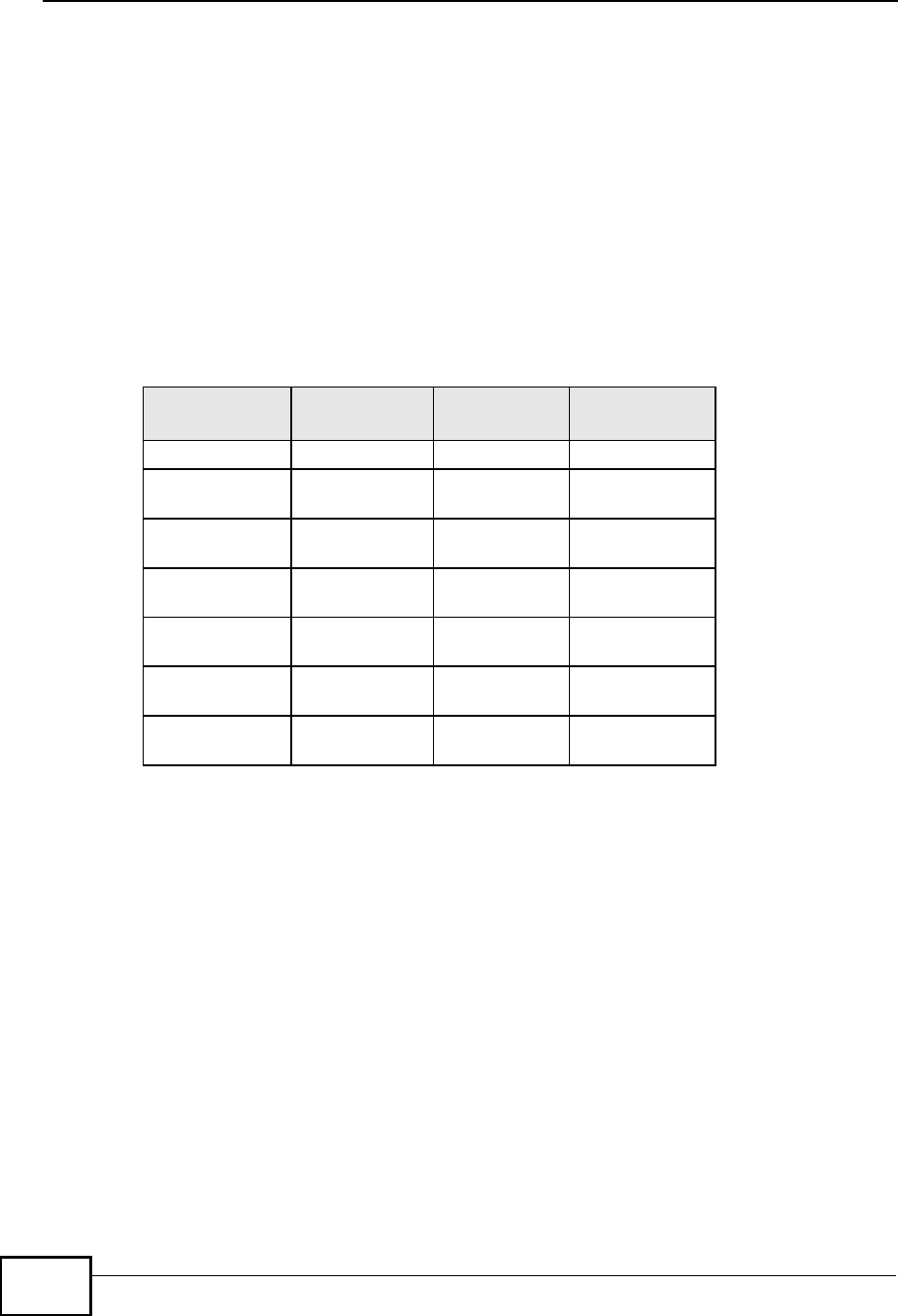
Appendix DIP Addresses and Subnetting
MAX208M User s Guide
196
Notation
Since the mask is always a continuous number of ones beginning from the left,
followed by a continuous number of zeros for the remainder of the 32 bit mask,
you can simply specify the number of ones instead of writing the value of each
octet. This is usually specified by writing a "/# followed by the number of bits in
the mask after the address.
For example, 192.1.1.0 /25 is equivalent to saying 192.1.1.0 with subnet mask
255.255.255.128.
The following table shows some possible subnet masks using both notations.
Subnetting
You can use subnetting to divide one network into multiple sub-networks. In the
following example a network administrator creates two sub-networks to isolate a
group of servers from the rest of the company network for security reasons.
In this example, the company network address is 192.168.1.0. The first three
octets of the address (192.168.1) are the network number, and the remaining
octet is the host ID, allowing a maximum of 28 $ 2 or 254 possible hosts.
Table 65 Alternative Subnet Mask Notation
SUBNET
MASK
ALTERNATIVE
NOTATION
LAST OCTET
(BINARY)
LAST OCTET
(DECIMAL)
255.255.255.0 /24 0000 0000 0
255.255.255.12
8
/25 1000 0000 128
255.255.255.19
2
/26 1100 0000 192
255.255.255.22
4
/27 1110 0000 224
255.255.255.24
0
/28 1111 0000 240
255.255.255.24
8
/29 1111 1000 248
255.255.255.25
2
/30 1111 1100 252
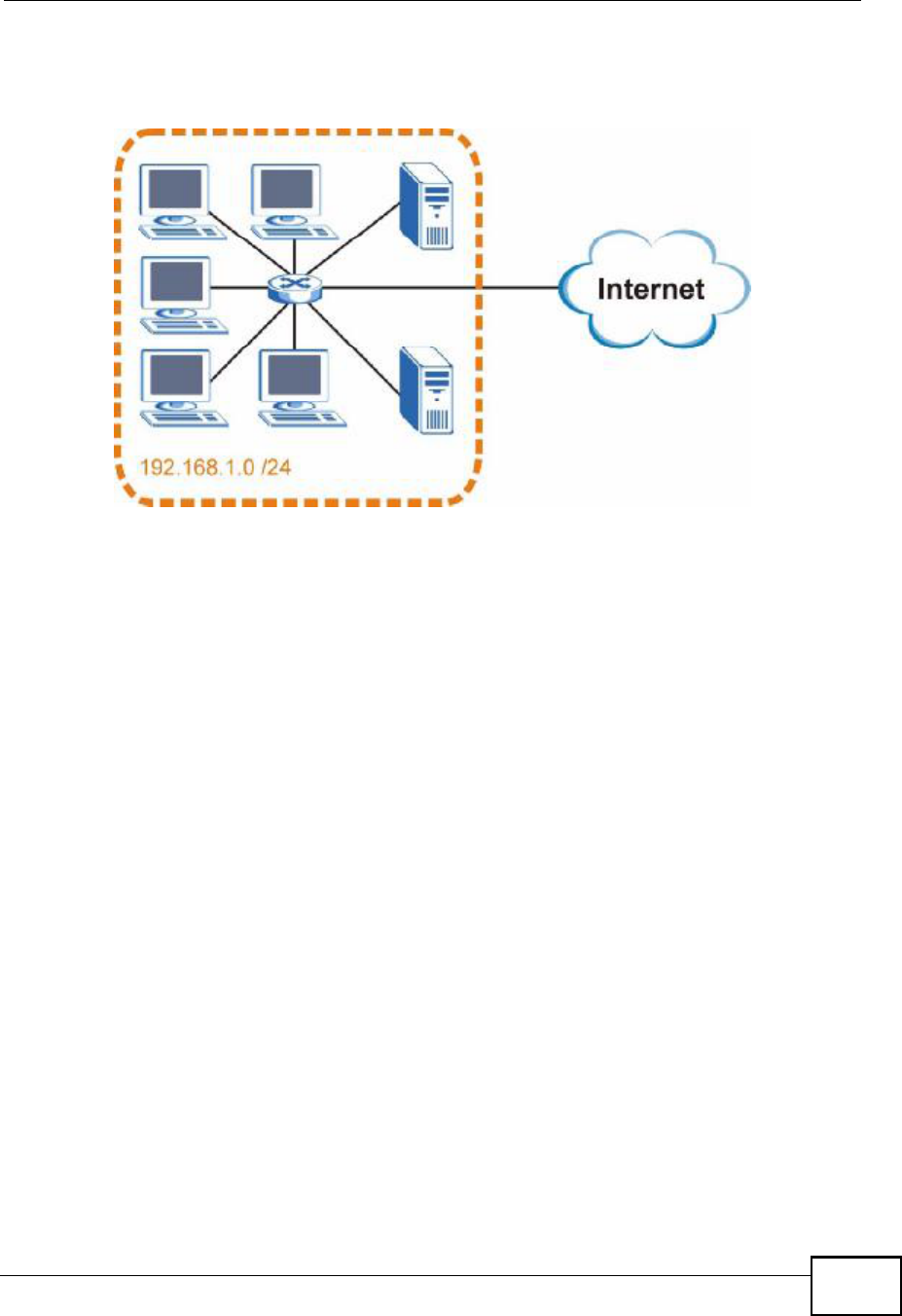
Appendix DIP Addresses and Subnetting
MAX208M User s Guide 197
The following figure shows the company network before subnetting.
Figure 120 Subnetting Example: Before Subnetting
You can "borrow# one of the host ID bits to divide the network 192.168.1.0 into
two separate sub-networks. The subnet mask is now 25 bits (255.255.255.128 or
/25).
The "borrowed# host ID bit can have a value of either 0 or 1, allowing two
subnets; 192.168.1.0 /25 and 192.168.1.128 /25.
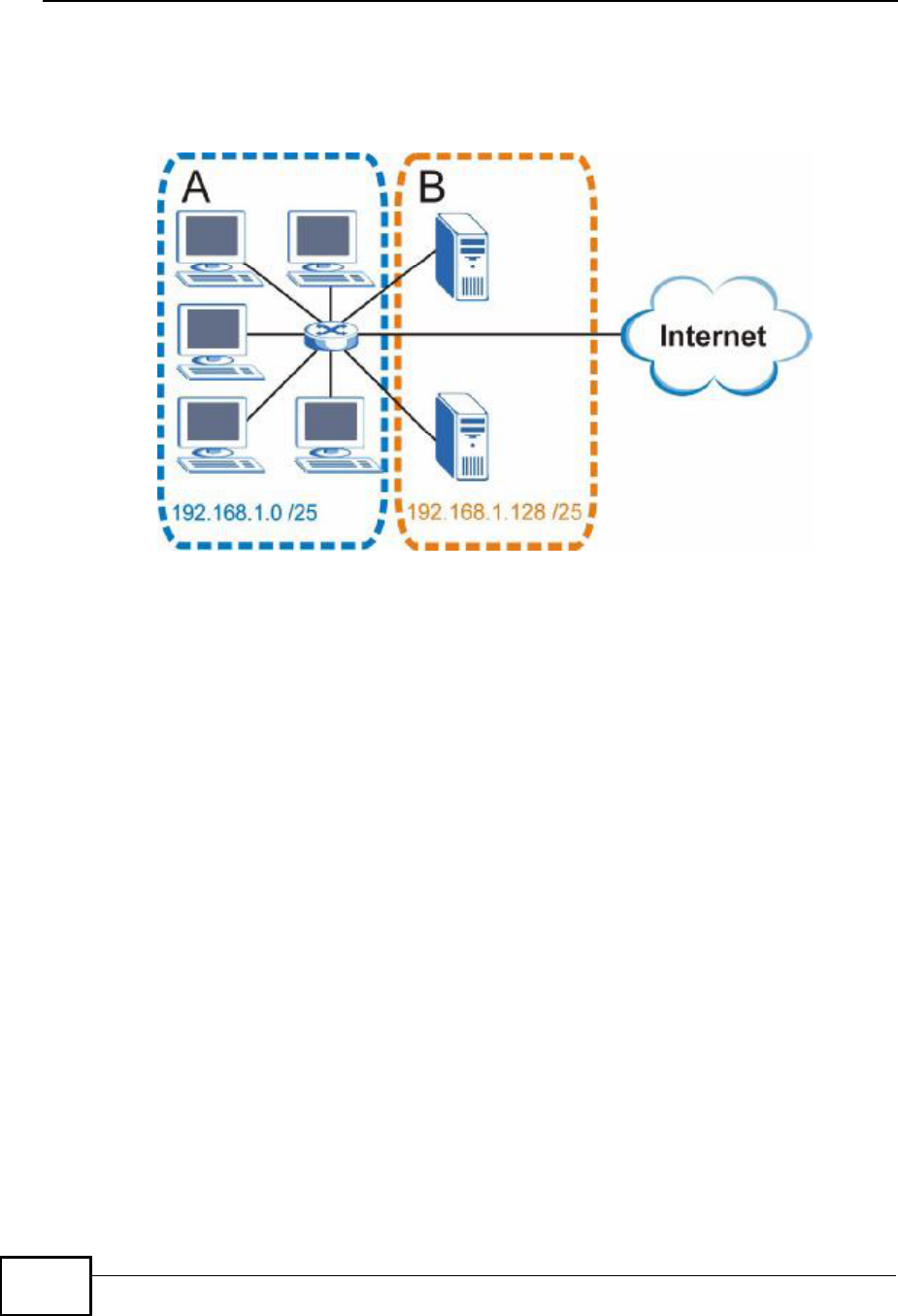
Appendix DIP Addresses and Subnetting
MAX208M User s Guide
198
The following figure shows the company network after subnetting. There are now
two sub-networks, A and B.
Figure 121 Subnetting Example: After Subnetting
In a 25-bit subnet the host ID has 7 bits, so each sub-network has a maximum of
27 $ 2 or 126 possible hosts (a host ID of all zeroes is the subnet s address itself,
all ones is the subnet s broadcast address).
192.168.1.0 with mask 255.255.255.128 is subnet A itself, and 192.168.1.127
with mask 255.255.255.128 is its broadcast address. Therefore, the lowest IP
address that can be assigned to an actual host for subnet A is 192.168.1.1 and
the highest is 192.168.1.126.
Similarly, the host ID range for subnet B is 192.168.1.129 to 192.168.1.254.
Example: Four Subnets
The previous example illustrated using a 25-bit subnet mask to divide a 24-bit
address into two subnets. Similarly, to divide a 24-bit address into four subnets,
you need to "borrow# two host ID bits to give four possible combinations (00, 01,
10 and 11). The subnet mask is 26 bits
(11111111.11111111.11111111.11000000) or 255.255.255.192.

Appendix DIP Addresses and Subnetting
MAX208M User s Guide 199
Each subnet contains 6 host ID bits, giving 26 - 2 or 62 hosts for each subnet (a
host ID of all zeroes is the subnet itself, all ones is the subnet s broadcast
address).
Table 66 Subnet 1
IP/SUBNET MASK NETWORK NUMBER LAST OCTET BIT
VALUE
IP Address (Decimal) 192.168.1. 0
IP Address (Binary) 11000000.10101000.00000001. 00000000
Subnet Mask (Binary) 11111111.11111111.11111111. 11000000
Subnet Address:
192.168.1.0
Lowest Host ID: 192.168.1.1
Broadcast Address:
192.168.1.63
Highest Host ID: 192.168.1.62
Table 67 Subnet 2
IP/SUBNET MASK NETWORK NUMBER LAST OCTET BIT
VALUE
IP Address 192.168.1. 64
IP Address (Binary) 11000000.10101000.00000001. 01000000
Subnet Mask (Binary) 11111111.11111111.11111111. 11000000
Subnet Address:
192.168.1.64
Lowest Host ID: 192.168.1.65
Broadcast Address:
192.168.1.127
Highest Host ID: 192.168.1.126
Table 68 Subnet 3
IP/SUBNET MASK NETWORK NUMBER LAST OCTET BIT
VALUE
IP Address 192.168.1. 128
IP Address (Binary) 11000000.10101000.00000001. 10000000
Subnet Mask (Binary) 11111111.11111111.11111111. 11000000
Subnet Address:
192.168.1.128
Lowest Host ID: 192.168.1.129
Broadcast Address:
192.168.1.191
Highest Host ID: 192.168.1.190
Table 69 Subnet 4
IP/SUBNET MASK NETWORK NUMBER LAST OCTET BIT
VALUE
IP Address 192.168.1. 192
IP Address (Binary) 11000000.10101000.00000001
.
11000000
Subnet Mask (Binary) 11111111.11111111.11111111
.
11000000
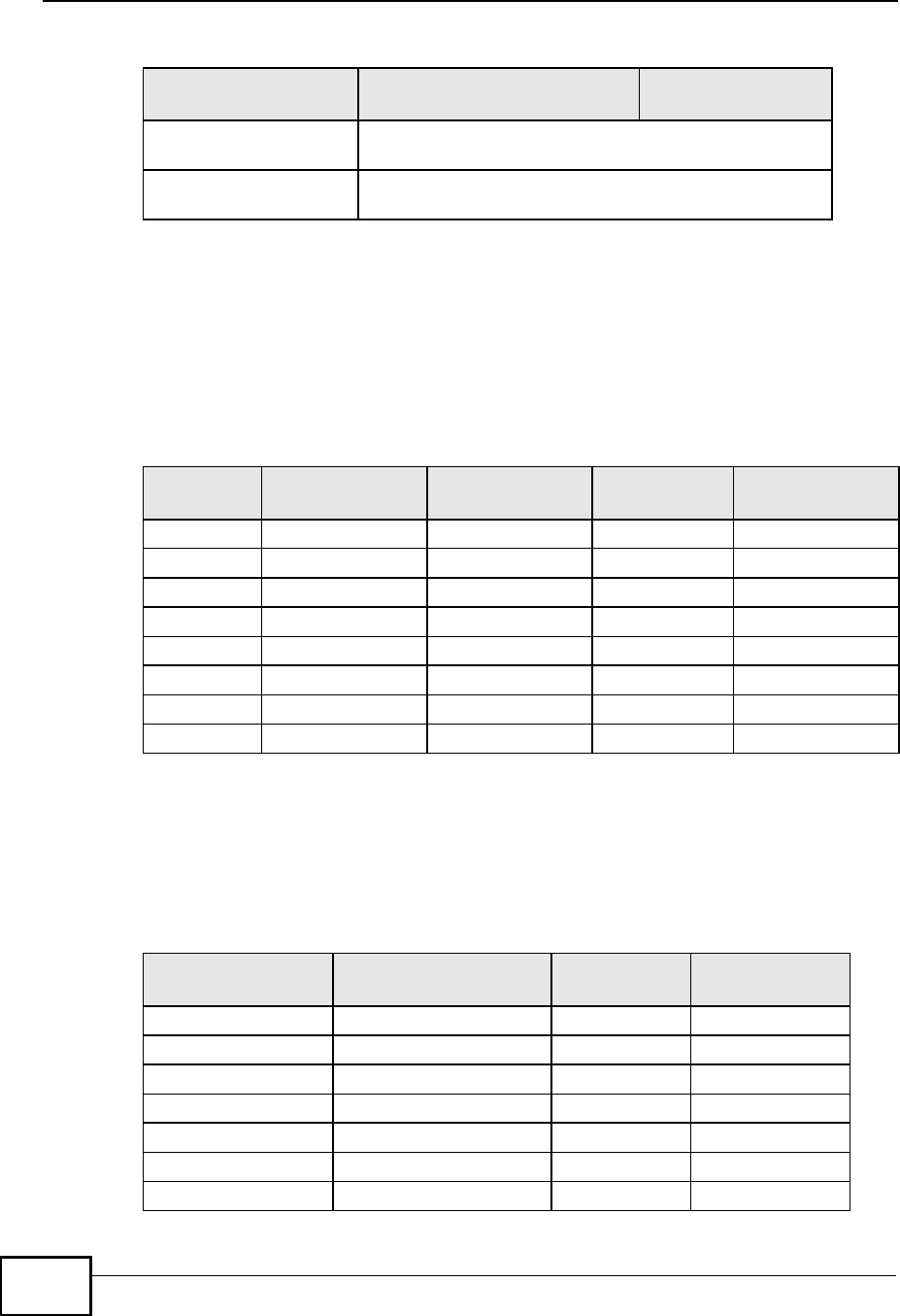
Appendix DIP Addresses and Subnetting
MAX208M User s Guide
200
Example: Eight Subnets
Similarly, use a 27-bit mask to create eight subnets (000, 001, 010, 011, 100,
101, 110 and 111).
The following table shows IP address last octet values for each subnet.
Subnet Planning
The following table is a summary for subnet planning on a network with a 24-bit
network number.
Subnet Address:
192.168.1.192
Lowest Host ID: 192.168.1.193
Broadcast Address:
192.168.1.255
Highest Host ID: 192.168.1.254
Table 69 Subnet 4 (continued)
IP/SUBNET MASK NETWORK NUMBER LAST OCTET BIT
VALUE
Table 70 Eight Subnets
SUBNET SUBNET
ADDRESS FIRST ADDRESS LAST
ADDRESS
BROADCAST
ADDRESS
1 0 1 30 31
232 33 62 63
364 65 94 95
496 97 126 127
5 128 129 158 159
6 160 161 190 191
7 192 193 222 223
8 224 225 254 255
Table 71 24-bit Network Number Subnet Planning
NO. #BORROWED$
HOST BITS SUBNET MASK NO. SUBNETS NO. HOSTS PER
SUBNET
1255.255.255.128 (/25) 2 126
2255.255.255.192 (/26) 4 62
3 255.255.255.224 (/27) 8 30
4 255.255.255.240 (/28) 16 14
5 255.255.255.248 (/29) 32 6
6 255.255.255.252 (/30) 64 2
7 255.255.255.254 (/31) 128 1
